IMPLEMENTATION OF TOTAL QUALITY MANAGEMENT AND ITS IMPACT ON
VerifiedAdded on 2023/01/05
|73
|18288
|49
AI Summary
Contribute Materials
Your contribution can guide someone’s learning journey. Share your
documents today.
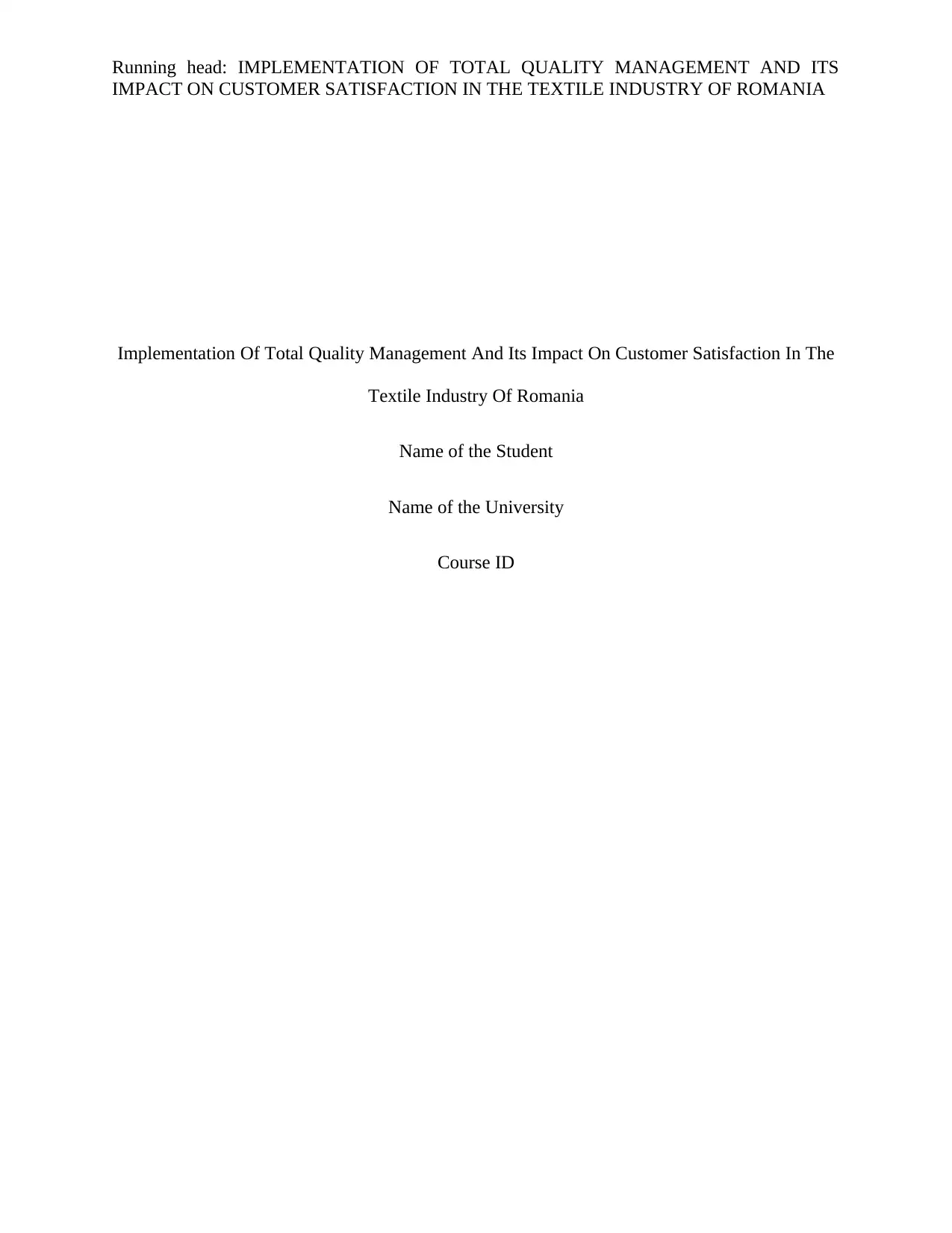
Running head: IMPLEMENTATION OF TOTAL QUALITY MANAGEMENT AND ITS
IMPACT ON CUSTOMER SATISFACTION IN THE TEXTILE INDUSTRY OF ROMANIA
Implementation Of Total Quality Management And Its Impact On Customer Satisfaction In The
Textile Industry Of Romania
Name of the Student
Name of the University
Course ID
IMPACT ON CUSTOMER SATISFACTION IN THE TEXTILE INDUSTRY OF ROMANIA
Implementation Of Total Quality Management And Its Impact On Customer Satisfaction In The
Textile Industry Of Romania
Name of the Student
Name of the University
Course ID
Secure Best Marks with AI Grader
Need help grading? Try our AI Grader for instant feedback on your assignments.
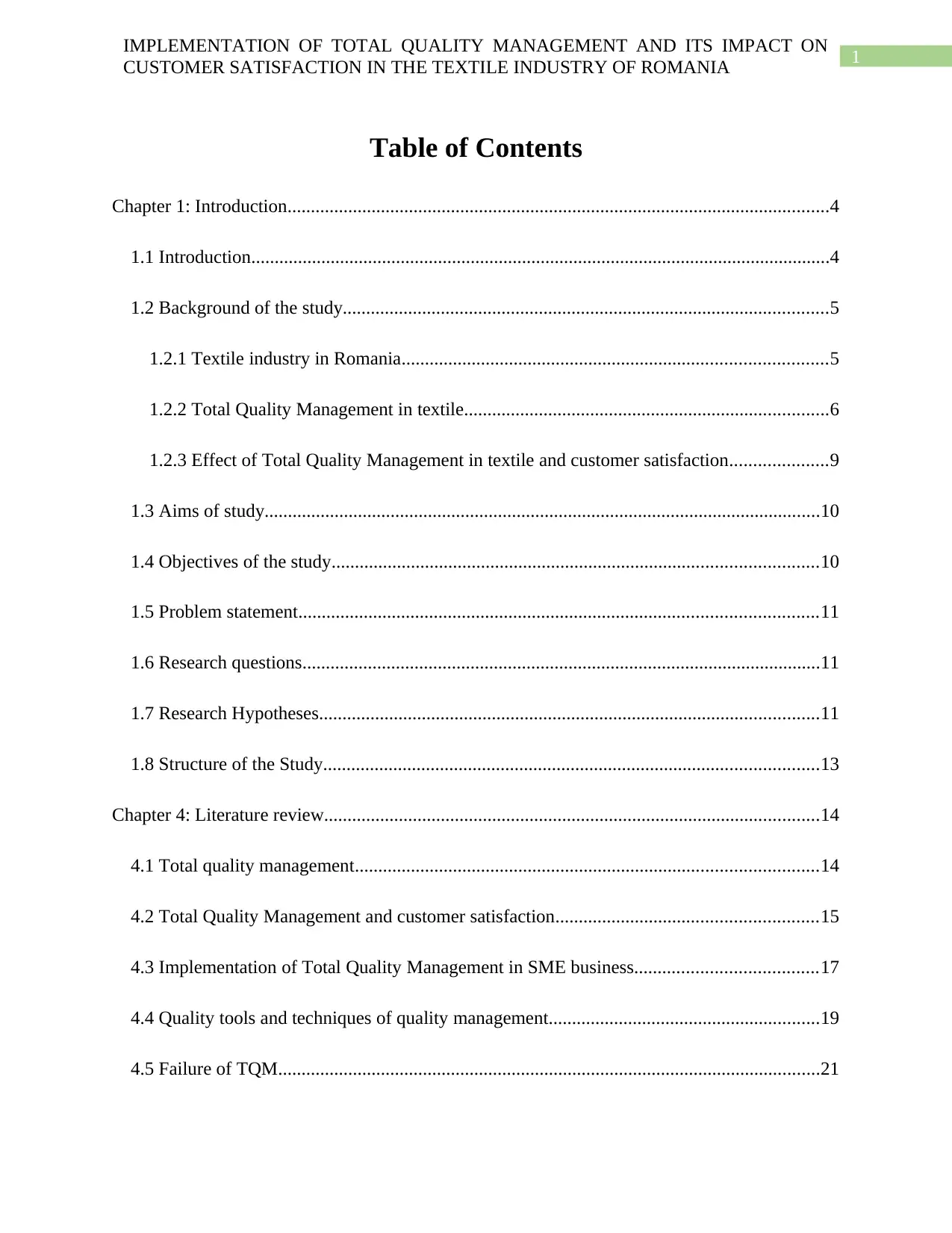
1
IMPLEMENTATION OF TOTAL QUALITY MANAGEMENT AND ITS IMPACT ON
CUSTOMER SATISFACTION IN THE TEXTILE INDUSTRY OF ROMANIA
Table of Contents
Chapter 1: Introduction....................................................................................................................4
1.1 Introduction............................................................................................................................4
1.2 Background of the study........................................................................................................5
1.2.1 Textile industry in Romania...........................................................................................5
1.2.2 Total Quality Management in textile..............................................................................6
1.2.3 Effect of Total Quality Management in textile and customer satisfaction.....................9
1.3 Aims of study.......................................................................................................................10
1.4 Objectives of the study........................................................................................................10
1.5 Problem statement...............................................................................................................11
1.6 Research questions...............................................................................................................11
1.7 Research Hypotheses...........................................................................................................11
1.8 Structure of the Study..........................................................................................................13
Chapter 4: Literature review..........................................................................................................14
4.1 Total quality management...................................................................................................14
4.2 Total Quality Management and customer satisfaction........................................................15
4.3 Implementation of Total Quality Management in SME business.......................................17
4.4 Quality tools and techniques of quality management..........................................................19
4.5 Failure of TQM....................................................................................................................21
IMPLEMENTATION OF TOTAL QUALITY MANAGEMENT AND ITS IMPACT ON
CUSTOMER SATISFACTION IN THE TEXTILE INDUSTRY OF ROMANIA
Table of Contents
Chapter 1: Introduction....................................................................................................................4
1.1 Introduction............................................................................................................................4
1.2 Background of the study........................................................................................................5
1.2.1 Textile industry in Romania...........................................................................................5
1.2.2 Total Quality Management in textile..............................................................................6
1.2.3 Effect of Total Quality Management in textile and customer satisfaction.....................9
1.3 Aims of study.......................................................................................................................10
1.4 Objectives of the study........................................................................................................10
1.5 Problem statement...............................................................................................................11
1.6 Research questions...............................................................................................................11
1.7 Research Hypotheses...........................................................................................................11
1.8 Structure of the Study..........................................................................................................13
Chapter 4: Literature review..........................................................................................................14
4.1 Total quality management...................................................................................................14
4.2 Total Quality Management and customer satisfaction........................................................15
4.3 Implementation of Total Quality Management in SME business.......................................17
4.4 Quality tools and techniques of quality management..........................................................19
4.5 Failure of TQM....................................................................................................................21
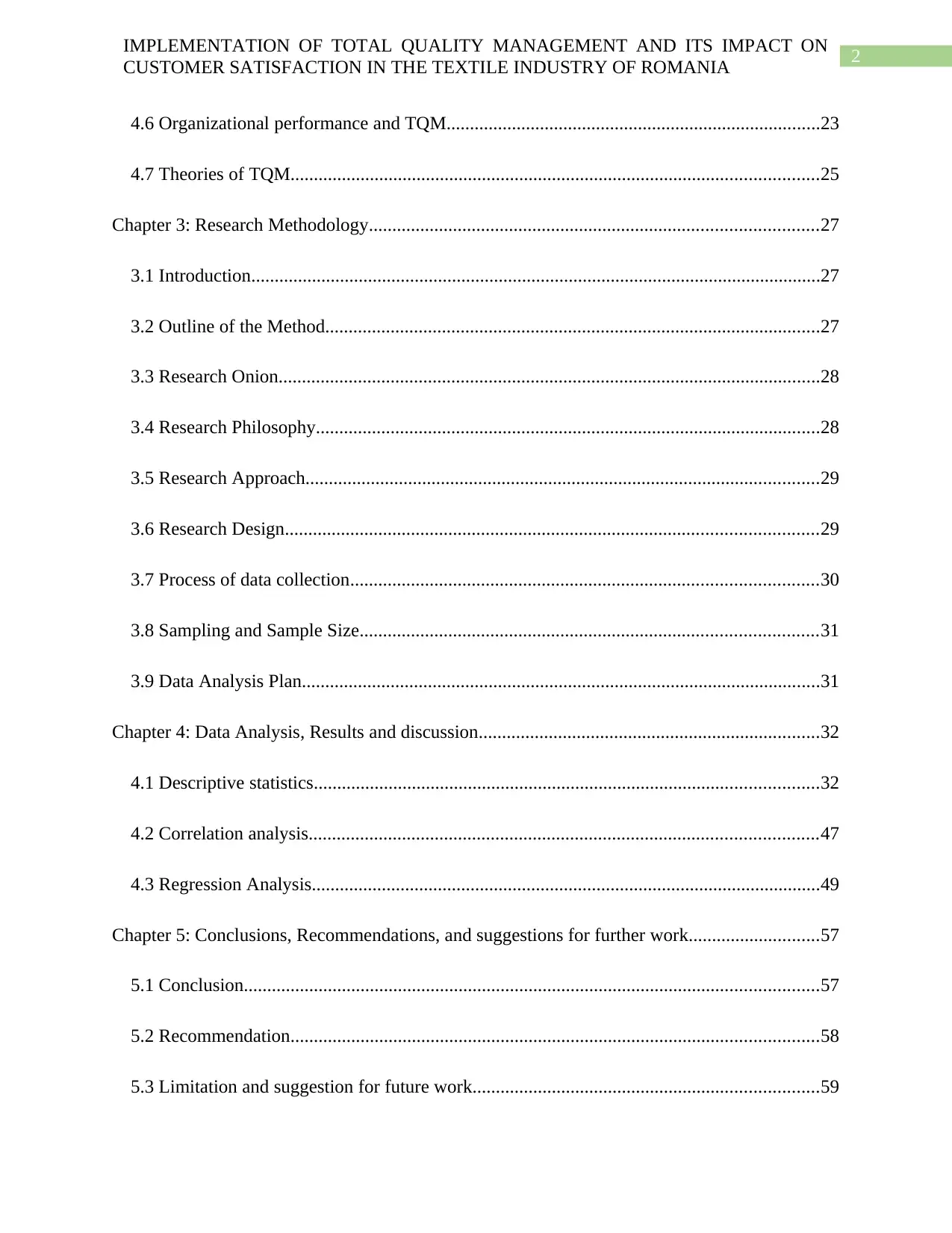
2
IMPLEMENTATION OF TOTAL QUALITY MANAGEMENT AND ITS IMPACT ON
CUSTOMER SATISFACTION IN THE TEXTILE INDUSTRY OF ROMANIA
4.6 Organizational performance and TQM................................................................................23
4.7 Theories of TQM.................................................................................................................25
Chapter 3: Research Methodology................................................................................................27
3.1 Introduction..........................................................................................................................27
3.2 Outline of the Method..........................................................................................................27
3.3 Research Onion....................................................................................................................28
3.4 Research Philosophy............................................................................................................28
3.5 Research Approach..............................................................................................................29
3.6 Research Design..................................................................................................................29
3.7 Process of data collection....................................................................................................30
3.8 Sampling and Sample Size..................................................................................................31
3.9 Data Analysis Plan...............................................................................................................31
Chapter 4: Data Analysis, Results and discussion.........................................................................32
4.1 Descriptive statistics............................................................................................................32
4.2 Correlation analysis.............................................................................................................47
4.3 Regression Analysis.............................................................................................................49
Chapter 5: Conclusions, Recommendations, and suggestions for further work............................57
5.1 Conclusion...........................................................................................................................57
5.2 Recommendation.................................................................................................................58
5.3 Limitation and suggestion for future work..........................................................................59
IMPLEMENTATION OF TOTAL QUALITY MANAGEMENT AND ITS IMPACT ON
CUSTOMER SATISFACTION IN THE TEXTILE INDUSTRY OF ROMANIA
4.6 Organizational performance and TQM................................................................................23
4.7 Theories of TQM.................................................................................................................25
Chapter 3: Research Methodology................................................................................................27
3.1 Introduction..........................................................................................................................27
3.2 Outline of the Method..........................................................................................................27
3.3 Research Onion....................................................................................................................28
3.4 Research Philosophy............................................................................................................28
3.5 Research Approach..............................................................................................................29
3.6 Research Design..................................................................................................................29
3.7 Process of data collection....................................................................................................30
3.8 Sampling and Sample Size..................................................................................................31
3.9 Data Analysis Plan...............................................................................................................31
Chapter 4: Data Analysis, Results and discussion.........................................................................32
4.1 Descriptive statistics............................................................................................................32
4.2 Correlation analysis.............................................................................................................47
4.3 Regression Analysis.............................................................................................................49
Chapter 5: Conclusions, Recommendations, and suggestions for further work............................57
5.1 Conclusion...........................................................................................................................57
5.2 Recommendation.................................................................................................................58
5.3 Limitation and suggestion for future work..........................................................................59
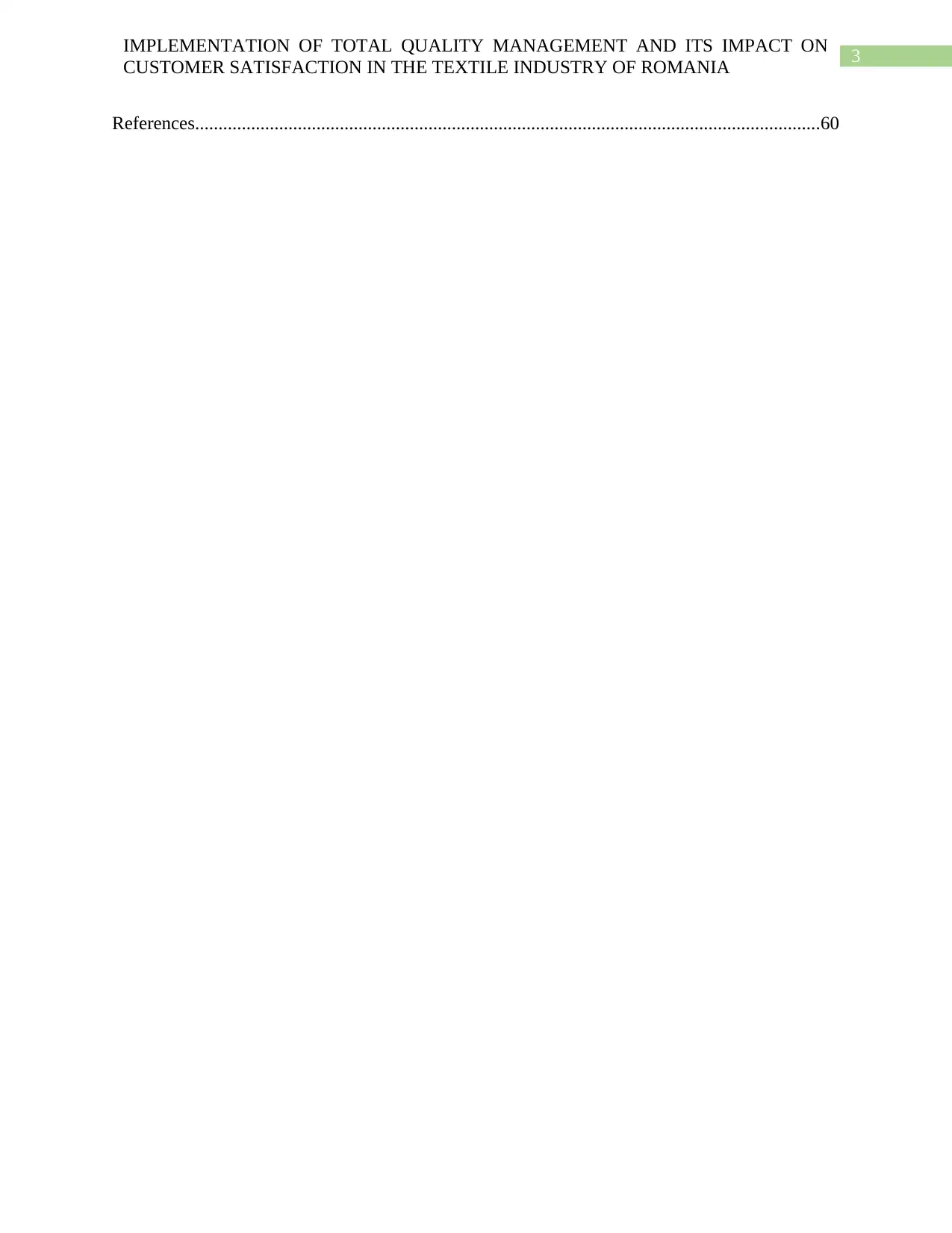
3
IMPLEMENTATION OF TOTAL QUALITY MANAGEMENT AND ITS IMPACT ON
CUSTOMER SATISFACTION IN THE TEXTILE INDUSTRY OF ROMANIA
References......................................................................................................................................60
IMPLEMENTATION OF TOTAL QUALITY MANAGEMENT AND ITS IMPACT ON
CUSTOMER SATISFACTION IN THE TEXTILE INDUSTRY OF ROMANIA
References......................................................................................................................................60
Secure Best Marks with AI Grader
Need help grading? Try our AI Grader for instant feedback on your assignments.
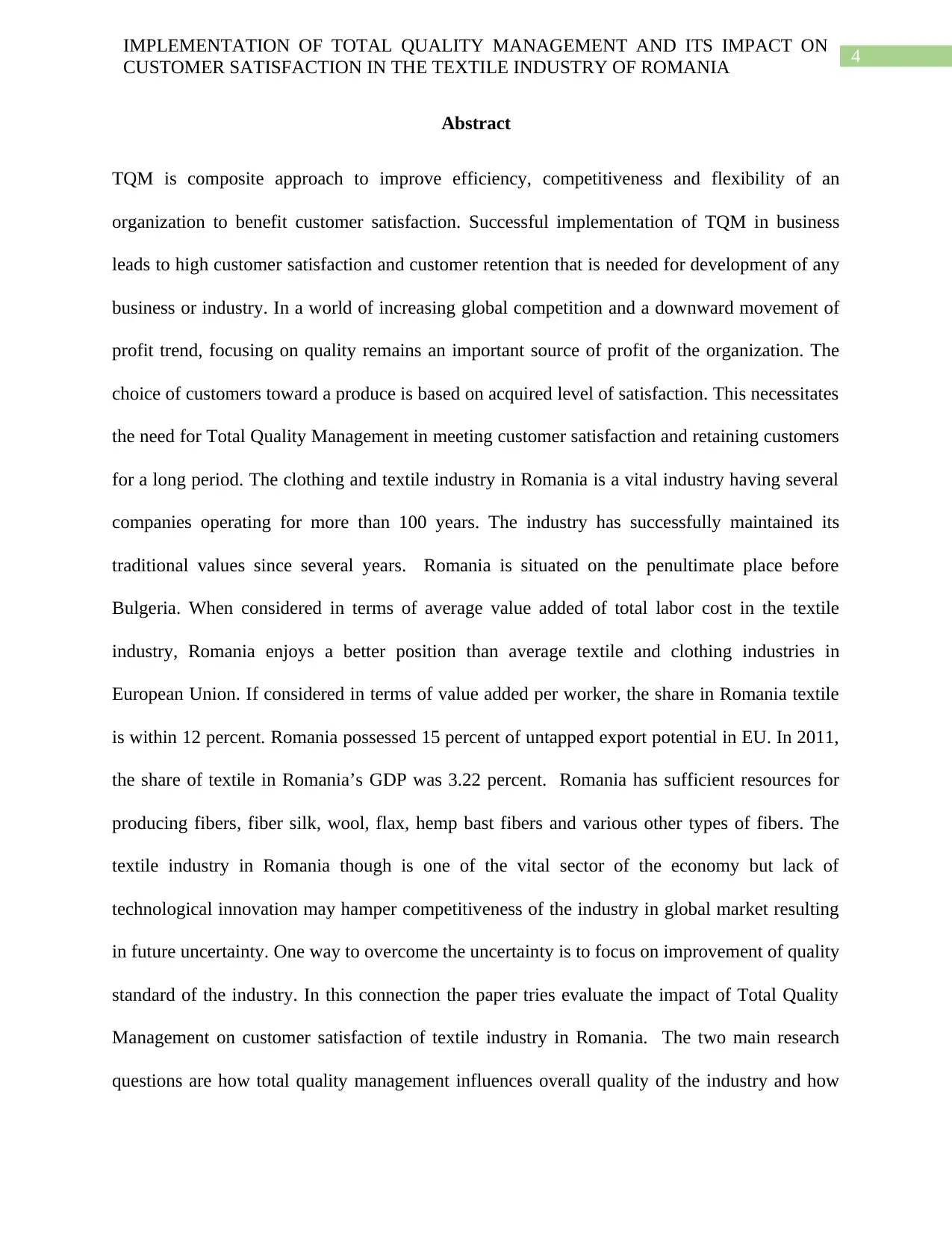
4
IMPLEMENTATION OF TOTAL QUALITY MANAGEMENT AND ITS IMPACT ON
CUSTOMER SATISFACTION IN THE TEXTILE INDUSTRY OF ROMANIA
Abstract
TQM is composite approach to improve efficiency, competitiveness and flexibility of an
organization to benefit customer satisfaction. Successful implementation of TQM in business
leads to high customer satisfaction and customer retention that is needed for development of any
business or industry. In a world of increasing global competition and a downward movement of
profit trend, focusing on quality remains an important source of profit of the organization. The
choice of customers toward a produce is based on acquired level of satisfaction. This necessitates
the need for Total Quality Management in meeting customer satisfaction and retaining customers
for a long period. The clothing and textile industry in Romania is a vital industry having several
companies operating for more than 100 years. The industry has successfully maintained its
traditional values since several years. Romania is situated on the penultimate place before
Bulgeria. When considered in terms of average value added of total labor cost in the textile
industry, Romania enjoys a better position than average textile and clothing industries in
European Union. If considered in terms of value added per worker, the share in Romania textile
is within 12 percent. Romania possessed 15 percent of untapped export potential in EU. In 2011,
the share of textile in Romania’s GDP was 3.22 percent. Romania has sufficient resources for
producing fibers, fiber silk, wool, flax, hemp bast fibers and various other types of fibers. The
textile industry in Romania though is one of the vital sector of the economy but lack of
technological innovation may hamper competitiveness of the industry in global market resulting
in future uncertainty. One way to overcome the uncertainty is to focus on improvement of quality
standard of the industry. In this connection the paper tries evaluate the impact of Total Quality
Management on customer satisfaction of textile industry in Romania. The two main research
questions are how total quality management influences overall quality of the industry and how
IMPLEMENTATION OF TOTAL QUALITY MANAGEMENT AND ITS IMPACT ON
CUSTOMER SATISFACTION IN THE TEXTILE INDUSTRY OF ROMANIA
Abstract
TQM is composite approach to improve efficiency, competitiveness and flexibility of an
organization to benefit customer satisfaction. Successful implementation of TQM in business
leads to high customer satisfaction and customer retention that is needed for development of any
business or industry. In a world of increasing global competition and a downward movement of
profit trend, focusing on quality remains an important source of profit of the organization. The
choice of customers toward a produce is based on acquired level of satisfaction. This necessitates
the need for Total Quality Management in meeting customer satisfaction and retaining customers
for a long period. The clothing and textile industry in Romania is a vital industry having several
companies operating for more than 100 years. The industry has successfully maintained its
traditional values since several years. Romania is situated on the penultimate place before
Bulgeria. When considered in terms of average value added of total labor cost in the textile
industry, Romania enjoys a better position than average textile and clothing industries in
European Union. If considered in terms of value added per worker, the share in Romania textile
is within 12 percent. Romania possessed 15 percent of untapped export potential in EU. In 2011,
the share of textile in Romania’s GDP was 3.22 percent. Romania has sufficient resources for
producing fibers, fiber silk, wool, flax, hemp bast fibers and various other types of fibers. The
textile industry in Romania though is one of the vital sector of the economy but lack of
technological innovation may hamper competitiveness of the industry in global market resulting
in future uncertainty. One way to overcome the uncertainty is to focus on improvement of quality
standard of the industry. In this connection the paper tries evaluate the impact of Total Quality
Management on customer satisfaction of textile industry in Romania. The two main research
questions are how total quality management influences overall quality of the industry and how
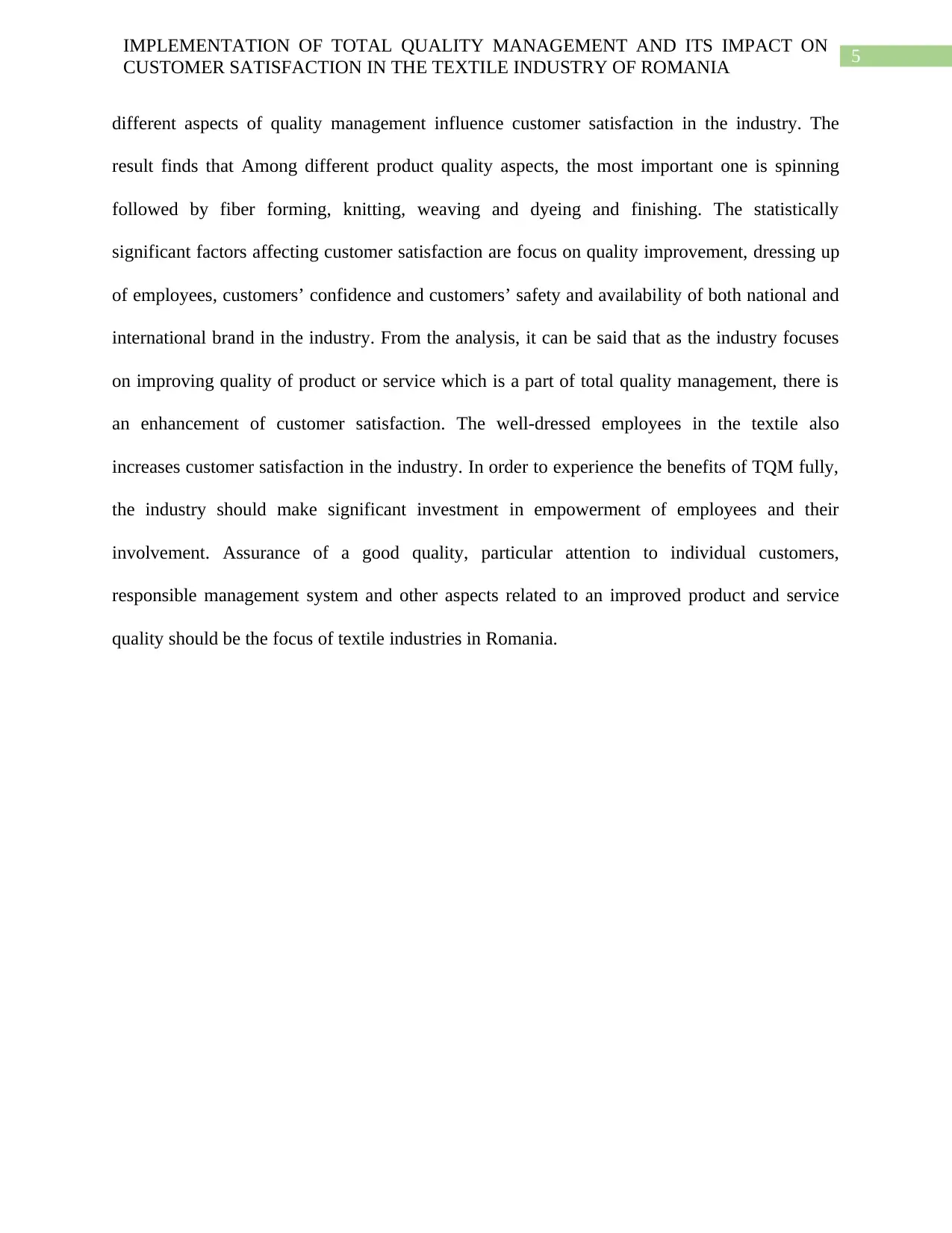
5
IMPLEMENTATION OF TOTAL QUALITY MANAGEMENT AND ITS IMPACT ON
CUSTOMER SATISFACTION IN THE TEXTILE INDUSTRY OF ROMANIA
different aspects of quality management influence customer satisfaction in the industry. The
result finds that Among different product quality aspects, the most important one is spinning
followed by fiber forming, knitting, weaving and dyeing and finishing. The statistically
significant factors affecting customer satisfaction are focus on quality improvement, dressing up
of employees, customers’ confidence and customers’ safety and availability of both national and
international brand in the industry. From the analysis, it can be said that as the industry focuses
on improving quality of product or service which is a part of total quality management, there is
an enhancement of customer satisfaction. The well-dressed employees in the textile also
increases customer satisfaction in the industry. In order to experience the benefits of TQM fully,
the industry should make significant investment in empowerment of employees and their
involvement. Assurance of a good quality, particular attention to individual customers,
responsible management system and other aspects related to an improved product and service
quality should be the focus of textile industries in Romania.
IMPLEMENTATION OF TOTAL QUALITY MANAGEMENT AND ITS IMPACT ON
CUSTOMER SATISFACTION IN THE TEXTILE INDUSTRY OF ROMANIA
different aspects of quality management influence customer satisfaction in the industry. The
result finds that Among different product quality aspects, the most important one is spinning
followed by fiber forming, knitting, weaving and dyeing and finishing. The statistically
significant factors affecting customer satisfaction are focus on quality improvement, dressing up
of employees, customers’ confidence and customers’ safety and availability of both national and
international brand in the industry. From the analysis, it can be said that as the industry focuses
on improving quality of product or service which is a part of total quality management, there is
an enhancement of customer satisfaction. The well-dressed employees in the textile also
increases customer satisfaction in the industry. In order to experience the benefits of TQM fully,
the industry should make significant investment in empowerment of employees and their
involvement. Assurance of a good quality, particular attention to individual customers,
responsible management system and other aspects related to an improved product and service
quality should be the focus of textile industries in Romania.
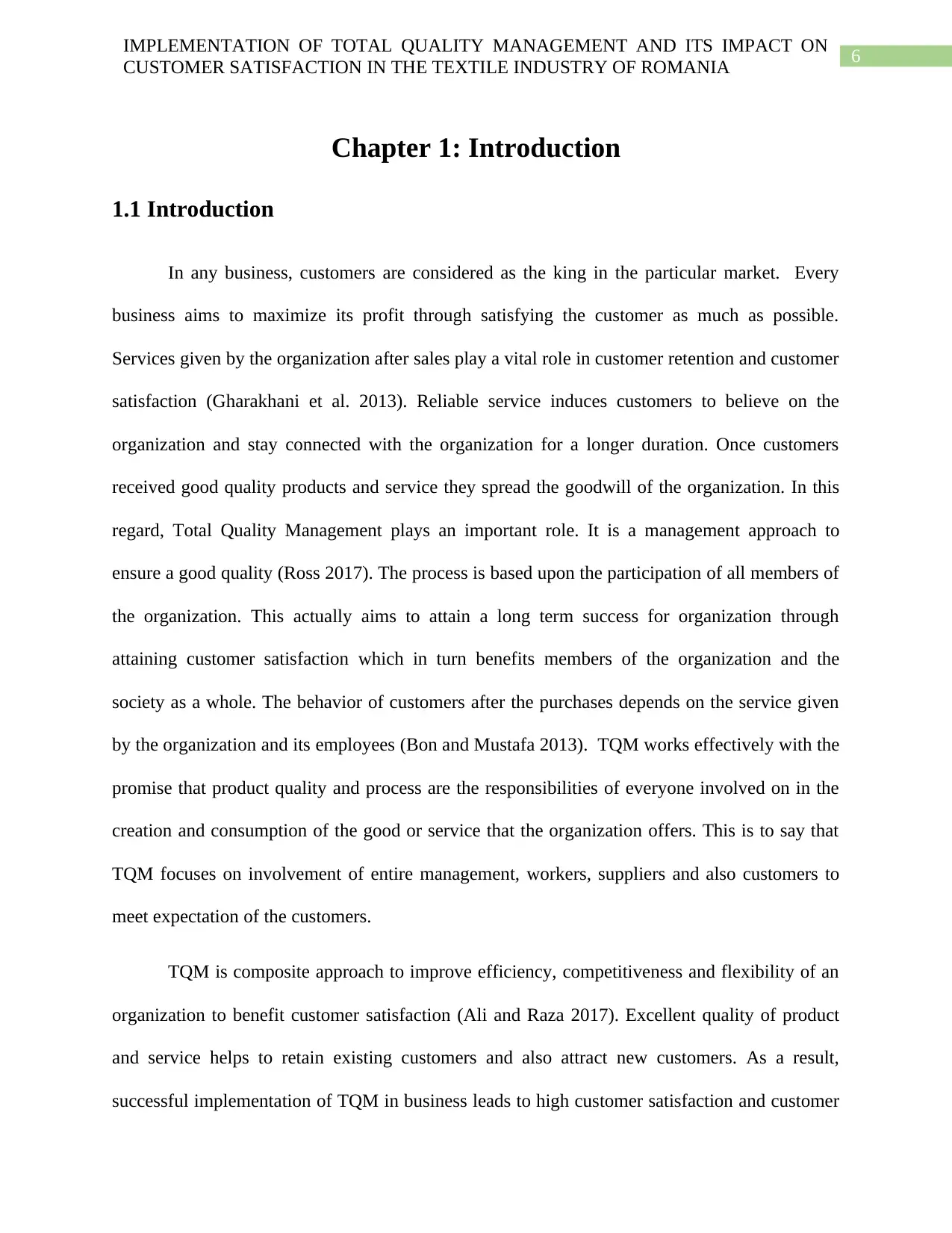
6
IMPLEMENTATION OF TOTAL QUALITY MANAGEMENT AND ITS IMPACT ON
CUSTOMER SATISFACTION IN THE TEXTILE INDUSTRY OF ROMANIA
Chapter 1: Introduction
1.1 Introduction
In any business, customers are considered as the king in the particular market. Every
business aims to maximize its profit through satisfying the customer as much as possible.
Services given by the organization after sales play a vital role in customer retention and customer
satisfaction (Gharakhani et al. 2013). Reliable service induces customers to believe on the
organization and stay connected with the organization for a longer duration. Once customers
received good quality products and service they spread the goodwill of the organization. In this
regard, Total Quality Management plays an important role. It is a management approach to
ensure a good quality (Ross 2017). The process is based upon the participation of all members of
the organization. This actually aims to attain a long term success for organization through
attaining customer satisfaction which in turn benefits members of the organization and the
society as a whole. The behavior of customers after the purchases depends on the service given
by the organization and its employees (Bon and Mustafa 2013). TQM works effectively with the
promise that product quality and process are the responsibilities of everyone involved on in the
creation and consumption of the good or service that the organization offers. This is to say that
TQM focuses on involvement of entire management, workers, suppliers and also customers to
meet expectation of the customers.
TQM is composite approach to improve efficiency, competitiveness and flexibility of an
organization to benefit customer satisfaction (Ali and Raza 2017). Excellent quality of product
and service helps to retain existing customers and also attract new customers. As a result,
successful implementation of TQM in business leads to high customer satisfaction and customer
IMPLEMENTATION OF TOTAL QUALITY MANAGEMENT AND ITS IMPACT ON
CUSTOMER SATISFACTION IN THE TEXTILE INDUSTRY OF ROMANIA
Chapter 1: Introduction
1.1 Introduction
In any business, customers are considered as the king in the particular market. Every
business aims to maximize its profit through satisfying the customer as much as possible.
Services given by the organization after sales play a vital role in customer retention and customer
satisfaction (Gharakhani et al. 2013). Reliable service induces customers to believe on the
organization and stay connected with the organization for a longer duration. Once customers
received good quality products and service they spread the goodwill of the organization. In this
regard, Total Quality Management plays an important role. It is a management approach to
ensure a good quality (Ross 2017). The process is based upon the participation of all members of
the organization. This actually aims to attain a long term success for organization through
attaining customer satisfaction which in turn benefits members of the organization and the
society as a whole. The behavior of customers after the purchases depends on the service given
by the organization and its employees (Bon and Mustafa 2013). TQM works effectively with the
promise that product quality and process are the responsibilities of everyone involved on in the
creation and consumption of the good or service that the organization offers. This is to say that
TQM focuses on involvement of entire management, workers, suppliers and also customers to
meet expectation of the customers.
TQM is composite approach to improve efficiency, competitiveness and flexibility of an
organization to benefit customer satisfaction (Ali and Raza 2017). Excellent quality of product
and service helps to retain existing customers and also attract new customers. As a result,
successful implementation of TQM in business leads to high customer satisfaction and customer
Paraphrase This Document
Need a fresh take? Get an instant paraphrase of this document with our AI Paraphraser
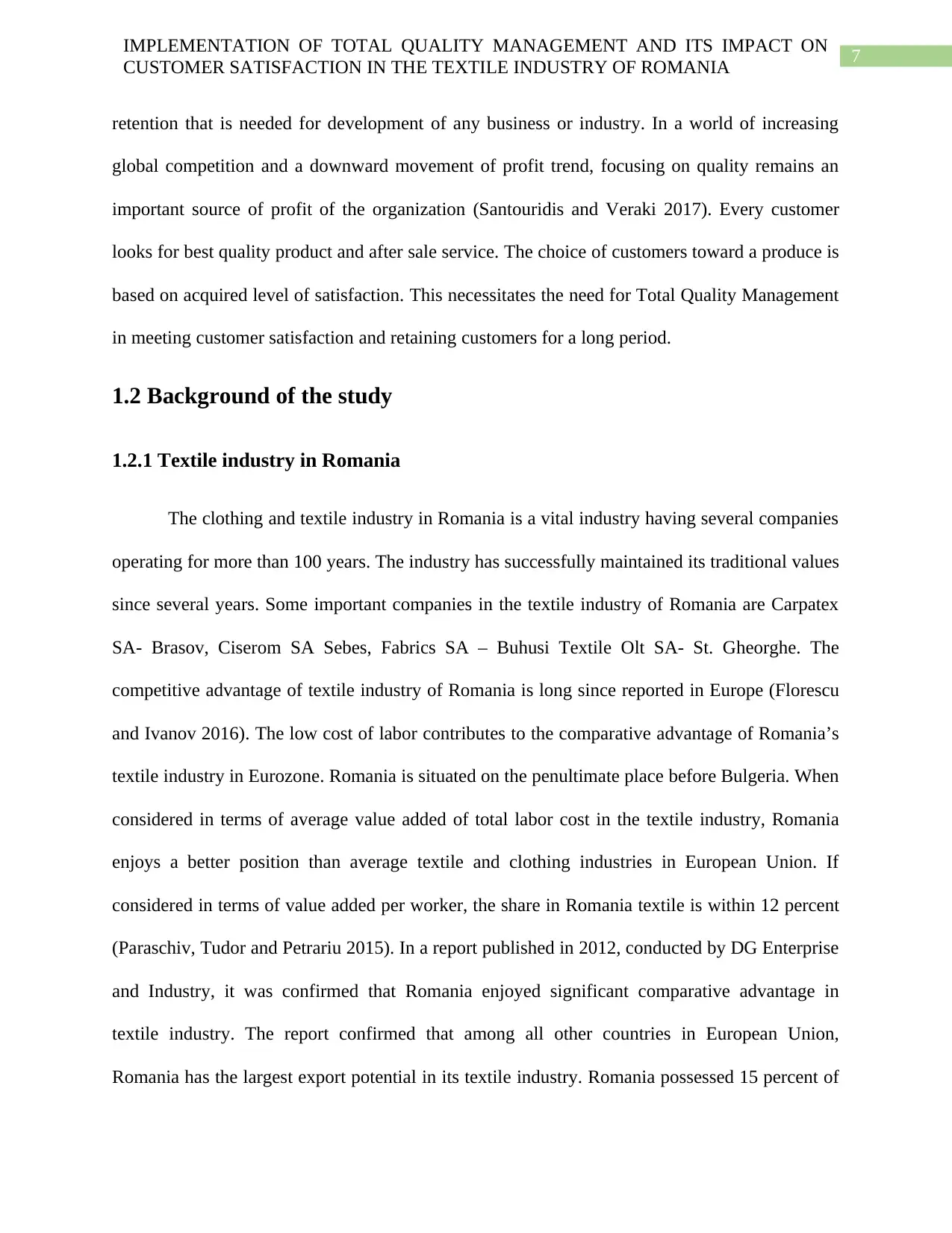
7
IMPLEMENTATION OF TOTAL QUALITY MANAGEMENT AND ITS IMPACT ON
CUSTOMER SATISFACTION IN THE TEXTILE INDUSTRY OF ROMANIA
retention that is needed for development of any business or industry. In a world of increasing
global competition and a downward movement of profit trend, focusing on quality remains an
important source of profit of the organization (Santouridis and Veraki 2017). Every customer
looks for best quality product and after sale service. The choice of customers toward a produce is
based on acquired level of satisfaction. This necessitates the need for Total Quality Management
in meeting customer satisfaction and retaining customers for a long period.
1.2 Background of the study
1.2.1 Textile industry in Romania
The clothing and textile industry in Romania is a vital industry having several companies
operating for more than 100 years. The industry has successfully maintained its traditional values
since several years. Some important companies in the textile industry of Romania are Carpatex
SA- Brasov, Ciserom SA Sebes, Fabrics SA – Buhusi Textile Olt SA- St. Gheorghe. The
competitive advantage of textile industry of Romania is long since reported in Europe (Florescu
and Ivanov 2016). The low cost of labor contributes to the comparative advantage of Romania’s
textile industry in Eurozone. Romania is situated on the penultimate place before Bulgeria. When
considered in terms of average value added of total labor cost in the textile industry, Romania
enjoys a better position than average textile and clothing industries in European Union. If
considered in terms of value added per worker, the share in Romania textile is within 12 percent
(Paraschiv, Tudor and Petrariu 2015). In a report published in 2012, conducted by DG Enterprise
and Industry, it was confirmed that Romania enjoyed significant comparative advantage in
textile industry. The report confirmed that among all other countries in European Union,
Romania has the largest export potential in its textile industry. Romania possessed 15 percent of
IMPLEMENTATION OF TOTAL QUALITY MANAGEMENT AND ITS IMPACT ON
CUSTOMER SATISFACTION IN THE TEXTILE INDUSTRY OF ROMANIA
retention that is needed for development of any business or industry. In a world of increasing
global competition and a downward movement of profit trend, focusing on quality remains an
important source of profit of the organization (Santouridis and Veraki 2017). Every customer
looks for best quality product and after sale service. The choice of customers toward a produce is
based on acquired level of satisfaction. This necessitates the need for Total Quality Management
in meeting customer satisfaction and retaining customers for a long period.
1.2 Background of the study
1.2.1 Textile industry in Romania
The clothing and textile industry in Romania is a vital industry having several companies
operating for more than 100 years. The industry has successfully maintained its traditional values
since several years. Some important companies in the textile industry of Romania are Carpatex
SA- Brasov, Ciserom SA Sebes, Fabrics SA – Buhusi Textile Olt SA- St. Gheorghe. The
competitive advantage of textile industry of Romania is long since reported in Europe (Florescu
and Ivanov 2016). The low cost of labor contributes to the comparative advantage of Romania’s
textile industry in Eurozone. Romania is situated on the penultimate place before Bulgeria. When
considered in terms of average value added of total labor cost in the textile industry, Romania
enjoys a better position than average textile and clothing industries in European Union. If
considered in terms of value added per worker, the share in Romania textile is within 12 percent
(Paraschiv, Tudor and Petrariu 2015). In a report published in 2012, conducted by DG Enterprise
and Industry, it was confirmed that Romania enjoyed significant comparative advantage in
textile industry. The report confirmed that among all other countries in European Union,
Romania has the largest export potential in its textile industry. Romania possessed 15 percent of
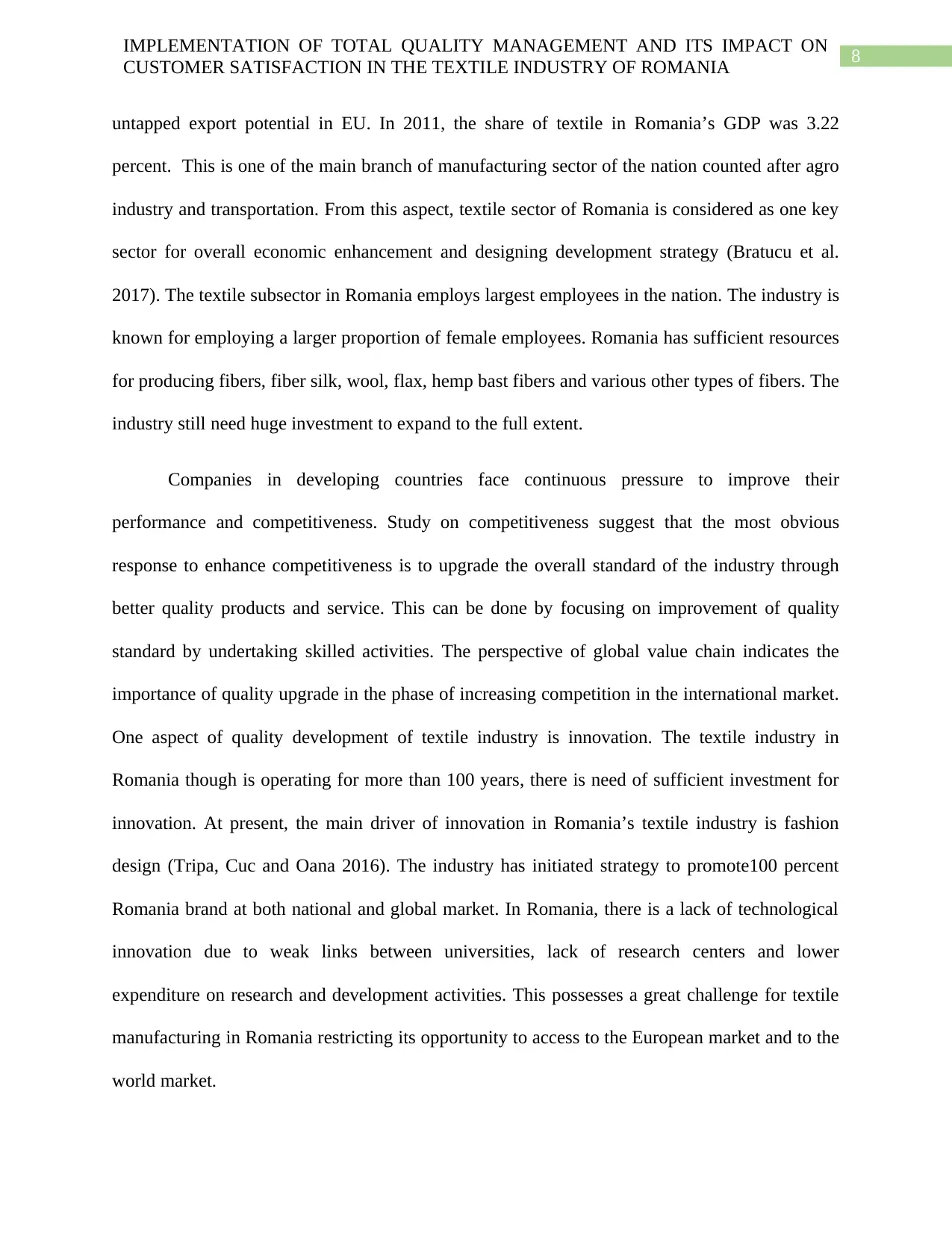
8
IMPLEMENTATION OF TOTAL QUALITY MANAGEMENT AND ITS IMPACT ON
CUSTOMER SATISFACTION IN THE TEXTILE INDUSTRY OF ROMANIA
untapped export potential in EU. In 2011, the share of textile in Romania’s GDP was 3.22
percent. This is one of the main branch of manufacturing sector of the nation counted after agro
industry and transportation. From this aspect, textile sector of Romania is considered as one key
sector for overall economic enhancement and designing development strategy (Bratucu et al.
2017). The textile subsector in Romania employs largest employees in the nation. The industry is
known for employing a larger proportion of female employees. Romania has sufficient resources
for producing fibers, fiber silk, wool, flax, hemp bast fibers and various other types of fibers. The
industry still need huge investment to expand to the full extent.
Companies in developing countries face continuous pressure to improve their
performance and competitiveness. Study on competitiveness suggest that the most obvious
response to enhance competitiveness is to upgrade the overall standard of the industry through
better quality products and service. This can be done by focusing on improvement of quality
standard by undertaking skilled activities. The perspective of global value chain indicates the
importance of quality upgrade in the phase of increasing competition in the international market.
One aspect of quality development of textile industry is innovation. The textile industry in
Romania though is operating for more than 100 years, there is need of sufficient investment for
innovation. At present, the main driver of innovation in Romania’s textile industry is fashion
design (Tripa, Cuc and Oana 2016). The industry has initiated strategy to promote100 percent
Romania brand at both national and global market. In Romania, there is a lack of technological
innovation due to weak links between universities, lack of research centers and lower
expenditure on research and development activities. This possesses a great challenge for textile
manufacturing in Romania restricting its opportunity to access to the European market and to the
world market.
IMPLEMENTATION OF TOTAL QUALITY MANAGEMENT AND ITS IMPACT ON
CUSTOMER SATISFACTION IN THE TEXTILE INDUSTRY OF ROMANIA
untapped export potential in EU. In 2011, the share of textile in Romania’s GDP was 3.22
percent. This is one of the main branch of manufacturing sector of the nation counted after agro
industry and transportation. From this aspect, textile sector of Romania is considered as one key
sector for overall economic enhancement and designing development strategy (Bratucu et al.
2017). The textile subsector in Romania employs largest employees in the nation. The industry is
known for employing a larger proportion of female employees. Romania has sufficient resources
for producing fibers, fiber silk, wool, flax, hemp bast fibers and various other types of fibers. The
industry still need huge investment to expand to the full extent.
Companies in developing countries face continuous pressure to improve their
performance and competitiveness. Study on competitiveness suggest that the most obvious
response to enhance competitiveness is to upgrade the overall standard of the industry through
better quality products and service. This can be done by focusing on improvement of quality
standard by undertaking skilled activities. The perspective of global value chain indicates the
importance of quality upgrade in the phase of increasing competition in the international market.
One aspect of quality development of textile industry is innovation. The textile industry in
Romania though is operating for more than 100 years, there is need of sufficient investment for
innovation. At present, the main driver of innovation in Romania’s textile industry is fashion
design (Tripa, Cuc and Oana 2016). The industry has initiated strategy to promote100 percent
Romania brand at both national and global market. In Romania, there is a lack of technological
innovation due to weak links between universities, lack of research centers and lower
expenditure on research and development activities. This possesses a great challenge for textile
manufacturing in Romania restricting its opportunity to access to the European market and to the
world market.
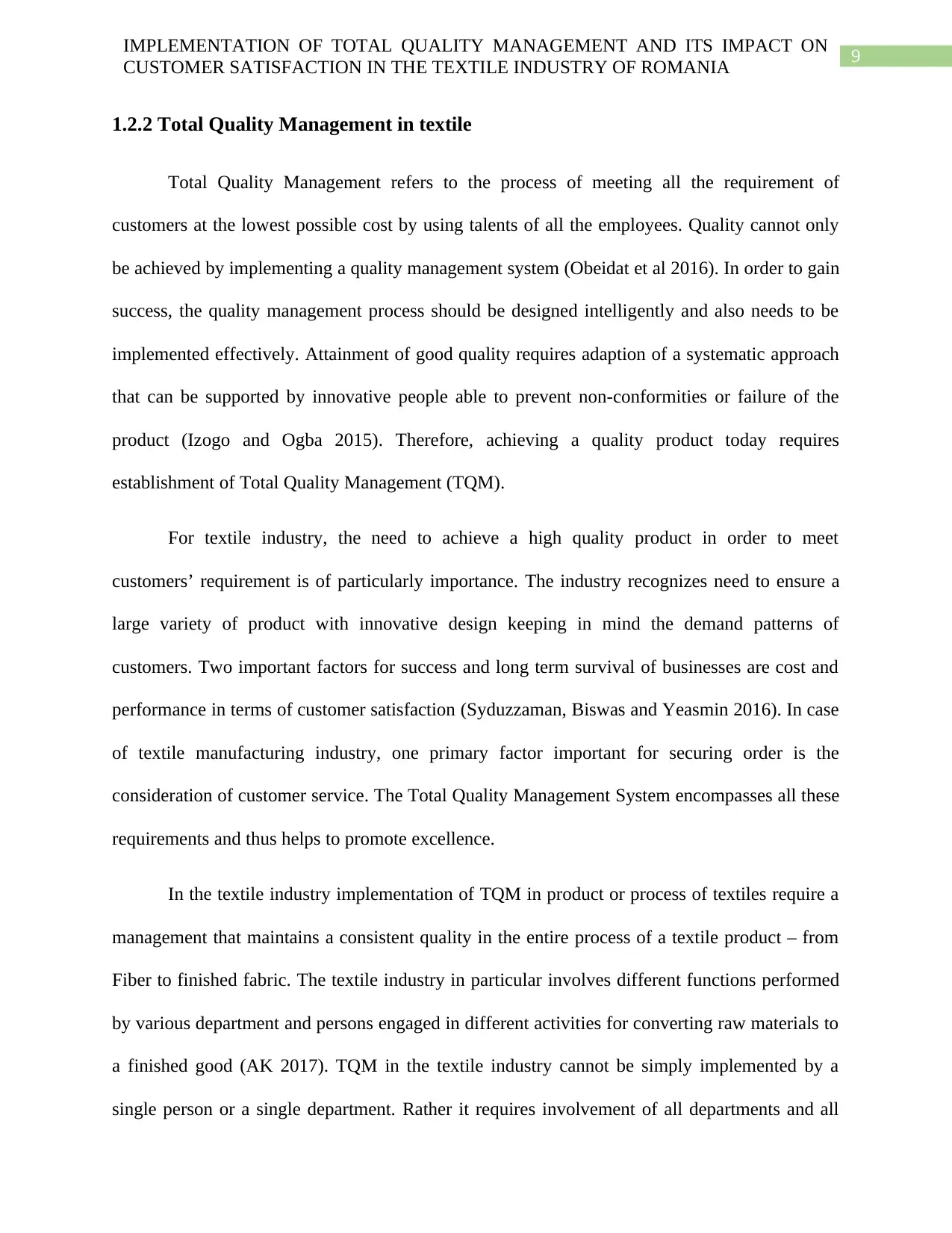
9
IMPLEMENTATION OF TOTAL QUALITY MANAGEMENT AND ITS IMPACT ON
CUSTOMER SATISFACTION IN THE TEXTILE INDUSTRY OF ROMANIA
1.2.2 Total Quality Management in textile
Total Quality Management refers to the process of meeting all the requirement of
customers at the lowest possible cost by using talents of all the employees. Quality cannot only
be achieved by implementing a quality management system (Obeidat et al 2016). In order to gain
success, the quality management process should be designed intelligently and also needs to be
implemented effectively. Attainment of good quality requires adaption of a systematic approach
that can be supported by innovative people able to prevent non-conformities or failure of the
product (Izogo and Ogba 2015). Therefore, achieving a quality product today requires
establishment of Total Quality Management (TQM).
For textile industry, the need to achieve a high quality product in order to meet
customers’ requirement is of particularly importance. The industry recognizes need to ensure a
large variety of product with innovative design keeping in mind the demand patterns of
customers. Two important factors for success and long term survival of businesses are cost and
performance in terms of customer satisfaction (Syduzzaman, Biswas and Yeasmin 2016). In case
of textile manufacturing industry, one primary factor important for securing order is the
consideration of customer service. The Total Quality Management System encompasses all these
requirements and thus helps to promote excellence.
In the textile industry implementation of TQM in product or process of textiles require a
management that maintains a consistent quality in the entire process of a textile product – from
Fiber to finished fabric. The textile industry in particular involves different functions performed
by various department and persons engaged in different activities for converting raw materials to
a finished good (AK 2017). TQM in the textile industry cannot be simply implemented by a
single person or a single department. Rather it requires involvement of all departments and all
IMPLEMENTATION OF TOTAL QUALITY MANAGEMENT AND ITS IMPACT ON
CUSTOMER SATISFACTION IN THE TEXTILE INDUSTRY OF ROMANIA
1.2.2 Total Quality Management in textile
Total Quality Management refers to the process of meeting all the requirement of
customers at the lowest possible cost by using talents of all the employees. Quality cannot only
be achieved by implementing a quality management system (Obeidat et al 2016). In order to gain
success, the quality management process should be designed intelligently and also needs to be
implemented effectively. Attainment of good quality requires adaption of a systematic approach
that can be supported by innovative people able to prevent non-conformities or failure of the
product (Izogo and Ogba 2015). Therefore, achieving a quality product today requires
establishment of Total Quality Management (TQM).
For textile industry, the need to achieve a high quality product in order to meet
customers’ requirement is of particularly importance. The industry recognizes need to ensure a
large variety of product with innovative design keeping in mind the demand patterns of
customers. Two important factors for success and long term survival of businesses are cost and
performance in terms of customer satisfaction (Syduzzaman, Biswas and Yeasmin 2016). In case
of textile manufacturing industry, one primary factor important for securing order is the
consideration of customer service. The Total Quality Management System encompasses all these
requirements and thus helps to promote excellence.
In the textile industry implementation of TQM in product or process of textiles require a
management that maintains a consistent quality in the entire process of a textile product – from
Fiber to finished fabric. The textile industry in particular involves different functions performed
by various department and persons engaged in different activities for converting raw materials to
a finished good (AK 2017). TQM in the textile industry cannot be simply implemented by a
single person or a single department. Rather it requires involvement of all departments and all
Secure Best Marks with AI Grader
Need help grading? Try our AI Grader for instant feedback on your assignments.
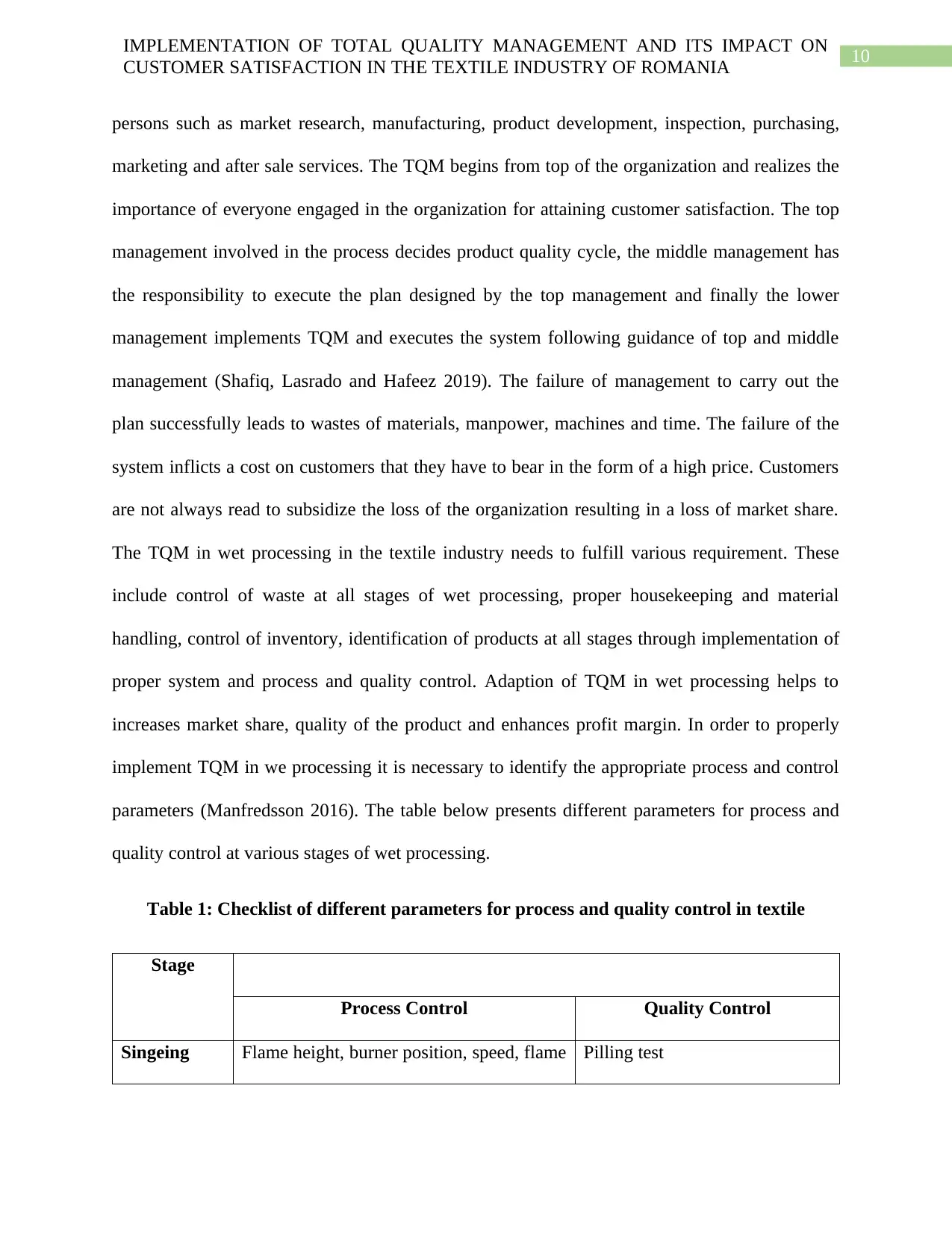
10
IMPLEMENTATION OF TOTAL QUALITY MANAGEMENT AND ITS IMPACT ON
CUSTOMER SATISFACTION IN THE TEXTILE INDUSTRY OF ROMANIA
persons such as market research, manufacturing, product development, inspection, purchasing,
marketing and after sale services. The TQM begins from top of the organization and realizes the
importance of everyone engaged in the organization for attaining customer satisfaction. The top
management involved in the process decides product quality cycle, the middle management has
the responsibility to execute the plan designed by the top management and finally the lower
management implements TQM and executes the system following guidance of top and middle
management (Shafiq, Lasrado and Hafeez 2019). The failure of management to carry out the
plan successfully leads to wastes of materials, manpower, machines and time. The failure of the
system inflicts a cost on customers that they have to bear in the form of a high price. Customers
are not always read to subsidize the loss of the organization resulting in a loss of market share.
The TQM in wet processing in the textile industry needs to fulfill various requirement. These
include control of waste at all stages of wet processing, proper housekeeping and material
handling, control of inventory, identification of products at all stages through implementation of
proper system and process and quality control. Adaption of TQM in wet processing helps to
increases market share, quality of the product and enhances profit margin. In order to properly
implement TQM in we processing it is necessary to identify the appropriate process and control
parameters (Manfredsson 2016). The table below presents different parameters for process and
quality control at various stages of wet processing.
Table 1: Checklist of different parameters for process and quality control in textile
Stage
Process Control Quality Control
Singeing Flame height, burner position, speed, flame Pilling test
IMPLEMENTATION OF TOTAL QUALITY MANAGEMENT AND ITS IMPACT ON
CUSTOMER SATISFACTION IN THE TEXTILE INDUSTRY OF ROMANIA
persons such as market research, manufacturing, product development, inspection, purchasing,
marketing and after sale services. The TQM begins from top of the organization and realizes the
importance of everyone engaged in the organization for attaining customer satisfaction. The top
management involved in the process decides product quality cycle, the middle management has
the responsibility to execute the plan designed by the top management and finally the lower
management implements TQM and executes the system following guidance of top and middle
management (Shafiq, Lasrado and Hafeez 2019). The failure of management to carry out the
plan successfully leads to wastes of materials, manpower, machines and time. The failure of the
system inflicts a cost on customers that they have to bear in the form of a high price. Customers
are not always read to subsidize the loss of the organization resulting in a loss of market share.
The TQM in wet processing in the textile industry needs to fulfill various requirement. These
include control of waste at all stages of wet processing, proper housekeeping and material
handling, control of inventory, identification of products at all stages through implementation of
proper system and process and quality control. Adaption of TQM in wet processing helps to
increases market share, quality of the product and enhances profit margin. In order to properly
implement TQM in we processing it is necessary to identify the appropriate process and control
parameters (Manfredsson 2016). The table below presents different parameters for process and
quality control at various stages of wet processing.
Table 1: Checklist of different parameters for process and quality control in textile
Stage
Process Control Quality Control
Singeing Flame height, burner position, speed, flame Pilling test
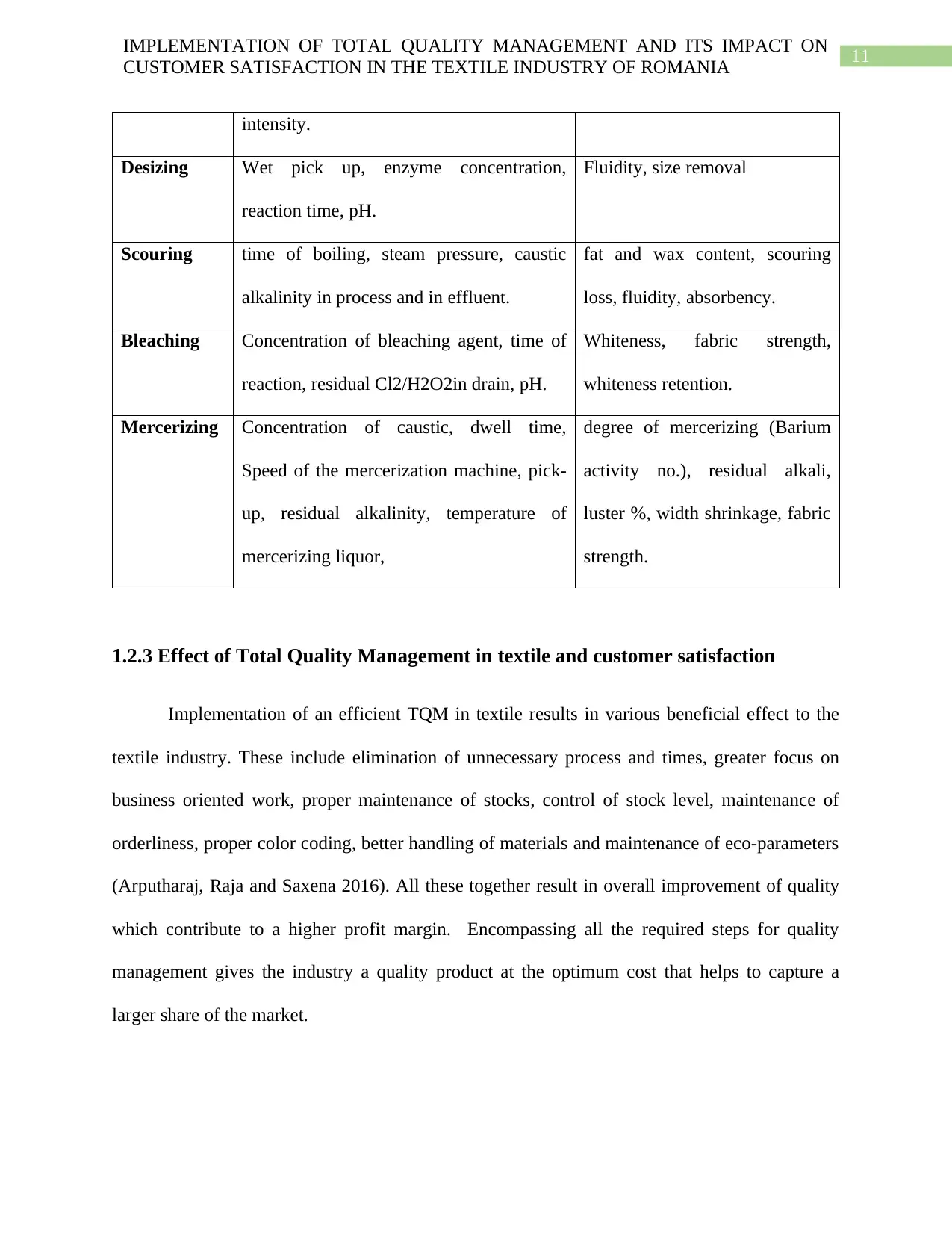
11
IMPLEMENTATION OF TOTAL QUALITY MANAGEMENT AND ITS IMPACT ON
CUSTOMER SATISFACTION IN THE TEXTILE INDUSTRY OF ROMANIA
intensity.
Desizing Wet pick up, enzyme concentration,
reaction time, pH.
Fluidity, size removal
Scouring time of boiling, steam pressure, caustic
alkalinity in process and in effluent.
fat and wax content, scouring
loss, fluidity, absorbency.
Bleaching Concentration of bleaching agent, time of
reaction, residual Cl2/H2O2in drain, pH.
Whiteness, fabric strength,
whiteness retention.
Mercerizing Concentration of caustic, dwell time,
Speed of the mercerization machine, pick-
up, residual alkalinity, temperature of
mercerizing liquor,
degree of mercerizing (Barium
activity no.), residual alkali,
luster %, width shrinkage, fabric
strength.
1.2.3 Effect of Total Quality Management in textile and customer satisfaction
Implementation of an efficient TQM in textile results in various beneficial effect to the
textile industry. These include elimination of unnecessary process and times, greater focus on
business oriented work, proper maintenance of stocks, control of stock level, maintenance of
orderliness, proper color coding, better handling of materials and maintenance of eco-parameters
(Arputharaj, Raja and Saxena 2016). All these together result in overall improvement of quality
which contribute to a higher profit margin. Encompassing all the required steps for quality
management gives the industry a quality product at the optimum cost that helps to capture a
larger share of the market.
IMPLEMENTATION OF TOTAL QUALITY MANAGEMENT AND ITS IMPACT ON
CUSTOMER SATISFACTION IN THE TEXTILE INDUSTRY OF ROMANIA
intensity.
Desizing Wet pick up, enzyme concentration,
reaction time, pH.
Fluidity, size removal
Scouring time of boiling, steam pressure, caustic
alkalinity in process and in effluent.
fat and wax content, scouring
loss, fluidity, absorbency.
Bleaching Concentration of bleaching agent, time of
reaction, residual Cl2/H2O2in drain, pH.
Whiteness, fabric strength,
whiteness retention.
Mercerizing Concentration of caustic, dwell time,
Speed of the mercerization machine, pick-
up, residual alkalinity, temperature of
mercerizing liquor,
degree of mercerizing (Barium
activity no.), residual alkali,
luster %, width shrinkage, fabric
strength.
1.2.3 Effect of Total Quality Management in textile and customer satisfaction
Implementation of an efficient TQM in textile results in various beneficial effect to the
textile industry. These include elimination of unnecessary process and times, greater focus on
business oriented work, proper maintenance of stocks, control of stock level, maintenance of
orderliness, proper color coding, better handling of materials and maintenance of eco-parameters
(Arputharaj, Raja and Saxena 2016). All these together result in overall improvement of quality
which contribute to a higher profit margin. Encompassing all the required steps for quality
management gives the industry a quality product at the optimum cost that helps to capture a
larger share of the market.
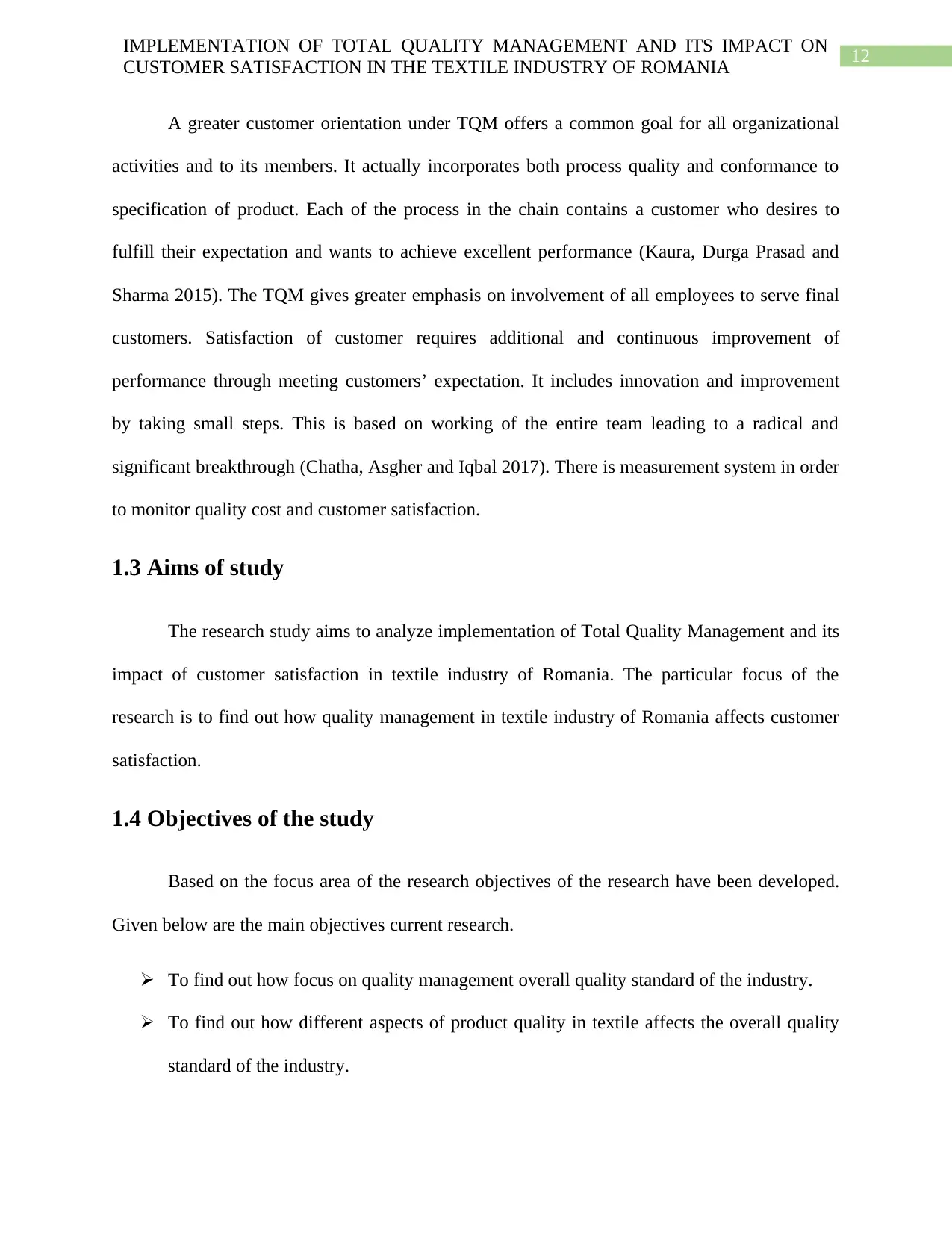
12
IMPLEMENTATION OF TOTAL QUALITY MANAGEMENT AND ITS IMPACT ON
CUSTOMER SATISFACTION IN THE TEXTILE INDUSTRY OF ROMANIA
A greater customer orientation under TQM offers a common goal for all organizational
activities and to its members. It actually incorporates both process quality and conformance to
specification of product. Each of the process in the chain contains a customer who desires to
fulfill their expectation and wants to achieve excellent performance (Kaura, Durga Prasad and
Sharma 2015). The TQM gives greater emphasis on involvement of all employees to serve final
customers. Satisfaction of customer requires additional and continuous improvement of
performance through meeting customers’ expectation. It includes innovation and improvement
by taking small steps. This is based on working of the entire team leading to a radical and
significant breakthrough (Chatha, Asgher and Iqbal 2017). There is measurement system in order
to monitor quality cost and customer satisfaction.
1.3 Aims of study
The research study aims to analyze implementation of Total Quality Management and its
impact of customer satisfaction in textile industry of Romania. The particular focus of the
research is to find out how quality management in textile industry of Romania affects customer
satisfaction.
1.4 Objectives of the study
Based on the focus area of the research objectives of the research have been developed.
Given below are the main objectives current research.
To find out how focus on quality management overall quality standard of the industry.
To find out how different aspects of product quality in textile affects the overall quality
standard of the industry.
IMPLEMENTATION OF TOTAL QUALITY MANAGEMENT AND ITS IMPACT ON
CUSTOMER SATISFACTION IN THE TEXTILE INDUSTRY OF ROMANIA
A greater customer orientation under TQM offers a common goal for all organizational
activities and to its members. It actually incorporates both process quality and conformance to
specification of product. Each of the process in the chain contains a customer who desires to
fulfill their expectation and wants to achieve excellent performance (Kaura, Durga Prasad and
Sharma 2015). The TQM gives greater emphasis on involvement of all employees to serve final
customers. Satisfaction of customer requires additional and continuous improvement of
performance through meeting customers’ expectation. It includes innovation and improvement
by taking small steps. This is based on working of the entire team leading to a radical and
significant breakthrough (Chatha, Asgher and Iqbal 2017). There is measurement system in order
to monitor quality cost and customer satisfaction.
1.3 Aims of study
The research study aims to analyze implementation of Total Quality Management and its
impact of customer satisfaction in textile industry of Romania. The particular focus of the
research is to find out how quality management in textile industry of Romania affects customer
satisfaction.
1.4 Objectives of the study
Based on the focus area of the research objectives of the research have been developed.
Given below are the main objectives current research.
To find out how focus on quality management overall quality standard of the industry.
To find out how different aspects of product quality in textile affects the overall quality
standard of the industry.
Paraphrase This Document
Need a fresh take? Get an instant paraphrase of this document with our AI Paraphraser
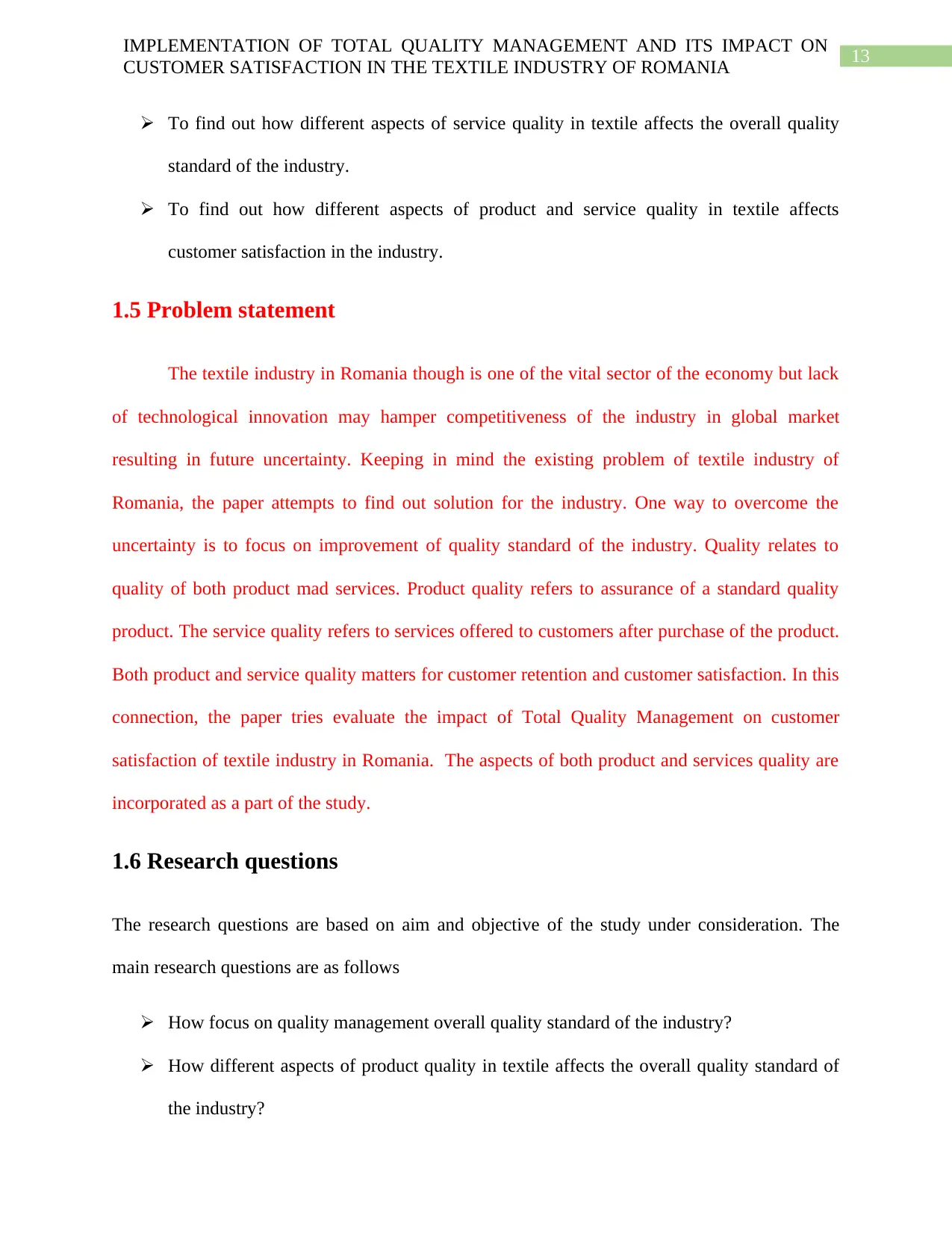
13
IMPLEMENTATION OF TOTAL QUALITY MANAGEMENT AND ITS IMPACT ON
CUSTOMER SATISFACTION IN THE TEXTILE INDUSTRY OF ROMANIA
To find out how different aspects of service quality in textile affects the overall quality
standard of the industry.
To find out how different aspects of product and service quality in textile affects
customer satisfaction in the industry.
1.5 Problem statement
The textile industry in Romania though is one of the vital sector of the economy but lack
of technological innovation may hamper competitiveness of the industry in global market
resulting in future uncertainty. Keeping in mind the existing problem of textile industry of
Romania, the paper attempts to find out solution for the industry. One way to overcome the
uncertainty is to focus on improvement of quality standard of the industry. Quality relates to
quality of both product mad services. Product quality refers to assurance of a standard quality
product. The service quality refers to services offered to customers after purchase of the product.
Both product and service quality matters for customer retention and customer satisfaction. In this
connection, the paper tries evaluate the impact of Total Quality Management on customer
satisfaction of textile industry in Romania. The aspects of both product and services quality are
incorporated as a part of the study.
1.6 Research questions
The research questions are based on aim and objective of the study under consideration. The
main research questions are as follows
How focus on quality management overall quality standard of the industry?
How different aspects of product quality in textile affects the overall quality standard of
the industry?
IMPLEMENTATION OF TOTAL QUALITY MANAGEMENT AND ITS IMPACT ON
CUSTOMER SATISFACTION IN THE TEXTILE INDUSTRY OF ROMANIA
To find out how different aspects of service quality in textile affects the overall quality
standard of the industry.
To find out how different aspects of product and service quality in textile affects
customer satisfaction in the industry.
1.5 Problem statement
The textile industry in Romania though is one of the vital sector of the economy but lack
of technological innovation may hamper competitiveness of the industry in global market
resulting in future uncertainty. Keeping in mind the existing problem of textile industry of
Romania, the paper attempts to find out solution for the industry. One way to overcome the
uncertainty is to focus on improvement of quality standard of the industry. Quality relates to
quality of both product mad services. Product quality refers to assurance of a standard quality
product. The service quality refers to services offered to customers after purchase of the product.
Both product and service quality matters for customer retention and customer satisfaction. In this
connection, the paper tries evaluate the impact of Total Quality Management on customer
satisfaction of textile industry in Romania. The aspects of both product and services quality are
incorporated as a part of the study.
1.6 Research questions
The research questions are based on aim and objective of the study under consideration. The
main research questions are as follows
How focus on quality management overall quality standard of the industry?
How different aspects of product quality in textile affects the overall quality standard of
the industry?
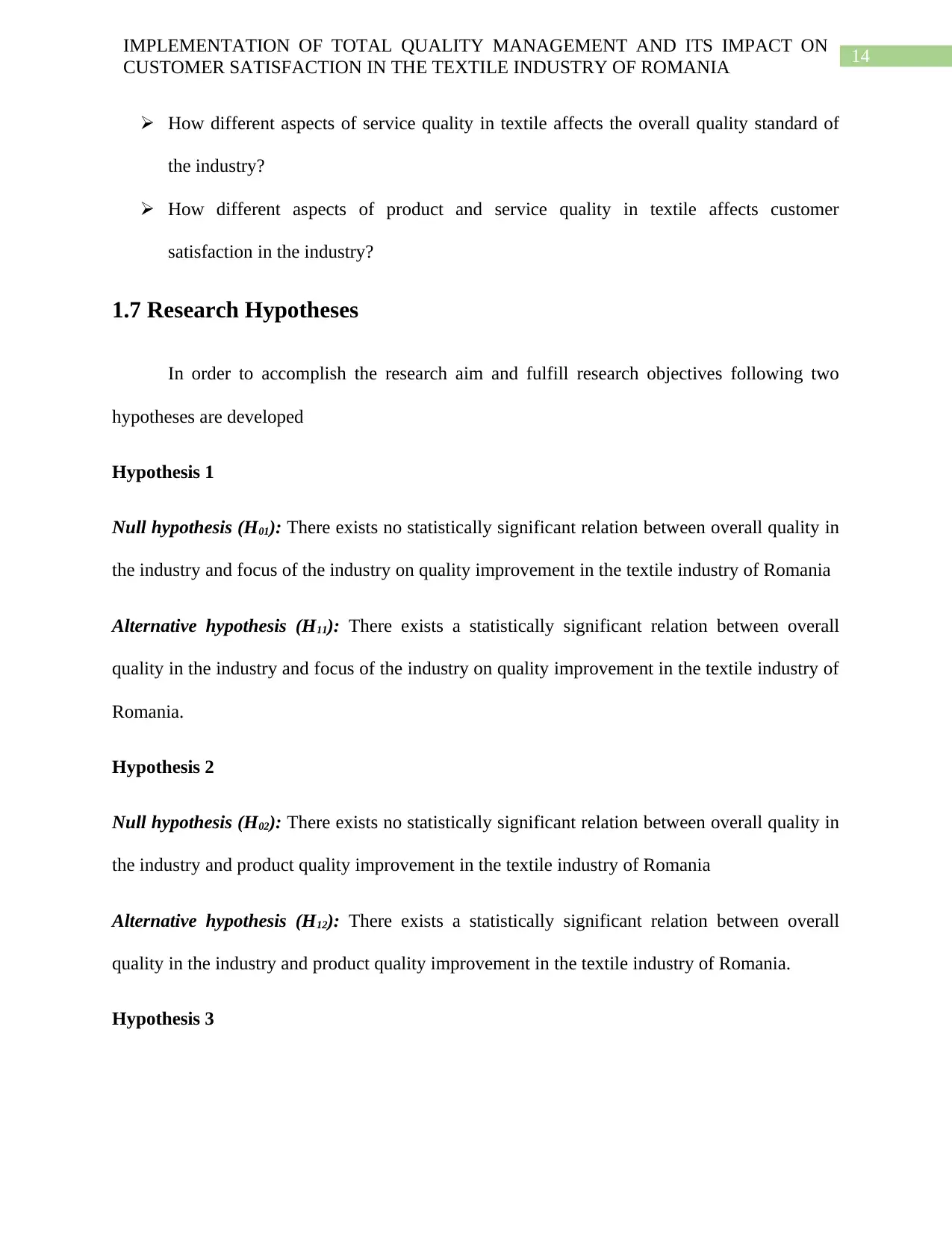
14
IMPLEMENTATION OF TOTAL QUALITY MANAGEMENT AND ITS IMPACT ON
CUSTOMER SATISFACTION IN THE TEXTILE INDUSTRY OF ROMANIA
How different aspects of service quality in textile affects the overall quality standard of
the industry?
How different aspects of product and service quality in textile affects customer
satisfaction in the industry?
1.7 Research Hypotheses
In order to accomplish the research aim and fulfill research objectives following two
hypotheses are developed
Hypothesis 1
Null hypothesis (H01): There exists no statistically significant relation between overall quality in
the industry and focus of the industry on quality improvement in the textile industry of Romania
Alternative hypothesis (H11): There exists a statistically significant relation between overall
quality in the industry and focus of the industry on quality improvement in the textile industry of
Romania.
Hypothesis 2
Null hypothesis (H02): There exists no statistically significant relation between overall quality in
the industry and product quality improvement in the textile industry of Romania
Alternative hypothesis (H12): There exists a statistically significant relation between overall
quality in the industry and product quality improvement in the textile industry of Romania.
Hypothesis 3
IMPLEMENTATION OF TOTAL QUALITY MANAGEMENT AND ITS IMPACT ON
CUSTOMER SATISFACTION IN THE TEXTILE INDUSTRY OF ROMANIA
How different aspects of service quality in textile affects the overall quality standard of
the industry?
How different aspects of product and service quality in textile affects customer
satisfaction in the industry?
1.7 Research Hypotheses
In order to accomplish the research aim and fulfill research objectives following two
hypotheses are developed
Hypothesis 1
Null hypothesis (H01): There exists no statistically significant relation between overall quality in
the industry and focus of the industry on quality improvement in the textile industry of Romania
Alternative hypothesis (H11): There exists a statistically significant relation between overall
quality in the industry and focus of the industry on quality improvement in the textile industry of
Romania.
Hypothesis 2
Null hypothesis (H02): There exists no statistically significant relation between overall quality in
the industry and product quality improvement in the textile industry of Romania
Alternative hypothesis (H12): There exists a statistically significant relation between overall
quality in the industry and product quality improvement in the textile industry of Romania.
Hypothesis 3
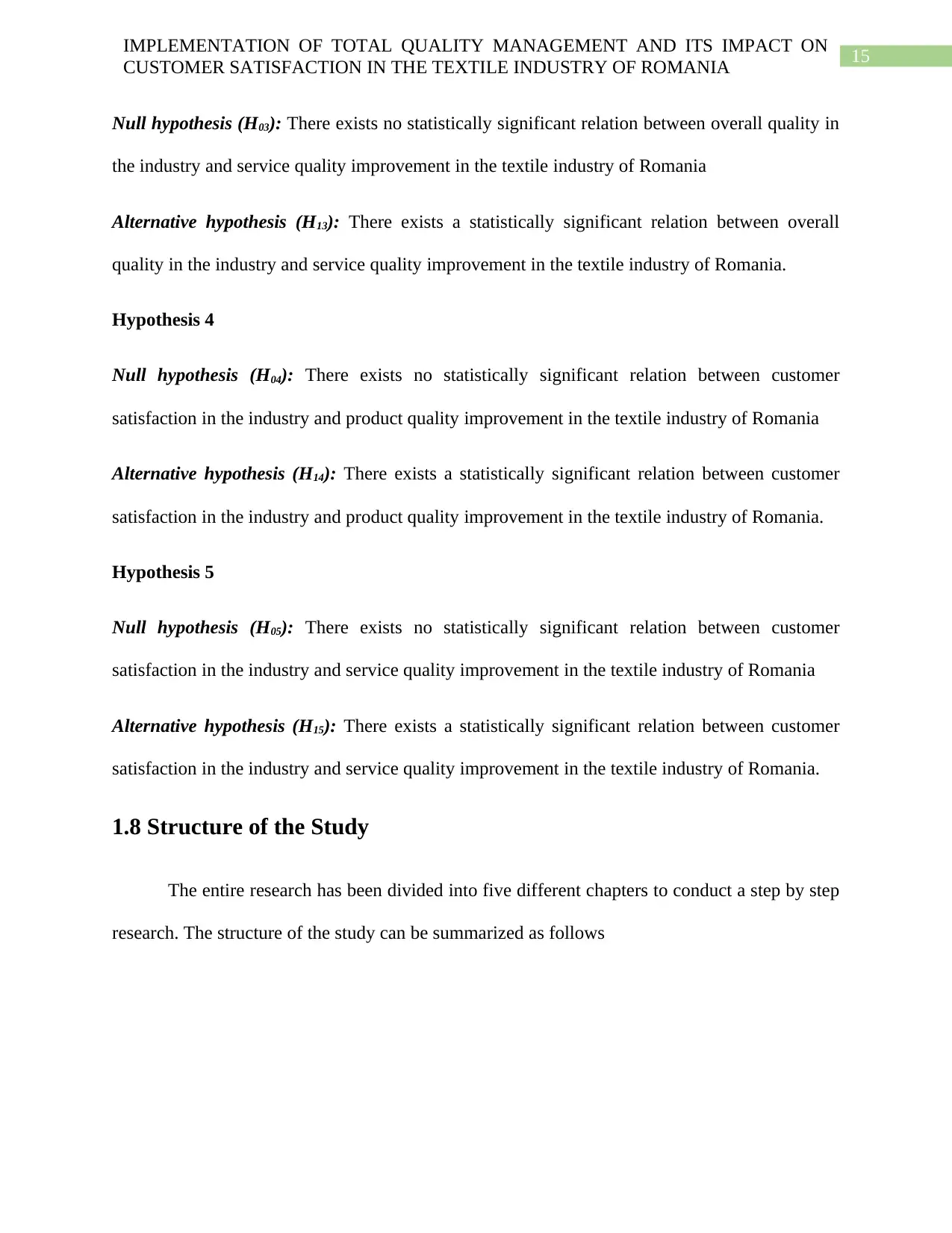
15
IMPLEMENTATION OF TOTAL QUALITY MANAGEMENT AND ITS IMPACT ON
CUSTOMER SATISFACTION IN THE TEXTILE INDUSTRY OF ROMANIA
Null hypothesis (H03): There exists no statistically significant relation between overall quality in
the industry and service quality improvement in the textile industry of Romania
Alternative hypothesis (H13): There exists a statistically significant relation between overall
quality in the industry and service quality improvement in the textile industry of Romania.
Hypothesis 4
Null hypothesis (H04): There exists no statistically significant relation between customer
satisfaction in the industry and product quality improvement in the textile industry of Romania
Alternative hypothesis (H14): There exists a statistically significant relation between customer
satisfaction in the industry and product quality improvement in the textile industry of Romania.
Hypothesis 5
Null hypothesis (H05): There exists no statistically significant relation between customer
satisfaction in the industry and service quality improvement in the textile industry of Romania
Alternative hypothesis (H15): There exists a statistically significant relation between customer
satisfaction in the industry and service quality improvement in the textile industry of Romania.
1.8 Structure of the Study
The entire research has been divided into five different chapters to conduct a step by step
research. The structure of the study can be summarized as follows
IMPLEMENTATION OF TOTAL QUALITY MANAGEMENT AND ITS IMPACT ON
CUSTOMER SATISFACTION IN THE TEXTILE INDUSTRY OF ROMANIA
Null hypothesis (H03): There exists no statistically significant relation between overall quality in
the industry and service quality improvement in the textile industry of Romania
Alternative hypothesis (H13): There exists a statistically significant relation between overall
quality in the industry and service quality improvement in the textile industry of Romania.
Hypothesis 4
Null hypothesis (H04): There exists no statistically significant relation between customer
satisfaction in the industry and product quality improvement in the textile industry of Romania
Alternative hypothesis (H14): There exists a statistically significant relation between customer
satisfaction in the industry and product quality improvement in the textile industry of Romania.
Hypothesis 5
Null hypothesis (H05): There exists no statistically significant relation between customer
satisfaction in the industry and service quality improvement in the textile industry of Romania
Alternative hypothesis (H15): There exists a statistically significant relation between customer
satisfaction in the industry and service quality improvement in the textile industry of Romania.
1.8 Structure of the Study
The entire research has been divided into five different chapters to conduct a step by step
research. The structure of the study can be summarized as follows
Secure Best Marks with AI Grader
Need help grading? Try our AI Grader for instant feedback on your assignments.
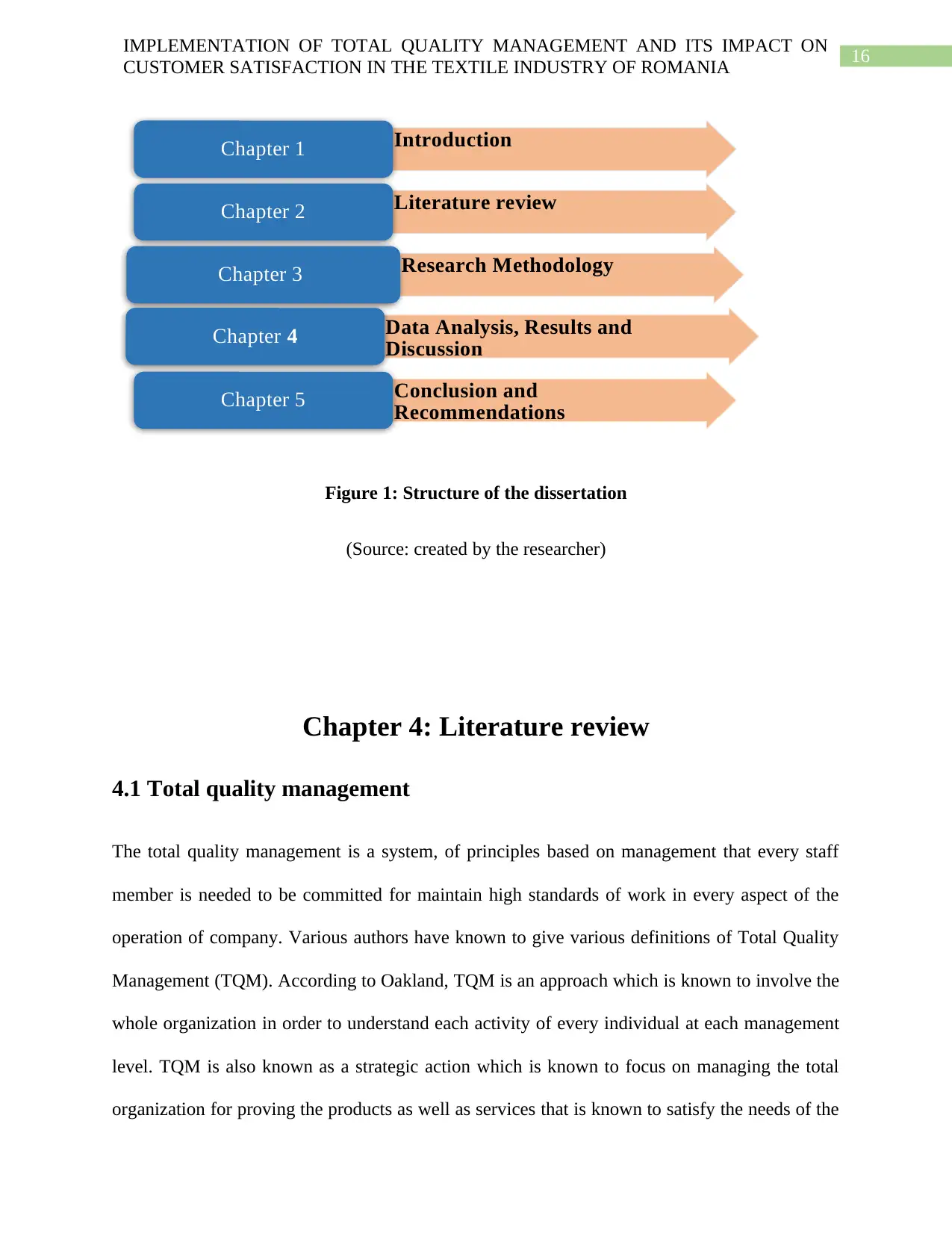
16
IMPLEMENTATION OF TOTAL QUALITY MANAGEMENT AND ITS IMPACT ON
CUSTOMER SATISFACTION IN THE TEXTILE INDUSTRY OF ROMANIA
Figure 1: Structure of the dissertation
(Source: created by the researcher)
Chapter 4: Literature review
4.1 Total quality management
The total quality management is a system, of principles based on management that every staff
member is needed to be committed for maintain high standards of work in every aspect of the
operation of company. Various authors have known to give various definitions of Total Quality
Management (TQM). According to Oakland, TQM is an approach which is known to involve the
whole organization in order to understand each activity of every individual at each management
level. TQM is also known as a strategic action which is known to focus on managing the total
organization for proving the products as well as services that is known to satisfy the needs of the
IntroductionChapter 1
Literature reviewChapter 2
Research MethodologyChapter 3
Data Analysis, Results and
Discussion
Chapter 4
Conclusion and
Recommendations
Chapter 5
IMPLEMENTATION OF TOTAL QUALITY MANAGEMENT AND ITS IMPACT ON
CUSTOMER SATISFACTION IN THE TEXTILE INDUSTRY OF ROMANIA
Figure 1: Structure of the dissertation
(Source: created by the researcher)
Chapter 4: Literature review
4.1 Total quality management
The total quality management is a system, of principles based on management that every staff
member is needed to be committed for maintain high standards of work in every aspect of the
operation of company. Various authors have known to give various definitions of Total Quality
Management (TQM). According to Oakland, TQM is an approach which is known to involve the
whole organization in order to understand each activity of every individual at each management
level. TQM is also known as a strategic action which is known to focus on managing the total
organization for proving the products as well as services that is known to satisfy the needs of the
IntroductionChapter 1
Literature reviewChapter 2
Research MethodologyChapter 3
Data Analysis, Results and
Discussion
Chapter 4
Conclusion and
Recommendations
Chapter 5

17
IMPLEMENTATION OF TOTAL QUALITY MANAGEMENT AND ITS IMPACT ON
CUSTOMER SATISFACTION IN THE TEXTILE INDUSTRY OF ROMANIA
customers by utilizing all resources (Dubey, Gunasekaran and Ali 2015). For understanding the
concept of Total Quality Management, it is very important to known to the concept of quality.
Quality is known to encompass every aspect of the firm as it is related to the emotional
experience of the customer. Customers also makes sure that their money is well spent and are
also encouraged to be associated with the industry projects. Quality is also a performance of the
standard expected by the customers. The increasing number of complexities in today’s
organizations requires a definitive management approach which will make sure that is presence
of complete efficiency as well as productivity. This particular approach is known as the Total
Quality Management (TQM). The total quality management is usually recognized as an
innovative system of principles, practices as well as tools which are needed for managing a firm
in order to provide customer satisfaction in the rapidly changing economy.
According to () TQM is an integrated organizational effort which have been designed for
improving the quality at every level. Some of the authors also states TQM as a management
philosophy which is known to seek to integrate all the functions of organization in order to focus
on meeting the needs of the customers and organizational objectives. TQM also views an
organization as a collection of processes. It is known to maintain that organization should strive
continuously for improving the process by incorporating the knowledge as well as experience of
the workers. It should be always kept in mind that quality had been always a very important
issue for both the people as well as for the companies. The quality of experience is a measure of
the experience of the customer with a service. It is known to focus on the entire service
experience and is also more holistic evaluation than the more narrowly focused user experience.
Some of the most successful organizations have found that the fundamental principles of total
IMPLEMENTATION OF TOTAL QUALITY MANAGEMENT AND ITS IMPACT ON
CUSTOMER SATISFACTION IN THE TEXTILE INDUSTRY OF ROMANIA
customers by utilizing all resources (Dubey, Gunasekaran and Ali 2015). For understanding the
concept of Total Quality Management, it is very important to known to the concept of quality.
Quality is known to encompass every aspect of the firm as it is related to the emotional
experience of the customer. Customers also makes sure that their money is well spent and are
also encouraged to be associated with the industry projects. Quality is also a performance of the
standard expected by the customers. The increasing number of complexities in today’s
organizations requires a definitive management approach which will make sure that is presence
of complete efficiency as well as productivity. This particular approach is known as the Total
Quality Management (TQM). The total quality management is usually recognized as an
innovative system of principles, practices as well as tools which are needed for managing a firm
in order to provide customer satisfaction in the rapidly changing economy.
According to () TQM is an integrated organizational effort which have been designed for
improving the quality at every level. Some of the authors also states TQM as a management
philosophy which is known to seek to integrate all the functions of organization in order to focus
on meeting the needs of the customers and organizational objectives. TQM also views an
organization as a collection of processes. It is known to maintain that organization should strive
continuously for improving the process by incorporating the knowledge as well as experience of
the workers. It should be always kept in mind that quality had been always a very important
issue for both the people as well as for the companies. The quality of experience is a measure of
the experience of the customer with a service. It is known to focus on the entire service
experience and is also more holistic evaluation than the more narrowly focused user experience.
Some of the most successful organizations have found that the fundamental principles of total

18
IMPLEMENTATION OF TOTAL QUALITY MANAGEMENT AND ITS IMPACT ON
CUSTOMER SATISFACTION IN THE TEXTILE INDUSTRY OF ROMANIA
quality are very essential to an effective management practice and the continue to represent a
sound approach for achieving the success of the business.
One of the real challenges in the present world is that to make sure that the managers do not lose
sight of the basic principles on which the quality management and the performance excellence
are known to be based on. Total Quality Management (TQM) is known as the world leading
management method of business. The companies are known to employ this in order to improve
their productivity and the quality of the service with the hope of improving typical measures of
the business performance (Ngambi and Nkemkiafu 2015). The excellent quality is usually
maintained by some of the producers as one of the most important determinants of
manufacturing, buyers as well as service strategy. The TQM can also be stated as the
management philosophy with a vision aiming towards building a corporate culture which are
known to be characterized by an increased level of customer satisfaction through continuous
improvement where all the employees are known to participate actively.
4.2 Total Quality Management and customer satisfaction
The total quality management is known to mainly focus on the requirement of the consumers.
Customer satisfaction is known to lead to a positive result for the organization such as retention,
improved financial performance as well as positive word of mouth. According to ( Yeng, Jusoh
and Ishak 2018) in case of a total setting of a quality, the quality is mainly defined by the
customer. The organization should be keeping in mind that the customers should be the top
priority of the organization and the satisfaction of the customer is always ensured by producing
high quality products. The term customer satisfaction is very frequently used in marketing. It is a
measure of how the products and the services should be supplied by the company that meets or
IMPLEMENTATION OF TOTAL QUALITY MANAGEMENT AND ITS IMPACT ON
CUSTOMER SATISFACTION IN THE TEXTILE INDUSTRY OF ROMANIA
quality are very essential to an effective management practice and the continue to represent a
sound approach for achieving the success of the business.
One of the real challenges in the present world is that to make sure that the managers do not lose
sight of the basic principles on which the quality management and the performance excellence
are known to be based on. Total Quality Management (TQM) is known as the world leading
management method of business. The companies are known to employ this in order to improve
their productivity and the quality of the service with the hope of improving typical measures of
the business performance (Ngambi and Nkemkiafu 2015). The excellent quality is usually
maintained by some of the producers as one of the most important determinants of
manufacturing, buyers as well as service strategy. The TQM can also be stated as the
management philosophy with a vision aiming towards building a corporate culture which are
known to be characterized by an increased level of customer satisfaction through continuous
improvement where all the employees are known to participate actively.
4.2 Total Quality Management and customer satisfaction
The total quality management is known to mainly focus on the requirement of the consumers.
Customer satisfaction is known to lead to a positive result for the organization such as retention,
improved financial performance as well as positive word of mouth. According to ( Yeng, Jusoh
and Ishak 2018) in case of a total setting of a quality, the quality is mainly defined by the
customer. The organization should be keeping in mind that the customers should be the top
priority of the organization and the satisfaction of the customer is always ensured by producing
high quality products. The term customer satisfaction is very frequently used in marketing. It is a
measure of how the products and the services should be supplied by the company that meets or
Paraphrase This Document
Need a fresh take? Get an instant paraphrase of this document with our AI Paraphraser
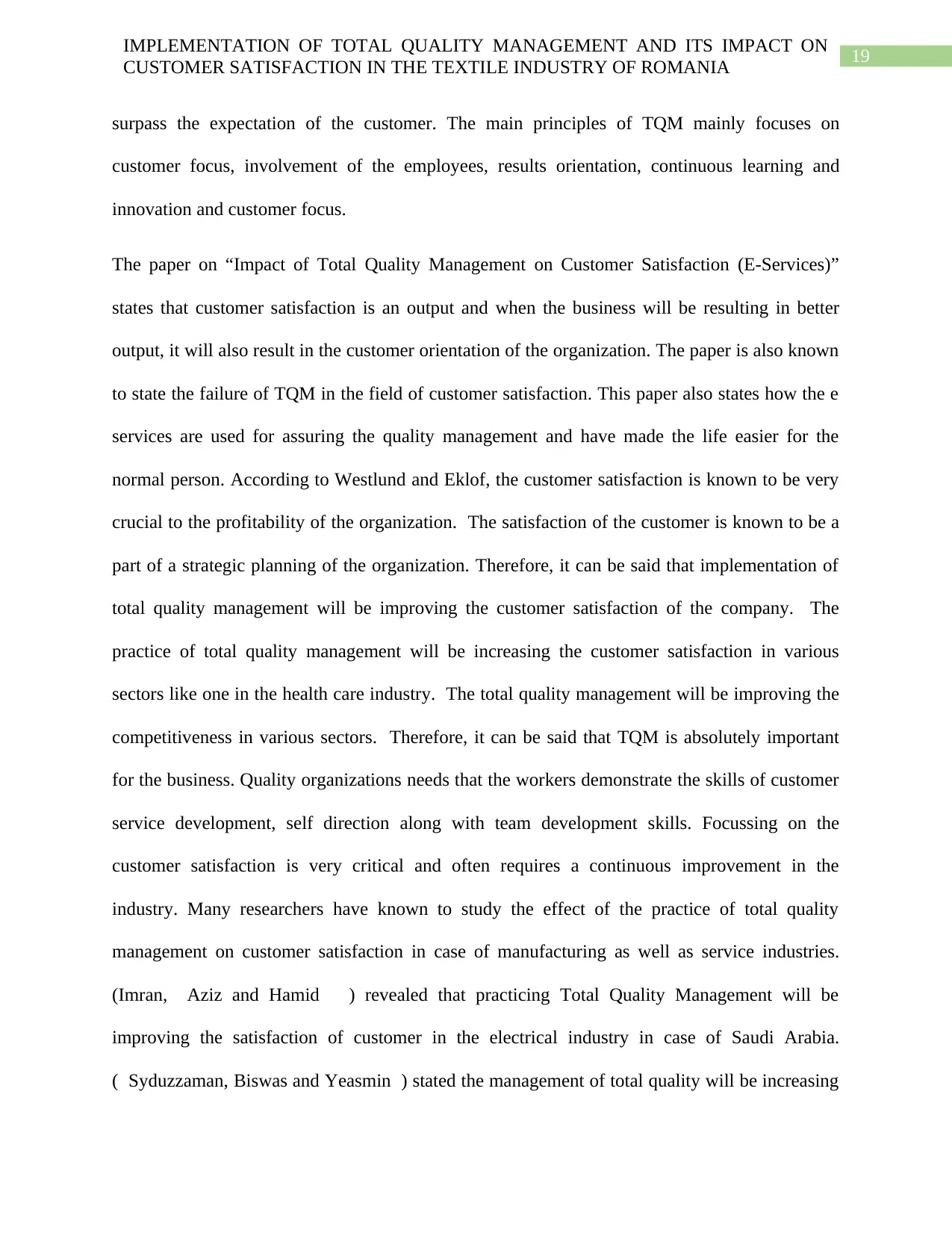
19
IMPLEMENTATION OF TOTAL QUALITY MANAGEMENT AND ITS IMPACT ON
CUSTOMER SATISFACTION IN THE TEXTILE INDUSTRY OF ROMANIA
surpass the expectation of the customer. The main principles of TQM mainly focuses on
customer focus, involvement of the employees, results orientation, continuous learning and
innovation and customer focus.
The paper on “Impact of Total Quality Management on Customer Satisfaction (E-Services)”
states that customer satisfaction is an output and when the business will be resulting in better
output, it will also result in the customer orientation of the organization. The paper is also known
to state the failure of TQM in the field of customer satisfaction. This paper also states how the e
services are used for assuring the quality management and have made the life easier for the
normal person. According to Westlund and Eklof, the customer satisfaction is known to be very
crucial to the profitability of the organization. The satisfaction of the customer is known to be a
part of a strategic planning of the organization. Therefore, it can be said that implementation of
total quality management will be improving the customer satisfaction of the company. The
practice of total quality management will be increasing the customer satisfaction in various
sectors like one in the health care industry. The total quality management will be improving the
competitiveness in various sectors. Therefore, it can be said that TQM is absolutely important
for the business. Quality organizations needs that the workers demonstrate the skills of customer
service development, self direction along with team development skills. Focussing on the
customer satisfaction is very critical and often requires a continuous improvement in the
industry. Many researchers have known to study the effect of the practice of total quality
management on customer satisfaction in case of manufacturing as well as service industries.
(Imran, Aziz and Hamid ) revealed that practicing Total Quality Management will be
improving the satisfaction of customer in the electrical industry in case of Saudi Arabia.
( Syduzzaman, Biswas and Yeasmin ) stated the management of total quality will be increasing
IMPLEMENTATION OF TOTAL QUALITY MANAGEMENT AND ITS IMPACT ON
CUSTOMER SATISFACTION IN THE TEXTILE INDUSTRY OF ROMANIA
surpass the expectation of the customer. The main principles of TQM mainly focuses on
customer focus, involvement of the employees, results orientation, continuous learning and
innovation and customer focus.
The paper on “Impact of Total Quality Management on Customer Satisfaction (E-Services)”
states that customer satisfaction is an output and when the business will be resulting in better
output, it will also result in the customer orientation of the organization. The paper is also known
to state the failure of TQM in the field of customer satisfaction. This paper also states how the e
services are used for assuring the quality management and have made the life easier for the
normal person. According to Westlund and Eklof, the customer satisfaction is known to be very
crucial to the profitability of the organization. The satisfaction of the customer is known to be a
part of a strategic planning of the organization. Therefore, it can be said that implementation of
total quality management will be improving the customer satisfaction of the company. The
practice of total quality management will be increasing the customer satisfaction in various
sectors like one in the health care industry. The total quality management will be improving the
competitiveness in various sectors. Therefore, it can be said that TQM is absolutely important
for the business. Quality organizations needs that the workers demonstrate the skills of customer
service development, self direction along with team development skills. Focussing on the
customer satisfaction is very critical and often requires a continuous improvement in the
industry. Many researchers have known to study the effect of the practice of total quality
management on customer satisfaction in case of manufacturing as well as service industries.
(Imran, Aziz and Hamid ) revealed that practicing Total Quality Management will be
improving the satisfaction of customer in the electrical industry in case of Saudi Arabia.
( Syduzzaman, Biswas and Yeasmin ) stated the management of total quality will be increasing
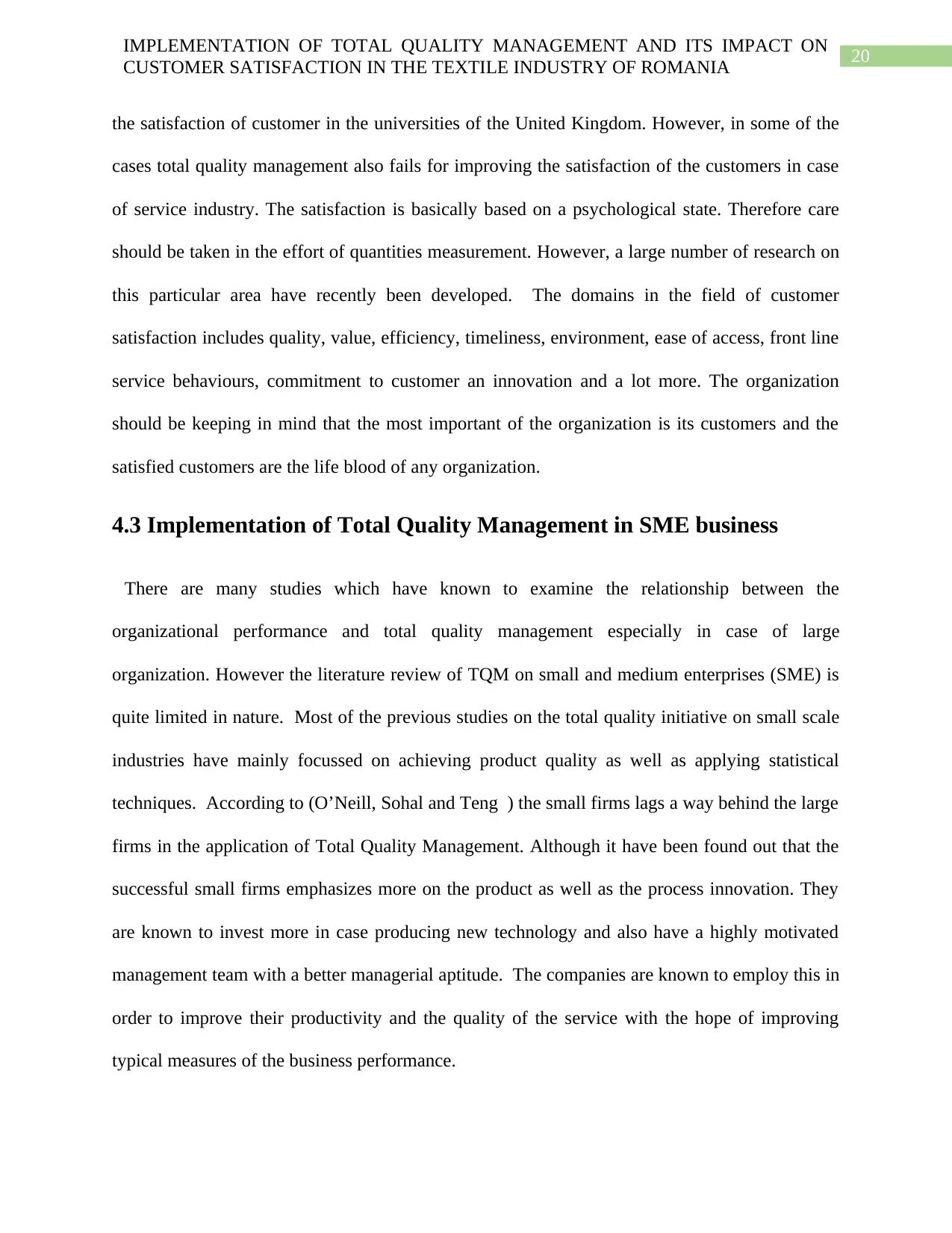
20
IMPLEMENTATION OF TOTAL QUALITY MANAGEMENT AND ITS IMPACT ON
CUSTOMER SATISFACTION IN THE TEXTILE INDUSTRY OF ROMANIA
the satisfaction of customer in the universities of the United Kingdom. However, in some of the
cases total quality management also fails for improving the satisfaction of the customers in case
of service industry. The satisfaction is basically based on a psychological state. Therefore care
should be taken in the effort of quantities measurement. However, a large number of research on
this particular area have recently been developed. The domains in the field of customer
satisfaction includes quality, value, efficiency, timeliness, environment, ease of access, front line
service behaviours, commitment to customer an innovation and a lot more. The organization
should be keeping in mind that the most important of the organization is its customers and the
satisfied customers are the life blood of any organization.
4.3 Implementation of Total Quality Management in SME business
There are many studies which have known to examine the relationship between the
organizational performance and total quality management especially in case of large
organization. However the literature review of TQM on small and medium enterprises (SME) is
quite limited in nature. Most of the previous studies on the total quality initiative on small scale
industries have mainly focussed on achieving product quality as well as applying statistical
techniques. According to (O’Neill, Sohal and Teng ) the small firms lags a way behind the large
firms in the application of Total Quality Management. Although it have been found out that the
successful small firms emphasizes more on the product as well as the process innovation. They
are known to invest more in case producing new technology and also have a highly motivated
management team with a better managerial aptitude. The companies are known to employ this in
order to improve their productivity and the quality of the service with the hope of improving
typical measures of the business performance.
IMPLEMENTATION OF TOTAL QUALITY MANAGEMENT AND ITS IMPACT ON
CUSTOMER SATISFACTION IN THE TEXTILE INDUSTRY OF ROMANIA
the satisfaction of customer in the universities of the United Kingdom. However, in some of the
cases total quality management also fails for improving the satisfaction of the customers in case
of service industry. The satisfaction is basically based on a psychological state. Therefore care
should be taken in the effort of quantities measurement. However, a large number of research on
this particular area have recently been developed. The domains in the field of customer
satisfaction includes quality, value, efficiency, timeliness, environment, ease of access, front line
service behaviours, commitment to customer an innovation and a lot more. The organization
should be keeping in mind that the most important of the organization is its customers and the
satisfied customers are the life blood of any organization.
4.3 Implementation of Total Quality Management in SME business
There are many studies which have known to examine the relationship between the
organizational performance and total quality management especially in case of large
organization. However the literature review of TQM on small and medium enterprises (SME) is
quite limited in nature. Most of the previous studies on the total quality initiative on small scale
industries have mainly focussed on achieving product quality as well as applying statistical
techniques. According to (O’Neill, Sohal and Teng ) the small firms lags a way behind the large
firms in the application of Total Quality Management. Although it have been found out that the
successful small firms emphasizes more on the product as well as the process innovation. They
are known to invest more in case producing new technology and also have a highly motivated
management team with a better managerial aptitude. The companies are known to employ this in
order to improve their productivity and the quality of the service with the hope of improving
typical measures of the business performance.
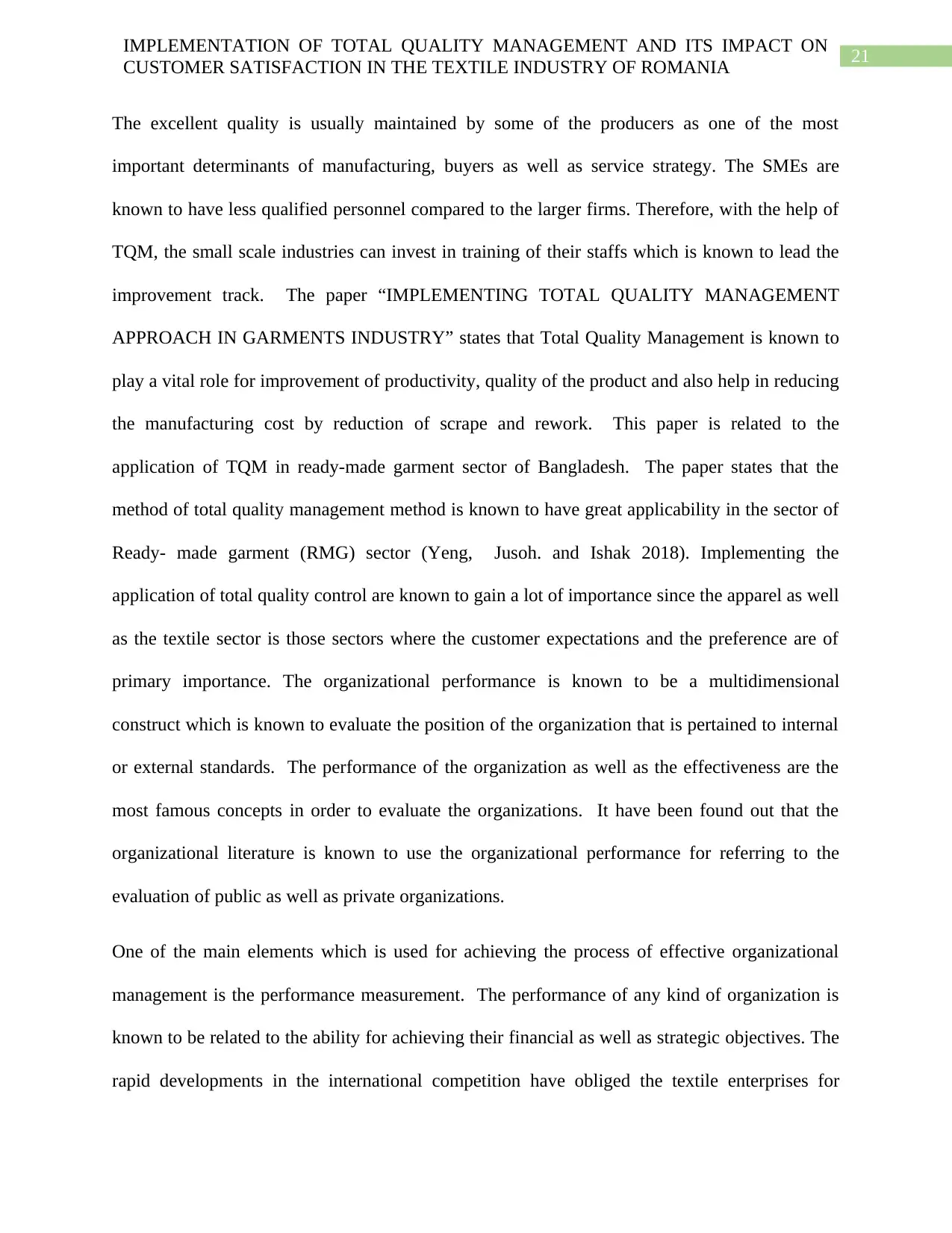
21
IMPLEMENTATION OF TOTAL QUALITY MANAGEMENT AND ITS IMPACT ON
CUSTOMER SATISFACTION IN THE TEXTILE INDUSTRY OF ROMANIA
The excellent quality is usually maintained by some of the producers as one of the most
important determinants of manufacturing, buyers as well as service strategy. The SMEs are
known to have less qualified personnel compared to the larger firms. Therefore, with the help of
TQM, the small scale industries can invest in training of their staffs which is known to lead the
improvement track. The paper “IMPLEMENTING TOTAL QUALITY MANAGEMENT
APPROACH IN GARMENTS INDUSTRY” states that Total Quality Management is known to
play a vital role for improvement of productivity, quality of the product and also help in reducing
the manufacturing cost by reduction of scrape and rework. This paper is related to the
application of TQM in ready-made garment sector of Bangladesh. The paper states that the
method of total quality management method is known to have great applicability in the sector of
Ready- made garment (RMG) sector (Yeng, Jusoh. and Ishak 2018). Implementing the
application of total quality control are known to gain a lot of importance since the apparel as well
as the textile sector is those sectors where the customer expectations and the preference are of
primary importance. The organizational performance is known to be a multidimensional
construct which is known to evaluate the position of the organization that is pertained to internal
or external standards. The performance of the organization as well as the effectiveness are the
most famous concepts in order to evaluate the organizations. It have been found out that the
organizational literature is known to use the organizational performance for referring to the
evaluation of public as well as private organizations.
One of the main elements which is used for achieving the process of effective organizational
management is the performance measurement. The performance of any kind of organization is
known to be related to the ability for achieving their financial as well as strategic objectives. The
rapid developments in the international competition have obliged the textile enterprises for
IMPLEMENTATION OF TOTAL QUALITY MANAGEMENT AND ITS IMPACT ON
CUSTOMER SATISFACTION IN THE TEXTILE INDUSTRY OF ROMANIA
The excellent quality is usually maintained by some of the producers as one of the most
important determinants of manufacturing, buyers as well as service strategy. The SMEs are
known to have less qualified personnel compared to the larger firms. Therefore, with the help of
TQM, the small scale industries can invest in training of their staffs which is known to lead the
improvement track. The paper “IMPLEMENTING TOTAL QUALITY MANAGEMENT
APPROACH IN GARMENTS INDUSTRY” states that Total Quality Management is known to
play a vital role for improvement of productivity, quality of the product and also help in reducing
the manufacturing cost by reduction of scrape and rework. This paper is related to the
application of TQM in ready-made garment sector of Bangladesh. The paper states that the
method of total quality management method is known to have great applicability in the sector of
Ready- made garment (RMG) sector (Yeng, Jusoh. and Ishak 2018). Implementing the
application of total quality control are known to gain a lot of importance since the apparel as well
as the textile sector is those sectors where the customer expectations and the preference are of
primary importance. The organizational performance is known to be a multidimensional
construct which is known to evaluate the position of the organization that is pertained to internal
or external standards. The performance of the organization as well as the effectiveness are the
most famous concepts in order to evaluate the organizations. It have been found out that the
organizational literature is known to use the organizational performance for referring to the
evaluation of public as well as private organizations.
One of the main elements which is used for achieving the process of effective organizational
management is the performance measurement. The performance of any kind of organization is
known to be related to the ability for achieving their financial as well as strategic objectives. The
rapid developments in the international competition have obliged the textile enterprises for
Secure Best Marks with AI Grader
Need help grading? Try our AI Grader for instant feedback on your assignments.
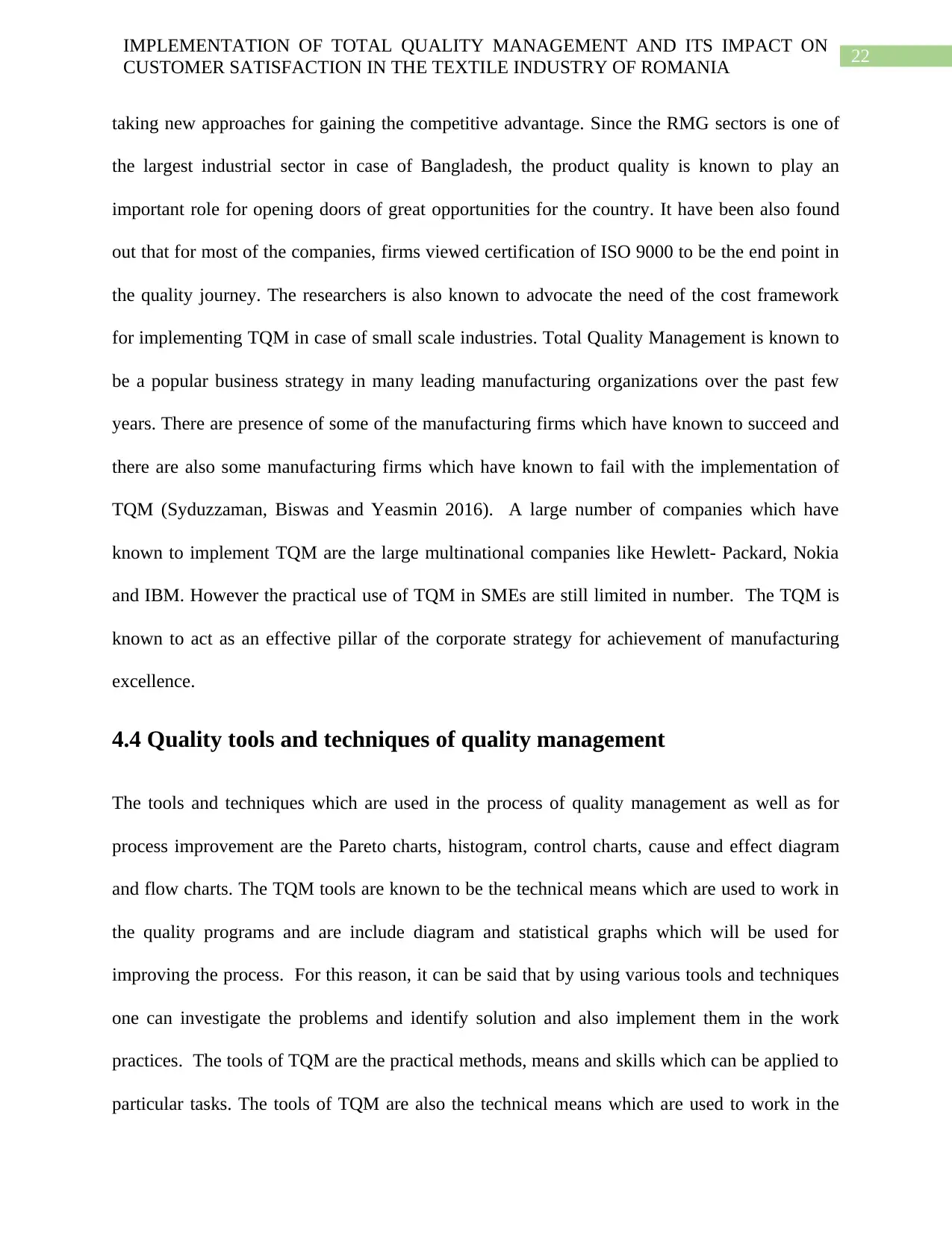
22
IMPLEMENTATION OF TOTAL QUALITY MANAGEMENT AND ITS IMPACT ON
CUSTOMER SATISFACTION IN THE TEXTILE INDUSTRY OF ROMANIA
taking new approaches for gaining the competitive advantage. Since the RMG sectors is one of
the largest industrial sector in case of Bangladesh, the product quality is known to play an
important role for opening doors of great opportunities for the country. It have been also found
out that for most of the companies, firms viewed certification of ISO 9000 to be the end point in
the quality journey. The researchers is also known to advocate the need of the cost framework
for implementing TQM in case of small scale industries. Total Quality Management is known to
be a popular business strategy in many leading manufacturing organizations over the past few
years. There are presence of some of the manufacturing firms which have known to succeed and
there are also some manufacturing firms which have known to fail with the implementation of
TQM (Syduzzaman, Biswas and Yeasmin 2016). A large number of companies which have
known to implement TQM are the large multinational companies like Hewlett- Packard, Nokia
and IBM. However the practical use of TQM in SMEs are still limited in number. The TQM is
known to act as an effective pillar of the corporate strategy for achievement of manufacturing
excellence.
4.4 Quality tools and techniques of quality management
The tools and techniques which are used in the process of quality management as well as for
process improvement are the Pareto charts, histogram, control charts, cause and effect diagram
and flow charts. The TQM tools are known to be the technical means which are used to work in
the quality programs and are include diagram and statistical graphs which will be used for
improving the process. For this reason, it can be said that by using various tools and techniques
one can investigate the problems and identify solution and also implement them in the work
practices. The tools of TQM are the practical methods, means and skills which can be applied to
particular tasks. The tools of TQM are also the technical means which are used to work in the
IMPLEMENTATION OF TOTAL QUALITY MANAGEMENT AND ITS IMPACT ON
CUSTOMER SATISFACTION IN THE TEXTILE INDUSTRY OF ROMANIA
taking new approaches for gaining the competitive advantage. Since the RMG sectors is one of
the largest industrial sector in case of Bangladesh, the product quality is known to play an
important role for opening doors of great opportunities for the country. It have been also found
out that for most of the companies, firms viewed certification of ISO 9000 to be the end point in
the quality journey. The researchers is also known to advocate the need of the cost framework
for implementing TQM in case of small scale industries. Total Quality Management is known to
be a popular business strategy in many leading manufacturing organizations over the past few
years. There are presence of some of the manufacturing firms which have known to succeed and
there are also some manufacturing firms which have known to fail with the implementation of
TQM (Syduzzaman, Biswas and Yeasmin 2016). A large number of companies which have
known to implement TQM are the large multinational companies like Hewlett- Packard, Nokia
and IBM. However the practical use of TQM in SMEs are still limited in number. The TQM is
known to act as an effective pillar of the corporate strategy for achievement of manufacturing
excellence.
4.4 Quality tools and techniques of quality management
The tools and techniques which are used in the process of quality management as well as for
process improvement are the Pareto charts, histogram, control charts, cause and effect diagram
and flow charts. The TQM tools are known to be the technical means which are used to work in
the quality programs and are include diagram and statistical graphs which will be used for
improving the process. For this reason, it can be said that by using various tools and techniques
one can investigate the problems and identify solution and also implement them in the work
practices. The tools of TQM are the practical methods, means and skills which can be applied to
particular tasks. The tools of TQM are also the technical means which are used to work in the

23
IMPLEMENTATION OF TOTAL QUALITY MANAGEMENT AND ITS IMPACT ON
CUSTOMER SATISFACTION IN THE TEXTILE INDUSTRY OF ROMANIA
quality programs and are known to include diagrams along with statistical graphs. The single
tools are known to be the device which have the clear function and is usually applied on its own.
On the other hand, a technique is known to have a wider application and is also understood as a
set of tools. The seven tools of Total quality management have been identified by Ishikawa as
well as McConnell. The usage of tools as well as techniques is one of the vital components of
any kind of successful improvement process. For this reason, it can be said that the usage of
tools and techniques for the management of quality is quite necessary for quality improvement.
These seven tools and techniques can only be beneficial for the manufacturing industry after the
employees are properly trained in nature so that the employees are beneficial. The performance
of any kind of organization is known to be related to the ability for achieving their financial as
well as strategic objectives (O’Neill, Sohal and Teng 2016). The organizational performance
had been largely reflected in the previous researches. The measurement of performance is known
to be considered as an important element at all the managerial approaches. Gharakhani is also
known to indicate that Total Quality Management greatly influence the organizational
performance especially in their finance performance.
There are many researchers who while developing their frameworks known to have considered
total quality management (TQM) s one of the main element in order to achieve excellence in
manufacturing. In the current phase of global competition, a company needs to apply new
techniques in the form of strategic management, quality assurance as well as quality control
(ARUNACHALAM, Zwet and Snailum 2018). TQMs philosophies are known to increase the
firm’s commitment towards quality. Once the TQM is applied correctly, it helps in enhancing the
competitiveness of the position of the firm in the market since TQM will help the firm in
reduction off cost, increasing productivity and improving quality and product.
IMPLEMENTATION OF TOTAL QUALITY MANAGEMENT AND ITS IMPACT ON
CUSTOMER SATISFACTION IN THE TEXTILE INDUSTRY OF ROMANIA
quality programs and are known to include diagrams along with statistical graphs. The single
tools are known to be the device which have the clear function and is usually applied on its own.
On the other hand, a technique is known to have a wider application and is also understood as a
set of tools. The seven tools of Total quality management have been identified by Ishikawa as
well as McConnell. The usage of tools as well as techniques is one of the vital components of
any kind of successful improvement process. For this reason, it can be said that the usage of
tools and techniques for the management of quality is quite necessary for quality improvement.
These seven tools and techniques can only be beneficial for the manufacturing industry after the
employees are properly trained in nature so that the employees are beneficial. The performance
of any kind of organization is known to be related to the ability for achieving their financial as
well as strategic objectives (O’Neill, Sohal and Teng 2016). The organizational performance
had been largely reflected in the previous researches. The measurement of performance is known
to be considered as an important element at all the managerial approaches. Gharakhani is also
known to indicate that Total Quality Management greatly influence the organizational
performance especially in their finance performance.
There are many researchers who while developing their frameworks known to have considered
total quality management (TQM) s one of the main element in order to achieve excellence in
manufacturing. In the current phase of global competition, a company needs to apply new
techniques in the form of strategic management, quality assurance as well as quality control
(ARUNACHALAM, Zwet and Snailum 2018). TQMs philosophies are known to increase the
firm’s commitment towards quality. Once the TQM is applied correctly, it helps in enhancing the
competitiveness of the position of the firm in the market since TQM will help the firm in
reduction off cost, increasing productivity and improving quality and product.
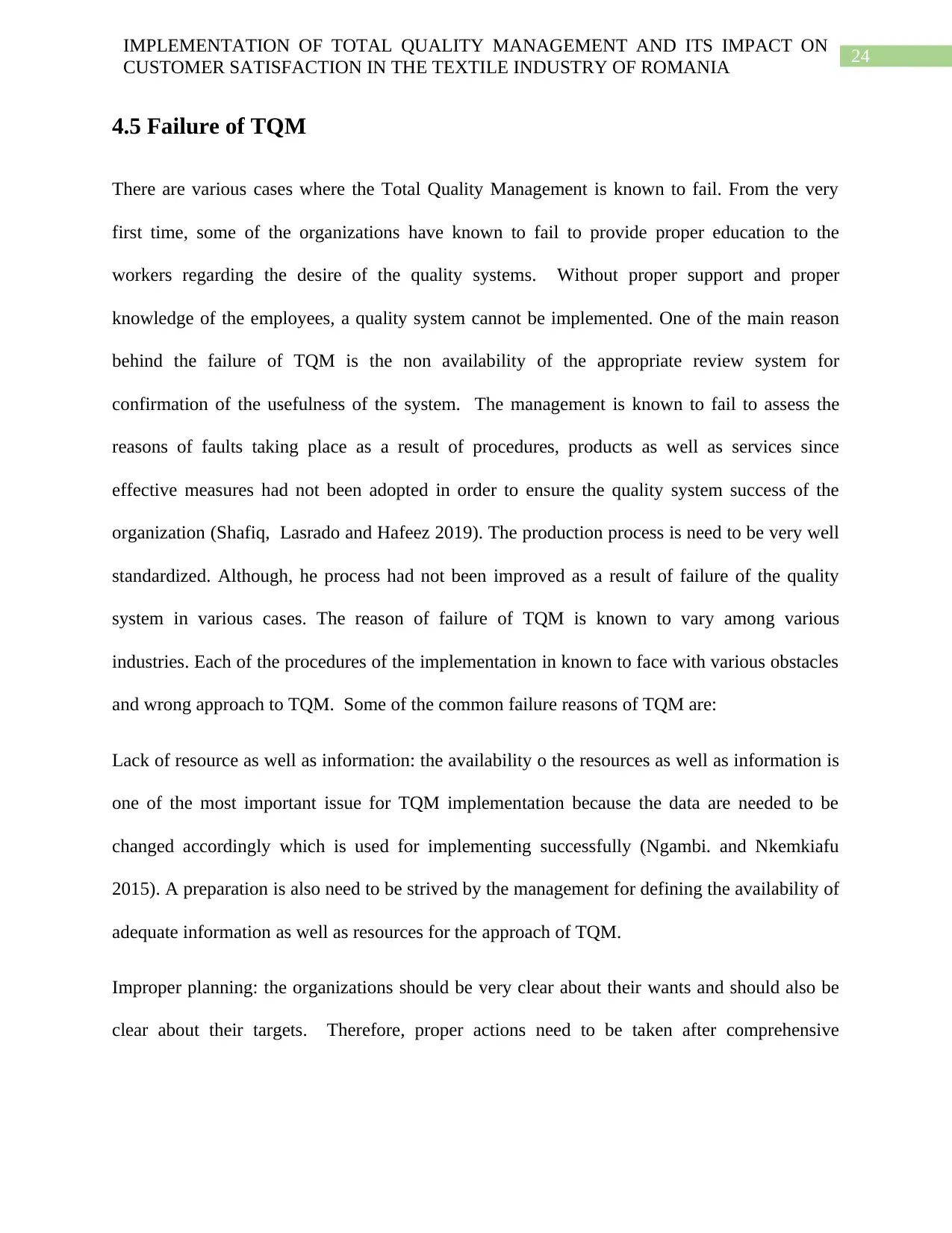
24
IMPLEMENTATION OF TOTAL QUALITY MANAGEMENT AND ITS IMPACT ON
CUSTOMER SATISFACTION IN THE TEXTILE INDUSTRY OF ROMANIA
4.5 Failure of TQM
There are various cases where the Total Quality Management is known to fail. From the very
first time, some of the organizations have known to fail to provide proper education to the
workers regarding the desire of the quality systems. Without proper support and proper
knowledge of the employees, a quality system cannot be implemented. One of the main reason
behind the failure of TQM is the non availability of the appropriate review system for
confirmation of the usefulness of the system. The management is known to fail to assess the
reasons of faults taking place as a result of procedures, products as well as services since
effective measures had not been adopted in order to ensure the quality system success of the
organization (Shafiq, Lasrado and Hafeez 2019). The production process is need to be very well
standardized. Although, he process had not been improved as a result of failure of the quality
system in various cases. The reason of failure of TQM is known to vary among various
industries. Each of the procedures of the implementation in known to face with various obstacles
and wrong approach to TQM. Some of the common failure reasons of TQM are:
Lack of resource as well as information: the availability o the resources as well as information is
one of the most important issue for TQM implementation because the data are needed to be
changed accordingly which is used for implementing successfully (Ngambi. and Nkemkiafu
2015). A preparation is also need to be strived by the management for defining the availability of
adequate information as well as resources for the approach of TQM.
Improper planning: the organizations should be very clear about their wants and should also be
clear about their targets. Therefore, proper actions need to be taken after comprehensive
IMPLEMENTATION OF TOTAL QUALITY MANAGEMENT AND ITS IMPACT ON
CUSTOMER SATISFACTION IN THE TEXTILE INDUSTRY OF ROMANIA
4.5 Failure of TQM
There are various cases where the Total Quality Management is known to fail. From the very
first time, some of the organizations have known to fail to provide proper education to the
workers regarding the desire of the quality systems. Without proper support and proper
knowledge of the employees, a quality system cannot be implemented. One of the main reason
behind the failure of TQM is the non availability of the appropriate review system for
confirmation of the usefulness of the system. The management is known to fail to assess the
reasons of faults taking place as a result of procedures, products as well as services since
effective measures had not been adopted in order to ensure the quality system success of the
organization (Shafiq, Lasrado and Hafeez 2019). The production process is need to be very well
standardized. Although, he process had not been improved as a result of failure of the quality
system in various cases. The reason of failure of TQM is known to vary among various
industries. Each of the procedures of the implementation in known to face with various obstacles
and wrong approach to TQM. Some of the common failure reasons of TQM are:
Lack of resource as well as information: the availability o the resources as well as information is
one of the most important issue for TQM implementation because the data are needed to be
changed accordingly which is used for implementing successfully (Ngambi. and Nkemkiafu
2015). A preparation is also need to be strived by the management for defining the availability of
adequate information as well as resources for the approach of TQM.
Improper planning: the organizations should be very clear about their wants and should also be
clear about their targets. Therefore, proper actions need to be taken after comprehensive
Paraphrase This Document
Need a fresh take? Get an instant paraphrase of this document with our AI Paraphraser
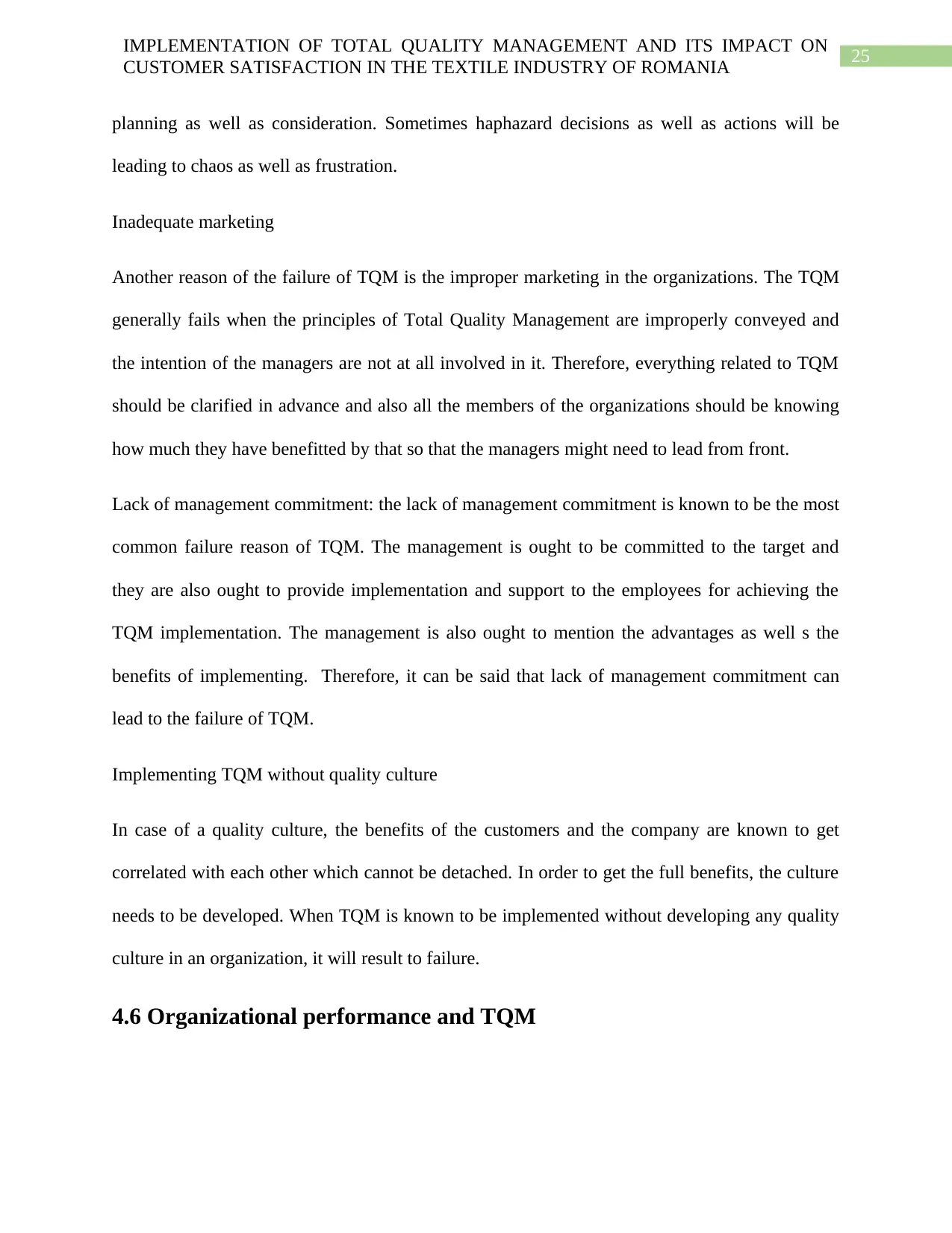
25
IMPLEMENTATION OF TOTAL QUALITY MANAGEMENT AND ITS IMPACT ON
CUSTOMER SATISFACTION IN THE TEXTILE INDUSTRY OF ROMANIA
planning as well as consideration. Sometimes haphazard decisions as well as actions will be
leading to chaos as well as frustration.
Inadequate marketing
Another reason of the failure of TQM is the improper marketing in the organizations. The TQM
generally fails when the principles of Total Quality Management are improperly conveyed and
the intention of the managers are not at all involved in it. Therefore, everything related to TQM
should be clarified in advance and also all the members of the organizations should be knowing
how much they have benefitted by that so that the managers might need to lead from front.
Lack of management commitment: the lack of management commitment is known to be the most
common failure reason of TQM. The management is ought to be committed to the target and
they are also ought to provide implementation and support to the employees for achieving the
TQM implementation. The management is also ought to mention the advantages as well s the
benefits of implementing. Therefore, it can be said that lack of management commitment can
lead to the failure of TQM.
Implementing TQM without quality culture
In case of a quality culture, the benefits of the customers and the company are known to get
correlated with each other which cannot be detached. In order to get the full benefits, the culture
needs to be developed. When TQM is known to be implemented without developing any quality
culture in an organization, it will result to failure.
4.6 Organizational performance and TQM
IMPLEMENTATION OF TOTAL QUALITY MANAGEMENT AND ITS IMPACT ON
CUSTOMER SATISFACTION IN THE TEXTILE INDUSTRY OF ROMANIA
planning as well as consideration. Sometimes haphazard decisions as well as actions will be
leading to chaos as well as frustration.
Inadequate marketing
Another reason of the failure of TQM is the improper marketing in the organizations. The TQM
generally fails when the principles of Total Quality Management are improperly conveyed and
the intention of the managers are not at all involved in it. Therefore, everything related to TQM
should be clarified in advance and also all the members of the organizations should be knowing
how much they have benefitted by that so that the managers might need to lead from front.
Lack of management commitment: the lack of management commitment is known to be the most
common failure reason of TQM. The management is ought to be committed to the target and
they are also ought to provide implementation and support to the employees for achieving the
TQM implementation. The management is also ought to mention the advantages as well s the
benefits of implementing. Therefore, it can be said that lack of management commitment can
lead to the failure of TQM.
Implementing TQM without quality culture
In case of a quality culture, the benefits of the customers and the company are known to get
correlated with each other which cannot be detached. In order to get the full benefits, the culture
needs to be developed. When TQM is known to be implemented without developing any quality
culture in an organization, it will result to failure.
4.6 Organizational performance and TQM
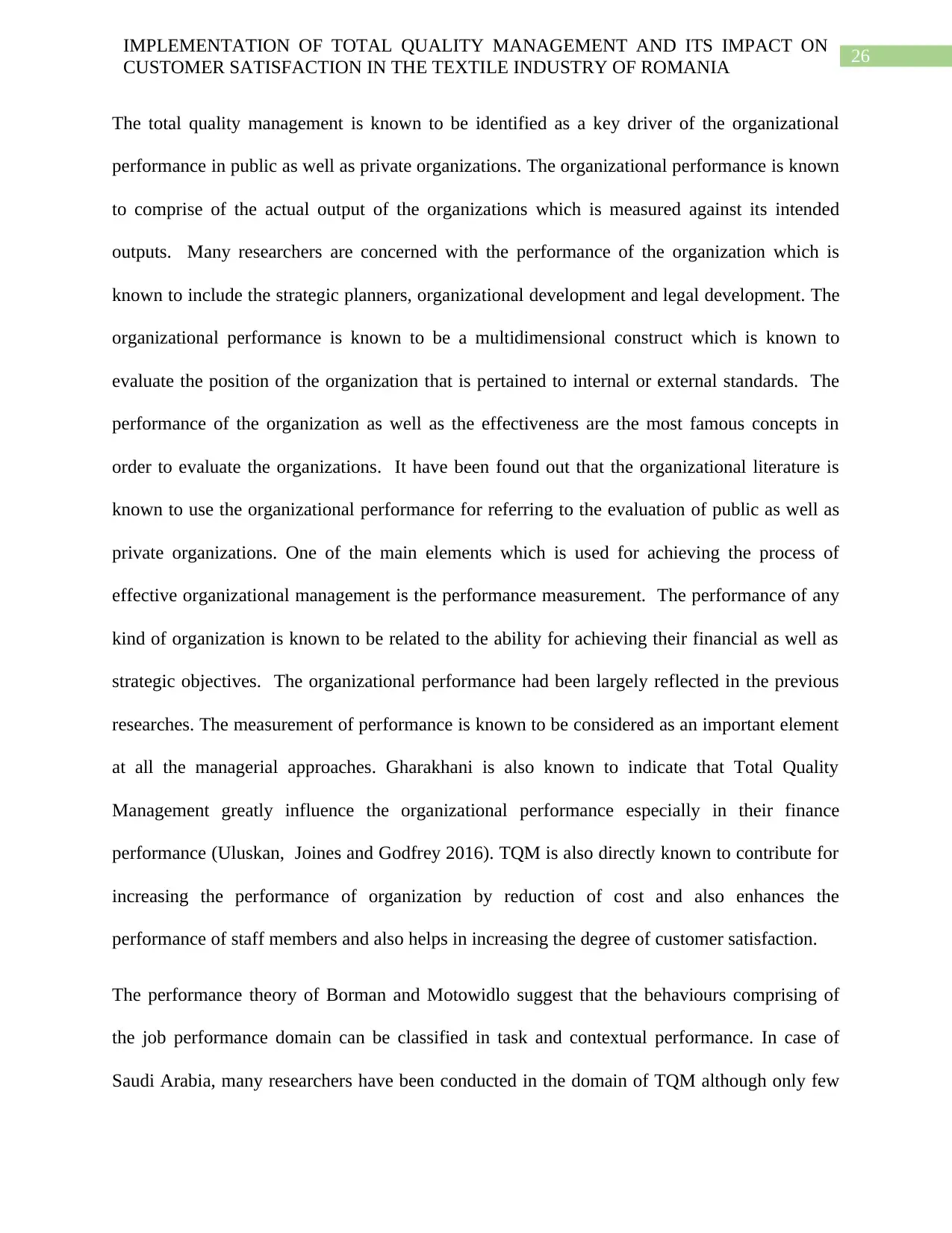
26
IMPLEMENTATION OF TOTAL QUALITY MANAGEMENT AND ITS IMPACT ON
CUSTOMER SATISFACTION IN THE TEXTILE INDUSTRY OF ROMANIA
The total quality management is known to be identified as a key driver of the organizational
performance in public as well as private organizations. The organizational performance is known
to comprise of the actual output of the organizations which is measured against its intended
outputs. Many researchers are concerned with the performance of the organization which is
known to include the strategic planners, organizational development and legal development. The
organizational performance is known to be a multidimensional construct which is known to
evaluate the position of the organization that is pertained to internal or external standards. The
performance of the organization as well as the effectiveness are the most famous concepts in
order to evaluate the organizations. It have been found out that the organizational literature is
known to use the organizational performance for referring to the evaluation of public as well as
private organizations. One of the main elements which is used for achieving the process of
effective organizational management is the performance measurement. The performance of any
kind of organization is known to be related to the ability for achieving their financial as well as
strategic objectives. The organizational performance had been largely reflected in the previous
researches. The measurement of performance is known to be considered as an important element
at all the managerial approaches. Gharakhani is also known to indicate that Total Quality
Management greatly influence the organizational performance especially in their finance
performance (Uluskan, Joines and Godfrey 2016). TQM is also directly known to contribute for
increasing the performance of organization by reduction of cost and also enhances the
performance of staff members and also helps in increasing the degree of customer satisfaction.
The performance theory of Borman and Motowidlo suggest that the behaviours comprising of
the job performance domain can be classified in task and contextual performance. In case of
Saudi Arabia, many researchers have been conducted in the domain of TQM although only few
IMPLEMENTATION OF TOTAL QUALITY MANAGEMENT AND ITS IMPACT ON
CUSTOMER SATISFACTION IN THE TEXTILE INDUSTRY OF ROMANIA
The total quality management is known to be identified as a key driver of the organizational
performance in public as well as private organizations. The organizational performance is known
to comprise of the actual output of the organizations which is measured against its intended
outputs. Many researchers are concerned with the performance of the organization which is
known to include the strategic planners, organizational development and legal development. The
organizational performance is known to be a multidimensional construct which is known to
evaluate the position of the organization that is pertained to internal or external standards. The
performance of the organization as well as the effectiveness are the most famous concepts in
order to evaluate the organizations. It have been found out that the organizational literature is
known to use the organizational performance for referring to the evaluation of public as well as
private organizations. One of the main elements which is used for achieving the process of
effective organizational management is the performance measurement. The performance of any
kind of organization is known to be related to the ability for achieving their financial as well as
strategic objectives. The organizational performance had been largely reflected in the previous
researches. The measurement of performance is known to be considered as an important element
at all the managerial approaches. Gharakhani is also known to indicate that Total Quality
Management greatly influence the organizational performance especially in their finance
performance (Uluskan, Joines and Godfrey 2016). TQM is also directly known to contribute for
increasing the performance of organization by reduction of cost and also enhances the
performance of staff members and also helps in increasing the degree of customer satisfaction.
The performance theory of Borman and Motowidlo suggest that the behaviours comprising of
the job performance domain can be classified in task and contextual performance. In case of
Saudi Arabia, many researchers have been conducted in the domain of TQM although only few

27
IMPLEMENTATION OF TOTAL QUALITY MANAGEMENT AND ITS IMPACT ON
CUSTOMER SATISFACTION IN THE TEXTILE INDUSTRY OF ROMANIA
researchers are known to focus on the impact of TQM on the organizational performance. There
are many articles, surveys as well as studies which are known to describe the roles of quality in
order to improve the performance of the organization. It have been found that TQM is known to
positively affect the operational as well as the organizational performance of the firm. Some of
the results also reveal the fact that continuous improvement, customer focus, commitment of the
top management along with the product innovation are known to be positively related to the
quality of the product. The practices of TQM are known to significantly affect the various
performance outcomes where the main obstacle was the lack of improvement. There are many
articles which describes the roles of quality used for improvement of the performance of the
organization. One of the way used for measuring the success of an organization is to achieve its
strategic objectives which is also known to evaluate the employee performance (Imran, Aziz and
Hamid 2017). The performance of the organization as well as the effectiveness are the most
famous concepts in order to evaluate the organizations. It have been found out that the
organizational literature is known to use the organizational performance for referring to the
evaluation of public as well as private organizations. One of the main elements which is used for
achieving the process of effective organizational management is the performance measurement.
The performance of any kind of organization is known to be related to the ability for achieving
their financial as well as strategic objectives.
IMPLEMENTATION OF TOTAL QUALITY MANAGEMENT AND ITS IMPACT ON
CUSTOMER SATISFACTION IN THE TEXTILE INDUSTRY OF ROMANIA
researchers are known to focus on the impact of TQM on the organizational performance. There
are many articles, surveys as well as studies which are known to describe the roles of quality in
order to improve the performance of the organization. It have been found that TQM is known to
positively affect the operational as well as the organizational performance of the firm. Some of
the results also reveal the fact that continuous improvement, customer focus, commitment of the
top management along with the product innovation are known to be positively related to the
quality of the product. The practices of TQM are known to significantly affect the various
performance outcomes where the main obstacle was the lack of improvement. There are many
articles which describes the roles of quality used for improvement of the performance of the
organization. One of the way used for measuring the success of an organization is to achieve its
strategic objectives which is also known to evaluate the employee performance (Imran, Aziz and
Hamid 2017). The performance of the organization as well as the effectiveness are the most
famous concepts in order to evaluate the organizations. It have been found out that the
organizational literature is known to use the organizational performance for referring to the
evaluation of public as well as private organizations. One of the main elements which is used for
achieving the process of effective organizational management is the performance measurement.
The performance of any kind of organization is known to be related to the ability for achieving
their financial as well as strategic objectives.
Secure Best Marks with AI Grader
Need help grading? Try our AI Grader for instant feedback on your assignments.
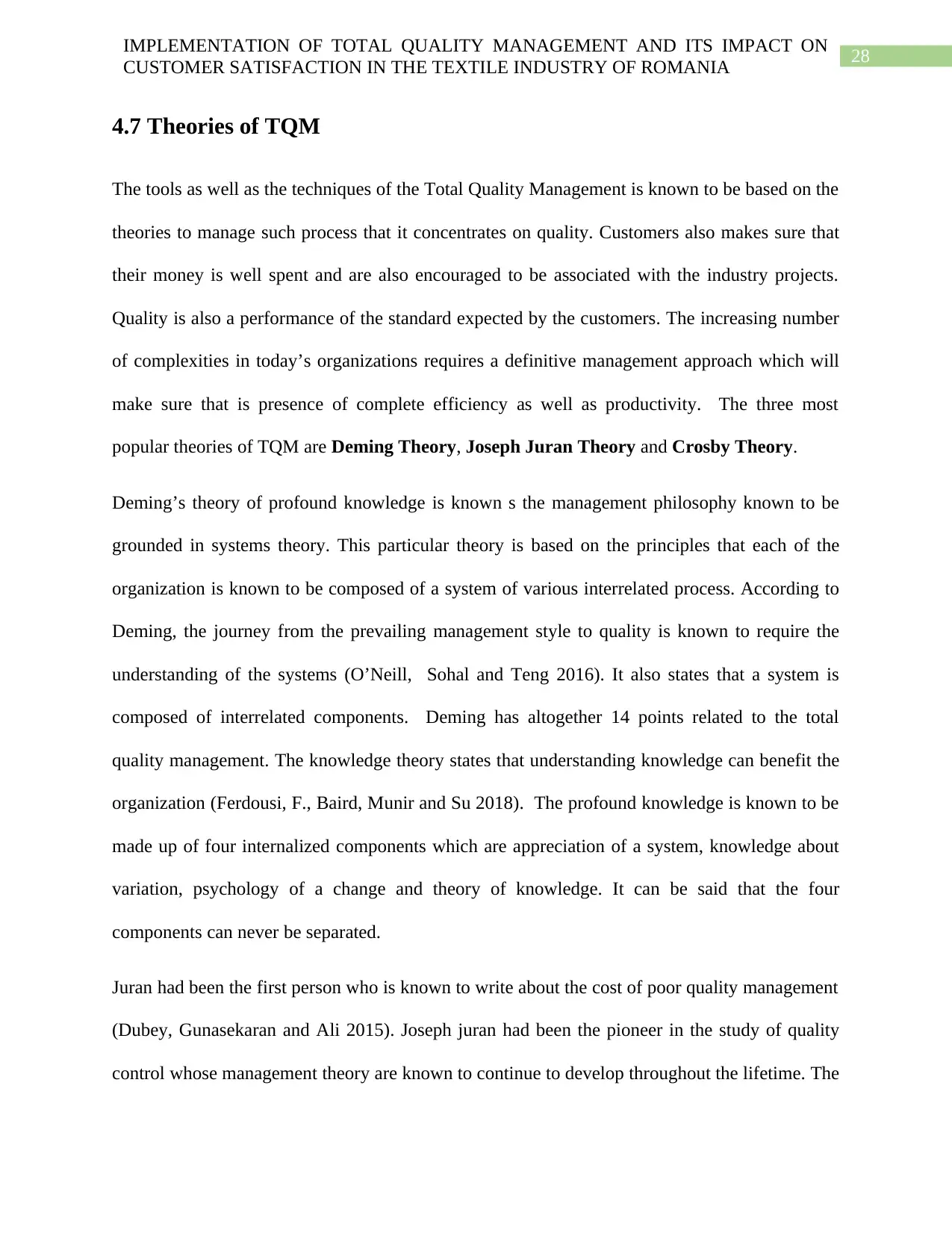
28
IMPLEMENTATION OF TOTAL QUALITY MANAGEMENT AND ITS IMPACT ON
CUSTOMER SATISFACTION IN THE TEXTILE INDUSTRY OF ROMANIA
4.7 Theories of TQM
The tools as well as the techniques of the Total Quality Management is known to be based on the
theories to manage such process that it concentrates on quality. Customers also makes sure that
their money is well spent and are also encouraged to be associated with the industry projects.
Quality is also a performance of the standard expected by the customers. The increasing number
of complexities in today’s organizations requires a definitive management approach which will
make sure that is presence of complete efficiency as well as productivity. The three most
popular theories of TQM are Deming Theory, Joseph Juran Theory and Crosby Theory.
Deming’s theory of profound knowledge is known s the management philosophy known to be
grounded in systems theory. This particular theory is based on the principles that each of the
organization is known to be composed of a system of various interrelated process. According to
Deming, the journey from the prevailing management style to quality is known to require the
understanding of the systems (O’Neill, Sohal and Teng 2016). It also states that a system is
composed of interrelated components. Deming has altogether 14 points related to the total
quality management. The knowledge theory states that understanding knowledge can benefit the
organization (Ferdousi, F., Baird, Munir and Su 2018). The profound knowledge is known to be
made up of four internalized components which are appreciation of a system, knowledge about
variation, psychology of a change and theory of knowledge. It can be said that the four
components can never be separated.
Juran had been the first person who is known to write about the cost of poor quality management
(Dubey, Gunasekaran and Ali 2015). Joseph juran had been the pioneer in the study of quality
control whose management theory are known to continue to develop throughout the lifetime. The
IMPLEMENTATION OF TOTAL QUALITY MANAGEMENT AND ITS IMPACT ON
CUSTOMER SATISFACTION IN THE TEXTILE INDUSTRY OF ROMANIA
4.7 Theories of TQM
The tools as well as the techniques of the Total Quality Management is known to be based on the
theories to manage such process that it concentrates on quality. Customers also makes sure that
their money is well spent and are also encouraged to be associated with the industry projects.
Quality is also a performance of the standard expected by the customers. The increasing number
of complexities in today’s organizations requires a definitive management approach which will
make sure that is presence of complete efficiency as well as productivity. The three most
popular theories of TQM are Deming Theory, Joseph Juran Theory and Crosby Theory.
Deming’s theory of profound knowledge is known s the management philosophy known to be
grounded in systems theory. This particular theory is based on the principles that each of the
organization is known to be composed of a system of various interrelated process. According to
Deming, the journey from the prevailing management style to quality is known to require the
understanding of the systems (O’Neill, Sohal and Teng 2016). It also states that a system is
composed of interrelated components. Deming has altogether 14 points related to the total
quality management. The knowledge theory states that understanding knowledge can benefit the
organization (Ferdousi, F., Baird, Munir and Su 2018). The profound knowledge is known to be
made up of four internalized components which are appreciation of a system, knowledge about
variation, psychology of a change and theory of knowledge. It can be said that the four
components can never be separated.
Juran had been the first person who is known to write about the cost of poor quality management
(Dubey, Gunasekaran and Ali 2015). Joseph juran had been the pioneer in the study of quality
control whose management theory are known to continue to develop throughout the lifetime. The
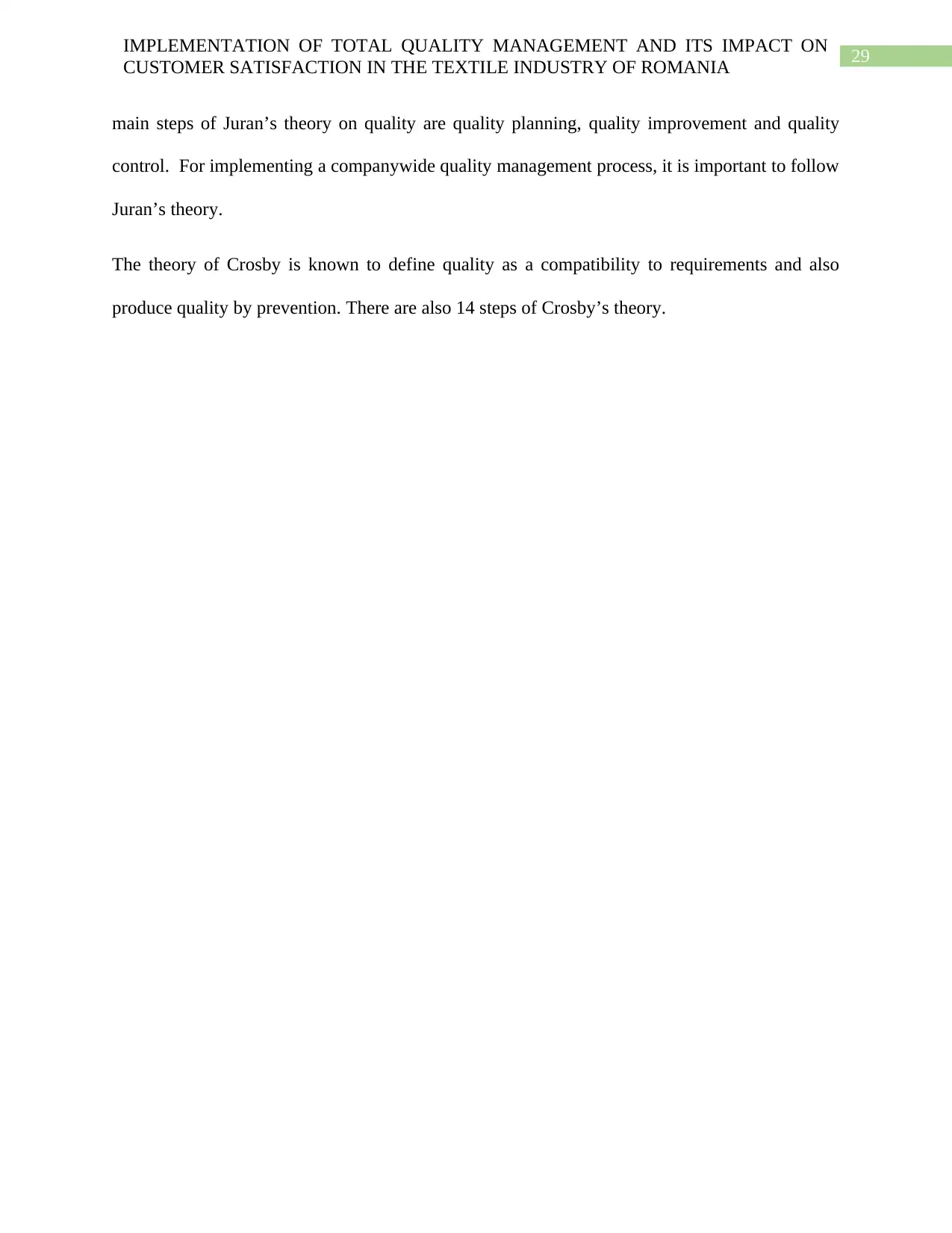
29
IMPLEMENTATION OF TOTAL QUALITY MANAGEMENT AND ITS IMPACT ON
CUSTOMER SATISFACTION IN THE TEXTILE INDUSTRY OF ROMANIA
main steps of Juran’s theory on quality are quality planning, quality improvement and quality
control. For implementing a companywide quality management process, it is important to follow
Juran’s theory.
The theory of Crosby is known to define quality as a compatibility to requirements and also
produce quality by prevention. There are also 14 steps of Crosby’s theory.
IMPLEMENTATION OF TOTAL QUALITY MANAGEMENT AND ITS IMPACT ON
CUSTOMER SATISFACTION IN THE TEXTILE INDUSTRY OF ROMANIA
main steps of Juran’s theory on quality are quality planning, quality improvement and quality
control. For implementing a companywide quality management process, it is important to follow
Juran’s theory.
The theory of Crosby is known to define quality as a compatibility to requirements and also
produce quality by prevention. There are also 14 steps of Crosby’s theory.
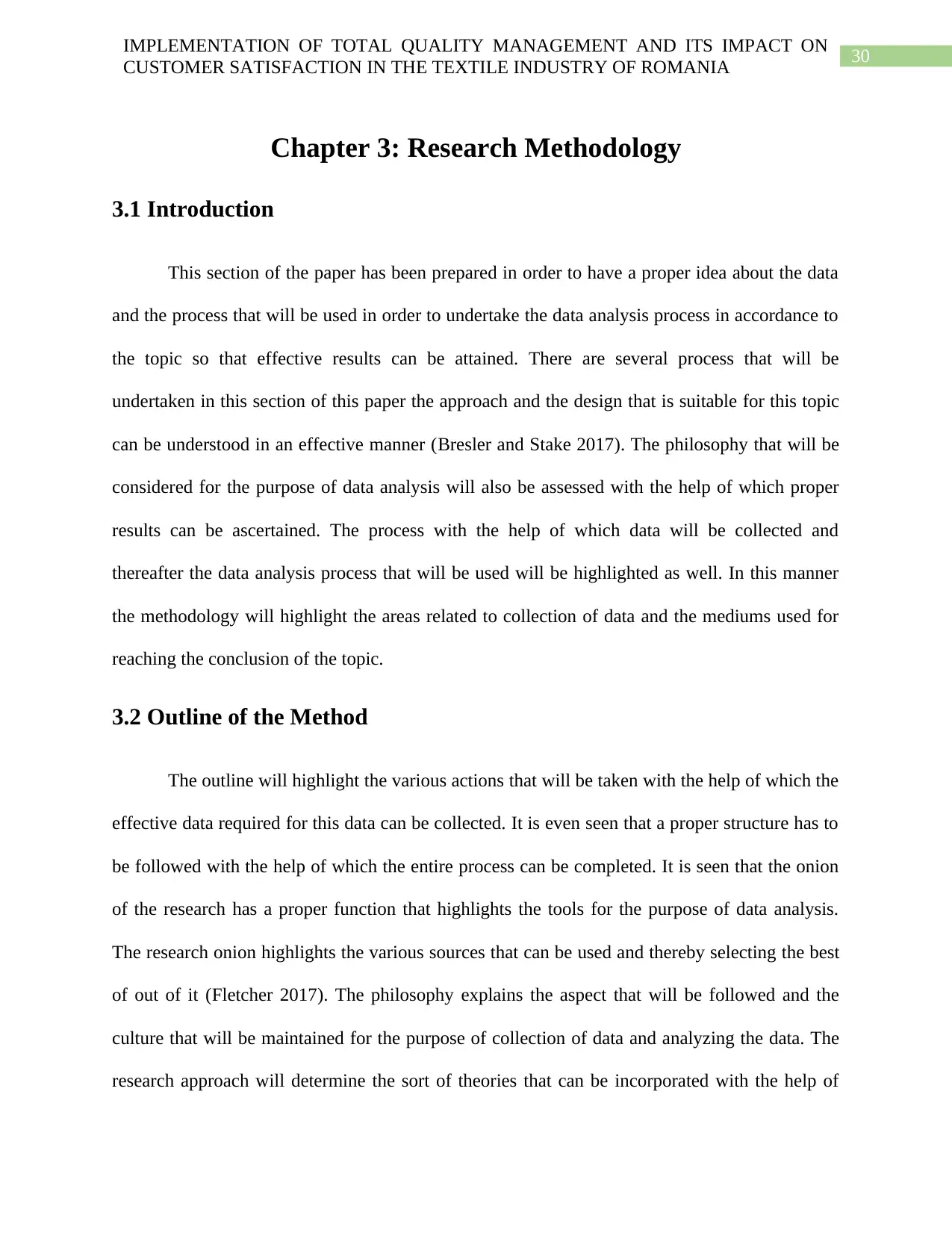
30
IMPLEMENTATION OF TOTAL QUALITY MANAGEMENT AND ITS IMPACT ON
CUSTOMER SATISFACTION IN THE TEXTILE INDUSTRY OF ROMANIA
Chapter 3: Research Methodology
3.1 Introduction
This section of the paper has been prepared in order to have a proper idea about the data
and the process that will be used in order to undertake the data analysis process in accordance to
the topic so that effective results can be attained. There are several process that will be
undertaken in this section of this paper the approach and the design that is suitable for this topic
can be understood in an effective manner (Bresler and Stake 2017). The philosophy that will be
considered for the purpose of data analysis will also be assessed with the help of which proper
results can be ascertained. The process with the help of which data will be collected and
thereafter the data analysis process that will be used will be highlighted as well. In this manner
the methodology will highlight the areas related to collection of data and the mediums used for
reaching the conclusion of the topic.
3.2 Outline of the Method
The outline will highlight the various actions that will be taken with the help of which the
effective data required for this data can be collected. It is even seen that a proper structure has to
be followed with the help of which the entire process can be completed. It is seen that the onion
of the research has a proper function that highlights the tools for the purpose of data analysis.
The research onion highlights the various sources that can be used and thereby selecting the best
of out of it (Fletcher 2017). The philosophy explains the aspect that will be followed and the
culture that will be maintained for the purpose of collection of data and analyzing the data. The
research approach will determine the sort of theories that can be incorporated with the help of
IMPLEMENTATION OF TOTAL QUALITY MANAGEMENT AND ITS IMPACT ON
CUSTOMER SATISFACTION IN THE TEXTILE INDUSTRY OF ROMANIA
Chapter 3: Research Methodology
3.1 Introduction
This section of the paper has been prepared in order to have a proper idea about the data
and the process that will be used in order to undertake the data analysis process in accordance to
the topic so that effective results can be attained. There are several process that will be
undertaken in this section of this paper the approach and the design that is suitable for this topic
can be understood in an effective manner (Bresler and Stake 2017). The philosophy that will be
considered for the purpose of data analysis will also be assessed with the help of which proper
results can be ascertained. The process with the help of which data will be collected and
thereafter the data analysis process that will be used will be highlighted as well. In this manner
the methodology will highlight the areas related to collection of data and the mediums used for
reaching the conclusion of the topic.
3.2 Outline of the Method
The outline will highlight the various actions that will be taken with the help of which the
effective data required for this data can be collected. It is even seen that a proper structure has to
be followed with the help of which the entire process can be completed. It is seen that the onion
of the research has a proper function that highlights the tools for the purpose of data analysis.
The research onion highlights the various sources that can be used and thereby selecting the best
of out of it (Fletcher 2017). The philosophy explains the aspect that will be followed and the
culture that will be maintained for the purpose of collection of data and analyzing the data. The
research approach will determine the sort of theories that can be incorporated with the help of
Paraphrase This Document
Need a fresh take? Get an instant paraphrase of this document with our AI Paraphraser
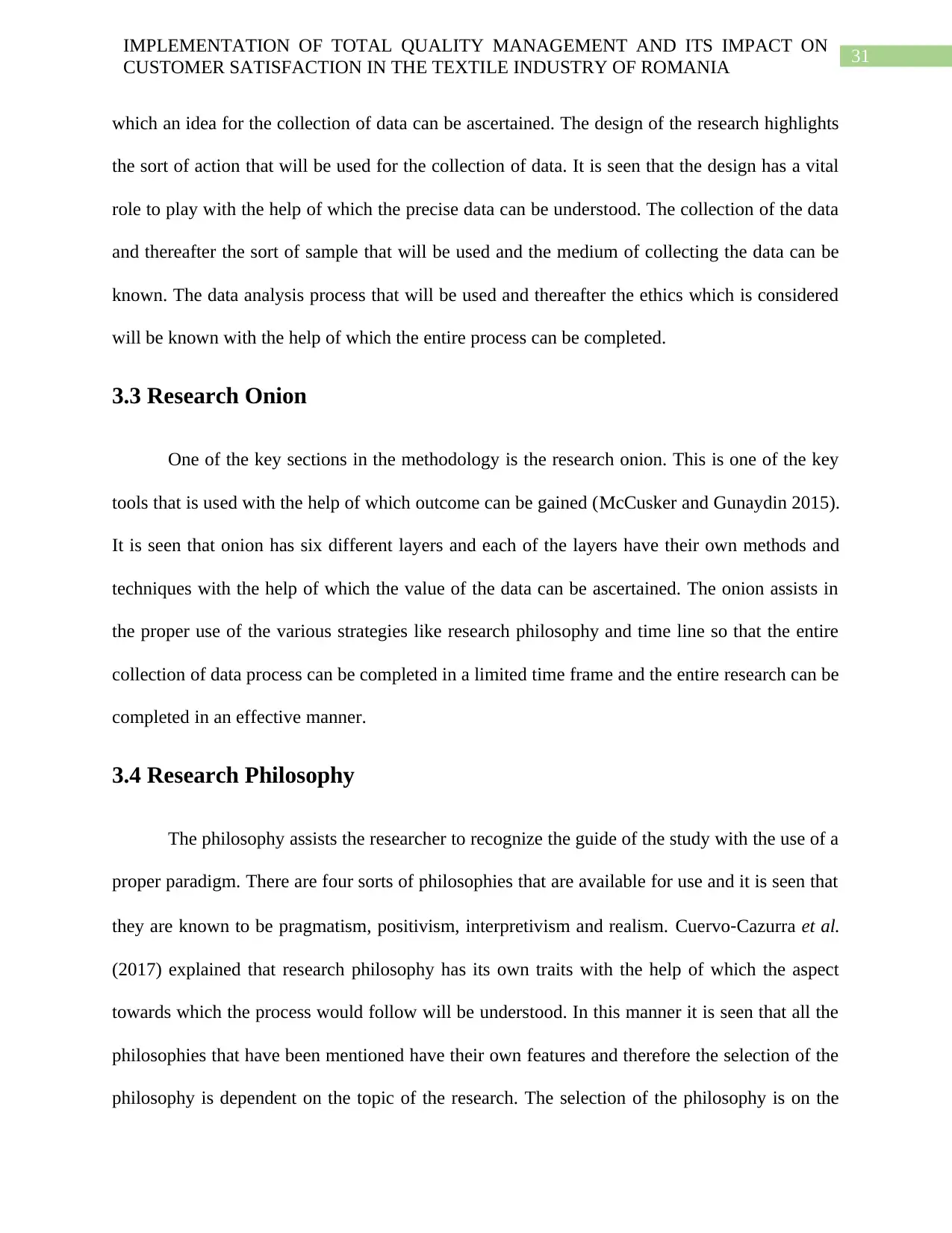
31
IMPLEMENTATION OF TOTAL QUALITY MANAGEMENT AND ITS IMPACT ON
CUSTOMER SATISFACTION IN THE TEXTILE INDUSTRY OF ROMANIA
which an idea for the collection of data can be ascertained. The design of the research highlights
the sort of action that will be used for the collection of data. It is seen that the design has a vital
role to play with the help of which the precise data can be understood. The collection of the data
and thereafter the sort of sample that will be used and the medium of collecting the data can be
known. The data analysis process that will be used and thereafter the ethics which is considered
will be known with the help of which the entire process can be completed.
3.3 Research Onion
One of the key sections in the methodology is the research onion. This is one of the key
tools that is used with the help of which outcome can be gained (McCusker and Gunaydin 2015).
It is seen that onion has six different layers and each of the layers have their own methods and
techniques with the help of which the value of the data can be ascertained. The onion assists in
the proper use of the various strategies like research philosophy and time line so that the entire
collection of data process can be completed in a limited time frame and the entire research can be
completed in an effective manner.
3.4 Research Philosophy
The philosophy assists the researcher to recognize the guide of the study with the use of a
proper paradigm. There are four sorts of philosophies that are available for use and it is seen that
they are known to be pragmatism, positivism, interpretivism and realism. Cuervo‐Cazurra et al.
(2017) explained that research philosophy has its own traits with the help of which the aspect
towards which the process would follow will be understood. In this manner it is seen that all the
philosophies that have been mentioned have their own features and therefore the selection of the
philosophy is dependent on the topic of the research. The selection of the philosophy is on the
IMPLEMENTATION OF TOTAL QUALITY MANAGEMENT AND ITS IMPACT ON
CUSTOMER SATISFACTION IN THE TEXTILE INDUSTRY OF ROMANIA
which an idea for the collection of data can be ascertained. The design of the research highlights
the sort of action that will be used for the collection of data. It is seen that the design has a vital
role to play with the help of which the precise data can be understood. The collection of the data
and thereafter the sort of sample that will be used and the medium of collecting the data can be
known. The data analysis process that will be used and thereafter the ethics which is considered
will be known with the help of which the entire process can be completed.
3.3 Research Onion
One of the key sections in the methodology is the research onion. This is one of the key
tools that is used with the help of which outcome can be gained (McCusker and Gunaydin 2015).
It is seen that onion has six different layers and each of the layers have their own methods and
techniques with the help of which the value of the data can be ascertained. The onion assists in
the proper use of the various strategies like research philosophy and time line so that the entire
collection of data process can be completed in a limited time frame and the entire research can be
completed in an effective manner.
3.4 Research Philosophy
The philosophy assists the researcher to recognize the guide of the study with the use of a
proper paradigm. There are four sorts of philosophies that are available for use and it is seen that
they are known to be pragmatism, positivism, interpretivism and realism. Cuervo‐Cazurra et al.
(2017) explained that research philosophy has its own traits with the help of which the aspect
towards which the process would follow will be understood. In this manner it is seen that all the
philosophies that have been mentioned have their own features and therefore the selection of the
philosophy is dependent on the topic of the research. The selection of the philosophy is on the

32
IMPLEMENTATION OF TOTAL QUALITY MANAGEMENT AND ITS IMPACT ON
CUSTOMER SATISFACTION IN THE TEXTILE INDUSTRY OF ROMANIA
basis of the mindset of the researcher and therefore accordingly the data collection will be
undertaken. This topic looks to have an understanding of the impact of total quality management
in the customer satisfaction in the textile industry in Romania. As customer satisfaction is the
key aspect therefore the researcher has selected positivism philosophy as the researcher tries to
make use of the reality and thereby utilize techniques that have been scientifically proven. This
technique even makes use of quantitative and qualitative approaches and therefore this process
can be an effective one. Hence, this process is ideal for the concerned topic.
3.5 Research Approach
The approach is one of the key actions for the completion of the research paper for
attaining the desired and real research result. Clandinin, Cave and Berendonk (2017) in this
aspect highlighted the fact that the approach assists the researcher to recognize the actions and
the steps that are required in order to perform the activities that are required. It is seen that are
two kinds of approaches that can be used with the help of which the data that is ideal can be
known in an effective manner. The two approaches that inductive and deductive approach. The
inductive approach constitutes of the frameworks and the theories that have been newly created
with the help of which a new idea and concept can be created with the help of which proper
results can be ascertained (Briggs and Coleman 2019). On the other hand, deductive approach
comprises of the models and values that have been used previously by other researchers in order
to attain the desired data and the outcome of the paper. Accordingly as the topic of the research
is discovering the impact of total quality management on customer satisfaction in the textile
industry in Romania, it is seen that deductive approach is the ideal one as the models that have
been used for previously in related researches will be used with the help of which outcome that is
desired can be ascertained.
IMPLEMENTATION OF TOTAL QUALITY MANAGEMENT AND ITS IMPACT ON
CUSTOMER SATISFACTION IN THE TEXTILE INDUSTRY OF ROMANIA
basis of the mindset of the researcher and therefore accordingly the data collection will be
undertaken. This topic looks to have an understanding of the impact of total quality management
in the customer satisfaction in the textile industry in Romania. As customer satisfaction is the
key aspect therefore the researcher has selected positivism philosophy as the researcher tries to
make use of the reality and thereby utilize techniques that have been scientifically proven. This
technique even makes use of quantitative and qualitative approaches and therefore this process
can be an effective one. Hence, this process is ideal for the concerned topic.
3.5 Research Approach
The approach is one of the key actions for the completion of the research paper for
attaining the desired and real research result. Clandinin, Cave and Berendonk (2017) in this
aspect highlighted the fact that the approach assists the researcher to recognize the actions and
the steps that are required in order to perform the activities that are required. It is seen that are
two kinds of approaches that can be used with the help of which the data that is ideal can be
known in an effective manner. The two approaches that inductive and deductive approach. The
inductive approach constitutes of the frameworks and the theories that have been newly created
with the help of which a new idea and concept can be created with the help of which proper
results can be ascertained (Briggs and Coleman 2019). On the other hand, deductive approach
comprises of the models and values that have been used previously by other researchers in order
to attain the desired data and the outcome of the paper. Accordingly as the topic of the research
is discovering the impact of total quality management on customer satisfaction in the textile
industry in Romania, it is seen that deductive approach is the ideal one as the models that have
been used for previously in related researches will be used with the help of which outcome that is
desired can be ascertained.
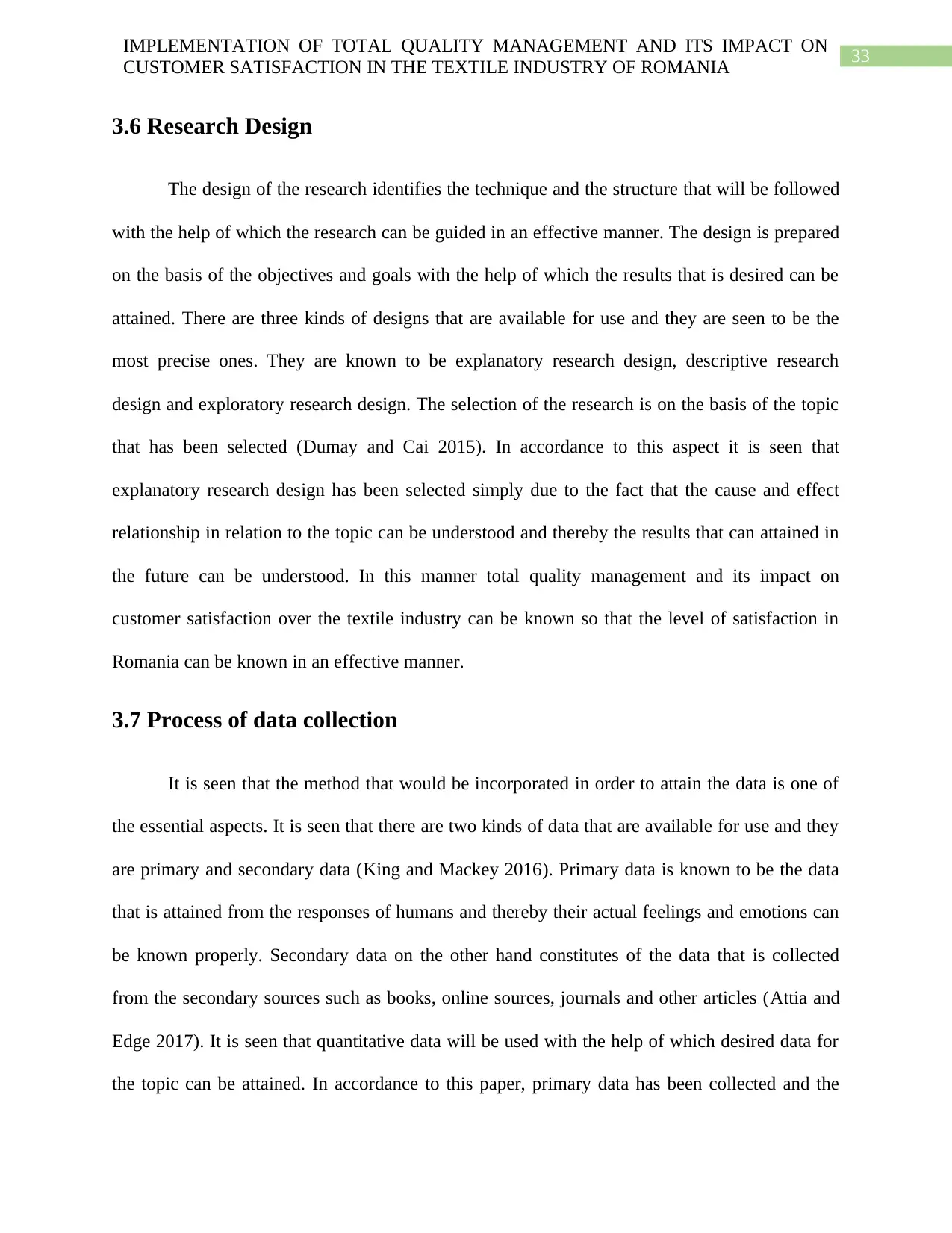
33
IMPLEMENTATION OF TOTAL QUALITY MANAGEMENT AND ITS IMPACT ON
CUSTOMER SATISFACTION IN THE TEXTILE INDUSTRY OF ROMANIA
3.6 Research Design
The design of the research identifies the technique and the structure that will be followed
with the help of which the research can be guided in an effective manner. The design is prepared
on the basis of the objectives and goals with the help of which the results that is desired can be
attained. There are three kinds of designs that are available for use and they are seen to be the
most precise ones. They are known to be explanatory research design, descriptive research
design and exploratory research design. The selection of the research is on the basis of the topic
that has been selected (Dumay and Cai 2015). In accordance to this aspect it is seen that
explanatory research design has been selected simply due to the fact that the cause and effect
relationship in relation to the topic can be understood and thereby the results that can attained in
the future can be understood. In this manner total quality management and its impact on
customer satisfaction over the textile industry can be known so that the level of satisfaction in
Romania can be known in an effective manner.
3.7 Process of data collection
It is seen that the method that would be incorporated in order to attain the data is one of
the essential aspects. It is seen that there are two kinds of data that are available for use and they
are primary and secondary data (King and Mackey 2016). Primary data is known to be the data
that is attained from the responses of humans and thereby their actual feelings and emotions can
be known properly. Secondary data on the other hand constitutes of the data that is collected
from the secondary sources such as books, online sources, journals and other articles (Attia and
Edge 2017). It is seen that quantitative data will be used with the help of which desired data for
the topic can be attained. In accordance to this paper, primary data has been collected and the
IMPLEMENTATION OF TOTAL QUALITY MANAGEMENT AND ITS IMPACT ON
CUSTOMER SATISFACTION IN THE TEXTILE INDUSTRY OF ROMANIA
3.6 Research Design
The design of the research identifies the technique and the structure that will be followed
with the help of which the research can be guided in an effective manner. The design is prepared
on the basis of the objectives and goals with the help of which the results that is desired can be
attained. There are three kinds of designs that are available for use and they are seen to be the
most precise ones. They are known to be explanatory research design, descriptive research
design and exploratory research design. The selection of the research is on the basis of the topic
that has been selected (Dumay and Cai 2015). In accordance to this aspect it is seen that
explanatory research design has been selected simply due to the fact that the cause and effect
relationship in relation to the topic can be understood and thereby the results that can attained in
the future can be understood. In this manner total quality management and its impact on
customer satisfaction over the textile industry can be known so that the level of satisfaction in
Romania can be known in an effective manner.
3.7 Process of data collection
It is seen that the method that would be incorporated in order to attain the data is one of
the essential aspects. It is seen that there are two kinds of data that are available for use and they
are primary and secondary data (King and Mackey 2016). Primary data is known to be the data
that is attained from the responses of humans and thereby their actual feelings and emotions can
be known properly. Secondary data on the other hand constitutes of the data that is collected
from the secondary sources such as books, online sources, journals and other articles (Attia and
Edge 2017). It is seen that quantitative data will be used with the help of which desired data for
the topic can be attained. In accordance to this paper, primary data has been collected and the
Secure Best Marks with AI Grader
Need help grading? Try our AI Grader for instant feedback on your assignments.
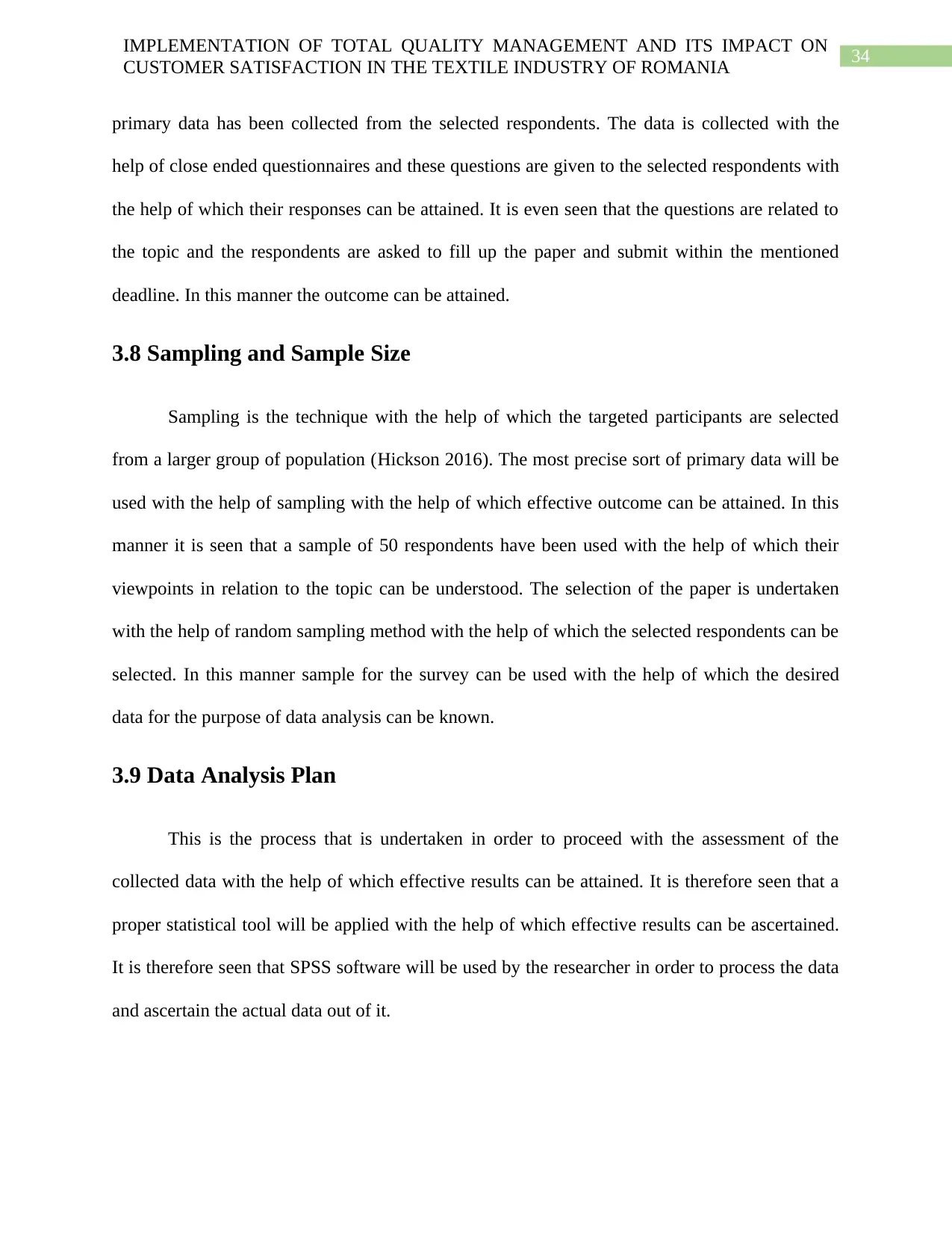
34
IMPLEMENTATION OF TOTAL QUALITY MANAGEMENT AND ITS IMPACT ON
CUSTOMER SATISFACTION IN THE TEXTILE INDUSTRY OF ROMANIA
primary data has been collected from the selected respondents. The data is collected with the
help of close ended questionnaires and these questions are given to the selected respondents with
the help of which their responses can be attained. It is even seen that the questions are related to
the topic and the respondents are asked to fill up the paper and submit within the mentioned
deadline. In this manner the outcome can be attained.
3.8 Sampling and Sample Size
Sampling is the technique with the help of which the targeted participants are selected
from a larger group of population (Hickson 2016). The most precise sort of primary data will be
used with the help of sampling with the help of which effective outcome can be attained. In this
manner it is seen that a sample of 50 respondents have been used with the help of which their
viewpoints in relation to the topic can be understood. The selection of the paper is undertaken
with the help of random sampling method with the help of which the selected respondents can be
selected. In this manner sample for the survey can be used with the help of which the desired
data for the purpose of data analysis can be known.
3.9 Data Analysis Plan
This is the process that is undertaken in order to proceed with the assessment of the
collected data with the help of which effective results can be attained. It is therefore seen that a
proper statistical tool will be applied with the help of which effective results can be ascertained.
It is therefore seen that SPSS software will be used by the researcher in order to process the data
and ascertain the actual data out of it.
IMPLEMENTATION OF TOTAL QUALITY MANAGEMENT AND ITS IMPACT ON
CUSTOMER SATISFACTION IN THE TEXTILE INDUSTRY OF ROMANIA
primary data has been collected from the selected respondents. The data is collected with the
help of close ended questionnaires and these questions are given to the selected respondents with
the help of which their responses can be attained. It is even seen that the questions are related to
the topic and the respondents are asked to fill up the paper and submit within the mentioned
deadline. In this manner the outcome can be attained.
3.8 Sampling and Sample Size
Sampling is the technique with the help of which the targeted participants are selected
from a larger group of population (Hickson 2016). The most precise sort of primary data will be
used with the help of sampling with the help of which effective outcome can be attained. In this
manner it is seen that a sample of 50 respondents have been used with the help of which their
viewpoints in relation to the topic can be understood. The selection of the paper is undertaken
with the help of random sampling method with the help of which the selected respondents can be
selected. In this manner sample for the survey can be used with the help of which the desired
data for the purpose of data analysis can be known.
3.9 Data Analysis Plan
This is the process that is undertaken in order to proceed with the assessment of the
collected data with the help of which effective results can be attained. It is therefore seen that a
proper statistical tool will be applied with the help of which effective results can be ascertained.
It is therefore seen that SPSS software will be used by the researcher in order to process the data
and ascertain the actual data out of it.
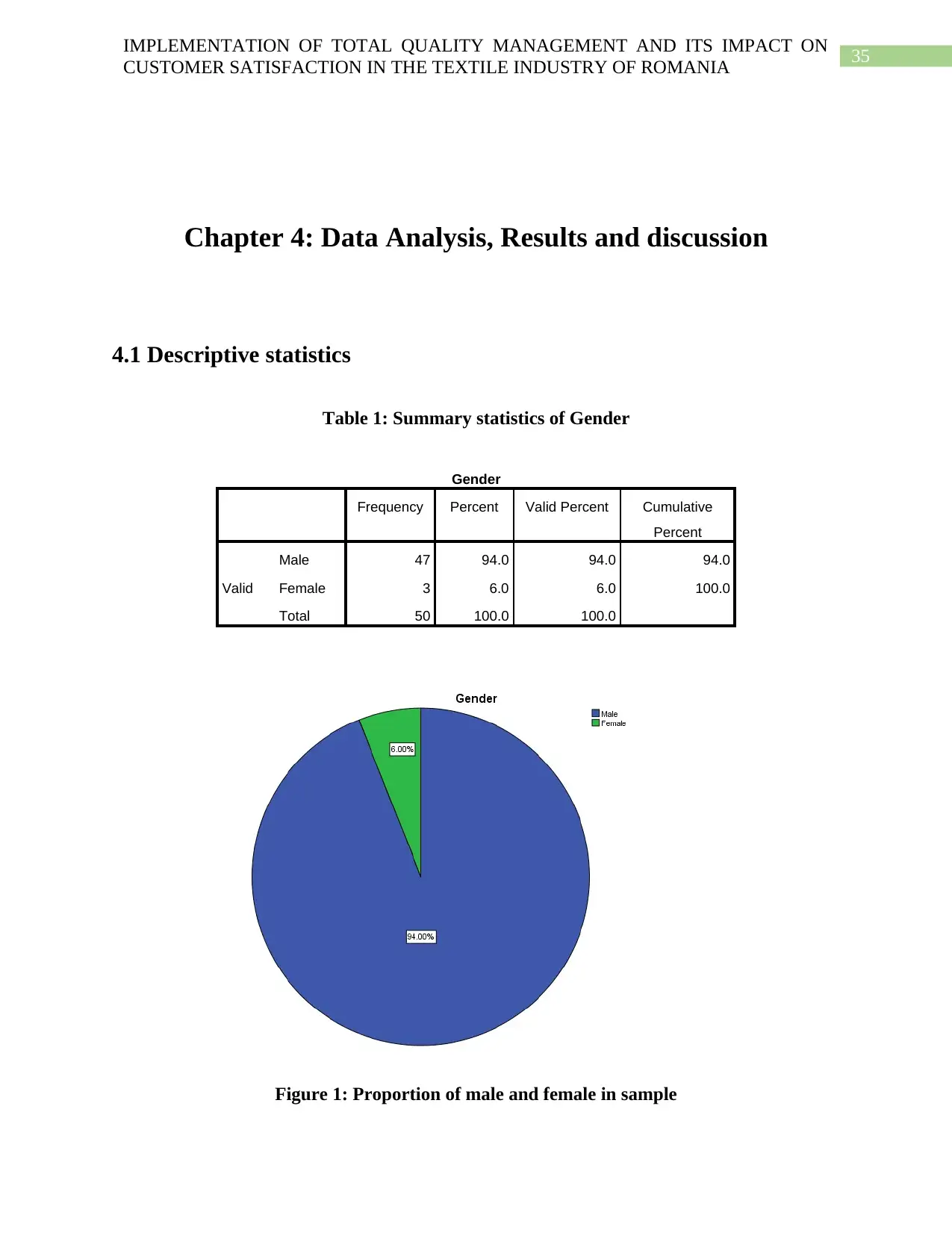
35
IMPLEMENTATION OF TOTAL QUALITY MANAGEMENT AND ITS IMPACT ON
CUSTOMER SATISFACTION IN THE TEXTILE INDUSTRY OF ROMANIA
Chapter 4: Data Analysis, Results and discussion
4.1 Descriptive statistics
Table 1: Summary statistics of Gender
Gender
Frequency Percent Valid Percent Cumulative
Percent
Valid
Male 47 94.0 94.0 94.0
Female 3 6.0 6.0 100.0
Total 50 100.0 100.0
Figure 1: Proportion of male and female in sample
IMPLEMENTATION OF TOTAL QUALITY MANAGEMENT AND ITS IMPACT ON
CUSTOMER SATISFACTION IN THE TEXTILE INDUSTRY OF ROMANIA
Chapter 4: Data Analysis, Results and discussion
4.1 Descriptive statistics
Table 1: Summary statistics of Gender
Gender
Frequency Percent Valid Percent Cumulative
Percent
Valid
Male 47 94.0 94.0 94.0
Female 3 6.0 6.0 100.0
Total 50 100.0 100.0
Figure 1: Proportion of male and female in sample
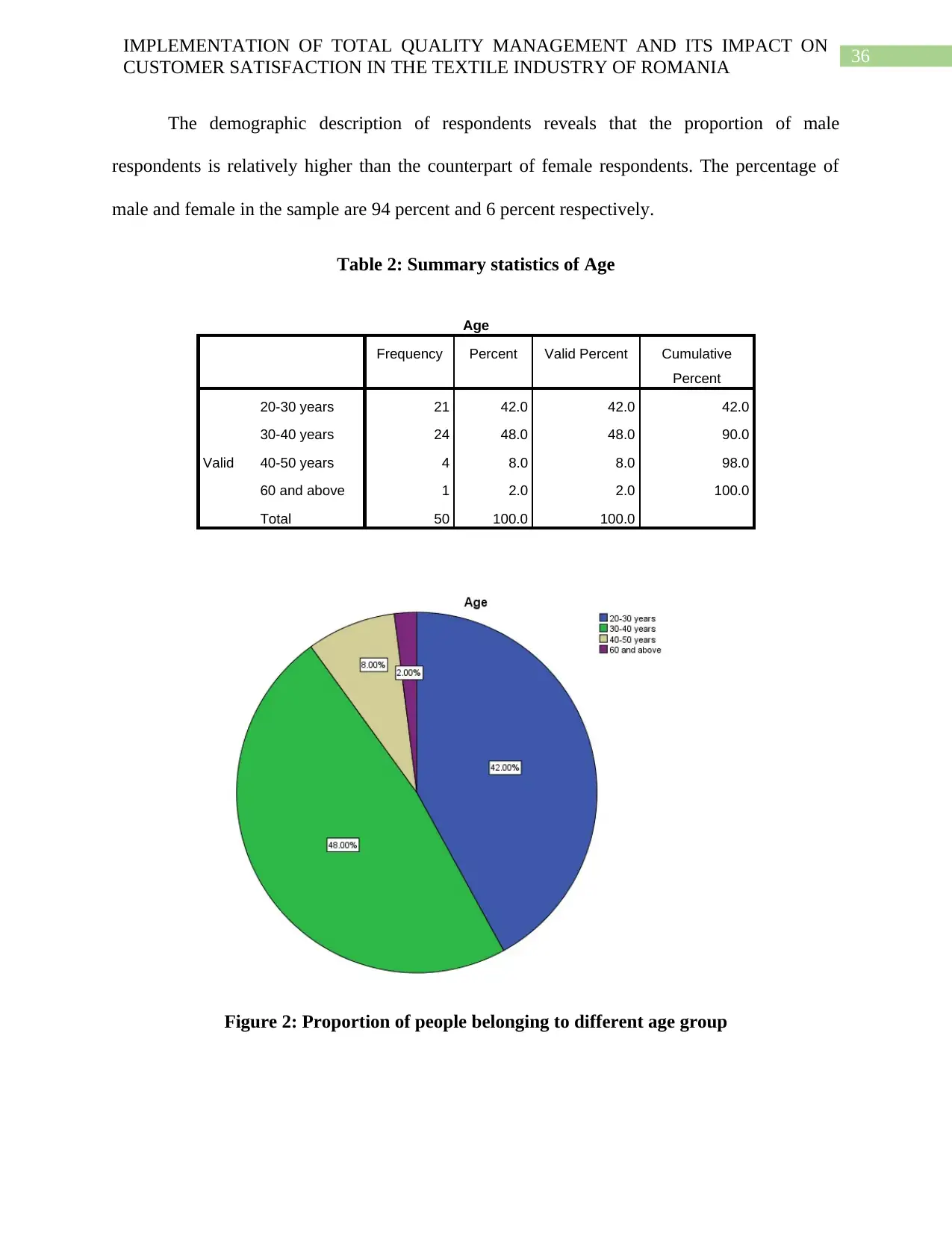
36
IMPLEMENTATION OF TOTAL QUALITY MANAGEMENT AND ITS IMPACT ON
CUSTOMER SATISFACTION IN THE TEXTILE INDUSTRY OF ROMANIA
The demographic description of respondents reveals that the proportion of male
respondents is relatively higher than the counterpart of female respondents. The percentage of
male and female in the sample are 94 percent and 6 percent respectively.
Table 2: Summary statistics of Age
Age
Frequency Percent Valid Percent Cumulative
Percent
Valid
20-30 years 21 42.0 42.0 42.0
30-40 years 24 48.0 48.0 90.0
40-50 years 4 8.0 8.0 98.0
60 and above 1 2.0 2.0 100.0
Total 50 100.0 100.0
Figure 2: Proportion of people belonging to different age group
IMPLEMENTATION OF TOTAL QUALITY MANAGEMENT AND ITS IMPACT ON
CUSTOMER SATISFACTION IN THE TEXTILE INDUSTRY OF ROMANIA
The demographic description of respondents reveals that the proportion of male
respondents is relatively higher than the counterpart of female respondents. The percentage of
male and female in the sample are 94 percent and 6 percent respectively.
Table 2: Summary statistics of Age
Age
Frequency Percent Valid Percent Cumulative
Percent
Valid
20-30 years 21 42.0 42.0 42.0
30-40 years 24 48.0 48.0 90.0
40-50 years 4 8.0 8.0 98.0
60 and above 1 2.0 2.0 100.0
Total 50 100.0 100.0
Figure 2: Proportion of people belonging to different age group
Paraphrase This Document
Need a fresh take? Get an instant paraphrase of this document with our AI Paraphraser
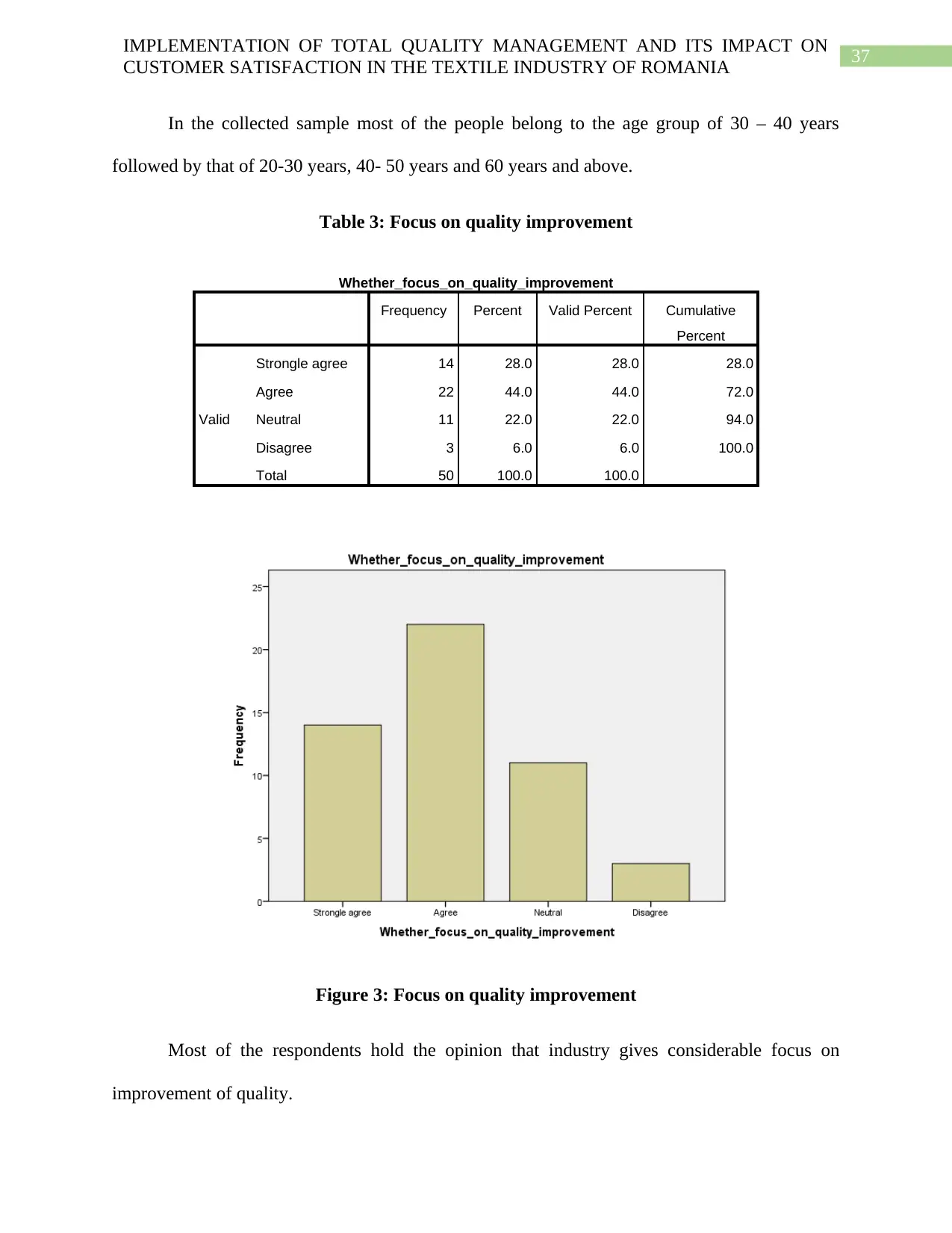
37
IMPLEMENTATION OF TOTAL QUALITY MANAGEMENT AND ITS IMPACT ON
CUSTOMER SATISFACTION IN THE TEXTILE INDUSTRY OF ROMANIA
In the collected sample most of the people belong to the age group of 30 – 40 years
followed by that of 20-30 years, 40- 50 years and 60 years and above.
Table 3: Focus on quality improvement
Whether_focus_on_quality_improvement
Frequency Percent Valid Percent Cumulative
Percent
Valid
Strongle agree 14 28.0 28.0 28.0
Agree 22 44.0 44.0 72.0
Neutral 11 22.0 22.0 94.0
Disagree 3 6.0 6.0 100.0
Total 50 100.0 100.0
Figure 3: Focus on quality improvement
Most of the respondents hold the opinion that industry gives considerable focus on
improvement of quality.
IMPLEMENTATION OF TOTAL QUALITY MANAGEMENT AND ITS IMPACT ON
CUSTOMER SATISFACTION IN THE TEXTILE INDUSTRY OF ROMANIA
In the collected sample most of the people belong to the age group of 30 – 40 years
followed by that of 20-30 years, 40- 50 years and 60 years and above.
Table 3: Focus on quality improvement
Whether_focus_on_quality_improvement
Frequency Percent Valid Percent Cumulative
Percent
Valid
Strongle agree 14 28.0 28.0 28.0
Agree 22 44.0 44.0 72.0
Neutral 11 22.0 22.0 94.0
Disagree 3 6.0 6.0 100.0
Total 50 100.0 100.0
Figure 3: Focus on quality improvement
Most of the respondents hold the opinion that industry gives considerable focus on
improvement of quality.
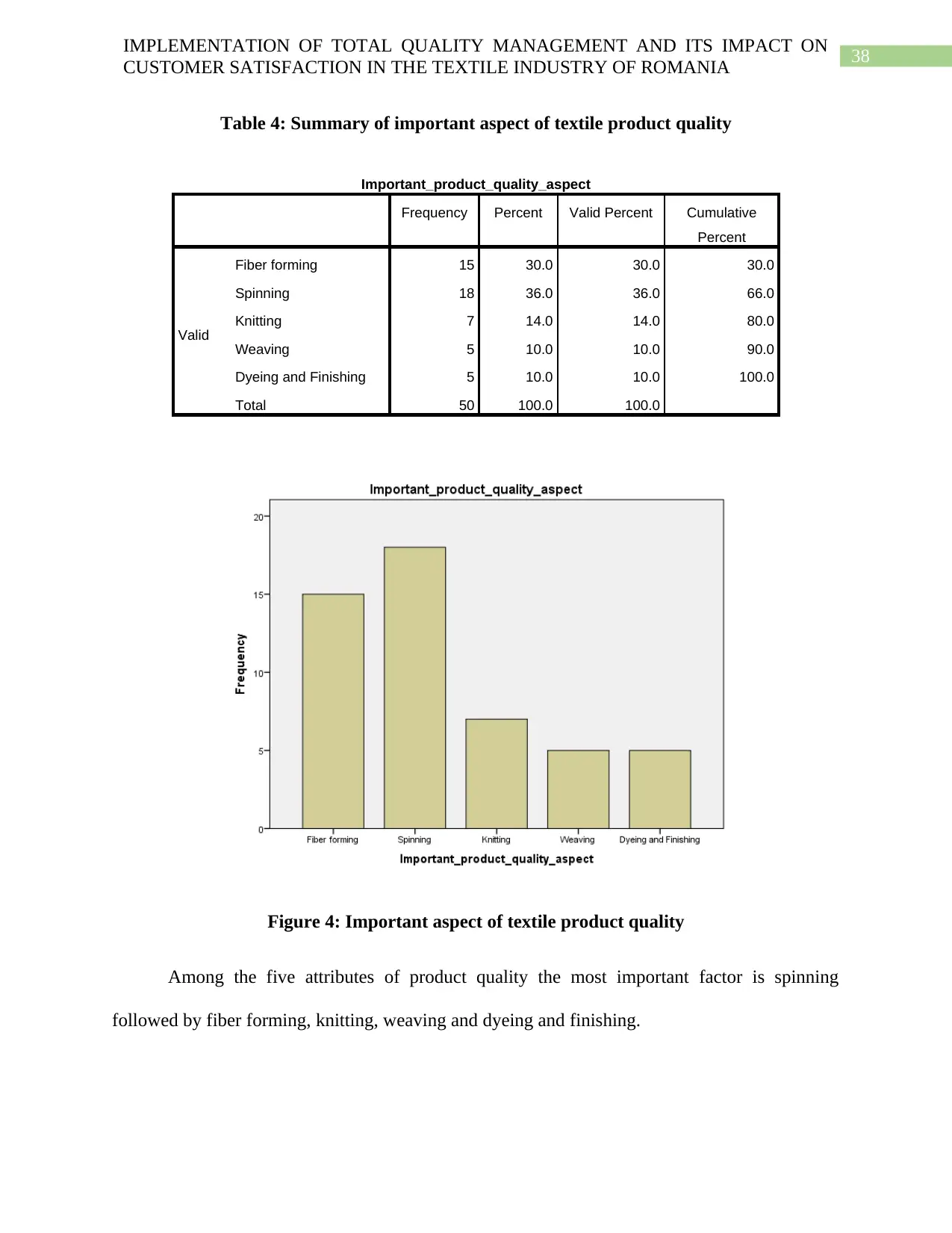
38
IMPLEMENTATION OF TOTAL QUALITY MANAGEMENT AND ITS IMPACT ON
CUSTOMER SATISFACTION IN THE TEXTILE INDUSTRY OF ROMANIA
Table 4: Summary of important aspect of textile product quality
Important_product_quality_aspect
Frequency Percent Valid Percent Cumulative
Percent
Valid
Fiber forming 15 30.0 30.0 30.0
Spinning 18 36.0 36.0 66.0
Knitting 7 14.0 14.0 80.0
Weaving 5 10.0 10.0 90.0
Dyeing and Finishing 5 10.0 10.0 100.0
Total 50 100.0 100.0
Figure 4: Important aspect of textile product quality
Among the five attributes of product quality the most important factor is spinning
followed by fiber forming, knitting, weaving and dyeing and finishing.
IMPLEMENTATION OF TOTAL QUALITY MANAGEMENT AND ITS IMPACT ON
CUSTOMER SATISFACTION IN THE TEXTILE INDUSTRY OF ROMANIA
Table 4: Summary of important aspect of textile product quality
Important_product_quality_aspect
Frequency Percent Valid Percent Cumulative
Percent
Valid
Fiber forming 15 30.0 30.0 30.0
Spinning 18 36.0 36.0 66.0
Knitting 7 14.0 14.0 80.0
Weaving 5 10.0 10.0 90.0
Dyeing and Finishing 5 10.0 10.0 100.0
Total 50 100.0 100.0
Figure 4: Important aspect of textile product quality
Among the five attributes of product quality the most important factor is spinning
followed by fiber forming, knitting, weaving and dyeing and finishing.
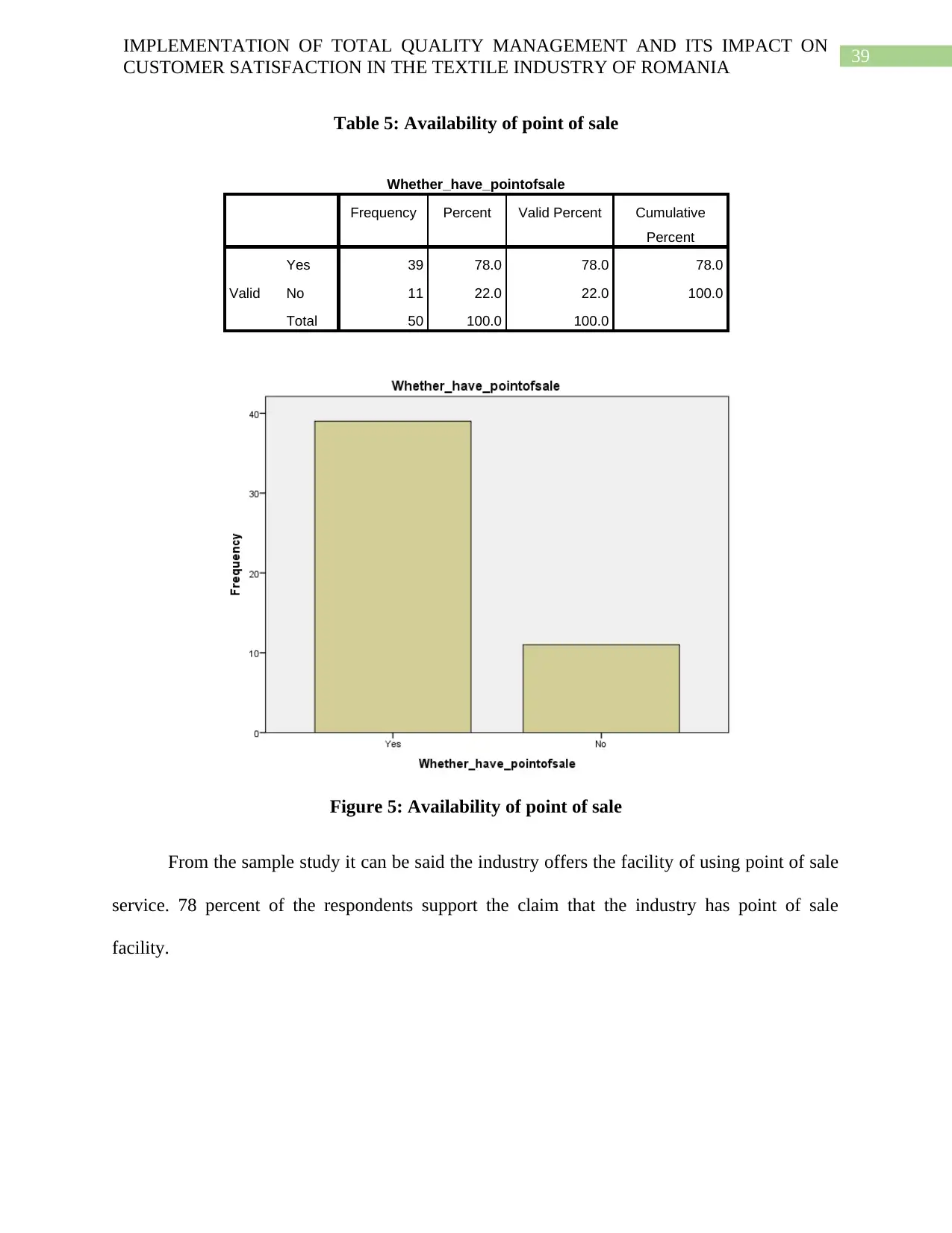
39
IMPLEMENTATION OF TOTAL QUALITY MANAGEMENT AND ITS IMPACT ON
CUSTOMER SATISFACTION IN THE TEXTILE INDUSTRY OF ROMANIA
Table 5: Availability of point of sale
Whether_have_pointofsale
Frequency Percent Valid Percent Cumulative
Percent
Valid
Yes 39 78.0 78.0 78.0
No 11 22.0 22.0 100.0
Total 50 100.0 100.0
Figure 5: Availability of point of sale
From the sample study it can be said the industry offers the facility of using point of sale
service. 78 percent of the respondents support the claim that the industry has point of sale
facility.
IMPLEMENTATION OF TOTAL QUALITY MANAGEMENT AND ITS IMPACT ON
CUSTOMER SATISFACTION IN THE TEXTILE INDUSTRY OF ROMANIA
Table 5: Availability of point of sale
Whether_have_pointofsale
Frequency Percent Valid Percent Cumulative
Percent
Valid
Yes 39 78.0 78.0 78.0
No 11 22.0 22.0 100.0
Total 50 100.0 100.0
Figure 5: Availability of point of sale
From the sample study it can be said the industry offers the facility of using point of sale
service. 78 percent of the respondents support the claim that the industry has point of sale
facility.
Secure Best Marks with AI Grader
Need help grading? Try our AI Grader for instant feedback on your assignments.
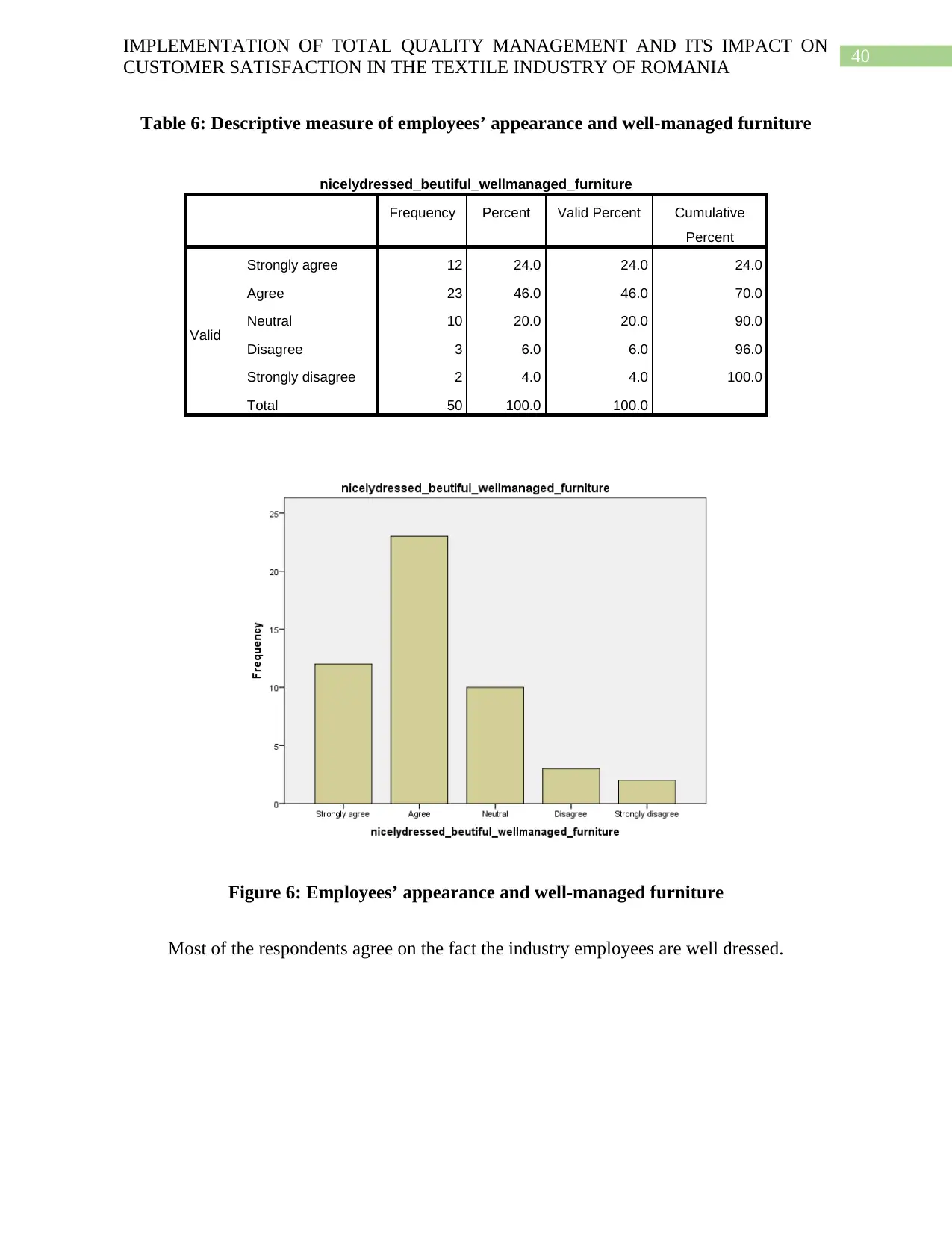
40
IMPLEMENTATION OF TOTAL QUALITY MANAGEMENT AND ITS IMPACT ON
CUSTOMER SATISFACTION IN THE TEXTILE INDUSTRY OF ROMANIA
Table 6: Descriptive measure of employees’ appearance and well-managed furniture
nicelydressed_beutiful_wellmanaged_furniture
Frequency Percent Valid Percent Cumulative
Percent
Valid
Strongly agree 12 24.0 24.0 24.0
Agree 23 46.0 46.0 70.0
Neutral 10 20.0 20.0 90.0
Disagree 3 6.0 6.0 96.0
Strongly disagree 2 4.0 4.0 100.0
Total 50 100.0 100.0
Figure 6: Employees’ appearance and well-managed furniture
Most of the respondents agree on the fact the industry employees are well dressed.
IMPLEMENTATION OF TOTAL QUALITY MANAGEMENT AND ITS IMPACT ON
CUSTOMER SATISFACTION IN THE TEXTILE INDUSTRY OF ROMANIA
Table 6: Descriptive measure of employees’ appearance and well-managed furniture
nicelydressed_beutiful_wellmanaged_furniture
Frequency Percent Valid Percent Cumulative
Percent
Valid
Strongly agree 12 24.0 24.0 24.0
Agree 23 46.0 46.0 70.0
Neutral 10 20.0 20.0 90.0
Disagree 3 6.0 6.0 96.0
Strongly disagree 2 4.0 4.0 100.0
Total 50 100.0 100.0
Figure 6: Employees’ appearance and well-managed furniture
Most of the respondents agree on the fact the industry employees are well dressed.
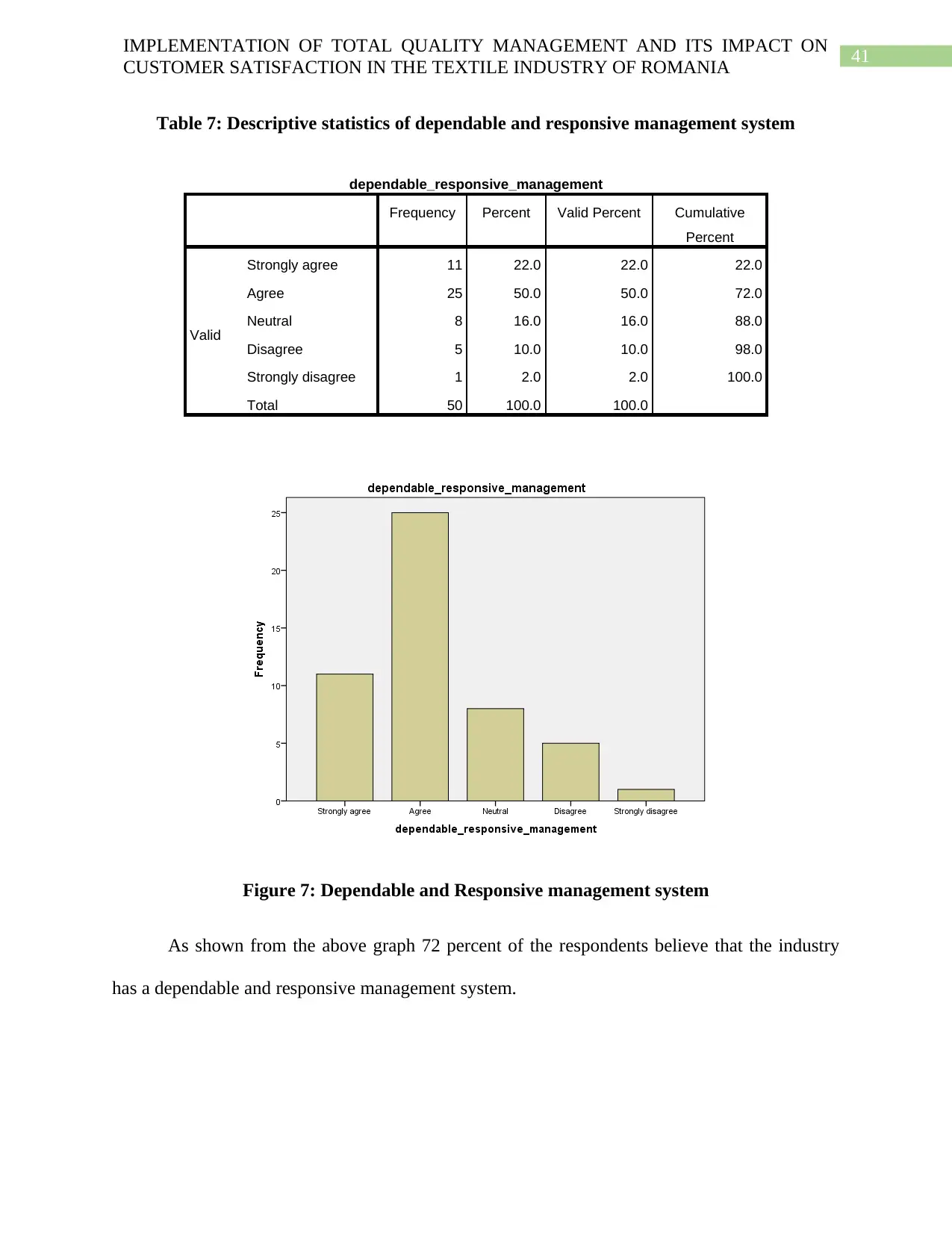
41
IMPLEMENTATION OF TOTAL QUALITY MANAGEMENT AND ITS IMPACT ON
CUSTOMER SATISFACTION IN THE TEXTILE INDUSTRY OF ROMANIA
Table 7: Descriptive statistics of dependable and responsive management system
dependable_responsive_management
Frequency Percent Valid Percent Cumulative
Percent
Valid
Strongly agree 11 22.0 22.0 22.0
Agree 25 50.0 50.0 72.0
Neutral 8 16.0 16.0 88.0
Disagree 5 10.0 10.0 98.0
Strongly disagree 1 2.0 2.0 100.0
Total 50 100.0 100.0
Figure 7: Dependable and Responsive management system
As shown from the above graph 72 percent of the respondents believe that the industry
has a dependable and responsive management system.
IMPLEMENTATION OF TOTAL QUALITY MANAGEMENT AND ITS IMPACT ON
CUSTOMER SATISFACTION IN THE TEXTILE INDUSTRY OF ROMANIA
Table 7: Descriptive statistics of dependable and responsive management system
dependable_responsive_management
Frequency Percent Valid Percent Cumulative
Percent
Valid
Strongly agree 11 22.0 22.0 22.0
Agree 25 50.0 50.0 72.0
Neutral 8 16.0 16.0 88.0
Disagree 5 10.0 10.0 98.0
Strongly disagree 1 2.0 2.0 100.0
Total 50 100.0 100.0
Figure 7: Dependable and Responsive management system
As shown from the above graph 72 percent of the respondents believe that the industry
has a dependable and responsive management system.
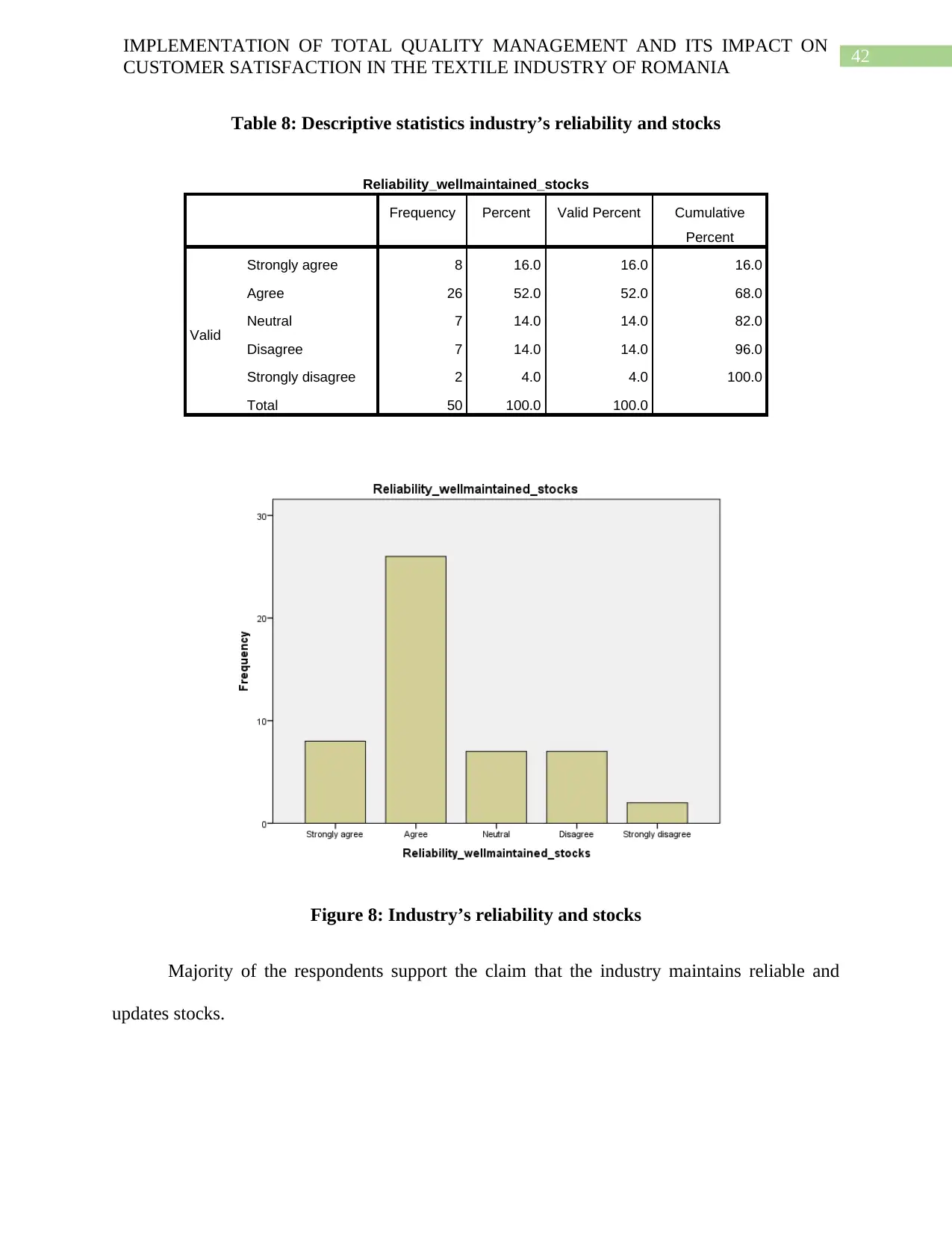
42
IMPLEMENTATION OF TOTAL QUALITY MANAGEMENT AND ITS IMPACT ON
CUSTOMER SATISFACTION IN THE TEXTILE INDUSTRY OF ROMANIA
Table 8: Descriptive statistics industry’s reliability and stocks
Reliability_wellmaintained_stocks
Frequency Percent Valid Percent Cumulative
Percent
Valid
Strongly agree 8 16.0 16.0 16.0
Agree 26 52.0 52.0 68.0
Neutral 7 14.0 14.0 82.0
Disagree 7 14.0 14.0 96.0
Strongly disagree 2 4.0 4.0 100.0
Total 50 100.0 100.0
Figure 8: Industry’s reliability and stocks
Majority of the respondents support the claim that the industry maintains reliable and
updates stocks.
IMPLEMENTATION OF TOTAL QUALITY MANAGEMENT AND ITS IMPACT ON
CUSTOMER SATISFACTION IN THE TEXTILE INDUSTRY OF ROMANIA
Table 8: Descriptive statistics industry’s reliability and stocks
Reliability_wellmaintained_stocks
Frequency Percent Valid Percent Cumulative
Percent
Valid
Strongly agree 8 16.0 16.0 16.0
Agree 26 52.0 52.0 68.0
Neutral 7 14.0 14.0 82.0
Disagree 7 14.0 14.0 96.0
Strongly disagree 2 4.0 4.0 100.0
Total 50 100.0 100.0
Figure 8: Industry’s reliability and stocks
Majority of the respondents support the claim that the industry maintains reliable and
updates stocks.
Paraphrase This Document
Need a fresh take? Get an instant paraphrase of this document with our AI Paraphraser
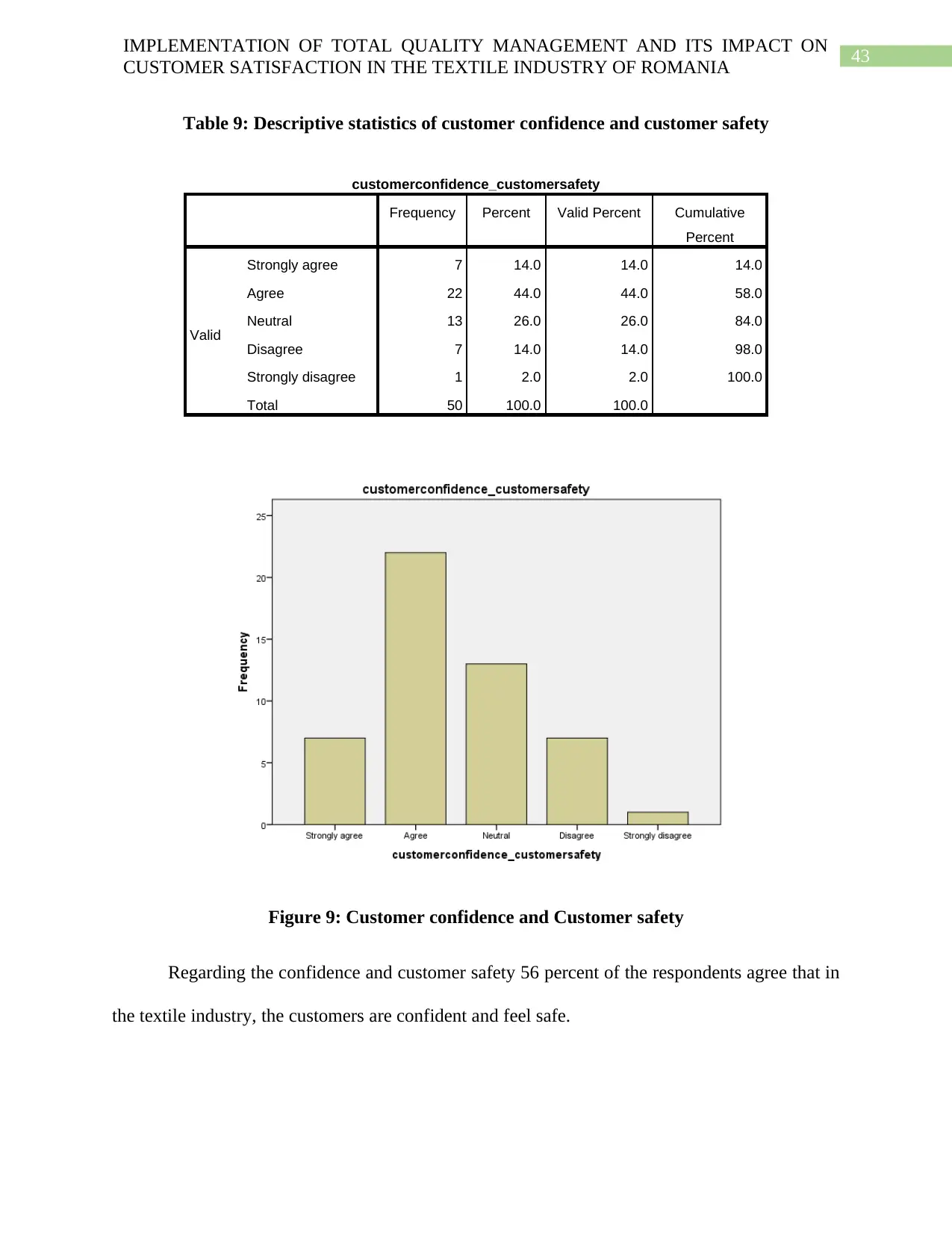
43
IMPLEMENTATION OF TOTAL QUALITY MANAGEMENT AND ITS IMPACT ON
CUSTOMER SATISFACTION IN THE TEXTILE INDUSTRY OF ROMANIA
Table 9: Descriptive statistics of customer confidence and customer safety
customerconfidence_customersafety
Frequency Percent Valid Percent Cumulative
Percent
Valid
Strongly agree 7 14.0 14.0 14.0
Agree 22 44.0 44.0 58.0
Neutral 13 26.0 26.0 84.0
Disagree 7 14.0 14.0 98.0
Strongly disagree 1 2.0 2.0 100.0
Total 50 100.0 100.0
Figure 9: Customer confidence and Customer safety
Regarding the confidence and customer safety 56 percent of the respondents agree that in
the textile industry, the customers are confident and feel safe.
IMPLEMENTATION OF TOTAL QUALITY MANAGEMENT AND ITS IMPACT ON
CUSTOMER SATISFACTION IN THE TEXTILE INDUSTRY OF ROMANIA
Table 9: Descriptive statistics of customer confidence and customer safety
customerconfidence_customersafety
Frequency Percent Valid Percent Cumulative
Percent
Valid
Strongly agree 7 14.0 14.0 14.0
Agree 22 44.0 44.0 58.0
Neutral 13 26.0 26.0 84.0
Disagree 7 14.0 14.0 98.0
Strongly disagree 1 2.0 2.0 100.0
Total 50 100.0 100.0
Figure 9: Customer confidence and Customer safety
Regarding the confidence and customer safety 56 percent of the respondents agree that in
the textile industry, the customers are confident and feel safe.
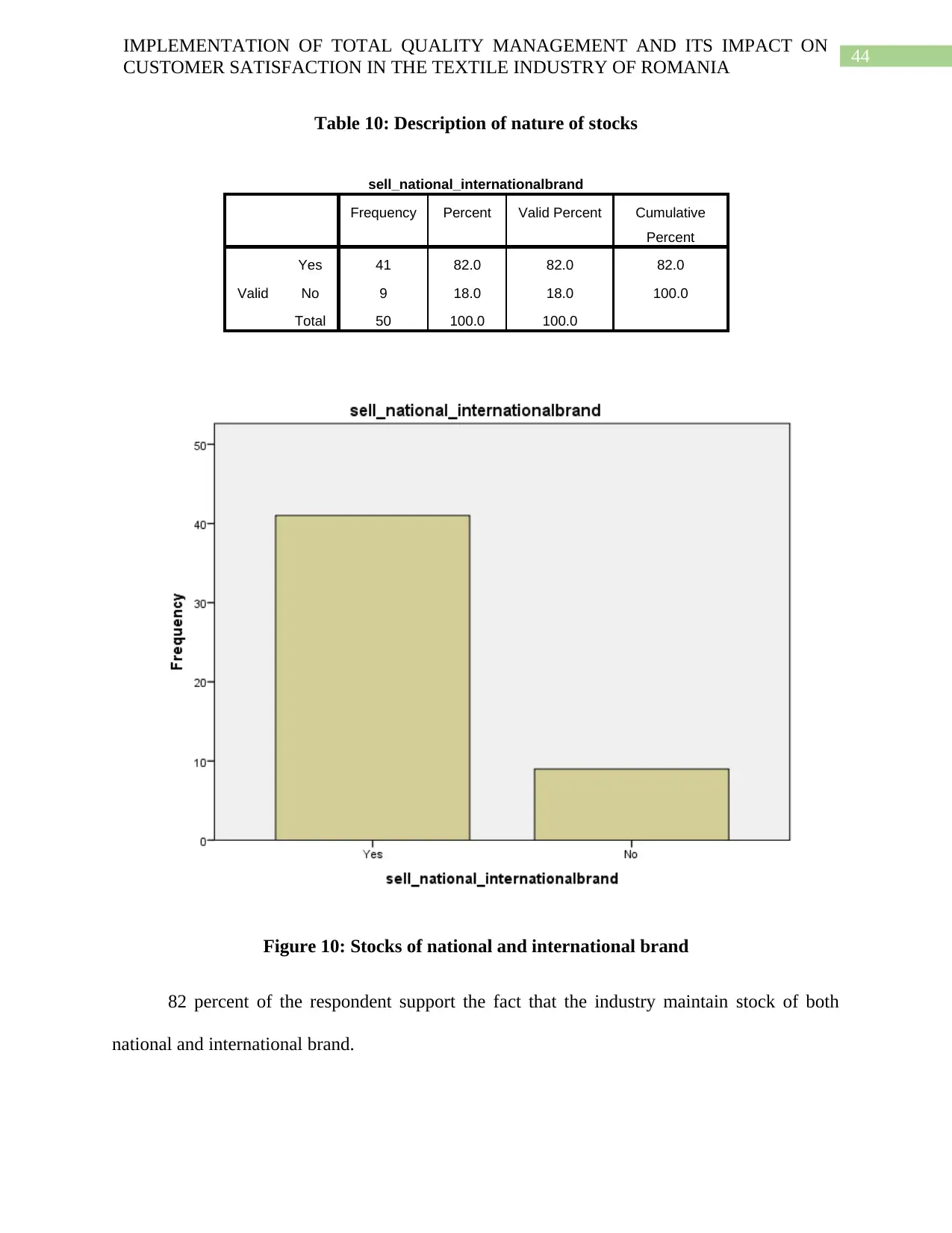
44
IMPLEMENTATION OF TOTAL QUALITY MANAGEMENT AND ITS IMPACT ON
CUSTOMER SATISFACTION IN THE TEXTILE INDUSTRY OF ROMANIA
Table 10: Description of nature of stocks
sell_national_internationalbrand
Frequency Percent Valid Percent Cumulative
Percent
Valid
Yes 41 82.0 82.0 82.0
No 9 18.0 18.0 100.0
Total 50 100.0 100.0
Figure 10: Stocks of national and international brand
82 percent of the respondent support the fact that the industry maintain stock of both
national and international brand.
IMPLEMENTATION OF TOTAL QUALITY MANAGEMENT AND ITS IMPACT ON
CUSTOMER SATISFACTION IN THE TEXTILE INDUSTRY OF ROMANIA
Table 10: Description of nature of stocks
sell_national_internationalbrand
Frequency Percent Valid Percent Cumulative
Percent
Valid
Yes 41 82.0 82.0 82.0
No 9 18.0 18.0 100.0
Total 50 100.0 100.0
Figure 10: Stocks of national and international brand
82 percent of the respondent support the fact that the industry maintain stock of both
national and international brand.
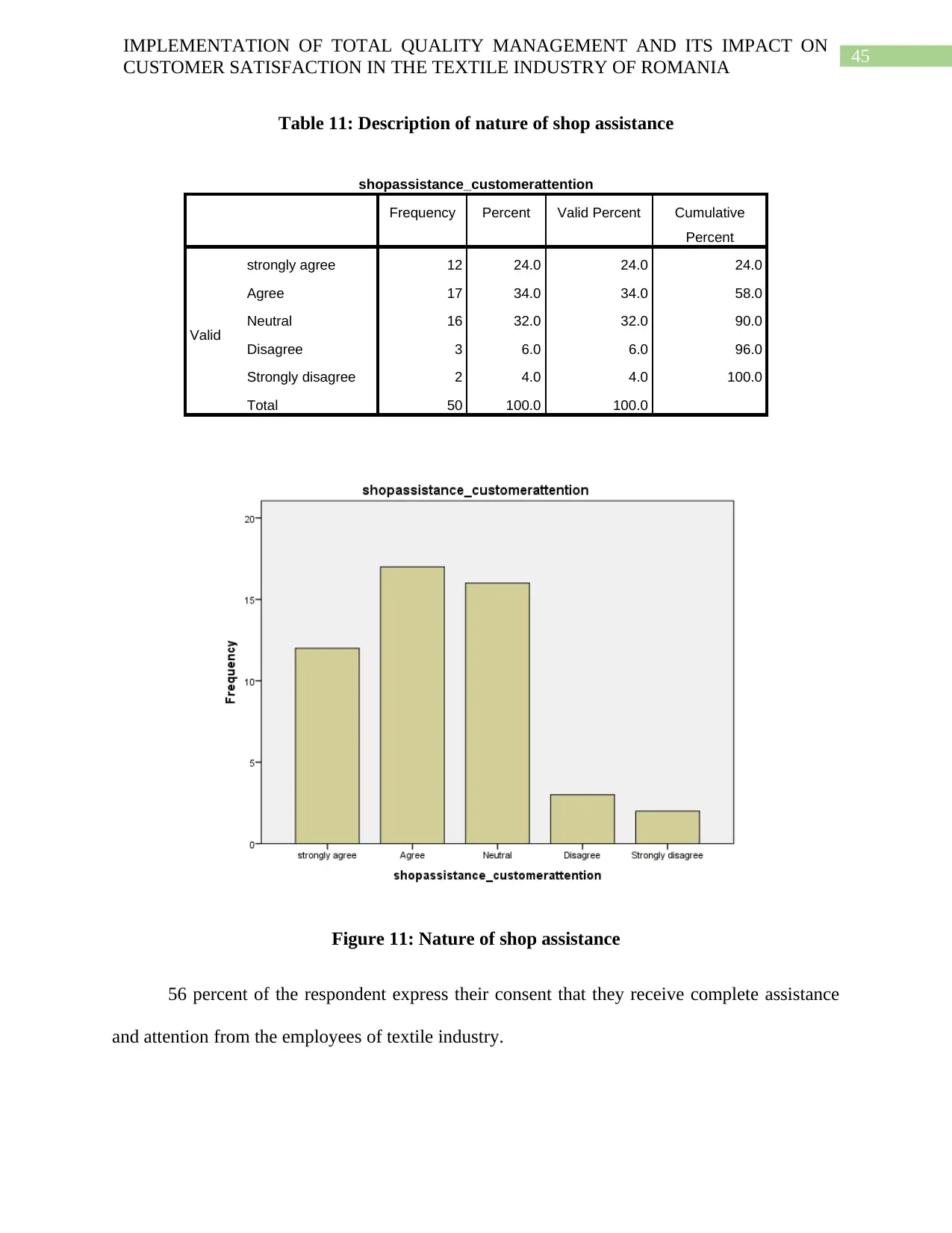
45
IMPLEMENTATION OF TOTAL QUALITY MANAGEMENT AND ITS IMPACT ON
CUSTOMER SATISFACTION IN THE TEXTILE INDUSTRY OF ROMANIA
Table 11: Description of nature of shop assistance
shopassistance_customerattention
Frequency Percent Valid Percent Cumulative
Percent
Valid
strongly agree 12 24.0 24.0 24.0
Agree 17 34.0 34.0 58.0
Neutral 16 32.0 32.0 90.0
Disagree 3 6.0 6.0 96.0
Strongly disagree 2 4.0 4.0 100.0
Total 50 100.0 100.0
Figure 11: Nature of shop assistance
56 percent of the respondent express their consent that they receive complete assistance
and attention from the employees of textile industry.
IMPLEMENTATION OF TOTAL QUALITY MANAGEMENT AND ITS IMPACT ON
CUSTOMER SATISFACTION IN THE TEXTILE INDUSTRY OF ROMANIA
Table 11: Description of nature of shop assistance
shopassistance_customerattention
Frequency Percent Valid Percent Cumulative
Percent
Valid
strongly agree 12 24.0 24.0 24.0
Agree 17 34.0 34.0 58.0
Neutral 16 32.0 32.0 90.0
Disagree 3 6.0 6.0 96.0
Strongly disagree 2 4.0 4.0 100.0
Total 50 100.0 100.0
Figure 11: Nature of shop assistance
56 percent of the respondent express their consent that they receive complete assistance
and attention from the employees of textile industry.
Secure Best Marks with AI Grader
Need help grading? Try our AI Grader for instant feedback on your assignments.
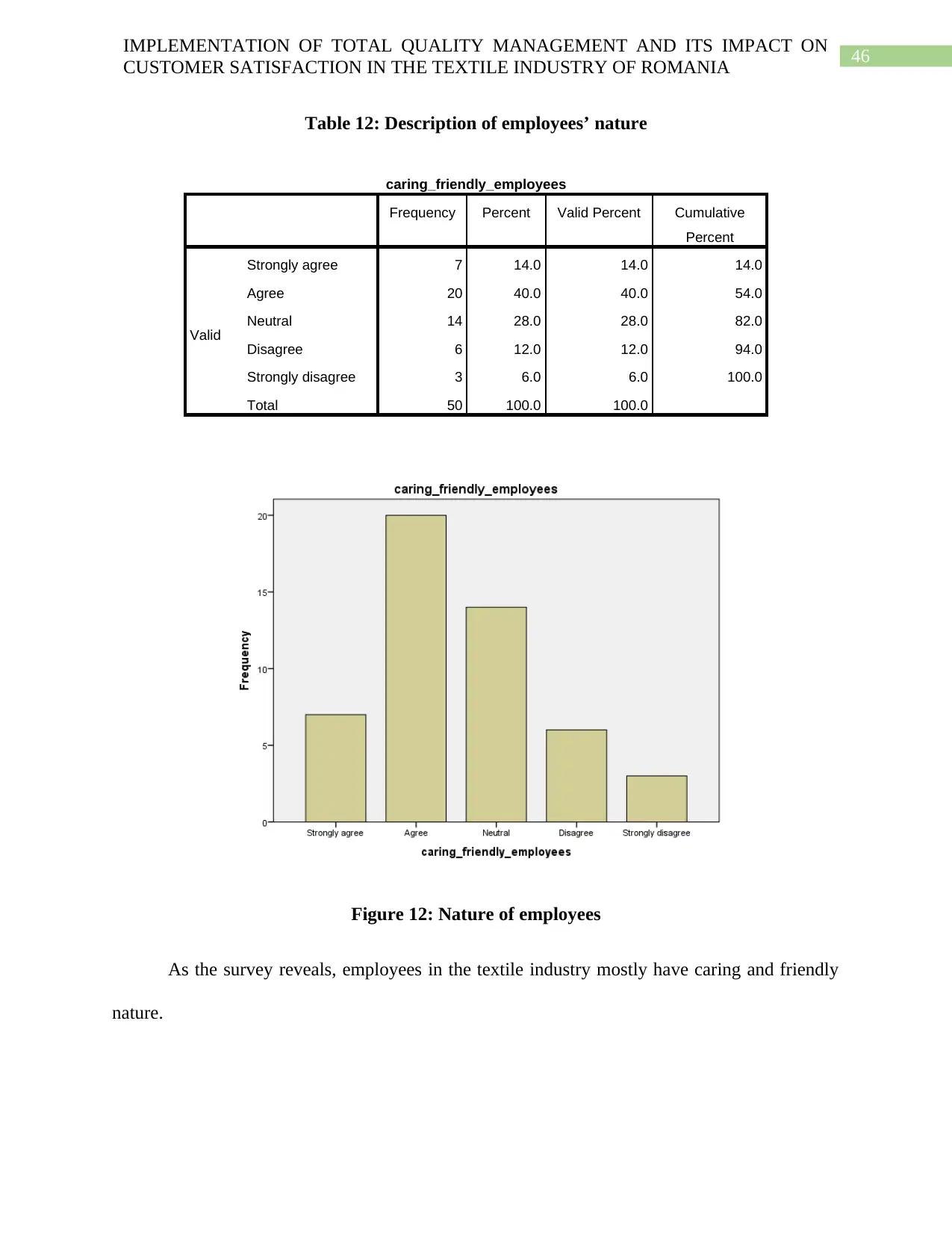
46
IMPLEMENTATION OF TOTAL QUALITY MANAGEMENT AND ITS IMPACT ON
CUSTOMER SATISFACTION IN THE TEXTILE INDUSTRY OF ROMANIA
Table 12: Description of employees’ nature
caring_friendly_employees
Frequency Percent Valid Percent Cumulative
Percent
Valid
Strongly agree 7 14.0 14.0 14.0
Agree 20 40.0 40.0 54.0
Neutral 14 28.0 28.0 82.0
Disagree 6 12.0 12.0 94.0
Strongly disagree 3 6.0 6.0 100.0
Total 50 100.0 100.0
Figure 12: Nature of employees
As the survey reveals, employees in the textile industry mostly have caring and friendly
nature.
IMPLEMENTATION OF TOTAL QUALITY MANAGEMENT AND ITS IMPACT ON
CUSTOMER SATISFACTION IN THE TEXTILE INDUSTRY OF ROMANIA
Table 12: Description of employees’ nature
caring_friendly_employees
Frequency Percent Valid Percent Cumulative
Percent
Valid
Strongly agree 7 14.0 14.0 14.0
Agree 20 40.0 40.0 54.0
Neutral 14 28.0 28.0 82.0
Disagree 6 12.0 12.0 94.0
Strongly disagree 3 6.0 6.0 100.0
Total 50 100.0 100.0
Figure 12: Nature of employees
As the survey reveals, employees in the textile industry mostly have caring and friendly
nature.
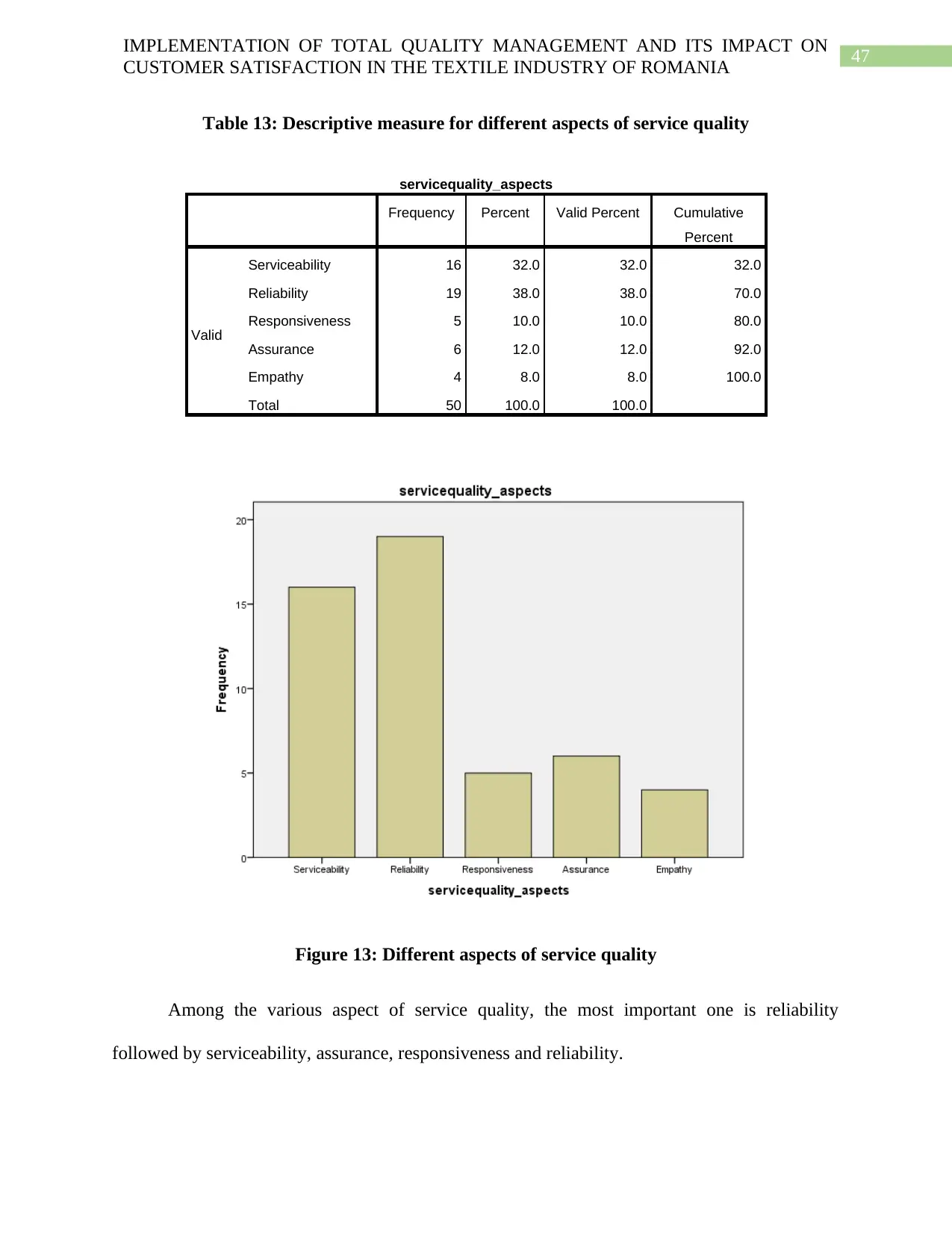
47
IMPLEMENTATION OF TOTAL QUALITY MANAGEMENT AND ITS IMPACT ON
CUSTOMER SATISFACTION IN THE TEXTILE INDUSTRY OF ROMANIA
Table 13: Descriptive measure for different aspects of service quality
servicequality_aspects
Frequency Percent Valid Percent Cumulative
Percent
Valid
Serviceability 16 32.0 32.0 32.0
Reliability 19 38.0 38.0 70.0
Responsiveness 5 10.0 10.0 80.0
Assurance 6 12.0 12.0 92.0
Empathy 4 8.0 8.0 100.0
Total 50 100.0 100.0
Figure 13: Different aspects of service quality
Among the various aspect of service quality, the most important one is reliability
followed by serviceability, assurance, responsiveness and reliability.
IMPLEMENTATION OF TOTAL QUALITY MANAGEMENT AND ITS IMPACT ON
CUSTOMER SATISFACTION IN THE TEXTILE INDUSTRY OF ROMANIA
Table 13: Descriptive measure for different aspects of service quality
servicequality_aspects
Frequency Percent Valid Percent Cumulative
Percent
Valid
Serviceability 16 32.0 32.0 32.0
Reliability 19 38.0 38.0 70.0
Responsiveness 5 10.0 10.0 80.0
Assurance 6 12.0 12.0 92.0
Empathy 4 8.0 8.0 100.0
Total 50 100.0 100.0
Figure 13: Different aspects of service quality
Among the various aspect of service quality, the most important one is reliability
followed by serviceability, assurance, responsiveness and reliability.
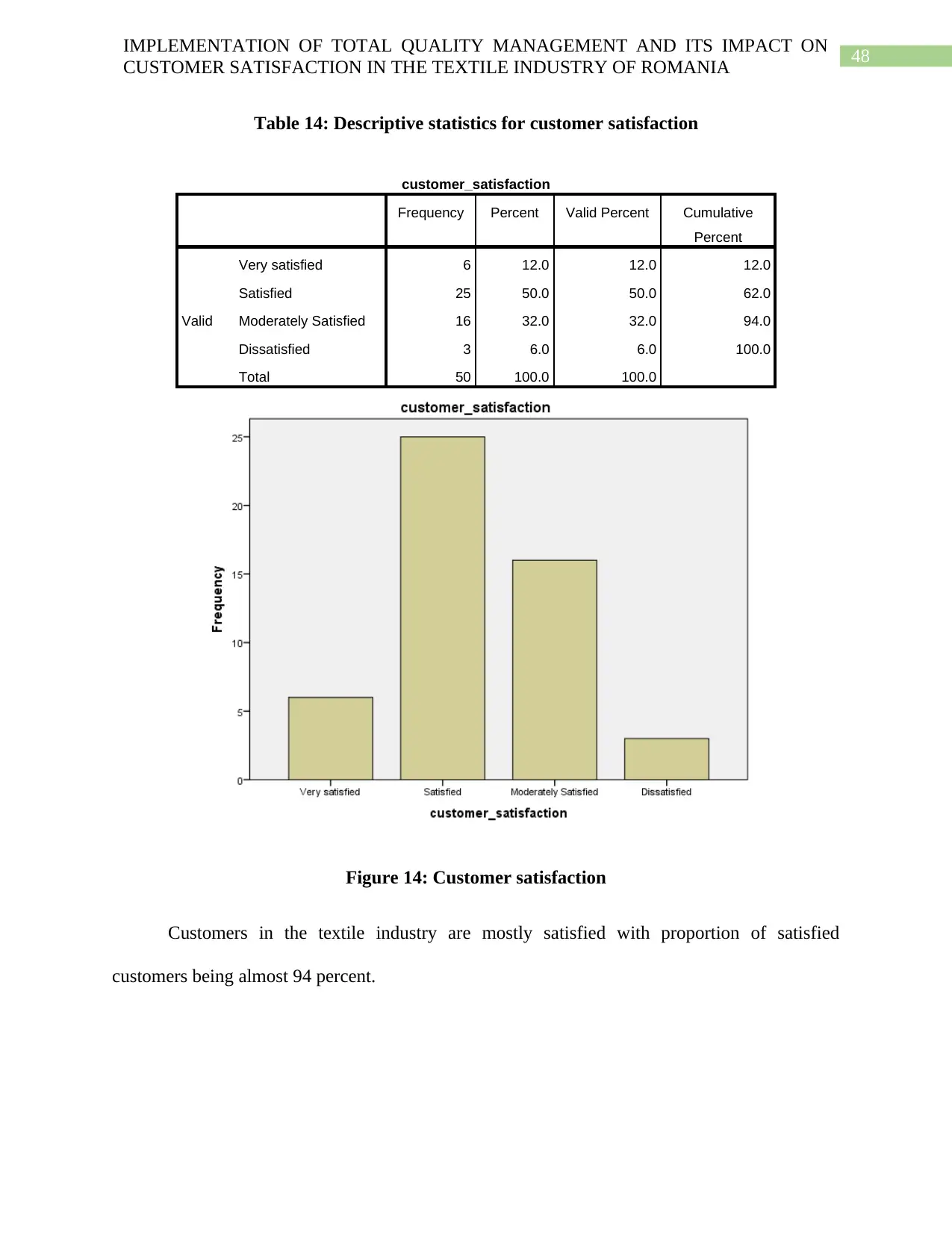
48
IMPLEMENTATION OF TOTAL QUALITY MANAGEMENT AND ITS IMPACT ON
CUSTOMER SATISFACTION IN THE TEXTILE INDUSTRY OF ROMANIA
Table 14: Descriptive statistics for customer satisfaction
customer_satisfaction
Frequency Percent Valid Percent Cumulative
Percent
Valid
Very satisfied 6 12.0 12.0 12.0
Satisfied 25 50.0 50.0 62.0
Moderately Satisfied 16 32.0 32.0 94.0
Dissatisfied 3 6.0 6.0 100.0
Total 50 100.0 100.0
Figure 14: Customer satisfaction
Customers in the textile industry are mostly satisfied with proportion of satisfied
customers being almost 94 percent.
IMPLEMENTATION OF TOTAL QUALITY MANAGEMENT AND ITS IMPACT ON
CUSTOMER SATISFACTION IN THE TEXTILE INDUSTRY OF ROMANIA
Table 14: Descriptive statistics for customer satisfaction
customer_satisfaction
Frequency Percent Valid Percent Cumulative
Percent
Valid
Very satisfied 6 12.0 12.0 12.0
Satisfied 25 50.0 50.0 62.0
Moderately Satisfied 16 32.0 32.0 94.0
Dissatisfied 3 6.0 6.0 100.0
Total 50 100.0 100.0
Figure 14: Customer satisfaction
Customers in the textile industry are mostly satisfied with proportion of satisfied
customers being almost 94 percent.
Paraphrase This Document
Need a fresh take? Get an instant paraphrase of this document with our AI Paraphraser
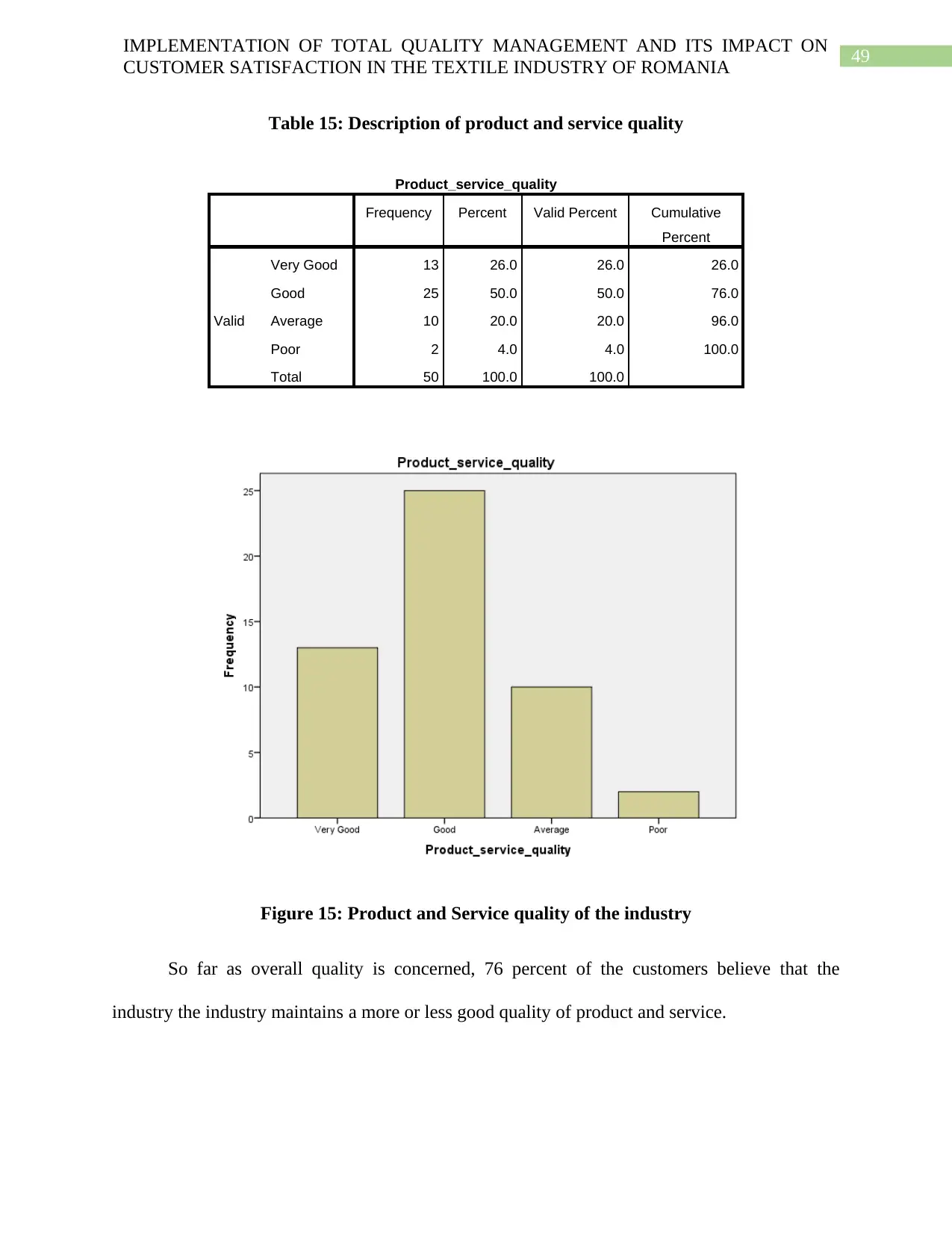
49
IMPLEMENTATION OF TOTAL QUALITY MANAGEMENT AND ITS IMPACT ON
CUSTOMER SATISFACTION IN THE TEXTILE INDUSTRY OF ROMANIA
Table 15: Description of product and service quality
Product_service_quality
Frequency Percent Valid Percent Cumulative
Percent
Valid
Very Good 13 26.0 26.0 26.0
Good 25 50.0 50.0 76.0
Average 10 20.0 20.0 96.0
Poor 2 4.0 4.0 100.0
Total 50 100.0 100.0
Figure 15: Product and Service quality of the industry
So far as overall quality is concerned, 76 percent of the customers believe that the
industry the industry maintains a more or less good quality of product and service.
IMPLEMENTATION OF TOTAL QUALITY MANAGEMENT AND ITS IMPACT ON
CUSTOMER SATISFACTION IN THE TEXTILE INDUSTRY OF ROMANIA
Table 15: Description of product and service quality
Product_service_quality
Frequency Percent Valid Percent Cumulative
Percent
Valid
Very Good 13 26.0 26.0 26.0
Good 25 50.0 50.0 76.0
Average 10 20.0 20.0 96.0
Poor 2 4.0 4.0 100.0
Total 50 100.0 100.0
Figure 15: Product and Service quality of the industry
So far as overall quality is concerned, 76 percent of the customers believe that the
industry the industry maintains a more or less good quality of product and service.

50
IMPLEMENTATION OF TOTAL QUALITY MANAGEMENT AND ITS IMPACT ON
CUSTOMER SATISFACTION IN THE TEXTILE INDUSTRY OF ROMANIA
4.2 Correlation analysis
The analysis of correlation coefficient estimates the degree of association between two or
more variables. A positive correlation indicates positive association between variables while a
negative correlation suggests an inverse association between variables (Fox 2015). Two sets of
correlation have been discussed. The first examines association between product and service
quality and that of quality management. The second examines association between customer
satisfaction and different aspects of product and service quality management.
Table 16: Correlation matrix for quality of product and management of quality
Correlations
Whether_focus_
on_quality_impro
vement
Important_produ
ct_quality_aspec
t
Product_service
_quality
servicequality_as
pects
Whether_focus_on_quality_i
mprovement
Pearson Correlation 1 .091 .176 -.015
Sig. (2-tailed) .529 .222 .920
N 50 50 50 50
Important_product_quality_as
pect
Pearson Correlation .091 1 .312* .209
Sig. (2-tailed) .529 .027 .146
N 50 50 50 50
Product_service_quality
Pearson Correlation .176 .312* 1 -.005
Sig. (2-tailed) .222 .027 .971
N 50 50 50 50
servicequality_aspects
Pearson Correlation -.015 .209 -.005 1
Sig. (2-tailed) .920 .146 .971
N 50 50 50 50
*. Correlation is significant at the 0.05 level (2-tailed).
As obtained from the above table, the correlation coefficient between overall quality of
product or service of the industry and that of thee focus on quality improvement is 0.22. The
positive correlation coefficient suggests that there is a positive association between the two
IMPLEMENTATION OF TOTAL QUALITY MANAGEMENT AND ITS IMPACT ON
CUSTOMER SATISFACTION IN THE TEXTILE INDUSTRY OF ROMANIA
4.2 Correlation analysis
The analysis of correlation coefficient estimates the degree of association between two or
more variables. A positive correlation indicates positive association between variables while a
negative correlation suggests an inverse association between variables (Fox 2015). Two sets of
correlation have been discussed. The first examines association between product and service
quality and that of quality management. The second examines association between customer
satisfaction and different aspects of product and service quality management.
Table 16: Correlation matrix for quality of product and management of quality
Correlations
Whether_focus_
on_quality_impro
vement
Important_produ
ct_quality_aspec
t
Product_service
_quality
servicequality_as
pects
Whether_focus_on_quality_i
mprovement
Pearson Correlation 1 .091 .176 -.015
Sig. (2-tailed) .529 .222 .920
N 50 50 50 50
Important_product_quality_as
pect
Pearson Correlation .091 1 .312* .209
Sig. (2-tailed) .529 .027 .146
N 50 50 50 50
Product_service_quality
Pearson Correlation .176 .312* 1 -.005
Sig. (2-tailed) .222 .027 .971
N 50 50 50 50
servicequality_aspects
Pearson Correlation -.015 .209 -.005 1
Sig. (2-tailed) .920 .146 .971
N 50 50 50 50
*. Correlation is significant at the 0.05 level (2-tailed).
As obtained from the above table, the correlation coefficient between overall quality of
product or service of the industry and that of thee focus on quality improvement is 0.22. The
positive correlation coefficient suggests that there is a positive association between the two
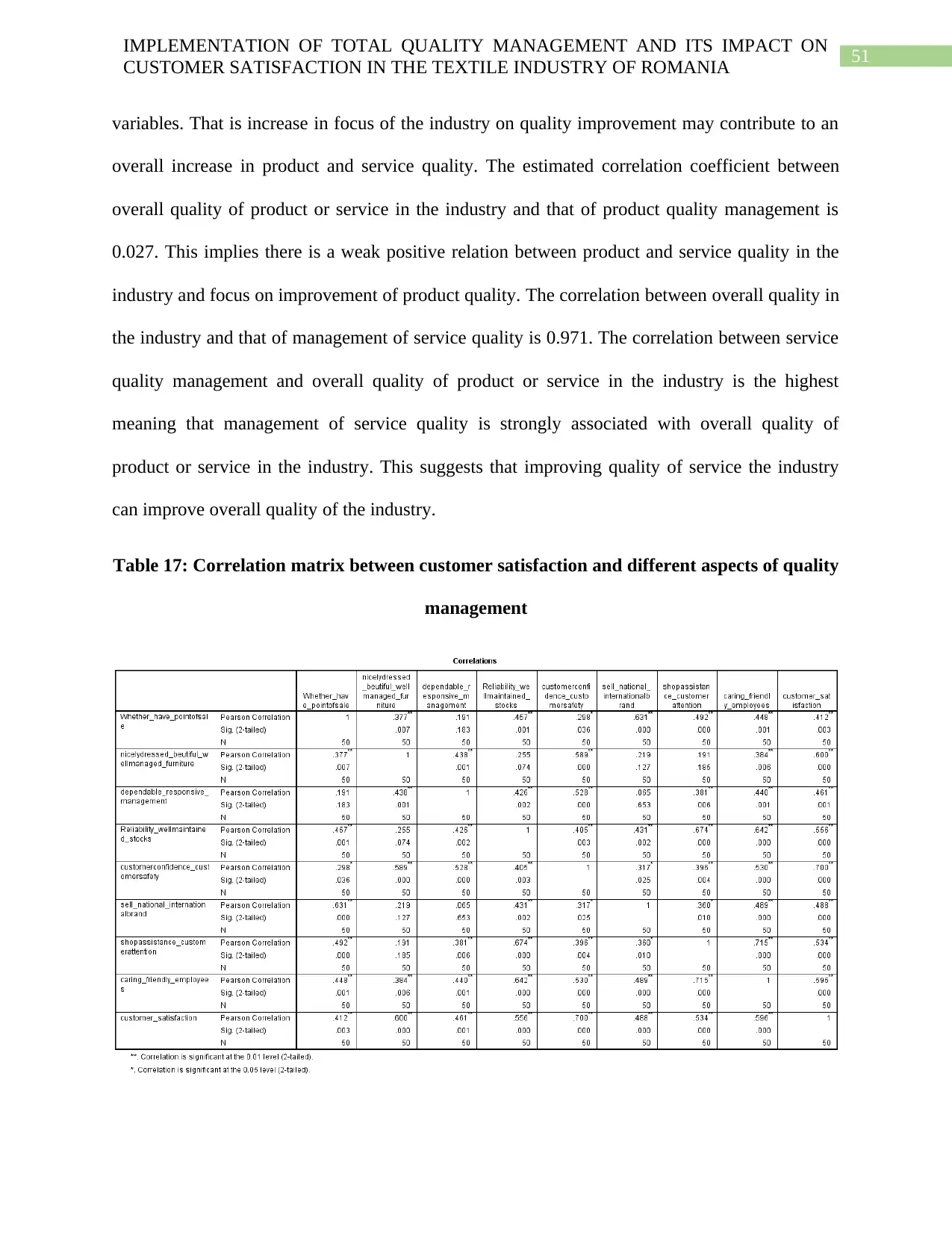
51
IMPLEMENTATION OF TOTAL QUALITY MANAGEMENT AND ITS IMPACT ON
CUSTOMER SATISFACTION IN THE TEXTILE INDUSTRY OF ROMANIA
variables. That is increase in focus of the industry on quality improvement may contribute to an
overall increase in product and service quality. The estimated correlation coefficient between
overall quality of product or service in the industry and that of product quality management is
0.027. This implies there is a weak positive relation between product and service quality in the
industry and focus on improvement of product quality. The correlation between overall quality in
the industry and that of management of service quality is 0.971. The correlation between service
quality management and overall quality of product or service in the industry is the highest
meaning that management of service quality is strongly associated with overall quality of
product or service in the industry. This suggests that improving quality of service the industry
can improve overall quality of the industry.
Table 17: Correlation matrix between customer satisfaction and different aspects of quality
management
IMPLEMENTATION OF TOTAL QUALITY MANAGEMENT AND ITS IMPACT ON
CUSTOMER SATISFACTION IN THE TEXTILE INDUSTRY OF ROMANIA
variables. That is increase in focus of the industry on quality improvement may contribute to an
overall increase in product and service quality. The estimated correlation coefficient between
overall quality of product or service in the industry and that of product quality management is
0.027. This implies there is a weak positive relation between product and service quality in the
industry and focus on improvement of product quality. The correlation between overall quality in
the industry and that of management of service quality is 0.971. The correlation between service
quality management and overall quality of product or service in the industry is the highest
meaning that management of service quality is strongly associated with overall quality of
product or service in the industry. This suggests that improving quality of service the industry
can improve overall quality of the industry.
Table 17: Correlation matrix between customer satisfaction and different aspects of quality
management
Secure Best Marks with AI Grader
Need help grading? Try our AI Grader for instant feedback on your assignments.
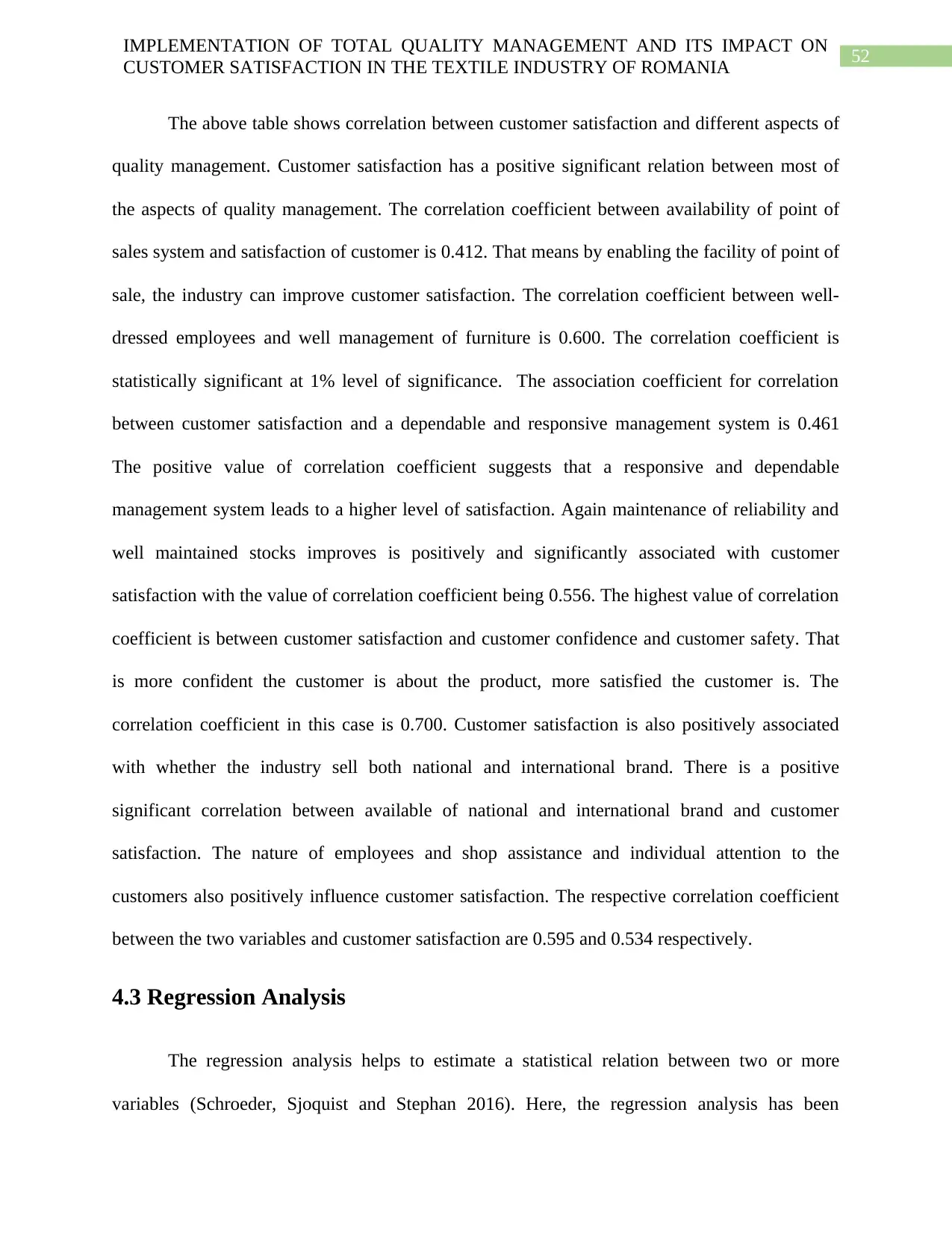
52
IMPLEMENTATION OF TOTAL QUALITY MANAGEMENT AND ITS IMPACT ON
CUSTOMER SATISFACTION IN THE TEXTILE INDUSTRY OF ROMANIA
The above table shows correlation between customer satisfaction and different aspects of
quality management. Customer satisfaction has a positive significant relation between most of
the aspects of quality management. The correlation coefficient between availability of point of
sales system and satisfaction of customer is 0.412. That means by enabling the facility of point of
sale, the industry can improve customer satisfaction. The correlation coefficient between well-
dressed employees and well management of furniture is 0.600. The correlation coefficient is
statistically significant at 1% level of significance. The association coefficient for correlation
between customer satisfaction and a dependable and responsive management system is 0.461
The positive value of correlation coefficient suggests that a responsive and dependable
management system leads to a higher level of satisfaction. Again maintenance of reliability and
well maintained stocks improves is positively and significantly associated with customer
satisfaction with the value of correlation coefficient being 0.556. The highest value of correlation
coefficient is between customer satisfaction and customer confidence and customer safety. That
is more confident the customer is about the product, more satisfied the customer is. The
correlation coefficient in this case is 0.700. Customer satisfaction is also positively associated
with whether the industry sell both national and international brand. There is a positive
significant correlation between available of national and international brand and customer
satisfaction. The nature of employees and shop assistance and individual attention to the
customers also positively influence customer satisfaction. The respective correlation coefficient
between the two variables and customer satisfaction are 0.595 and 0.534 respectively.
4.3 Regression Analysis
The regression analysis helps to estimate a statistical relation between two or more
variables (Schroeder, Sjoquist and Stephan 2016). Here, the regression analysis has been
IMPLEMENTATION OF TOTAL QUALITY MANAGEMENT AND ITS IMPACT ON
CUSTOMER SATISFACTION IN THE TEXTILE INDUSTRY OF ROMANIA
The above table shows correlation between customer satisfaction and different aspects of
quality management. Customer satisfaction has a positive significant relation between most of
the aspects of quality management. The correlation coefficient between availability of point of
sales system and satisfaction of customer is 0.412. That means by enabling the facility of point of
sale, the industry can improve customer satisfaction. The correlation coefficient between well-
dressed employees and well management of furniture is 0.600. The correlation coefficient is
statistically significant at 1% level of significance. The association coefficient for correlation
between customer satisfaction and a dependable and responsive management system is 0.461
The positive value of correlation coefficient suggests that a responsive and dependable
management system leads to a higher level of satisfaction. Again maintenance of reliability and
well maintained stocks improves is positively and significantly associated with customer
satisfaction with the value of correlation coefficient being 0.556. The highest value of correlation
coefficient is between customer satisfaction and customer confidence and customer safety. That
is more confident the customer is about the product, more satisfied the customer is. The
correlation coefficient in this case is 0.700. Customer satisfaction is also positively associated
with whether the industry sell both national and international brand. There is a positive
significant correlation between available of national and international brand and customer
satisfaction. The nature of employees and shop assistance and individual attention to the
customers also positively influence customer satisfaction. The respective correlation coefficient
between the two variables and customer satisfaction are 0.595 and 0.534 respectively.
4.3 Regression Analysis
The regression analysis helps to estimate a statistical relation between two or more
variables (Schroeder, Sjoquist and Stephan 2016). Here, the regression analysis has been
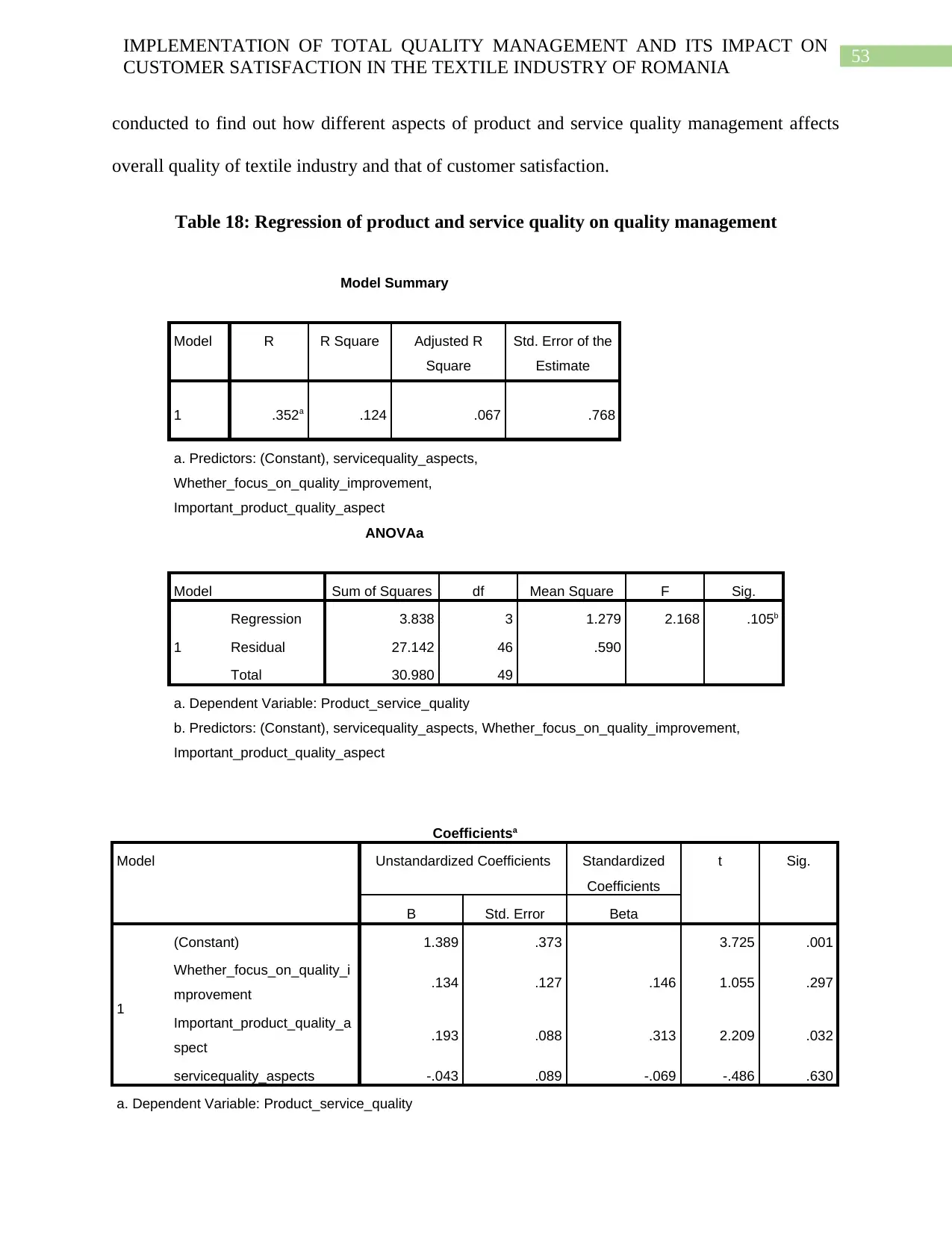
53
IMPLEMENTATION OF TOTAL QUALITY MANAGEMENT AND ITS IMPACT ON
CUSTOMER SATISFACTION IN THE TEXTILE INDUSTRY OF ROMANIA
conducted to find out how different aspects of product and service quality management affects
overall quality of textile industry and that of customer satisfaction.
Table 18: Regression of product and service quality on quality management
Model Summary
Model R R Square Adjusted R
Square
Std. Error of the
Estimate
1 .352a .124 .067 .768
a. Predictors: (Constant), servicequality_aspects,
Whether_focus_on_quality_improvement,
Important_product_quality_aspect
ANOVAa
Model Sum of Squares df Mean Square F Sig.
1
Regression 3.838 3 1.279 2.168 .105b
Residual 27.142 46 .590
Total 30.980 49
a. Dependent Variable: Product_service_quality
b. Predictors: (Constant), servicequality_aspects, Whether_focus_on_quality_improvement,
Important_product_quality_aspect
Coefficientsa
Model Unstandardized Coefficients Standardized
Coefficients
t Sig.
B Std. Error Beta
1
(Constant) 1.389 .373 3.725 .001
Whether_focus_on_quality_i
mprovement .134 .127 .146 1.055 .297
Important_product_quality_a
spect .193 .088 .313 2.209 .032
servicequality_aspects -.043 .089 -.069 -.486 .630
a. Dependent Variable: Product_service_quality
IMPLEMENTATION OF TOTAL QUALITY MANAGEMENT AND ITS IMPACT ON
CUSTOMER SATISFACTION IN THE TEXTILE INDUSTRY OF ROMANIA
conducted to find out how different aspects of product and service quality management affects
overall quality of textile industry and that of customer satisfaction.
Table 18: Regression of product and service quality on quality management
Model Summary
Model R R Square Adjusted R
Square
Std. Error of the
Estimate
1 .352a .124 .067 .768
a. Predictors: (Constant), servicequality_aspects,
Whether_focus_on_quality_improvement,
Important_product_quality_aspect
ANOVAa
Model Sum of Squares df Mean Square F Sig.
1
Regression 3.838 3 1.279 2.168 .105b
Residual 27.142 46 .590
Total 30.980 49
a. Dependent Variable: Product_service_quality
b. Predictors: (Constant), servicequality_aspects, Whether_focus_on_quality_improvement,
Important_product_quality_aspect
Coefficientsa
Model Unstandardized Coefficients Standardized
Coefficients
t Sig.
B Std. Error Beta
1
(Constant) 1.389 .373 3.725 .001
Whether_focus_on_quality_i
mprovement .134 .127 .146 1.055 .297
Important_product_quality_a
spect .193 .088 .313 2.209 .032
servicequality_aspects -.043 .089 -.069 -.486 .630
a. Dependent Variable: Product_service_quality
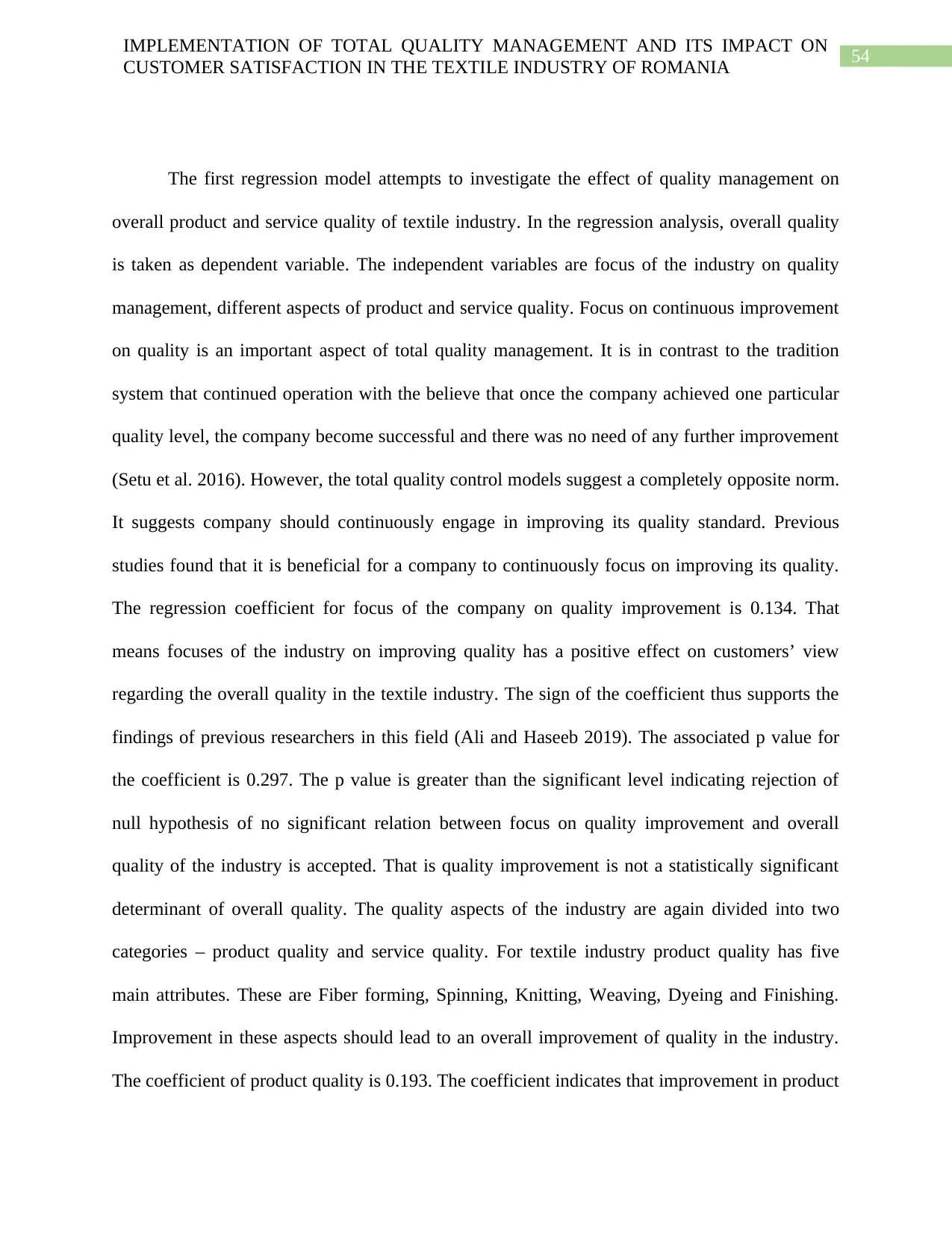
54
IMPLEMENTATION OF TOTAL QUALITY MANAGEMENT AND ITS IMPACT ON
CUSTOMER SATISFACTION IN THE TEXTILE INDUSTRY OF ROMANIA
The first regression model attempts to investigate the effect of quality management on
overall product and service quality of textile industry. In the regression analysis, overall quality
is taken as dependent variable. The independent variables are focus of the industry on quality
management, different aspects of product and service quality. Focus on continuous improvement
on quality is an important aspect of total quality management. It is in contrast to the tradition
system that continued operation with the believe that once the company achieved one particular
quality level, the company become successful and there was no need of any further improvement
(Setu et al. 2016). However, the total quality control models suggest a completely opposite norm.
It suggests company should continuously engage in improving its quality standard. Previous
studies found that it is beneficial for a company to continuously focus on improving its quality.
The regression coefficient for focus of the company on quality improvement is 0.134. That
means focuses of the industry on improving quality has a positive effect on customers’ view
regarding the overall quality in the textile industry. The sign of the coefficient thus supports the
findings of previous researchers in this field (Ali and Haseeb 2019). The associated p value for
the coefficient is 0.297. The p value is greater than the significant level indicating rejection of
null hypothesis of no significant relation between focus on quality improvement and overall
quality of the industry is accepted. That is quality improvement is not a statistically significant
determinant of overall quality. The quality aspects of the industry are again divided into two
categories – product quality and service quality. For textile industry product quality has five
main attributes. These are Fiber forming, Spinning, Knitting, Weaving, Dyeing and Finishing.
Improvement in these aspects should lead to an overall improvement of quality in the industry.
The coefficient of product quality is 0.193. The coefficient indicates that improvement in product
IMPLEMENTATION OF TOTAL QUALITY MANAGEMENT AND ITS IMPACT ON
CUSTOMER SATISFACTION IN THE TEXTILE INDUSTRY OF ROMANIA
The first regression model attempts to investigate the effect of quality management on
overall product and service quality of textile industry. In the regression analysis, overall quality
is taken as dependent variable. The independent variables are focus of the industry on quality
management, different aspects of product and service quality. Focus on continuous improvement
on quality is an important aspect of total quality management. It is in contrast to the tradition
system that continued operation with the believe that once the company achieved one particular
quality level, the company become successful and there was no need of any further improvement
(Setu et al. 2016). However, the total quality control models suggest a completely opposite norm.
It suggests company should continuously engage in improving its quality standard. Previous
studies found that it is beneficial for a company to continuously focus on improving its quality.
The regression coefficient for focus of the company on quality improvement is 0.134. That
means focuses of the industry on improving quality has a positive effect on customers’ view
regarding the overall quality in the textile industry. The sign of the coefficient thus supports the
findings of previous researchers in this field (Ali and Haseeb 2019). The associated p value for
the coefficient is 0.297. The p value is greater than the significant level indicating rejection of
null hypothesis of no significant relation between focus on quality improvement and overall
quality of the industry is accepted. That is quality improvement is not a statistically significant
determinant of overall quality. The quality aspects of the industry are again divided into two
categories – product quality and service quality. For textile industry product quality has five
main attributes. These are Fiber forming, Spinning, Knitting, Weaving, Dyeing and Finishing.
Improvement in these aspects should lead to an overall improvement of quality in the industry.
The coefficient of product quality is 0.193. The coefficient indicates that improvement in product
Paraphrase This Document
Need a fresh take? Get an instant paraphrase of this document with our AI Paraphraser
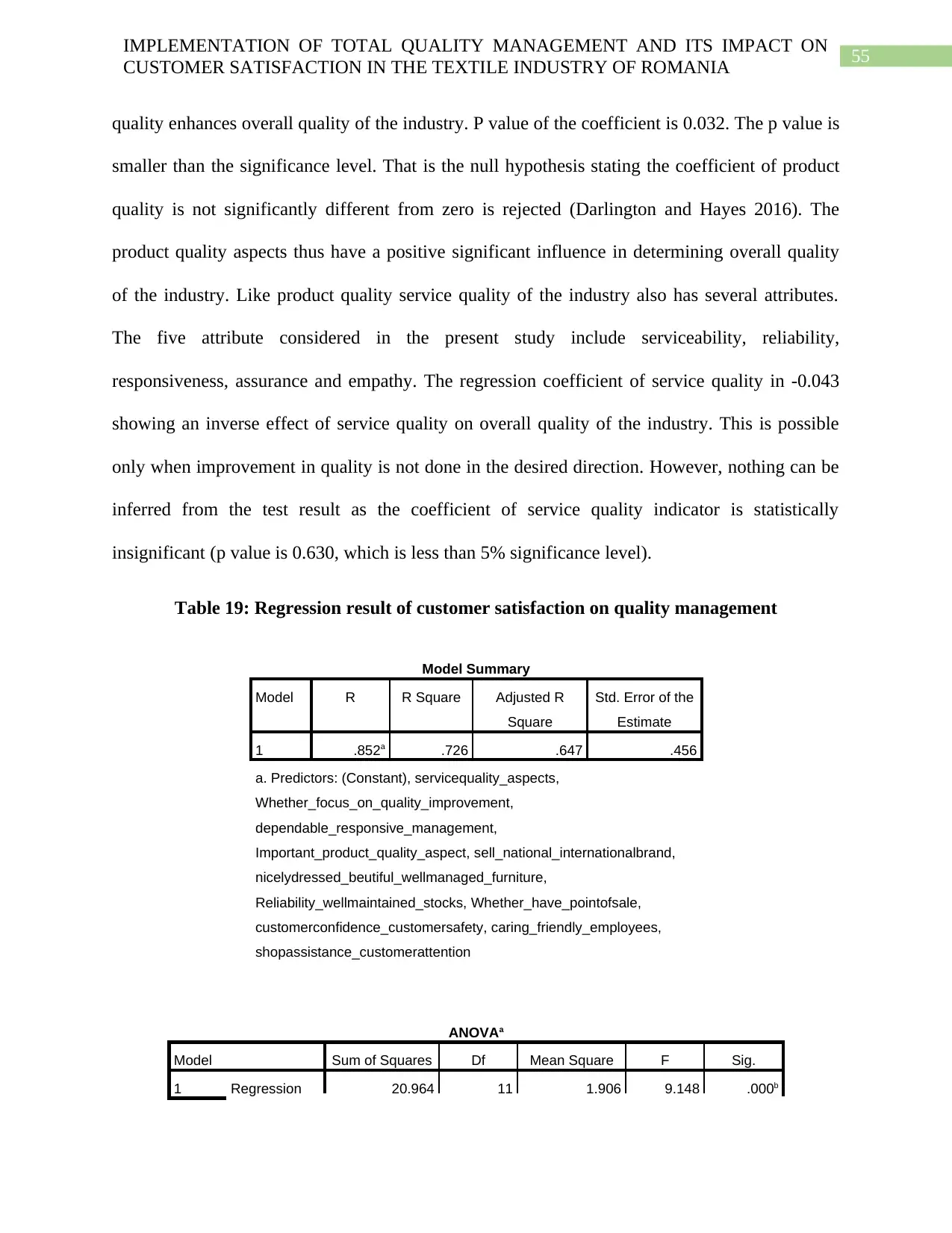
55
IMPLEMENTATION OF TOTAL QUALITY MANAGEMENT AND ITS IMPACT ON
CUSTOMER SATISFACTION IN THE TEXTILE INDUSTRY OF ROMANIA
quality enhances overall quality of the industry. P value of the coefficient is 0.032. The p value is
smaller than the significance level. That is the null hypothesis stating the coefficient of product
quality is not significantly different from zero is rejected (Darlington and Hayes 2016). The
product quality aspects thus have a positive significant influence in determining overall quality
of the industry. Like product quality service quality of the industry also has several attributes.
The five attribute considered in the present study include serviceability, reliability,
responsiveness, assurance and empathy. The regression coefficient of service quality in -0.043
showing an inverse effect of service quality on overall quality of the industry. This is possible
only when improvement in quality is not done in the desired direction. However, nothing can be
inferred from the test result as the coefficient of service quality indicator is statistically
insignificant (p value is 0.630, which is less than 5% significance level).
Table 19: Regression result of customer satisfaction on quality management
Model Summary
Model R R Square Adjusted R
Square
Std. Error of the
Estimate
1 .852a .726 .647 .456
a. Predictors: (Constant), servicequality_aspects,
Whether_focus_on_quality_improvement,
dependable_responsive_management,
Important_product_quality_aspect, sell_national_internationalbrand,
nicelydressed_beutiful_wellmanaged_furniture,
Reliability_wellmaintained_stocks, Whether_have_pointofsale,
customerconfidence_customersafety, caring_friendly_employees,
shopassistance_customerattention
ANOVAa
Model Sum of Squares Df Mean Square F Sig.
1 Regression 20.964 11 1.906 9.148 .000b
IMPLEMENTATION OF TOTAL QUALITY MANAGEMENT AND ITS IMPACT ON
CUSTOMER SATISFACTION IN THE TEXTILE INDUSTRY OF ROMANIA
quality enhances overall quality of the industry. P value of the coefficient is 0.032. The p value is
smaller than the significance level. That is the null hypothesis stating the coefficient of product
quality is not significantly different from zero is rejected (Darlington and Hayes 2016). The
product quality aspects thus have a positive significant influence in determining overall quality
of the industry. Like product quality service quality of the industry also has several attributes.
The five attribute considered in the present study include serviceability, reliability,
responsiveness, assurance and empathy. The regression coefficient of service quality in -0.043
showing an inverse effect of service quality on overall quality of the industry. This is possible
only when improvement in quality is not done in the desired direction. However, nothing can be
inferred from the test result as the coefficient of service quality indicator is statistically
insignificant (p value is 0.630, which is less than 5% significance level).
Table 19: Regression result of customer satisfaction on quality management
Model Summary
Model R R Square Adjusted R
Square
Std. Error of the
Estimate
1 .852a .726 .647 .456
a. Predictors: (Constant), servicequality_aspects,
Whether_focus_on_quality_improvement,
dependable_responsive_management,
Important_product_quality_aspect, sell_national_internationalbrand,
nicelydressed_beutiful_wellmanaged_furniture,
Reliability_wellmaintained_stocks, Whether_have_pointofsale,
customerconfidence_customersafety, caring_friendly_employees,
shopassistance_customerattention
ANOVAa
Model Sum of Squares Df Mean Square F Sig.
1 Regression 20.964 11 1.906 9.148 .000b
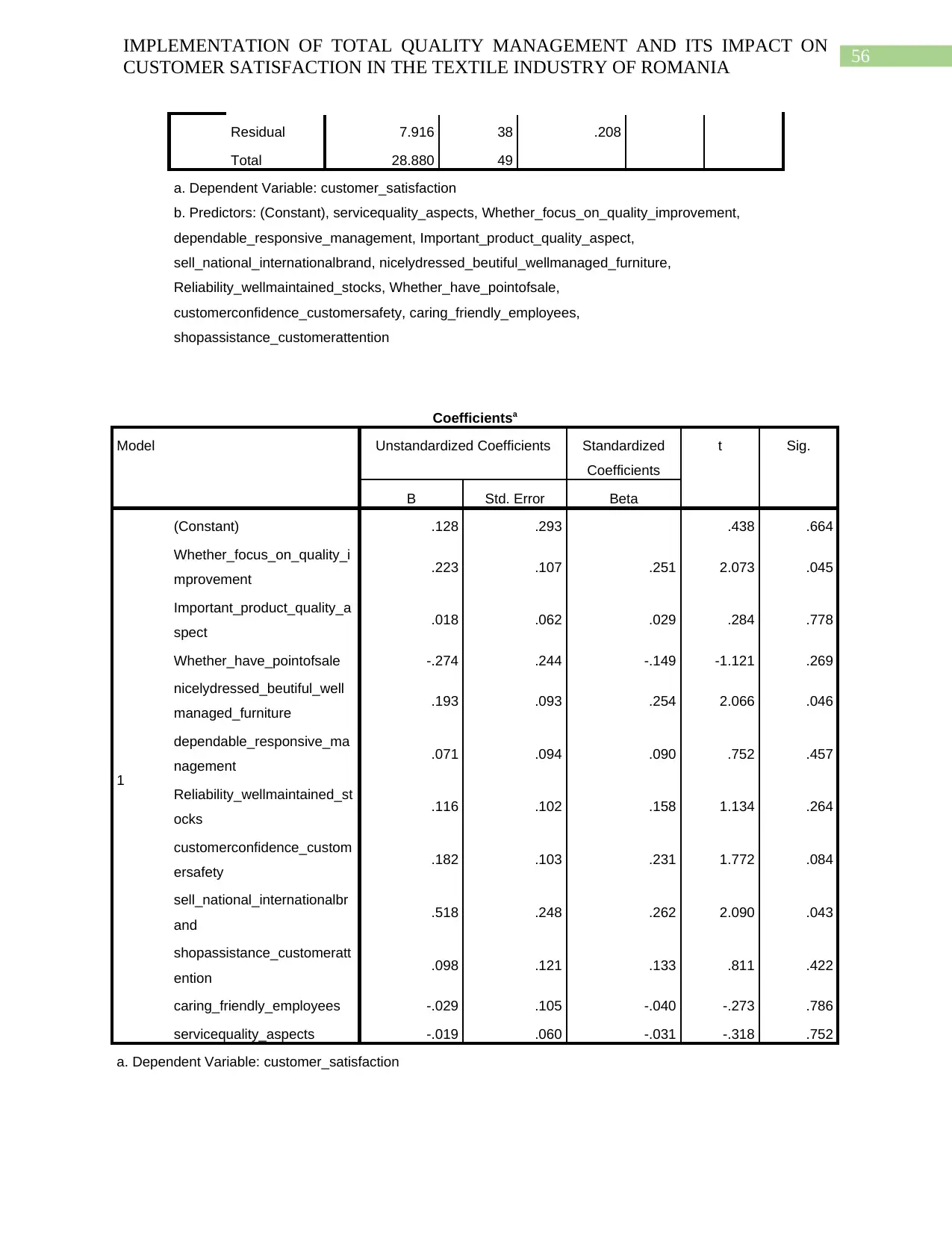
56
IMPLEMENTATION OF TOTAL QUALITY MANAGEMENT AND ITS IMPACT ON
CUSTOMER SATISFACTION IN THE TEXTILE INDUSTRY OF ROMANIA
Residual 7.916 38 .208
Total 28.880 49
a. Dependent Variable: customer_satisfaction
b. Predictors: (Constant), servicequality_aspects, Whether_focus_on_quality_improvement,
dependable_responsive_management, Important_product_quality_aspect,
sell_national_internationalbrand, nicelydressed_beutiful_wellmanaged_furniture,
Reliability_wellmaintained_stocks, Whether_have_pointofsale,
customerconfidence_customersafety, caring_friendly_employees,
shopassistance_customerattention
Coefficientsa
Model Unstandardized Coefficients Standardized
Coefficients
t Sig.
B Std. Error Beta
1
(Constant) .128 .293 .438 .664
Whether_focus_on_quality_i
mprovement .223 .107 .251 2.073 .045
Important_product_quality_a
spect .018 .062 .029 .284 .778
Whether_have_pointofsale -.274 .244 -.149 -1.121 .269
nicelydressed_beutiful_well
managed_furniture .193 .093 .254 2.066 .046
dependable_responsive_ma
nagement .071 .094 .090 .752 .457
Reliability_wellmaintained_st
ocks .116 .102 .158 1.134 .264
customerconfidence_custom
ersafety .182 .103 .231 1.772 .084
sell_national_internationalbr
and .518 .248 .262 2.090 .043
shopassistance_customeratt
ention .098 .121 .133 .811 .422
caring_friendly_employees -.029 .105 -.040 -.273 .786
servicequality_aspects -.019 .060 -.031 -.318 .752
a. Dependent Variable: customer_satisfaction
IMPLEMENTATION OF TOTAL QUALITY MANAGEMENT AND ITS IMPACT ON
CUSTOMER SATISFACTION IN THE TEXTILE INDUSTRY OF ROMANIA
Residual 7.916 38 .208
Total 28.880 49
a. Dependent Variable: customer_satisfaction
b. Predictors: (Constant), servicequality_aspects, Whether_focus_on_quality_improvement,
dependable_responsive_management, Important_product_quality_aspect,
sell_national_internationalbrand, nicelydressed_beutiful_wellmanaged_furniture,
Reliability_wellmaintained_stocks, Whether_have_pointofsale,
customerconfidence_customersafety, caring_friendly_employees,
shopassistance_customerattention
Coefficientsa
Model Unstandardized Coefficients Standardized
Coefficients
t Sig.
B Std. Error Beta
1
(Constant) .128 .293 .438 .664
Whether_focus_on_quality_i
mprovement .223 .107 .251 2.073 .045
Important_product_quality_a
spect .018 .062 .029 .284 .778
Whether_have_pointofsale -.274 .244 -.149 -1.121 .269
nicelydressed_beutiful_well
managed_furniture .193 .093 .254 2.066 .046
dependable_responsive_ma
nagement .071 .094 .090 .752 .457
Reliability_wellmaintained_st
ocks .116 .102 .158 1.134 .264
customerconfidence_custom
ersafety .182 .103 .231 1.772 .084
sell_national_internationalbr
and .518 .248 .262 2.090 .043
shopassistance_customeratt
ention .098 .121 .133 .811 .422
caring_friendly_employees -.029 .105 -.040 -.273 .786
servicequality_aspects -.019 .060 -.031 -.318 .752
a. Dependent Variable: customer_satisfaction
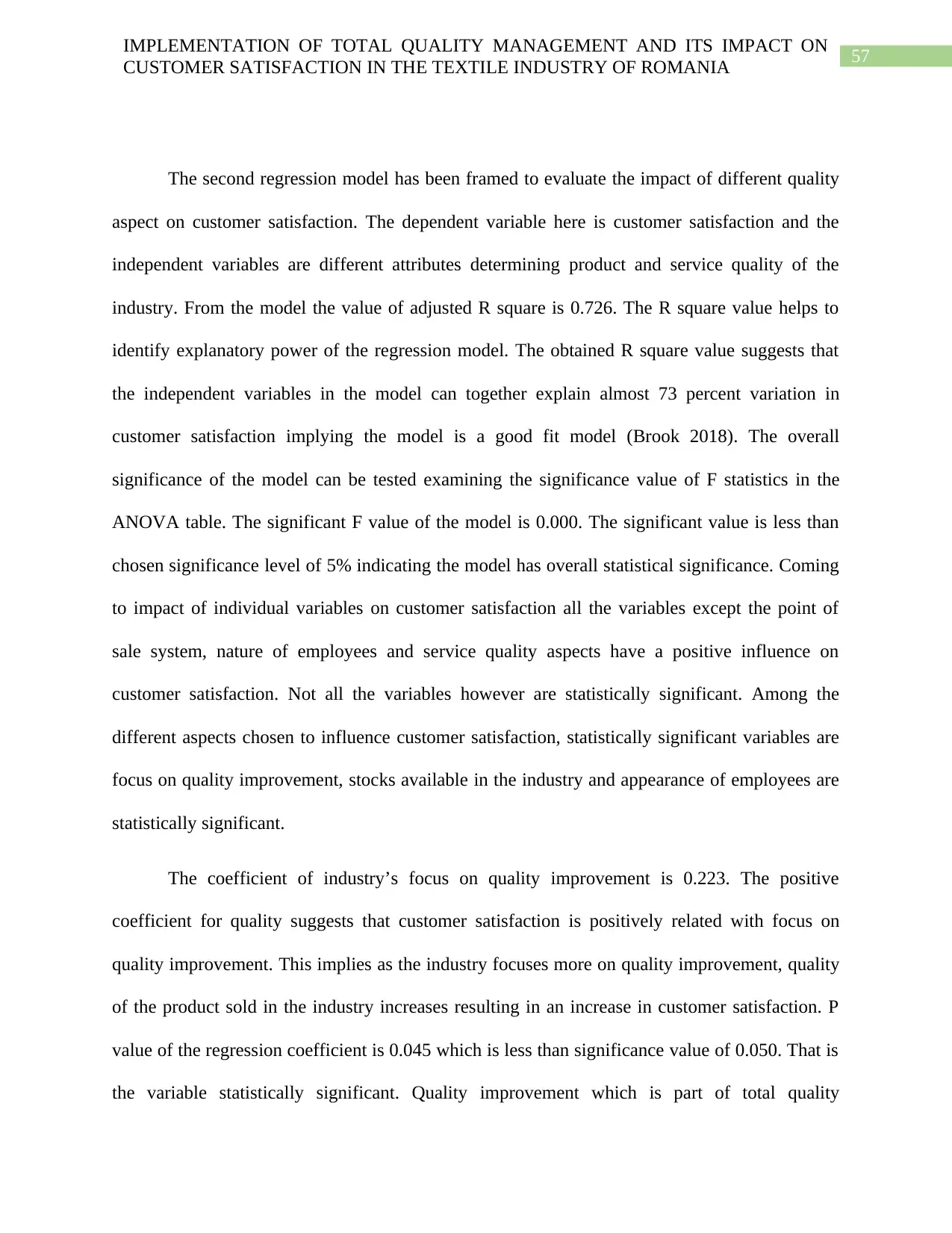
57
IMPLEMENTATION OF TOTAL QUALITY MANAGEMENT AND ITS IMPACT ON
CUSTOMER SATISFACTION IN THE TEXTILE INDUSTRY OF ROMANIA
The second regression model has been framed to evaluate the impact of different quality
aspect on customer satisfaction. The dependent variable here is customer satisfaction and the
independent variables are different attributes determining product and service quality of the
industry. From the model the value of adjusted R square is 0.726. The R square value helps to
identify explanatory power of the regression model. The obtained R square value suggests that
the independent variables in the model can together explain almost 73 percent variation in
customer satisfaction implying the model is a good fit model (Brook 2018). The overall
significance of the model can be tested examining the significance value of F statistics in the
ANOVA table. The significant F value of the model is 0.000. The significant value is less than
chosen significance level of 5% indicating the model has overall statistical significance. Coming
to impact of individual variables on customer satisfaction all the variables except the point of
sale system, nature of employees and service quality aspects have a positive influence on
customer satisfaction. Not all the variables however are statistically significant. Among the
different aspects chosen to influence customer satisfaction, statistically significant variables are
focus on quality improvement, stocks available in the industry and appearance of employees are
statistically significant.
The coefficient of industry’s focus on quality improvement is 0.223. The positive
coefficient for quality suggests that customer satisfaction is positively related with focus on
quality improvement. This implies as the industry focuses more on quality improvement, quality
of the product sold in the industry increases resulting in an increase in customer satisfaction. P
value of the regression coefficient is 0.045 which is less than significance value of 0.050. That is
the variable statistically significant. Quality improvement which is part of total quality
IMPLEMENTATION OF TOTAL QUALITY MANAGEMENT AND ITS IMPACT ON
CUSTOMER SATISFACTION IN THE TEXTILE INDUSTRY OF ROMANIA
The second regression model has been framed to evaluate the impact of different quality
aspect on customer satisfaction. The dependent variable here is customer satisfaction and the
independent variables are different attributes determining product and service quality of the
industry. From the model the value of adjusted R square is 0.726. The R square value helps to
identify explanatory power of the regression model. The obtained R square value suggests that
the independent variables in the model can together explain almost 73 percent variation in
customer satisfaction implying the model is a good fit model (Brook 2018). The overall
significance of the model can be tested examining the significance value of F statistics in the
ANOVA table. The significant F value of the model is 0.000. The significant value is less than
chosen significance level of 5% indicating the model has overall statistical significance. Coming
to impact of individual variables on customer satisfaction all the variables except the point of
sale system, nature of employees and service quality aspects have a positive influence on
customer satisfaction. Not all the variables however are statistically significant. Among the
different aspects chosen to influence customer satisfaction, statistically significant variables are
focus on quality improvement, stocks available in the industry and appearance of employees are
statistically significant.
The coefficient of industry’s focus on quality improvement is 0.223. The positive
coefficient for quality suggests that customer satisfaction is positively related with focus on
quality improvement. This implies as the industry focuses more on quality improvement, quality
of the product sold in the industry increases resulting in an increase in customer satisfaction. P
value of the regression coefficient is 0.045 which is less than significance value of 0.050. That is
the variable statistically significant. Quality improvement which is part of total quality
Secure Best Marks with AI Grader
Need help grading? Try our AI Grader for instant feedback on your assignments.
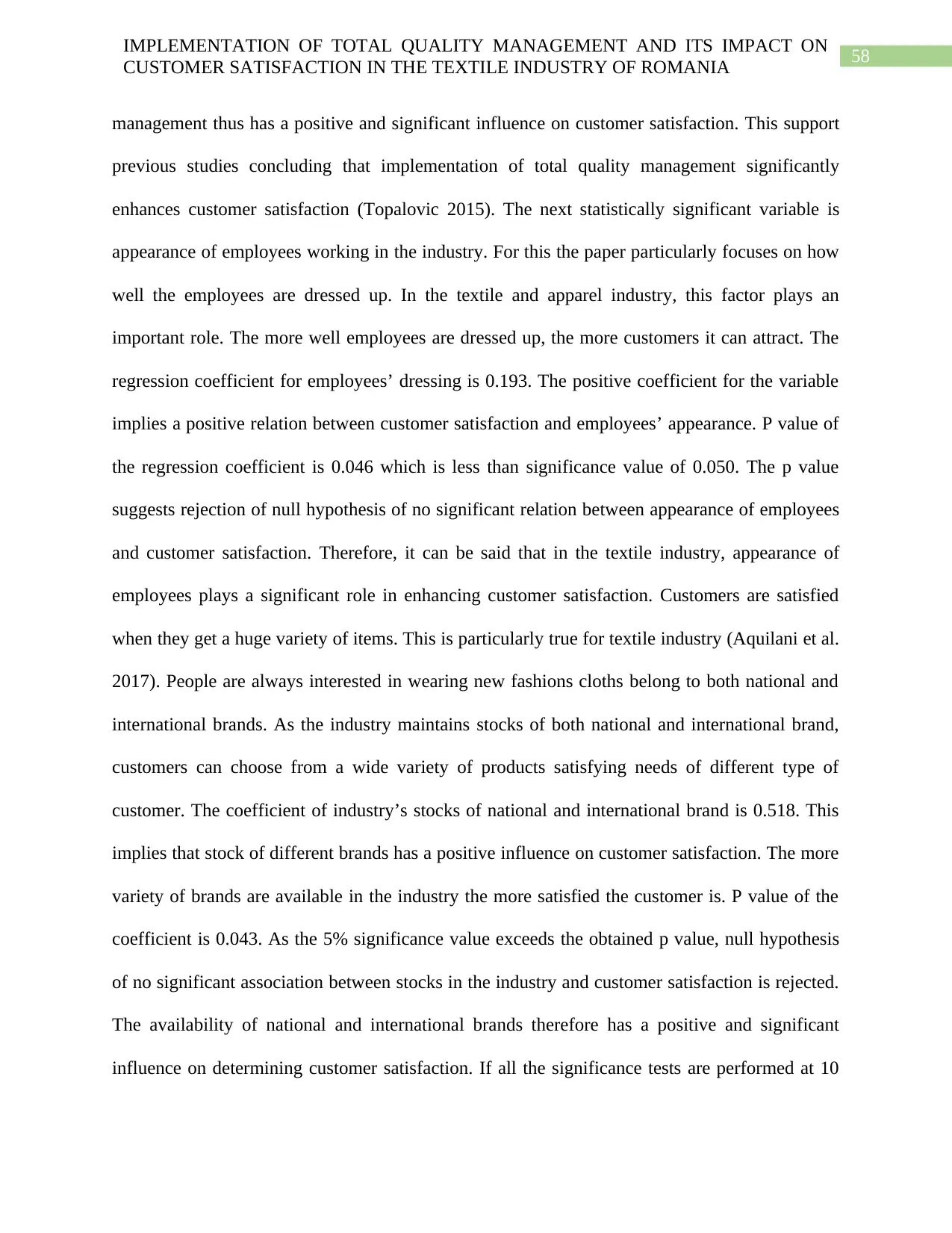
58
IMPLEMENTATION OF TOTAL QUALITY MANAGEMENT AND ITS IMPACT ON
CUSTOMER SATISFACTION IN THE TEXTILE INDUSTRY OF ROMANIA
management thus has a positive and significant influence on customer satisfaction. This support
previous studies concluding that implementation of total quality management significantly
enhances customer satisfaction (Topalovic 2015). The next statistically significant variable is
appearance of employees working in the industry. For this the paper particularly focuses on how
well the employees are dressed up. In the textile and apparel industry, this factor plays an
important role. The more well employees are dressed up, the more customers it can attract. The
regression coefficient for employees’ dressing is 0.193. The positive coefficient for the variable
implies a positive relation between customer satisfaction and employees’ appearance. P value of
the regression coefficient is 0.046 which is less than significance value of 0.050. The p value
suggests rejection of null hypothesis of no significant relation between appearance of employees
and customer satisfaction. Therefore, it can be said that in the textile industry, appearance of
employees plays a significant role in enhancing customer satisfaction. Customers are satisfied
when they get a huge variety of items. This is particularly true for textile industry (Aquilani et al.
2017). People are always interested in wearing new fashions cloths belong to both national and
international brands. As the industry maintains stocks of both national and international brand,
customers can choose from a wide variety of products satisfying needs of different type of
customer. The coefficient of industry’s stocks of national and international brand is 0.518. This
implies that stock of different brands has a positive influence on customer satisfaction. The more
variety of brands are available in the industry the more satisfied the customer is. P value of the
coefficient is 0.043. As the 5% significance value exceeds the obtained p value, null hypothesis
of no significant association between stocks in the industry and customer satisfaction is rejected.
The availability of national and international brands therefore has a positive and significant
influence on determining customer satisfaction. If all the significance tests are performed at 10
IMPLEMENTATION OF TOTAL QUALITY MANAGEMENT AND ITS IMPACT ON
CUSTOMER SATISFACTION IN THE TEXTILE INDUSTRY OF ROMANIA
management thus has a positive and significant influence on customer satisfaction. This support
previous studies concluding that implementation of total quality management significantly
enhances customer satisfaction (Topalovic 2015). The next statistically significant variable is
appearance of employees working in the industry. For this the paper particularly focuses on how
well the employees are dressed up. In the textile and apparel industry, this factor plays an
important role. The more well employees are dressed up, the more customers it can attract. The
regression coefficient for employees’ dressing is 0.193. The positive coefficient for the variable
implies a positive relation between customer satisfaction and employees’ appearance. P value of
the regression coefficient is 0.046 which is less than significance value of 0.050. The p value
suggests rejection of null hypothesis of no significant relation between appearance of employees
and customer satisfaction. Therefore, it can be said that in the textile industry, appearance of
employees plays a significant role in enhancing customer satisfaction. Customers are satisfied
when they get a huge variety of items. This is particularly true for textile industry (Aquilani et al.
2017). People are always interested in wearing new fashions cloths belong to both national and
international brands. As the industry maintains stocks of both national and international brand,
customers can choose from a wide variety of products satisfying needs of different type of
customer. The coefficient of industry’s stocks of national and international brand is 0.518. This
implies that stock of different brands has a positive influence on customer satisfaction. The more
variety of brands are available in the industry the more satisfied the customer is. P value of the
coefficient is 0.043. As the 5% significance value exceeds the obtained p value, null hypothesis
of no significant association between stocks in the industry and customer satisfaction is rejected.
The availability of national and international brands therefore has a positive and significant
influence on determining customer satisfaction. If all the significance tests are performed at 10
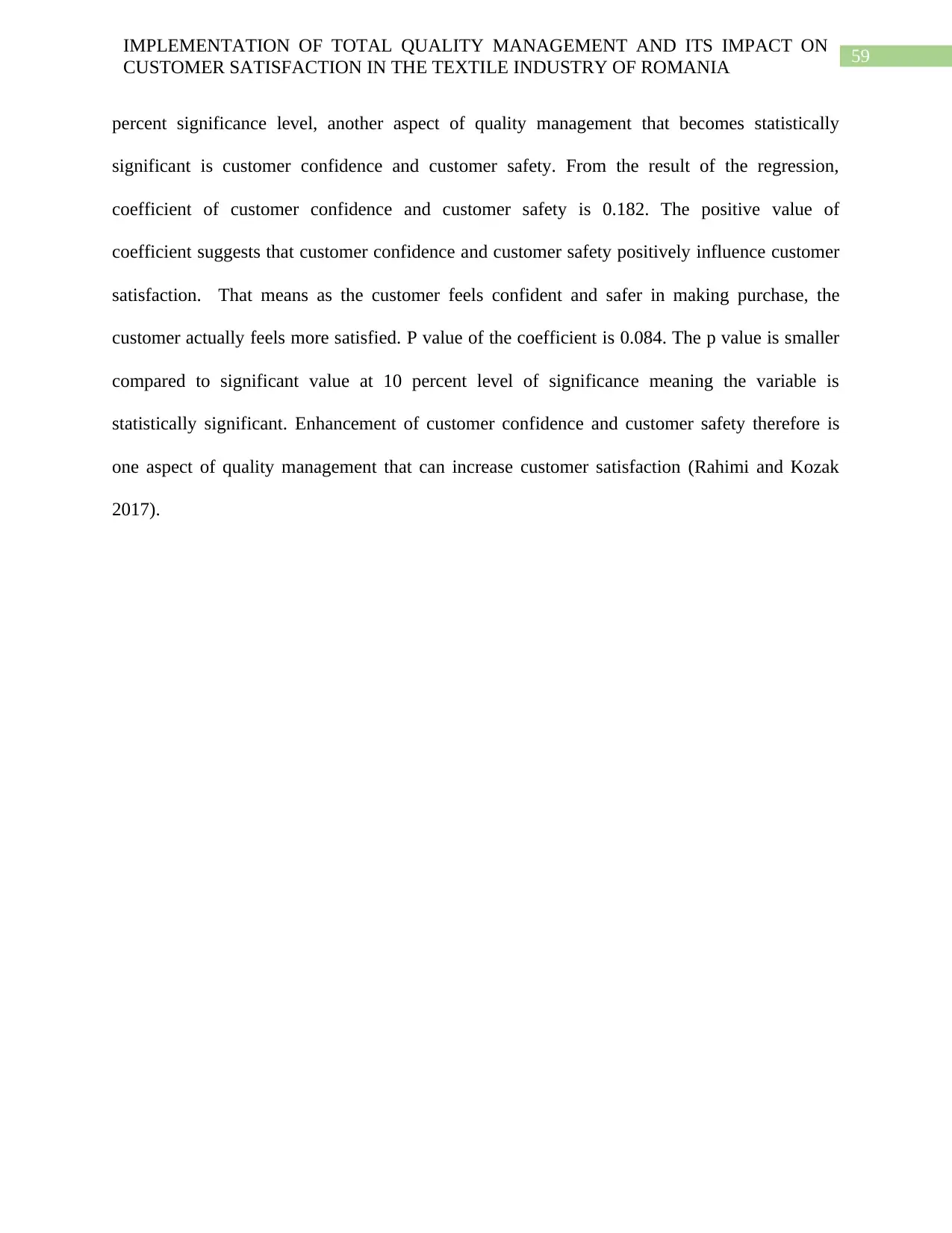
59
IMPLEMENTATION OF TOTAL QUALITY MANAGEMENT AND ITS IMPACT ON
CUSTOMER SATISFACTION IN THE TEXTILE INDUSTRY OF ROMANIA
percent significance level, another aspect of quality management that becomes statistically
significant is customer confidence and customer safety. From the result of the regression,
coefficient of customer confidence and customer safety is 0.182. The positive value of
coefficient suggests that customer confidence and customer safety positively influence customer
satisfaction. That means as the customer feels confident and safer in making purchase, the
customer actually feels more satisfied. P value of the coefficient is 0.084. The p value is smaller
compared to significant value at 10 percent level of significance meaning the variable is
statistically significant. Enhancement of customer confidence and customer safety therefore is
one aspect of quality management that can increase customer satisfaction (Rahimi and Kozak
2017).
IMPLEMENTATION OF TOTAL QUALITY MANAGEMENT AND ITS IMPACT ON
CUSTOMER SATISFACTION IN THE TEXTILE INDUSTRY OF ROMANIA
percent significance level, another aspect of quality management that becomes statistically
significant is customer confidence and customer safety. From the result of the regression,
coefficient of customer confidence and customer safety is 0.182. The positive value of
coefficient suggests that customer confidence and customer safety positively influence customer
satisfaction. That means as the customer feels confident and safer in making purchase, the
customer actually feels more satisfied. P value of the coefficient is 0.084. The p value is smaller
compared to significant value at 10 percent level of significance meaning the variable is
statistically significant. Enhancement of customer confidence and customer safety therefore is
one aspect of quality management that can increase customer satisfaction (Rahimi and Kozak
2017).
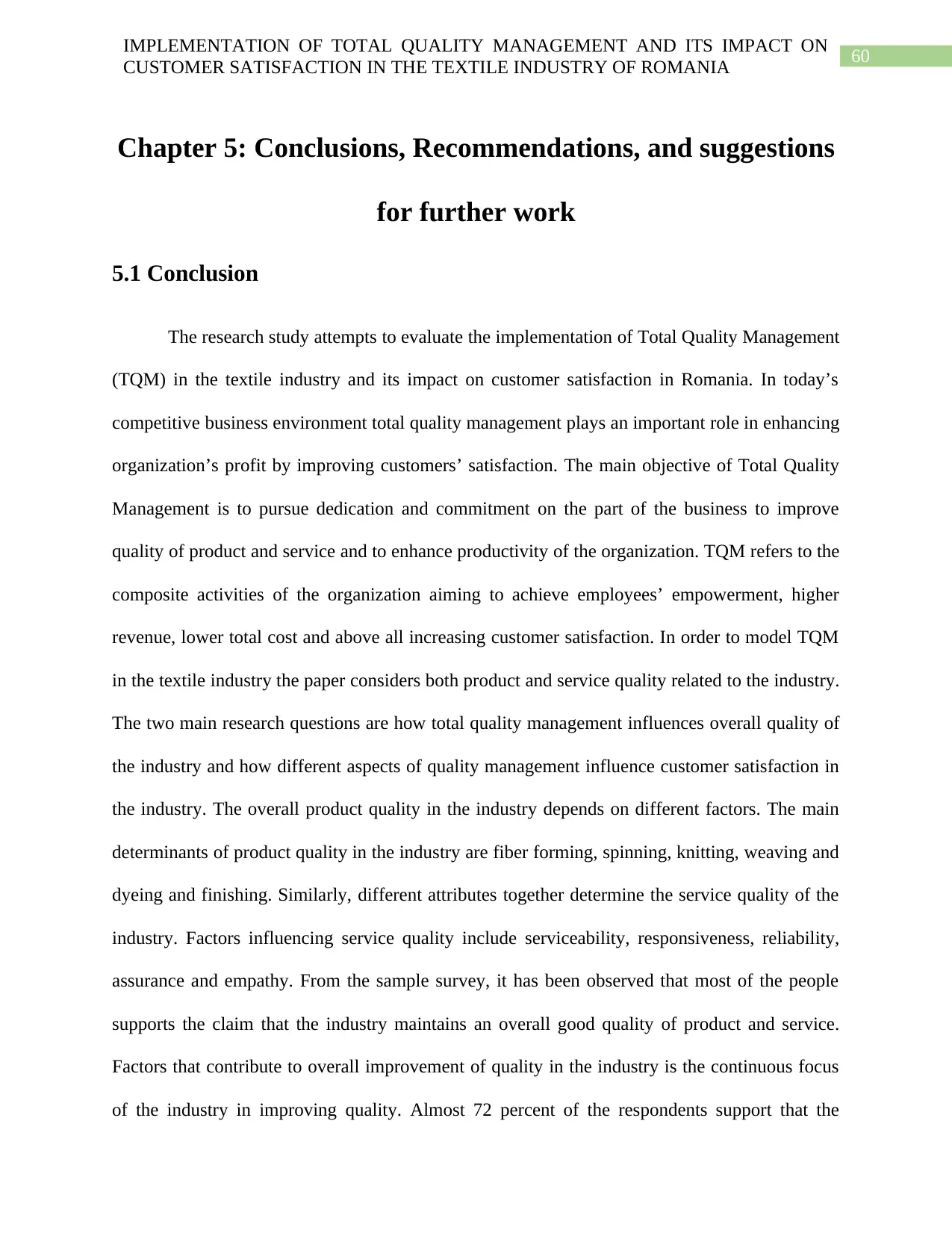
60
IMPLEMENTATION OF TOTAL QUALITY MANAGEMENT AND ITS IMPACT ON
CUSTOMER SATISFACTION IN THE TEXTILE INDUSTRY OF ROMANIA
Chapter 5: Conclusions, Recommendations, and suggestions
for further work
5.1 Conclusion
The research study attempts to evaluate the implementation of Total Quality Management
(TQM) in the textile industry and its impact on customer satisfaction in Romania. In today’s
competitive business environment total quality management plays an important role in enhancing
organization’s profit by improving customers’ satisfaction. The main objective of Total Quality
Management is to pursue dedication and commitment on the part of the business to improve
quality of product and service and to enhance productivity of the organization. TQM refers to the
composite activities of the organization aiming to achieve employees’ empowerment, higher
revenue, lower total cost and above all increasing customer satisfaction. In order to model TQM
in the textile industry the paper considers both product and service quality related to the industry.
The two main research questions are how total quality management influences overall quality of
the industry and how different aspects of quality management influence customer satisfaction in
the industry. The overall product quality in the industry depends on different factors. The main
determinants of product quality in the industry are fiber forming, spinning, knitting, weaving and
dyeing and finishing. Similarly, different attributes together determine the service quality of the
industry. Factors influencing service quality include serviceability, responsiveness, reliability,
assurance and empathy. From the sample survey, it has been observed that most of the people
supports the claim that the industry maintains an overall good quality of product and service.
Factors that contribute to overall improvement of quality in the industry is the continuous focus
of the industry in improving quality. Almost 72 percent of the respondents support that the
IMPLEMENTATION OF TOTAL QUALITY MANAGEMENT AND ITS IMPACT ON
CUSTOMER SATISFACTION IN THE TEXTILE INDUSTRY OF ROMANIA
Chapter 5: Conclusions, Recommendations, and suggestions
for further work
5.1 Conclusion
The research study attempts to evaluate the implementation of Total Quality Management
(TQM) in the textile industry and its impact on customer satisfaction in Romania. In today’s
competitive business environment total quality management plays an important role in enhancing
organization’s profit by improving customers’ satisfaction. The main objective of Total Quality
Management is to pursue dedication and commitment on the part of the business to improve
quality of product and service and to enhance productivity of the organization. TQM refers to the
composite activities of the organization aiming to achieve employees’ empowerment, higher
revenue, lower total cost and above all increasing customer satisfaction. In order to model TQM
in the textile industry the paper considers both product and service quality related to the industry.
The two main research questions are how total quality management influences overall quality of
the industry and how different aspects of quality management influence customer satisfaction in
the industry. The overall product quality in the industry depends on different factors. The main
determinants of product quality in the industry are fiber forming, spinning, knitting, weaving and
dyeing and finishing. Similarly, different attributes together determine the service quality of the
industry. Factors influencing service quality include serviceability, responsiveness, reliability,
assurance and empathy. From the sample survey, it has been observed that most of the people
supports the claim that the industry maintains an overall good quality of product and service.
Factors that contribute to overall improvement of quality in the industry is the continuous focus
of the industry in improving quality. Almost 72 percent of the respondents support that the
Paraphrase This Document
Need a fresh take? Get an instant paraphrase of this document with our AI Paraphraser
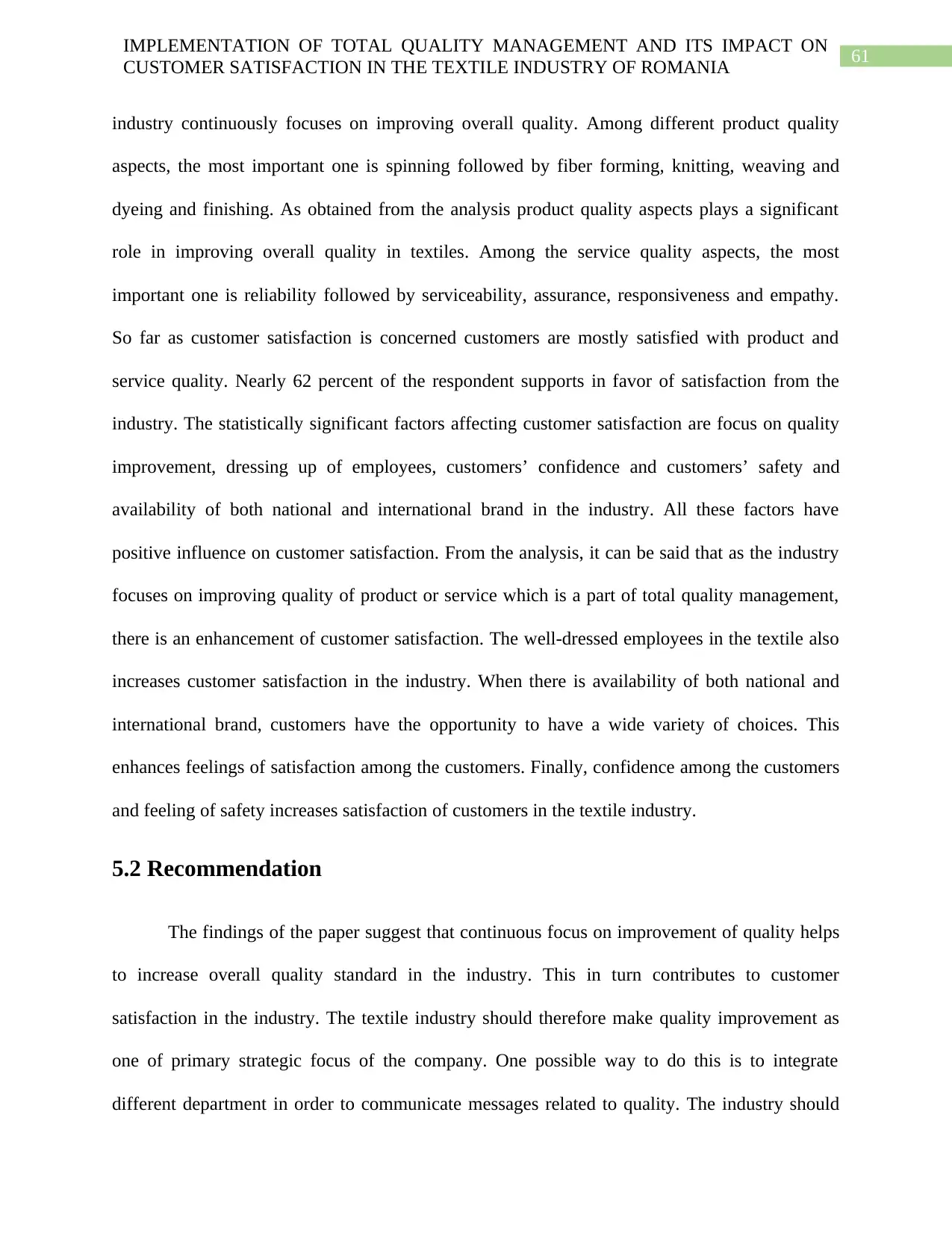
61
IMPLEMENTATION OF TOTAL QUALITY MANAGEMENT AND ITS IMPACT ON
CUSTOMER SATISFACTION IN THE TEXTILE INDUSTRY OF ROMANIA
industry continuously focuses on improving overall quality. Among different product quality
aspects, the most important one is spinning followed by fiber forming, knitting, weaving and
dyeing and finishing. As obtained from the analysis product quality aspects plays a significant
role in improving overall quality in textiles. Among the service quality aspects, the most
important one is reliability followed by serviceability, assurance, responsiveness and empathy.
So far as customer satisfaction is concerned customers are mostly satisfied with product and
service quality. Nearly 62 percent of the respondent supports in favor of satisfaction from the
industry. The statistically significant factors affecting customer satisfaction are focus on quality
improvement, dressing up of employees, customers’ confidence and customers’ safety and
availability of both national and international brand in the industry. All these factors have
positive influence on customer satisfaction. From the analysis, it can be said that as the industry
focuses on improving quality of product or service which is a part of total quality management,
there is an enhancement of customer satisfaction. The well-dressed employees in the textile also
increases customer satisfaction in the industry. When there is availability of both national and
international brand, customers have the opportunity to have a wide variety of choices. This
enhances feelings of satisfaction among the customers. Finally, confidence among the customers
and feeling of safety increases satisfaction of customers in the textile industry.
5.2 Recommendation
The findings of the paper suggest that continuous focus on improvement of quality helps
to increase overall quality standard in the industry. This in turn contributes to customer
satisfaction in the industry. The textile industry should therefore make quality improvement as
one of primary strategic focus of the company. One possible way to do this is to integrate
different department in order to communicate messages related to quality. The industry should
IMPLEMENTATION OF TOTAL QUALITY MANAGEMENT AND ITS IMPACT ON
CUSTOMER SATISFACTION IN THE TEXTILE INDUSTRY OF ROMANIA
industry continuously focuses on improving overall quality. Among different product quality
aspects, the most important one is spinning followed by fiber forming, knitting, weaving and
dyeing and finishing. As obtained from the analysis product quality aspects plays a significant
role in improving overall quality in textiles. Among the service quality aspects, the most
important one is reliability followed by serviceability, assurance, responsiveness and empathy.
So far as customer satisfaction is concerned customers are mostly satisfied with product and
service quality. Nearly 62 percent of the respondent supports in favor of satisfaction from the
industry. The statistically significant factors affecting customer satisfaction are focus on quality
improvement, dressing up of employees, customers’ confidence and customers’ safety and
availability of both national and international brand in the industry. All these factors have
positive influence on customer satisfaction. From the analysis, it can be said that as the industry
focuses on improving quality of product or service which is a part of total quality management,
there is an enhancement of customer satisfaction. The well-dressed employees in the textile also
increases customer satisfaction in the industry. When there is availability of both national and
international brand, customers have the opportunity to have a wide variety of choices. This
enhances feelings of satisfaction among the customers. Finally, confidence among the customers
and feeling of safety increases satisfaction of customers in the textile industry.
5.2 Recommendation
The findings of the paper suggest that continuous focus on improvement of quality helps
to increase overall quality standard in the industry. This in turn contributes to customer
satisfaction in the industry. The textile industry should therefore make quality improvement as
one of primary strategic focus of the company. One possible way to do this is to integrate
different department in order to communicate messages related to quality. The industry should
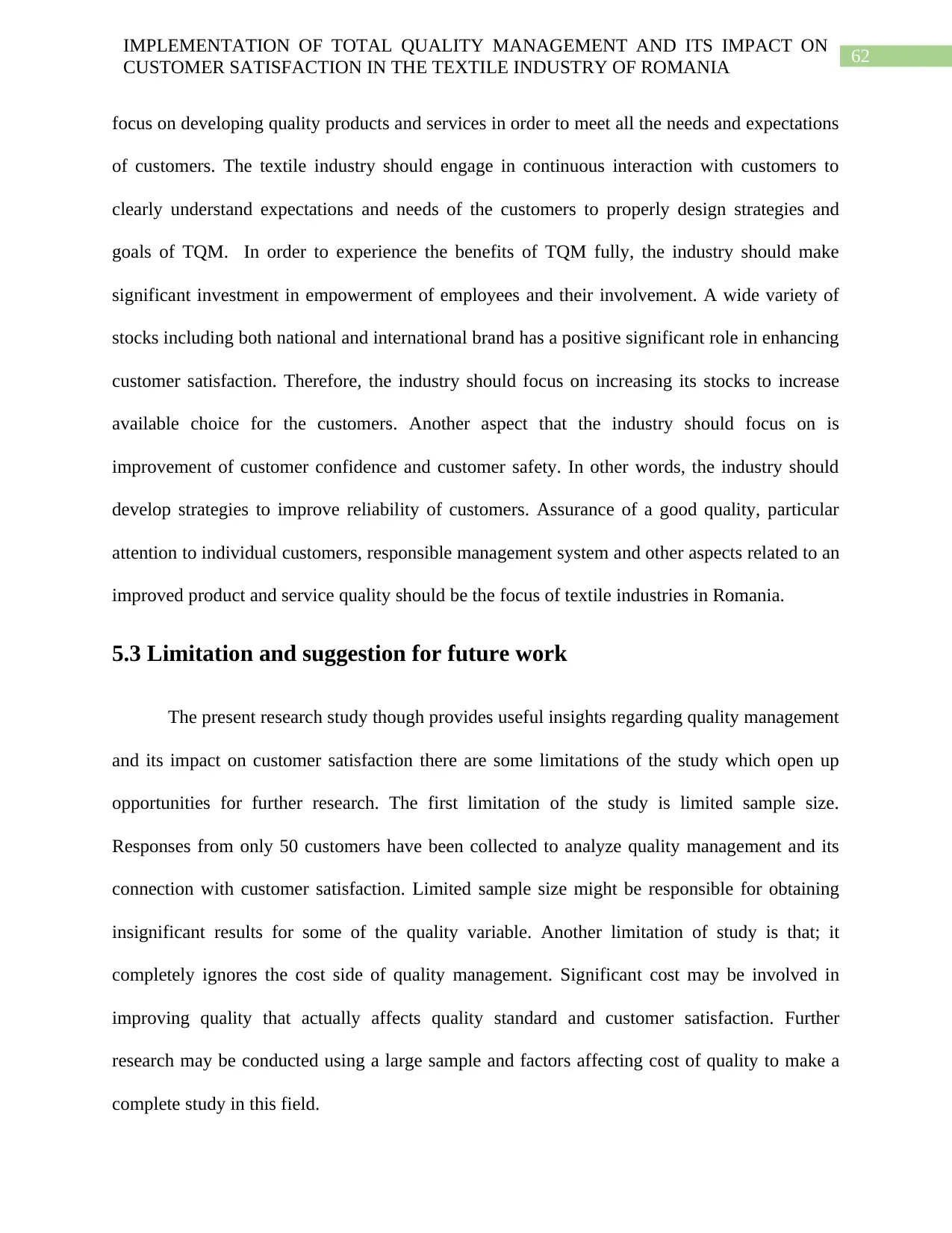
62
IMPLEMENTATION OF TOTAL QUALITY MANAGEMENT AND ITS IMPACT ON
CUSTOMER SATISFACTION IN THE TEXTILE INDUSTRY OF ROMANIA
focus on developing quality products and services in order to meet all the needs and expectations
of customers. The textile industry should engage in continuous interaction with customers to
clearly understand expectations and needs of the customers to properly design strategies and
goals of TQM. In order to experience the benefits of TQM fully, the industry should make
significant investment in empowerment of employees and their involvement. A wide variety of
stocks including both national and international brand has a positive significant role in enhancing
customer satisfaction. Therefore, the industry should focus on increasing its stocks to increase
available choice for the customers. Another aspect that the industry should focus on is
improvement of customer confidence and customer safety. In other words, the industry should
develop strategies to improve reliability of customers. Assurance of a good quality, particular
attention to individual customers, responsible management system and other aspects related to an
improved product and service quality should be the focus of textile industries in Romania.
5.3 Limitation and suggestion for future work
The present research study though provides useful insights regarding quality management
and its impact on customer satisfaction there are some limitations of the study which open up
opportunities for further research. The first limitation of the study is limited sample size.
Responses from only 50 customers have been collected to analyze quality management and its
connection with customer satisfaction. Limited sample size might be responsible for obtaining
insignificant results for some of the quality variable. Another limitation of study is that; it
completely ignores the cost side of quality management. Significant cost may be involved in
improving quality that actually affects quality standard and customer satisfaction. Further
research may be conducted using a large sample and factors affecting cost of quality to make a
complete study in this field.
IMPLEMENTATION OF TOTAL QUALITY MANAGEMENT AND ITS IMPACT ON
CUSTOMER SATISFACTION IN THE TEXTILE INDUSTRY OF ROMANIA
focus on developing quality products and services in order to meet all the needs and expectations
of customers. The textile industry should engage in continuous interaction with customers to
clearly understand expectations and needs of the customers to properly design strategies and
goals of TQM. In order to experience the benefits of TQM fully, the industry should make
significant investment in empowerment of employees and their involvement. A wide variety of
stocks including both national and international brand has a positive significant role in enhancing
customer satisfaction. Therefore, the industry should focus on increasing its stocks to increase
available choice for the customers. Another aspect that the industry should focus on is
improvement of customer confidence and customer safety. In other words, the industry should
develop strategies to improve reliability of customers. Assurance of a good quality, particular
attention to individual customers, responsible management system and other aspects related to an
improved product and service quality should be the focus of textile industries in Romania.
5.3 Limitation and suggestion for future work
The present research study though provides useful insights regarding quality management
and its impact on customer satisfaction there are some limitations of the study which open up
opportunities for further research. The first limitation of the study is limited sample size.
Responses from only 50 customers have been collected to analyze quality management and its
connection with customer satisfaction. Limited sample size might be responsible for obtaining
insignificant results for some of the quality variable. Another limitation of study is that; it
completely ignores the cost side of quality management. Significant cost may be involved in
improving quality that actually affects quality standard and customer satisfaction. Further
research may be conducted using a large sample and factors affecting cost of quality to make a
complete study in this field.

63
IMPLEMENTATION OF TOTAL QUALITY MANAGEMENT AND ITS IMPACT ON
CUSTOMER SATISFACTION IN THE TEXTILE INDUSTRY OF ROMANIA
References
Abeykoon, M.W.B. and De Alwis, C., 2015. The Impact of Total Quality Management
Practices on Export Performance of Apparel Exporters in Sri Lanka.
AK, F.R., 2017. A Study of Consumer Buying Behaviour of FMCG Products in Calicut City
(With Special Reference of Tooth Paste). International Journal of Scientific Research and
Management, 5(7), pp.6455-6460.
Ali, A. and Haseeb, M., 2019. Radio frequency identification (RFID) technology as a
strategic tool towards higher performance of supply chain operations in textile and apparel
industry of Malaysia. Uncertain Supply Chain Management, 7(2), pp.215-226.
Ali, M. and Raza, S.A., 2017. Service quality perception and customer satisfaction in Islamic
banks of Pakistan: the modified SERVQUAL model. Total Quality Management & Business
Excellence, 28(5-6), pp.559-577.
Aquilani, B., Silvestri, C., Ruggieri, A. and Gatti, C., 2017. A systematic literature review on
total quality management critical success factors and the identification of new avenues of
research. The TQM Journal, 29(1), pp.184-213.
Araujo, R., Santos, G., da Costa, J.B. and Sá, J.C., 2019. The Quality Management System as
a Driver of Organizational Culture: An Empirical Study in the Portuguese Textile Industry.
Quality Innovation Prosperity, 23(1), pp.1-24.
Arputharaj, A., Raja, A.S.M. and Saxena, S., 2016. Developments in sustainable chemical
processing of textiles. In Green Fashion (pp. 217-252). Springer, Singapore.
IMPLEMENTATION OF TOTAL QUALITY MANAGEMENT AND ITS IMPACT ON
CUSTOMER SATISFACTION IN THE TEXTILE INDUSTRY OF ROMANIA
References
Abeykoon, M.W.B. and De Alwis, C., 2015. The Impact of Total Quality Management
Practices on Export Performance of Apparel Exporters in Sri Lanka.
AK, F.R., 2017. A Study of Consumer Buying Behaviour of FMCG Products in Calicut City
(With Special Reference of Tooth Paste). International Journal of Scientific Research and
Management, 5(7), pp.6455-6460.
Ali, A. and Haseeb, M., 2019. Radio frequency identification (RFID) technology as a
strategic tool towards higher performance of supply chain operations in textile and apparel
industry of Malaysia. Uncertain Supply Chain Management, 7(2), pp.215-226.
Ali, M. and Raza, S.A., 2017. Service quality perception and customer satisfaction in Islamic
banks of Pakistan: the modified SERVQUAL model. Total Quality Management & Business
Excellence, 28(5-6), pp.559-577.
Aquilani, B., Silvestri, C., Ruggieri, A. and Gatti, C., 2017. A systematic literature review on
total quality management critical success factors and the identification of new avenues of
research. The TQM Journal, 29(1), pp.184-213.
Araujo, R., Santos, G., da Costa, J.B. and Sá, J.C., 2019. The Quality Management System as
a Driver of Organizational Culture: An Empirical Study in the Portuguese Textile Industry.
Quality Innovation Prosperity, 23(1), pp.1-24.
Arputharaj, A., Raja, A.S.M. and Saxena, S., 2016. Developments in sustainable chemical
processing of textiles. In Green Fashion (pp. 217-252). Springer, Singapore.
Secure Best Marks with AI Grader
Need help grading? Try our AI Grader for instant feedback on your assignments.
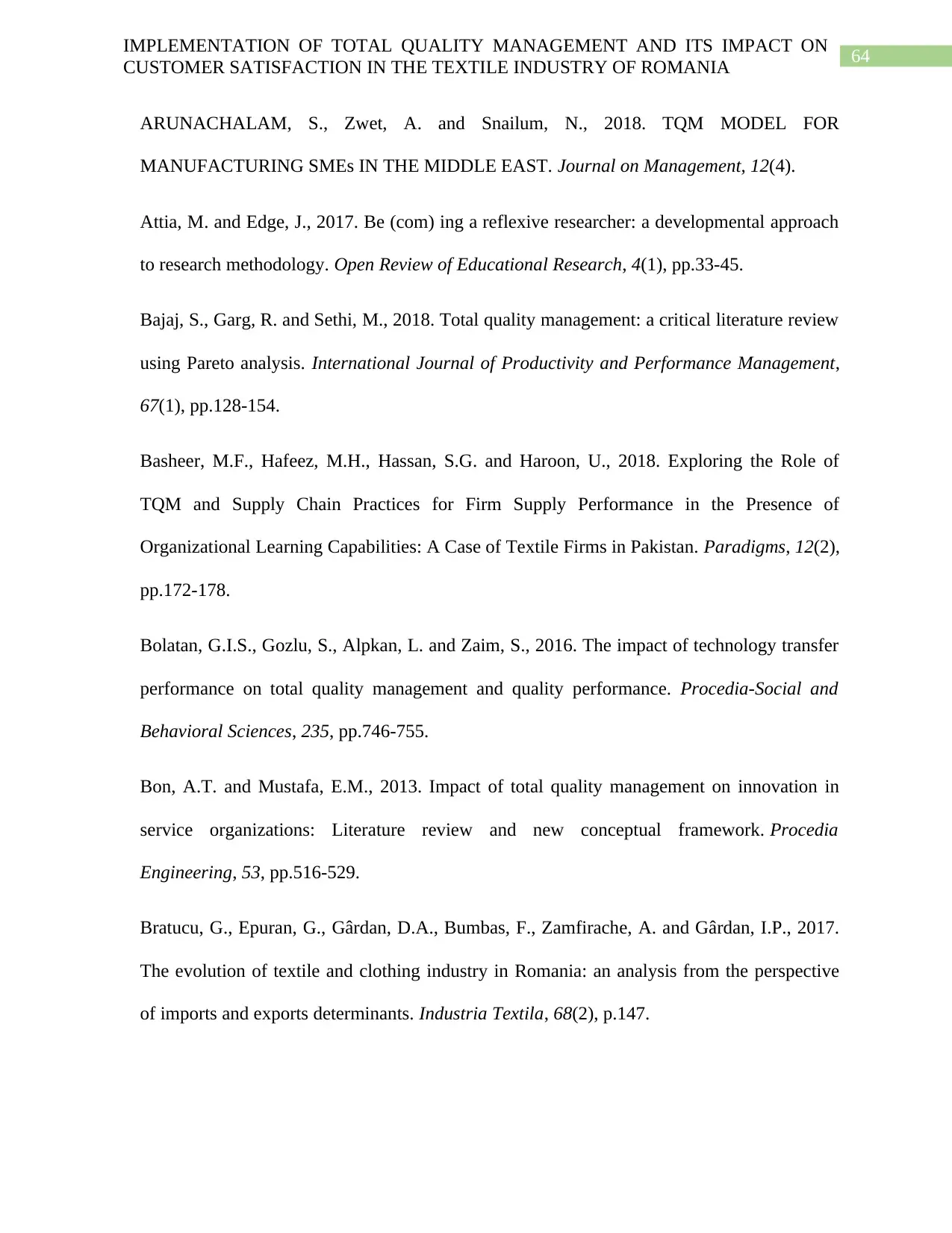
64
IMPLEMENTATION OF TOTAL QUALITY MANAGEMENT AND ITS IMPACT ON
CUSTOMER SATISFACTION IN THE TEXTILE INDUSTRY OF ROMANIA
ARUNACHALAM, S., Zwet, A. and Snailum, N., 2018. TQM MODEL FOR
MANUFACTURING SMEs IN THE MIDDLE EAST. Journal on Management, 12(4).
Attia, M. and Edge, J., 2017. Be (com) ing a reflexive researcher: a developmental approach
to research methodology. Open Review of Educational Research, 4(1), pp.33-45.
Bajaj, S., Garg, R. and Sethi, M., 2018. Total quality management: a critical literature review
using Pareto analysis. International Journal of Productivity and Performance Management,
67(1), pp.128-154.
Basheer, M.F., Hafeez, M.H., Hassan, S.G. and Haroon, U., 2018. Exploring the Role of
TQM and Supply Chain Practices for Firm Supply Performance in the Presence of
Organizational Learning Capabilities: A Case of Textile Firms in Pakistan. Paradigms, 12(2),
pp.172-178.
Bolatan, G.I.S., Gozlu, S., Alpkan, L. and Zaim, S., 2016. The impact of technology transfer
performance on total quality management and quality performance. Procedia-Social and
Behavioral Sciences, 235, pp.746-755.
Bon, A.T. and Mustafa, E.M., 2013. Impact of total quality management on innovation in
service organizations: Literature review and new conceptual framework. Procedia
Engineering, 53, pp.516-529.
Bratucu, G., Epuran, G., Gârdan, D.A., Bumbas, F., Zamfirache, A. and Gârdan, I.P., 2017.
The evolution of textile and clothing industry in Romania: an analysis from the perspective
of imports and exports determinants. Industria Textila, 68(2), p.147.
IMPLEMENTATION OF TOTAL QUALITY MANAGEMENT AND ITS IMPACT ON
CUSTOMER SATISFACTION IN THE TEXTILE INDUSTRY OF ROMANIA
ARUNACHALAM, S., Zwet, A. and Snailum, N., 2018. TQM MODEL FOR
MANUFACTURING SMEs IN THE MIDDLE EAST. Journal on Management, 12(4).
Attia, M. and Edge, J., 2017. Be (com) ing a reflexive researcher: a developmental approach
to research methodology. Open Review of Educational Research, 4(1), pp.33-45.
Bajaj, S., Garg, R. and Sethi, M., 2018. Total quality management: a critical literature review
using Pareto analysis. International Journal of Productivity and Performance Management,
67(1), pp.128-154.
Basheer, M.F., Hafeez, M.H., Hassan, S.G. and Haroon, U., 2018. Exploring the Role of
TQM and Supply Chain Practices for Firm Supply Performance in the Presence of
Organizational Learning Capabilities: A Case of Textile Firms in Pakistan. Paradigms, 12(2),
pp.172-178.
Bolatan, G.I.S., Gozlu, S., Alpkan, L. and Zaim, S., 2016. The impact of technology transfer
performance on total quality management and quality performance. Procedia-Social and
Behavioral Sciences, 235, pp.746-755.
Bon, A.T. and Mustafa, E.M., 2013. Impact of total quality management on innovation in
service organizations: Literature review and new conceptual framework. Procedia
Engineering, 53, pp.516-529.
Bratucu, G., Epuran, G., Gârdan, D.A., Bumbas, F., Zamfirache, A. and Gârdan, I.P., 2017.
The evolution of textile and clothing industry in Romania: an analysis from the perspective
of imports and exports determinants. Industria Textila, 68(2), p.147.
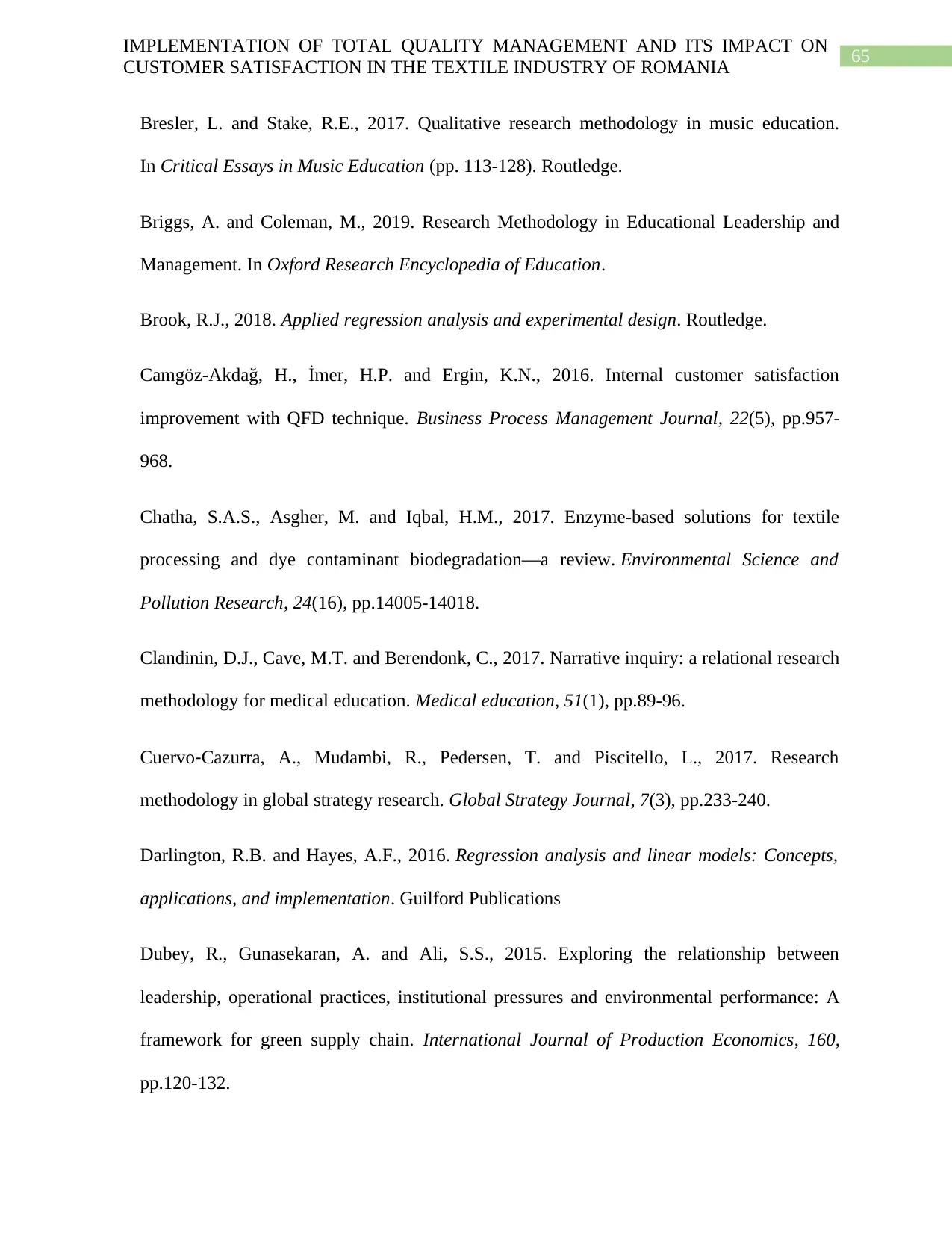
65
IMPLEMENTATION OF TOTAL QUALITY MANAGEMENT AND ITS IMPACT ON
CUSTOMER SATISFACTION IN THE TEXTILE INDUSTRY OF ROMANIA
Bresler, L. and Stake, R.E., 2017. Qualitative research methodology in music education.
In Critical Essays in Music Education (pp. 113-128). Routledge.
Briggs, A. and Coleman, M., 2019. Research Methodology in Educational Leadership and
Management. In Oxford Research Encyclopedia of Education.
Brook, R.J., 2018. Applied regression analysis and experimental design. Routledge.
Camgöz-Akdağ, H., İmer, H.P. and Ergin, K.N., 2016. Internal customer satisfaction
improvement with QFD technique. Business Process Management Journal, 22(5), pp.957-
968.
Chatha, S.A.S., Asgher, M. and Iqbal, H.M., 2017. Enzyme-based solutions for textile
processing and dye contaminant biodegradation—a review. Environmental Science and
Pollution Research, 24(16), pp.14005-14018.
Clandinin, D.J., Cave, M.T. and Berendonk, C., 2017. Narrative inquiry: a relational research
methodology for medical education. Medical education, 51(1), pp.89-96.
Cuervo‐Cazurra, A., Mudambi, R., Pedersen, T. and Piscitello, L., 2017. Research
methodology in global strategy research. Global Strategy Journal, 7(3), pp.233-240.
Darlington, R.B. and Hayes, A.F., 2016. Regression analysis and linear models: Concepts,
applications, and implementation. Guilford Publications
Dubey, R., Gunasekaran, A. and Ali, S.S., 2015. Exploring the relationship between
leadership, operational practices, institutional pressures and environmental performance: A
framework for green supply chain. International Journal of Production Economics, 160,
pp.120-132.
IMPLEMENTATION OF TOTAL QUALITY MANAGEMENT AND ITS IMPACT ON
CUSTOMER SATISFACTION IN THE TEXTILE INDUSTRY OF ROMANIA
Bresler, L. and Stake, R.E., 2017. Qualitative research methodology in music education.
In Critical Essays in Music Education (pp. 113-128). Routledge.
Briggs, A. and Coleman, M., 2019. Research Methodology in Educational Leadership and
Management. In Oxford Research Encyclopedia of Education.
Brook, R.J., 2018. Applied regression analysis and experimental design. Routledge.
Camgöz-Akdağ, H., İmer, H.P. and Ergin, K.N., 2016. Internal customer satisfaction
improvement with QFD technique. Business Process Management Journal, 22(5), pp.957-
968.
Chatha, S.A.S., Asgher, M. and Iqbal, H.M., 2017. Enzyme-based solutions for textile
processing and dye contaminant biodegradation—a review. Environmental Science and
Pollution Research, 24(16), pp.14005-14018.
Clandinin, D.J., Cave, M.T. and Berendonk, C., 2017. Narrative inquiry: a relational research
methodology for medical education. Medical education, 51(1), pp.89-96.
Cuervo‐Cazurra, A., Mudambi, R., Pedersen, T. and Piscitello, L., 2017. Research
methodology in global strategy research. Global Strategy Journal, 7(3), pp.233-240.
Darlington, R.B. and Hayes, A.F., 2016. Regression analysis and linear models: Concepts,
applications, and implementation. Guilford Publications
Dubey, R., Gunasekaran, A. and Ali, S.S., 2015. Exploring the relationship between
leadership, operational practices, institutional pressures and environmental performance: A
framework for green supply chain. International Journal of Production Economics, 160,
pp.120-132.
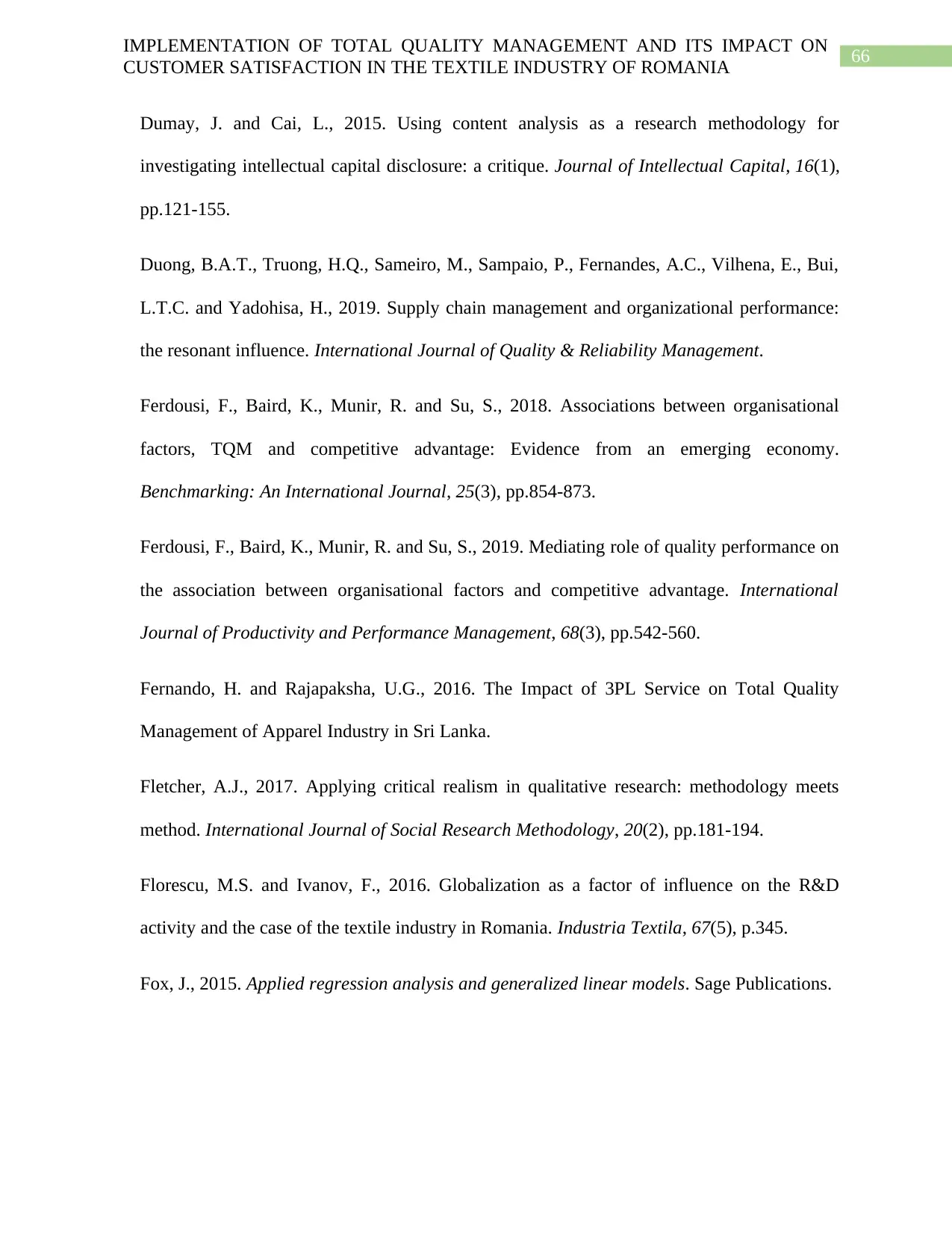
66
IMPLEMENTATION OF TOTAL QUALITY MANAGEMENT AND ITS IMPACT ON
CUSTOMER SATISFACTION IN THE TEXTILE INDUSTRY OF ROMANIA
Dumay, J. and Cai, L., 2015. Using content analysis as a research methodology for
investigating intellectual capital disclosure: a critique. Journal of Intellectual Capital, 16(1),
pp.121-155.
Duong, B.A.T., Truong, H.Q., Sameiro, M., Sampaio, P., Fernandes, A.C., Vilhena, E., Bui,
L.T.C. and Yadohisa, H., 2019. Supply chain management and organizational performance:
the resonant influence. International Journal of Quality & Reliability Management.
Ferdousi, F., Baird, K., Munir, R. and Su, S., 2018. Associations between organisational
factors, TQM and competitive advantage: Evidence from an emerging economy.
Benchmarking: An International Journal, 25(3), pp.854-873.
Ferdousi, F., Baird, K., Munir, R. and Su, S., 2019. Mediating role of quality performance on
the association between organisational factors and competitive advantage. International
Journal of Productivity and Performance Management, 68(3), pp.542-560.
Fernando, H. and Rajapaksha, U.G., 2016. The Impact of 3PL Service on Total Quality
Management of Apparel Industry in Sri Lanka.
Fletcher, A.J., 2017. Applying critical realism in qualitative research: methodology meets
method. International Journal of Social Research Methodology, 20(2), pp.181-194.
Florescu, M.S. and Ivanov, F., 2016. Globalization as a factor of influence on the R&D
activity and the case of the textile industry in Romania. Industria Textila, 67(5), p.345.
Fox, J., 2015. Applied regression analysis and generalized linear models. Sage Publications.
IMPLEMENTATION OF TOTAL QUALITY MANAGEMENT AND ITS IMPACT ON
CUSTOMER SATISFACTION IN THE TEXTILE INDUSTRY OF ROMANIA
Dumay, J. and Cai, L., 2015. Using content analysis as a research methodology for
investigating intellectual capital disclosure: a critique. Journal of Intellectual Capital, 16(1),
pp.121-155.
Duong, B.A.T., Truong, H.Q., Sameiro, M., Sampaio, P., Fernandes, A.C., Vilhena, E., Bui,
L.T.C. and Yadohisa, H., 2019. Supply chain management and organizational performance:
the resonant influence. International Journal of Quality & Reliability Management.
Ferdousi, F., Baird, K., Munir, R. and Su, S., 2018. Associations between organisational
factors, TQM and competitive advantage: Evidence from an emerging economy.
Benchmarking: An International Journal, 25(3), pp.854-873.
Ferdousi, F., Baird, K., Munir, R. and Su, S., 2019. Mediating role of quality performance on
the association between organisational factors and competitive advantage. International
Journal of Productivity and Performance Management, 68(3), pp.542-560.
Fernando, H. and Rajapaksha, U.G., 2016. The Impact of 3PL Service on Total Quality
Management of Apparel Industry in Sri Lanka.
Fletcher, A.J., 2017. Applying critical realism in qualitative research: methodology meets
method. International Journal of Social Research Methodology, 20(2), pp.181-194.
Florescu, M.S. and Ivanov, F., 2016. Globalization as a factor of influence on the R&D
activity and the case of the textile industry in Romania. Industria Textila, 67(5), p.345.
Fox, J., 2015. Applied regression analysis and generalized linear models. Sage Publications.
Paraphrase This Document
Need a fresh take? Get an instant paraphrase of this document with our AI Paraphraser
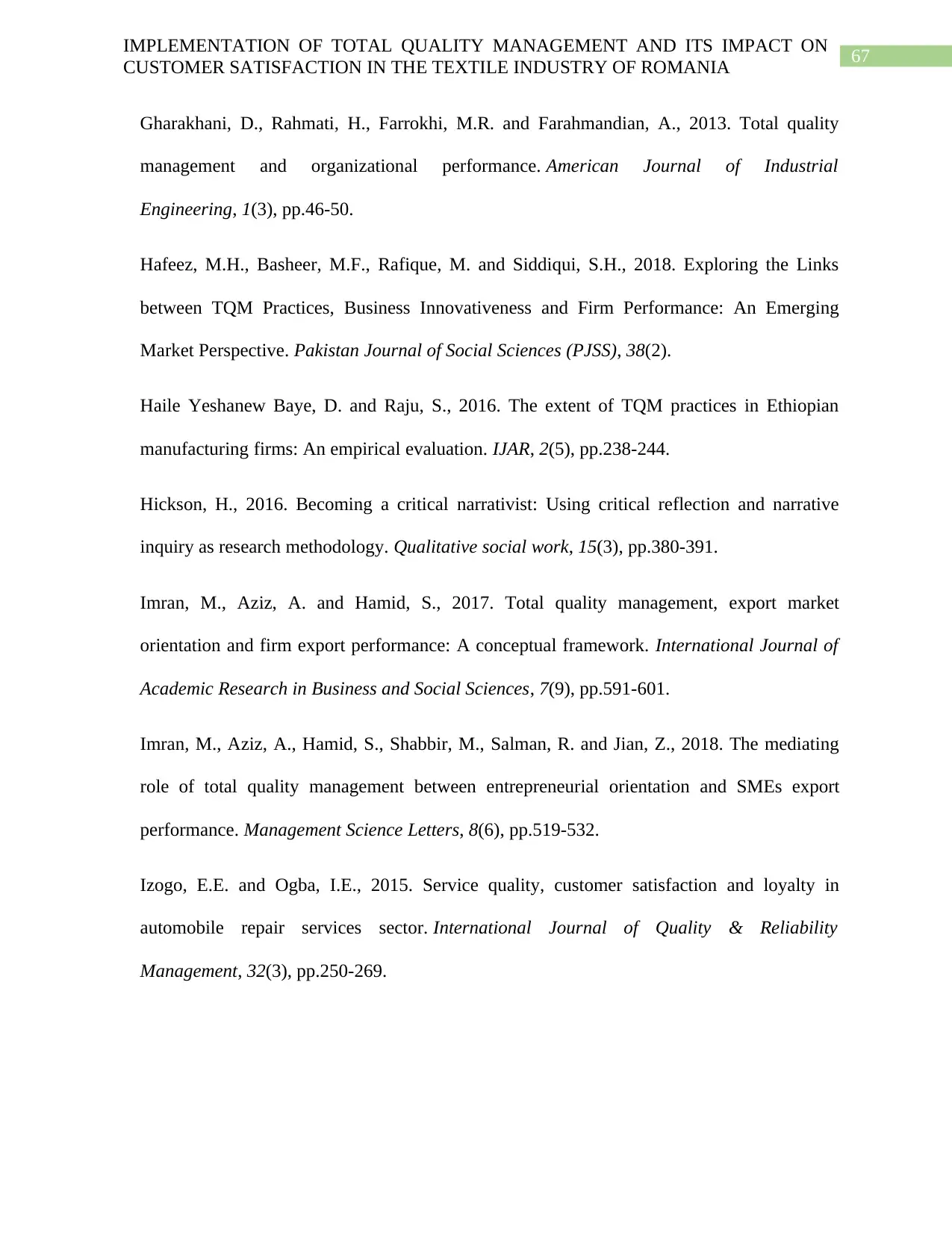
67
IMPLEMENTATION OF TOTAL QUALITY MANAGEMENT AND ITS IMPACT ON
CUSTOMER SATISFACTION IN THE TEXTILE INDUSTRY OF ROMANIA
Gharakhani, D., Rahmati, H., Farrokhi, M.R. and Farahmandian, A., 2013. Total quality
management and organizational performance. American Journal of Industrial
Engineering, 1(3), pp.46-50.
Hafeez, M.H., Basheer, M.F., Rafique, M. and Siddiqui, S.H., 2018. Exploring the Links
between TQM Practices, Business Innovativeness and Firm Performance: An Emerging
Market Perspective. Pakistan Journal of Social Sciences (PJSS), 38(2).
Haile Yeshanew Baye, D. and Raju, S., 2016. The extent of TQM practices in Ethiopian
manufacturing firms: An empirical evaluation. IJAR, 2(5), pp.238-244.
Hickson, H., 2016. Becoming a critical narrativist: Using critical reflection and narrative
inquiry as research methodology. Qualitative social work, 15(3), pp.380-391.
Imran, M., Aziz, A. and Hamid, S., 2017. Total quality management, export market
orientation and firm export performance: A conceptual framework. International Journal of
Academic Research in Business and Social Sciences, 7(9), pp.591-601.
Imran, M., Aziz, A., Hamid, S., Shabbir, M., Salman, R. and Jian, Z., 2018. The mediating
role of total quality management between entrepreneurial orientation and SMEs export
performance. Management Science Letters, 8(6), pp.519-532.
Izogo, E.E. and Ogba, I.E., 2015. Service quality, customer satisfaction and loyalty in
automobile repair services sector. International Journal of Quality & Reliability
Management, 32(3), pp.250-269.
IMPLEMENTATION OF TOTAL QUALITY MANAGEMENT AND ITS IMPACT ON
CUSTOMER SATISFACTION IN THE TEXTILE INDUSTRY OF ROMANIA
Gharakhani, D., Rahmati, H., Farrokhi, M.R. and Farahmandian, A., 2013. Total quality
management and organizational performance. American Journal of Industrial
Engineering, 1(3), pp.46-50.
Hafeez, M.H., Basheer, M.F., Rafique, M. and Siddiqui, S.H., 2018. Exploring the Links
between TQM Practices, Business Innovativeness and Firm Performance: An Emerging
Market Perspective. Pakistan Journal of Social Sciences (PJSS), 38(2).
Haile Yeshanew Baye, D. and Raju, S., 2016. The extent of TQM practices in Ethiopian
manufacturing firms: An empirical evaluation. IJAR, 2(5), pp.238-244.
Hickson, H., 2016. Becoming a critical narrativist: Using critical reflection and narrative
inquiry as research methodology. Qualitative social work, 15(3), pp.380-391.
Imran, M., Aziz, A. and Hamid, S., 2017. Total quality management, export market
orientation and firm export performance: A conceptual framework. International Journal of
Academic Research in Business and Social Sciences, 7(9), pp.591-601.
Imran, M., Aziz, A., Hamid, S., Shabbir, M., Salman, R. and Jian, Z., 2018. The mediating
role of total quality management between entrepreneurial orientation and SMEs export
performance. Management Science Letters, 8(6), pp.519-532.
Izogo, E.E. and Ogba, I.E., 2015. Service quality, customer satisfaction and loyalty in
automobile repair services sector. International Journal of Quality & Reliability
Management, 32(3), pp.250-269.
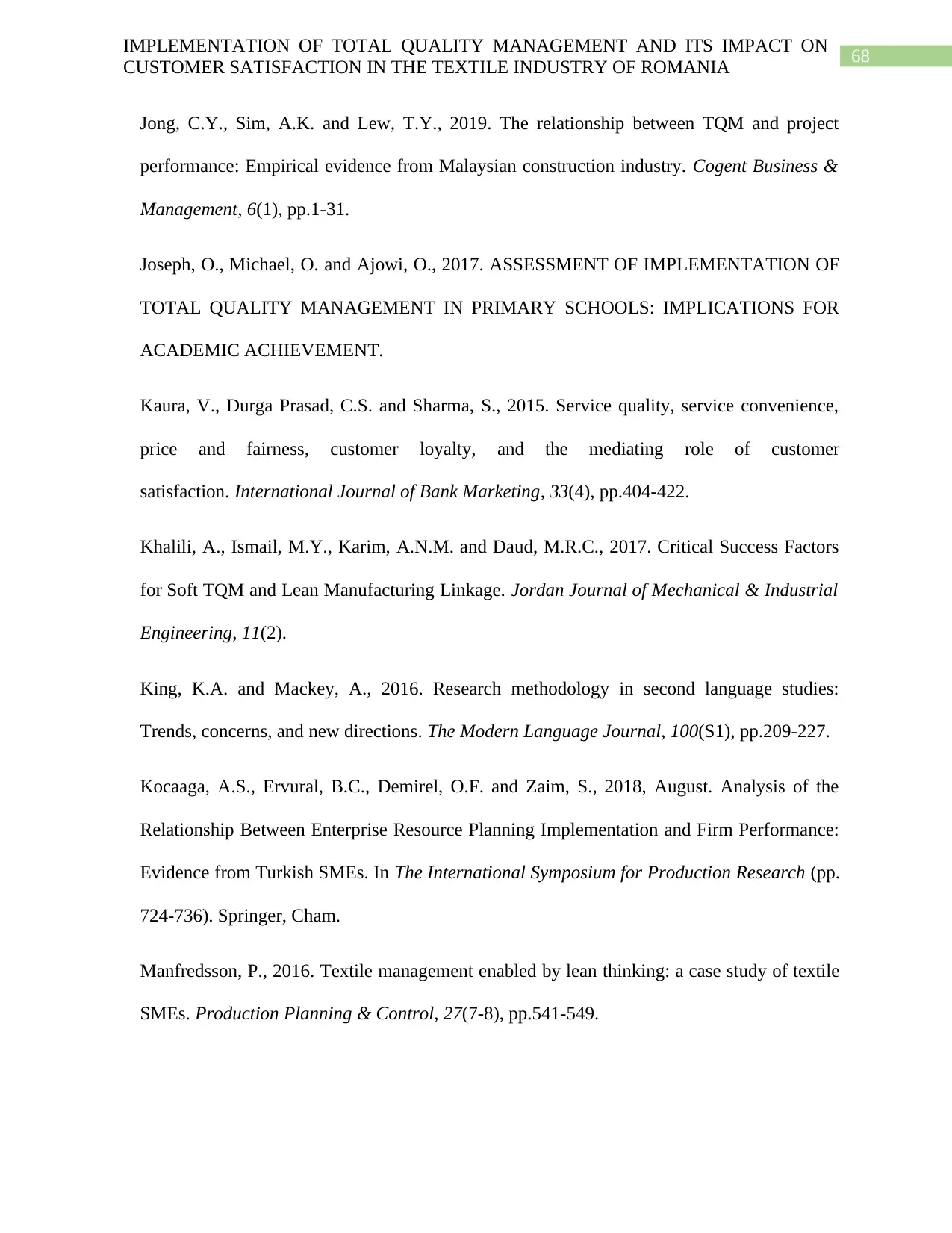
68
IMPLEMENTATION OF TOTAL QUALITY MANAGEMENT AND ITS IMPACT ON
CUSTOMER SATISFACTION IN THE TEXTILE INDUSTRY OF ROMANIA
Jong, C.Y., Sim, A.K. and Lew, T.Y., 2019. The relationship between TQM and project
performance: Empirical evidence from Malaysian construction industry. Cogent Business &
Management, 6(1), pp.1-31.
Joseph, O., Michael, O. and Ajowi, O., 2017. ASSESSMENT OF IMPLEMENTATION OF
TOTAL QUALITY MANAGEMENT IN PRIMARY SCHOOLS: IMPLICATIONS FOR
ACADEMIC ACHIEVEMENT.
Kaura, V., Durga Prasad, C.S. and Sharma, S., 2015. Service quality, service convenience,
price and fairness, customer loyalty, and the mediating role of customer
satisfaction. International Journal of Bank Marketing, 33(4), pp.404-422.
Khalili, A., Ismail, M.Y., Karim, A.N.M. and Daud, M.R.C., 2017. Critical Success Factors
for Soft TQM and Lean Manufacturing Linkage. Jordan Journal of Mechanical & Industrial
Engineering, 11(2).
King, K.A. and Mackey, A., 2016. Research methodology in second language studies:
Trends, concerns, and new directions. The Modern Language Journal, 100(S1), pp.209-227.
Kocaaga, A.S., Ervural, B.C., Demirel, O.F. and Zaim, S., 2018, August. Analysis of the
Relationship Between Enterprise Resource Planning Implementation and Firm Performance:
Evidence from Turkish SMEs. In The International Symposium for Production Research (pp.
724-736). Springer, Cham.
Manfredsson, P., 2016. Textile management enabled by lean thinking: a case study of textile
SMEs. Production Planning & Control, 27(7-8), pp.541-549.
IMPLEMENTATION OF TOTAL QUALITY MANAGEMENT AND ITS IMPACT ON
CUSTOMER SATISFACTION IN THE TEXTILE INDUSTRY OF ROMANIA
Jong, C.Y., Sim, A.K. and Lew, T.Y., 2019. The relationship between TQM and project
performance: Empirical evidence from Malaysian construction industry. Cogent Business &
Management, 6(1), pp.1-31.
Joseph, O., Michael, O. and Ajowi, O., 2017. ASSESSMENT OF IMPLEMENTATION OF
TOTAL QUALITY MANAGEMENT IN PRIMARY SCHOOLS: IMPLICATIONS FOR
ACADEMIC ACHIEVEMENT.
Kaura, V., Durga Prasad, C.S. and Sharma, S., 2015. Service quality, service convenience,
price and fairness, customer loyalty, and the mediating role of customer
satisfaction. International Journal of Bank Marketing, 33(4), pp.404-422.
Khalili, A., Ismail, M.Y., Karim, A.N.M. and Daud, M.R.C., 2017. Critical Success Factors
for Soft TQM and Lean Manufacturing Linkage. Jordan Journal of Mechanical & Industrial
Engineering, 11(2).
King, K.A. and Mackey, A., 2016. Research methodology in second language studies:
Trends, concerns, and new directions. The Modern Language Journal, 100(S1), pp.209-227.
Kocaaga, A.S., Ervural, B.C., Demirel, O.F. and Zaim, S., 2018, August. Analysis of the
Relationship Between Enterprise Resource Planning Implementation and Firm Performance:
Evidence from Turkish SMEs. In The International Symposium for Production Research (pp.
724-736). Springer, Cham.
Manfredsson, P., 2016. Textile management enabled by lean thinking: a case study of textile
SMEs. Production Planning & Control, 27(7-8), pp.541-549.
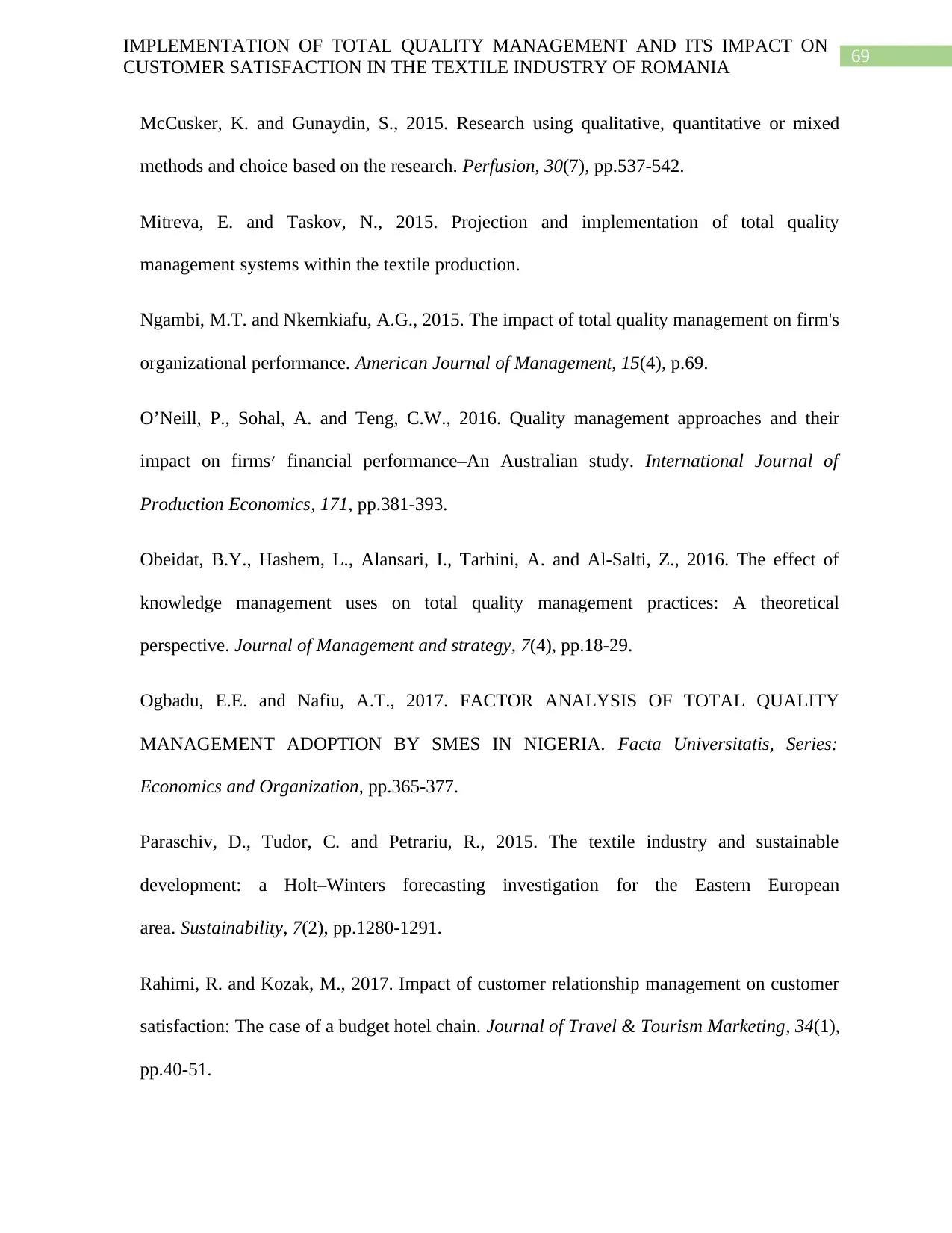
69
IMPLEMENTATION OF TOTAL QUALITY MANAGEMENT AND ITS IMPACT ON
CUSTOMER SATISFACTION IN THE TEXTILE INDUSTRY OF ROMANIA
McCusker, K. and Gunaydin, S., 2015. Research using qualitative, quantitative or mixed
methods and choice based on the research. Perfusion, 30(7), pp.537-542.
Mitreva, E. and Taskov, N., 2015. Projection and implementation of total quality
management systems within the textile production.
Ngambi, M.T. and Nkemkiafu, A.G., 2015. The impact of total quality management on firm's
organizational performance. American Journal of Management, 15(4), p.69.
O’Neill, P., Sohal, A. and Teng, C.W., 2016. Quality management approaches and their
impact on firms׳ financial performance–An Australian study. International Journal of
Production Economics, 171, pp.381-393.
Obeidat, B.Y., Hashem, L., Alansari, I., Tarhini, A. and Al-Salti, Z., 2016. The effect of
knowledge management uses on total quality management practices: A theoretical
perspective. Journal of Management and strategy, 7(4), pp.18-29.
Ogbadu, E.E. and Nafiu, A.T., 2017. FACTOR ANALYSIS OF TOTAL QUALITY
MANAGEMENT ADOPTION BY SMES IN NIGERIA. Facta Universitatis, Series:
Economics and Organization, pp.365-377.
Paraschiv, D., Tudor, C. and Petrariu, R., 2015. The textile industry and sustainable
development: a Holt–Winters forecasting investigation for the Eastern European
area. Sustainability, 7(2), pp.1280-1291.
Rahimi, R. and Kozak, M., 2017. Impact of customer relationship management on customer
satisfaction: The case of a budget hotel chain. Journal of Travel & Tourism Marketing, 34(1),
pp.40-51.
IMPLEMENTATION OF TOTAL QUALITY MANAGEMENT AND ITS IMPACT ON
CUSTOMER SATISFACTION IN THE TEXTILE INDUSTRY OF ROMANIA
McCusker, K. and Gunaydin, S., 2015. Research using qualitative, quantitative or mixed
methods and choice based on the research. Perfusion, 30(7), pp.537-542.
Mitreva, E. and Taskov, N., 2015. Projection and implementation of total quality
management systems within the textile production.
Ngambi, M.T. and Nkemkiafu, A.G., 2015. The impact of total quality management on firm's
organizational performance. American Journal of Management, 15(4), p.69.
O’Neill, P., Sohal, A. and Teng, C.W., 2016. Quality management approaches and their
impact on firms׳ financial performance–An Australian study. International Journal of
Production Economics, 171, pp.381-393.
Obeidat, B.Y., Hashem, L., Alansari, I., Tarhini, A. and Al-Salti, Z., 2016. The effect of
knowledge management uses on total quality management practices: A theoretical
perspective. Journal of Management and strategy, 7(4), pp.18-29.
Ogbadu, E.E. and Nafiu, A.T., 2017. FACTOR ANALYSIS OF TOTAL QUALITY
MANAGEMENT ADOPTION BY SMES IN NIGERIA. Facta Universitatis, Series:
Economics and Organization, pp.365-377.
Paraschiv, D., Tudor, C. and Petrariu, R., 2015. The textile industry and sustainable
development: a Holt–Winters forecasting investigation for the Eastern European
area. Sustainability, 7(2), pp.1280-1291.
Rahimi, R. and Kozak, M., 2017. Impact of customer relationship management on customer
satisfaction: The case of a budget hotel chain. Journal of Travel & Tourism Marketing, 34(1),
pp.40-51.
Secure Best Marks with AI Grader
Need help grading? Try our AI Grader for instant feedback on your assignments.
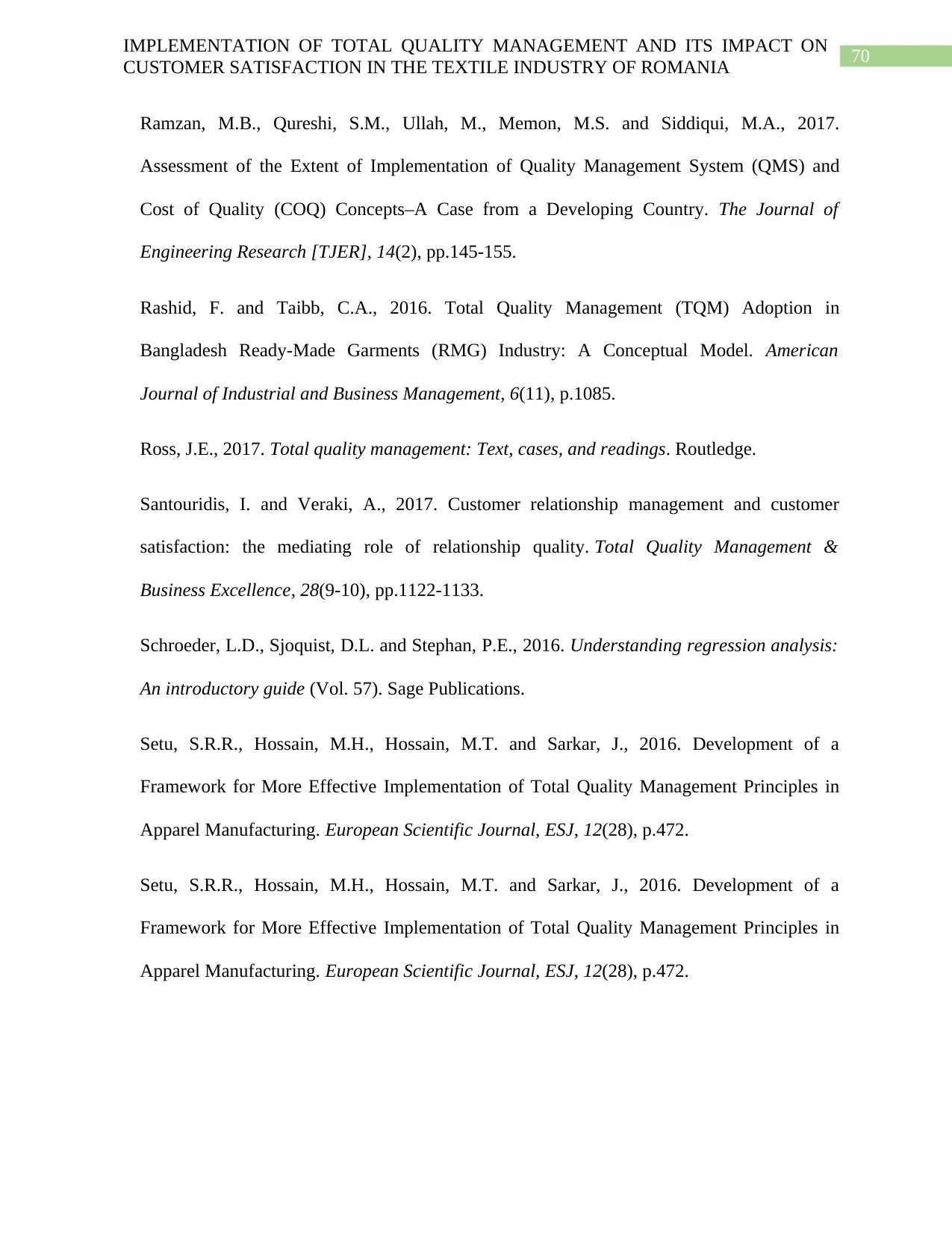
70
IMPLEMENTATION OF TOTAL QUALITY MANAGEMENT AND ITS IMPACT ON
CUSTOMER SATISFACTION IN THE TEXTILE INDUSTRY OF ROMANIA
Ramzan, M.B., Qureshi, S.M., Ullah, M., Memon, M.S. and Siddiqui, M.A., 2017.
Assessment of the Extent of Implementation of Quality Management System (QMS) and
Cost of Quality (COQ) Concepts–A Case from a Developing Country. The Journal of
Engineering Research [TJER], 14(2), pp.145-155.
Rashid, F. and Taibb, C.A., 2016. Total Quality Management (TQM) Adoption in
Bangladesh Ready-Made Garments (RMG) Industry: A Conceptual Model. American
Journal of Industrial and Business Management, 6(11), p.1085.
Ross, J.E., 2017. Total quality management: Text, cases, and readings. Routledge.
Santouridis, I. and Veraki, A., 2017. Customer relationship management and customer
satisfaction: the mediating role of relationship quality. Total Quality Management &
Business Excellence, 28(9-10), pp.1122-1133.
Schroeder, L.D., Sjoquist, D.L. and Stephan, P.E., 2016. Understanding regression analysis:
An introductory guide (Vol. 57). Sage Publications.
Setu, S.R.R., Hossain, M.H., Hossain, M.T. and Sarkar, J., 2016. Development of a
Framework for More Effective Implementation of Total Quality Management Principles in
Apparel Manufacturing. European Scientific Journal, ESJ, 12(28), p.472.
Setu, S.R.R., Hossain, M.H., Hossain, M.T. and Sarkar, J., 2016. Development of a
Framework for More Effective Implementation of Total Quality Management Principles in
Apparel Manufacturing. European Scientific Journal, ESJ, 12(28), p.472.
IMPLEMENTATION OF TOTAL QUALITY MANAGEMENT AND ITS IMPACT ON
CUSTOMER SATISFACTION IN THE TEXTILE INDUSTRY OF ROMANIA
Ramzan, M.B., Qureshi, S.M., Ullah, M., Memon, M.S. and Siddiqui, M.A., 2017.
Assessment of the Extent of Implementation of Quality Management System (QMS) and
Cost of Quality (COQ) Concepts–A Case from a Developing Country. The Journal of
Engineering Research [TJER], 14(2), pp.145-155.
Rashid, F. and Taibb, C.A., 2016. Total Quality Management (TQM) Adoption in
Bangladesh Ready-Made Garments (RMG) Industry: A Conceptual Model. American
Journal of Industrial and Business Management, 6(11), p.1085.
Ross, J.E., 2017. Total quality management: Text, cases, and readings. Routledge.
Santouridis, I. and Veraki, A., 2017. Customer relationship management and customer
satisfaction: the mediating role of relationship quality. Total Quality Management &
Business Excellence, 28(9-10), pp.1122-1133.
Schroeder, L.D., Sjoquist, D.L. and Stephan, P.E., 2016. Understanding regression analysis:
An introductory guide (Vol. 57). Sage Publications.
Setu, S.R.R., Hossain, M.H., Hossain, M.T. and Sarkar, J., 2016. Development of a
Framework for More Effective Implementation of Total Quality Management Principles in
Apparel Manufacturing. European Scientific Journal, ESJ, 12(28), p.472.
Setu, S.R.R., Hossain, M.H., Hossain, M.T. and Sarkar, J., 2016. Development of a
Framework for More Effective Implementation of Total Quality Management Principles in
Apparel Manufacturing. European Scientific Journal, ESJ, 12(28), p.472.
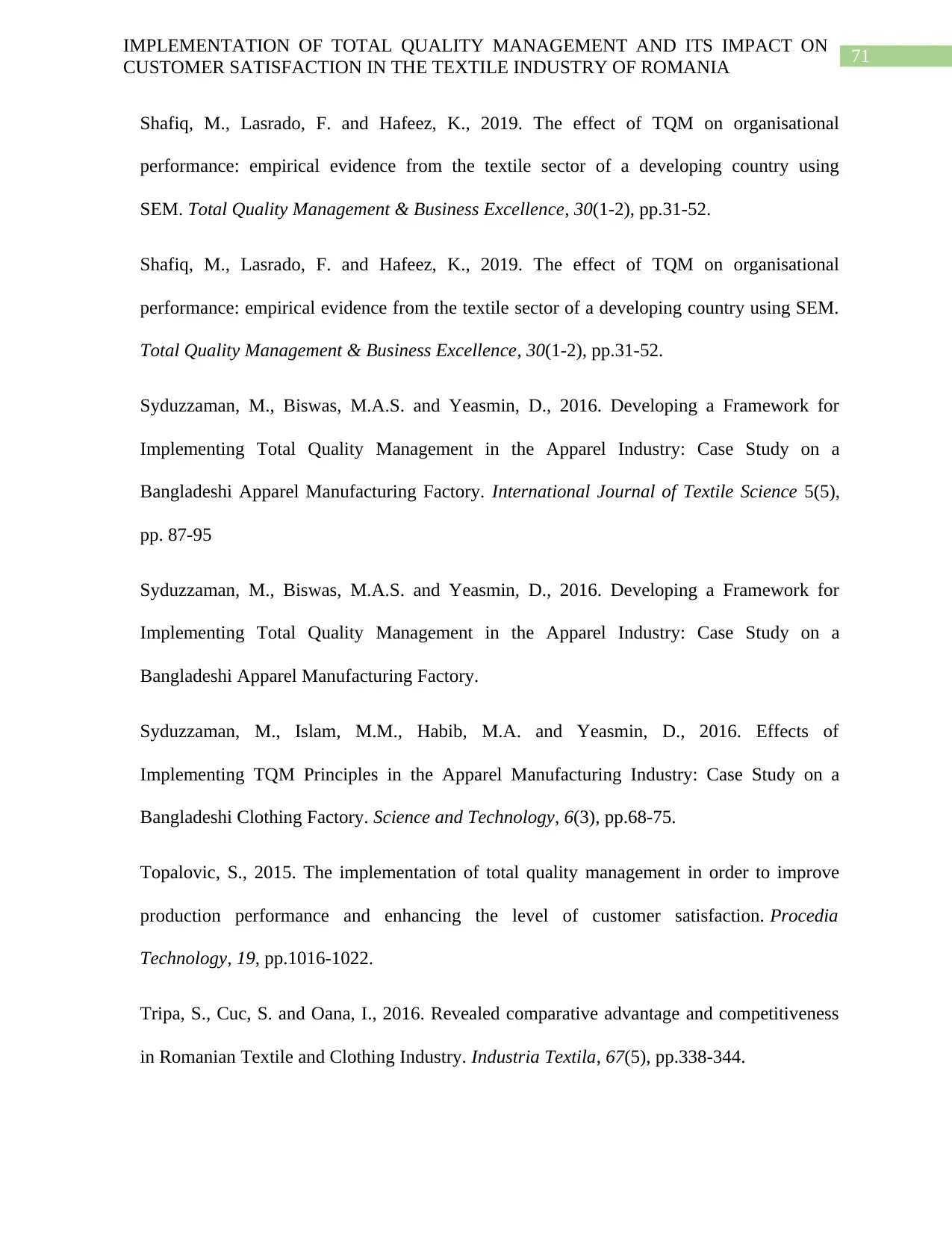
71
IMPLEMENTATION OF TOTAL QUALITY MANAGEMENT AND ITS IMPACT ON
CUSTOMER SATISFACTION IN THE TEXTILE INDUSTRY OF ROMANIA
Shafiq, M., Lasrado, F. and Hafeez, K., 2019. The effect of TQM on organisational
performance: empirical evidence from the textile sector of a developing country using
SEM. Total Quality Management & Business Excellence, 30(1-2), pp.31-52.
Shafiq, M., Lasrado, F. and Hafeez, K., 2019. The effect of TQM on organisational
performance: empirical evidence from the textile sector of a developing country using SEM.
Total Quality Management & Business Excellence, 30(1-2), pp.31-52.
Syduzzaman, M., Biswas, M.A.S. and Yeasmin, D., 2016. Developing a Framework for
Implementing Total Quality Management in the Apparel Industry: Case Study on a
Bangladeshi Apparel Manufacturing Factory. International Journal of Textile Science 5(5),
pp. 87-95
Syduzzaman, M., Biswas, M.A.S. and Yeasmin, D., 2016. Developing a Framework for
Implementing Total Quality Management in the Apparel Industry: Case Study on a
Bangladeshi Apparel Manufacturing Factory.
Syduzzaman, M., Islam, M.M., Habib, M.A. and Yeasmin, D., 2016. Effects of
Implementing TQM Principles in the Apparel Manufacturing Industry: Case Study on a
Bangladeshi Clothing Factory. Science and Technology, 6(3), pp.68-75.
Topalovic, S., 2015. The implementation of total quality management in order to improve
production performance and enhancing the level of customer satisfaction. Procedia
Technology, 19, pp.1016-1022.
Tripa, S., Cuc, S. and Oana, I., 2016. Revealed comparative advantage and competitiveness
in Romanian Textile and Clothing Industry. Industria Textila, 67(5), pp.338-344.
IMPLEMENTATION OF TOTAL QUALITY MANAGEMENT AND ITS IMPACT ON
CUSTOMER SATISFACTION IN THE TEXTILE INDUSTRY OF ROMANIA
Shafiq, M., Lasrado, F. and Hafeez, K., 2019. The effect of TQM on organisational
performance: empirical evidence from the textile sector of a developing country using
SEM. Total Quality Management & Business Excellence, 30(1-2), pp.31-52.
Shafiq, M., Lasrado, F. and Hafeez, K., 2019. The effect of TQM on organisational
performance: empirical evidence from the textile sector of a developing country using SEM.
Total Quality Management & Business Excellence, 30(1-2), pp.31-52.
Syduzzaman, M., Biswas, M.A.S. and Yeasmin, D., 2016. Developing a Framework for
Implementing Total Quality Management in the Apparel Industry: Case Study on a
Bangladeshi Apparel Manufacturing Factory. International Journal of Textile Science 5(5),
pp. 87-95
Syduzzaman, M., Biswas, M.A.S. and Yeasmin, D., 2016. Developing a Framework for
Implementing Total Quality Management in the Apparel Industry: Case Study on a
Bangladeshi Apparel Manufacturing Factory.
Syduzzaman, M., Islam, M.M., Habib, M.A. and Yeasmin, D., 2016. Effects of
Implementing TQM Principles in the Apparel Manufacturing Industry: Case Study on a
Bangladeshi Clothing Factory. Science and Technology, 6(3), pp.68-75.
Topalovic, S., 2015. The implementation of total quality management in order to improve
production performance and enhancing the level of customer satisfaction. Procedia
Technology, 19, pp.1016-1022.
Tripa, S., Cuc, S. and Oana, I., 2016. Revealed comparative advantage and competitiveness
in Romanian Textile and Clothing Industry. Industria Textila, 67(5), pp.338-344.
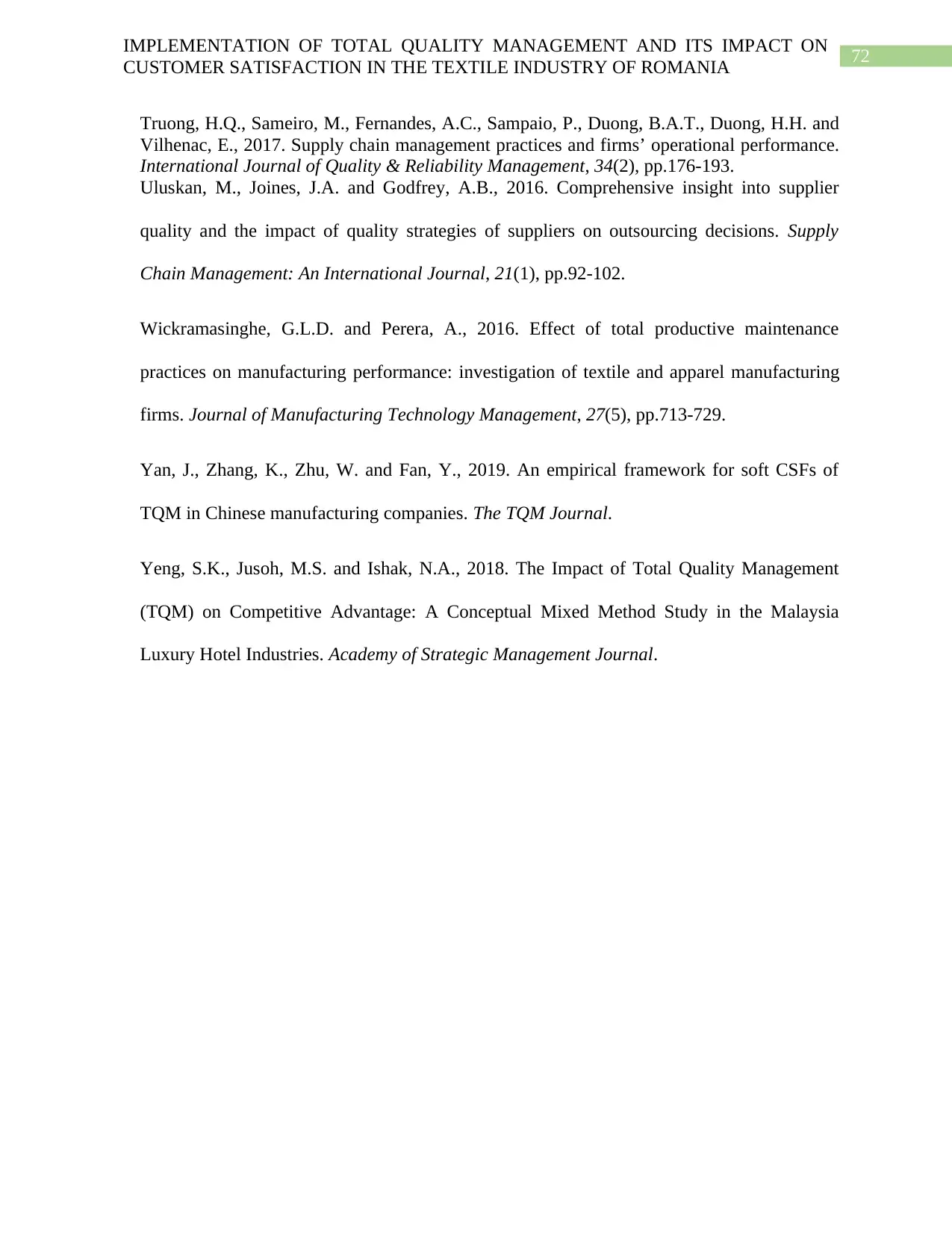
72
IMPLEMENTATION OF TOTAL QUALITY MANAGEMENT AND ITS IMPACT ON
CUSTOMER SATISFACTION IN THE TEXTILE INDUSTRY OF ROMANIA
Truong, H.Q., Sameiro, M., Fernandes, A.C., Sampaio, P., Duong, B.A.T., Duong, H.H. and
Vilhenac, E., 2017. Supply chain management practices and firms’ operational performance.
International Journal of Quality & Reliability Management, 34(2), pp.176-193.
Uluskan, M., Joines, J.A. and Godfrey, A.B., 2016. Comprehensive insight into supplier
quality and the impact of quality strategies of suppliers on outsourcing decisions. Supply
Chain Management: An International Journal, 21(1), pp.92-102.
Wickramasinghe, G.L.D. and Perera, A., 2016. Effect of total productive maintenance
practices on manufacturing performance: investigation of textile and apparel manufacturing
firms. Journal of Manufacturing Technology Management, 27(5), pp.713-729.
Yan, J., Zhang, K., Zhu, W. and Fan, Y., 2019. An empirical framework for soft CSFs of
TQM in Chinese manufacturing companies. The TQM Journal.
Yeng, S.K., Jusoh, M.S. and Ishak, N.A., 2018. The Impact of Total Quality Management
(TQM) on Competitive Advantage: A Conceptual Mixed Method Study in the Malaysia
Luxury Hotel Industries. Academy of Strategic Management Journal.
IMPLEMENTATION OF TOTAL QUALITY MANAGEMENT AND ITS IMPACT ON
CUSTOMER SATISFACTION IN THE TEXTILE INDUSTRY OF ROMANIA
Truong, H.Q., Sameiro, M., Fernandes, A.C., Sampaio, P., Duong, B.A.T., Duong, H.H. and
Vilhenac, E., 2017. Supply chain management practices and firms’ operational performance.
International Journal of Quality & Reliability Management, 34(2), pp.176-193.
Uluskan, M., Joines, J.A. and Godfrey, A.B., 2016. Comprehensive insight into supplier
quality and the impact of quality strategies of suppliers on outsourcing decisions. Supply
Chain Management: An International Journal, 21(1), pp.92-102.
Wickramasinghe, G.L.D. and Perera, A., 2016. Effect of total productive maintenance
practices on manufacturing performance: investigation of textile and apparel manufacturing
firms. Journal of Manufacturing Technology Management, 27(5), pp.713-729.
Yan, J., Zhang, K., Zhu, W. and Fan, Y., 2019. An empirical framework for soft CSFs of
TQM in Chinese manufacturing companies. The TQM Journal.
Yeng, S.K., Jusoh, M.S. and Ishak, N.A., 2018. The Impact of Total Quality Management
(TQM) on Competitive Advantage: A Conceptual Mixed Method Study in the Malaysia
Luxury Hotel Industries. Academy of Strategic Management Journal.
1 out of 73
Related Documents
Your All-in-One AI-Powered Toolkit for Academic Success.
+13062052269
info@desklib.com
Available 24*7 on WhatsApp / Email
![[object Object]](/_next/static/media/star-bottom.7253800d.svg)
Unlock your academic potential
© 2024 | Zucol Services PVT LTD | All rights reserved.





